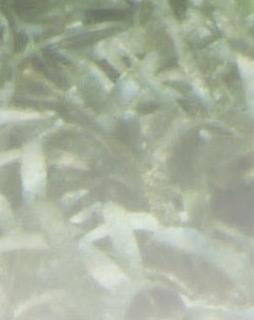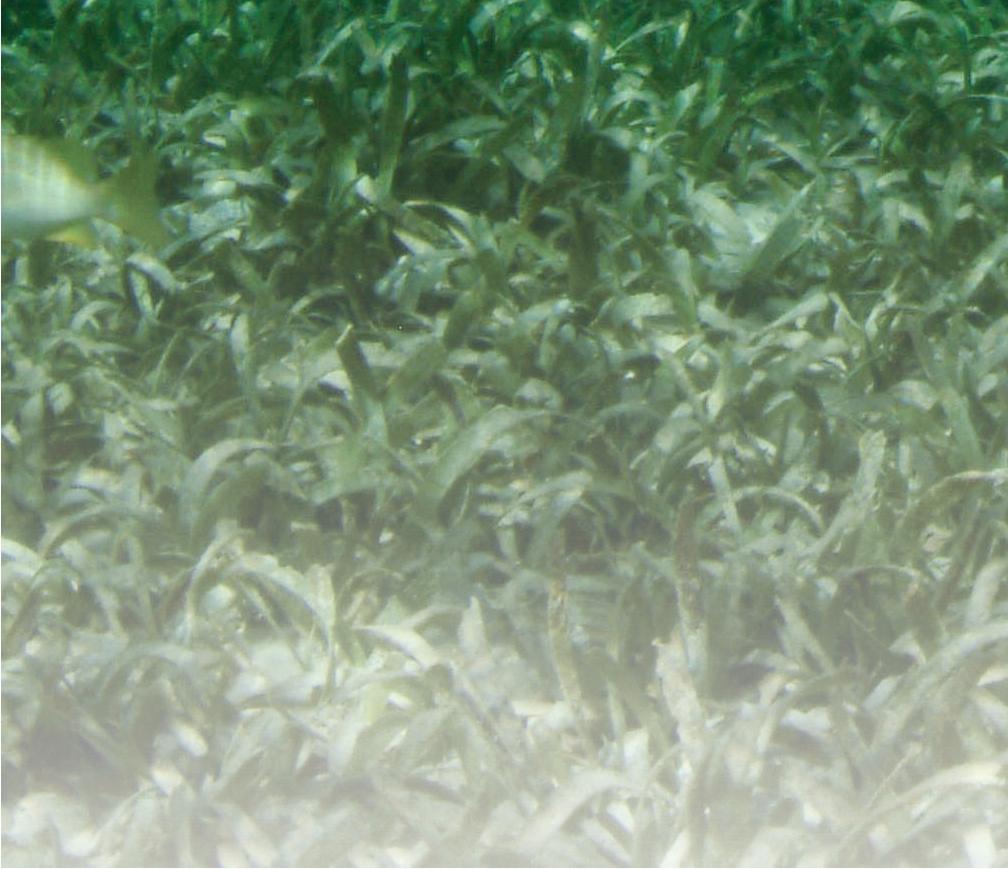






















Credits

© 2021
Authors
Delmis del C. Alicea Segarra, EdD, Jorge Casillas Maldonado, MS
Co-Authors
Ivonne Bejarano Rodríguez, PhD, Diana M. Beltrán Rodríguez, MS, Brenda M. Soler Figueroa, MS
Science Edi ng
Yasmín Detrés Cardona, PhD, Ariel E. Lugo, PhD, Lesbia L. Montero Acevedo, BS
Science Advisor
Juan G. González Lagoa, PhD
Edi ng
Ruperto Chaparro Serrano, MA, Delmis del C. Alicea Segarra, EdD, Cris na D. Olán Mar nez, MA
English edi ng
Lynne M. Hinkey, PhD
Readers
Álida Or z Sotomayor, PhD, María M. Montalvo Ortega, EdD, Neysa Rosario García, MA
Brenda L. Estévez Moreno, BS
Contributors
Carlos J. Carrero Morales, MPA, Carmen Zayas San ago, MS
English Transla on and Edi ng
Wilmarie Cruz Franceschi, MA
Graphic Design and Layout
Delmis del C. Alicea Segarra, EdD, Oliver Bencosme Palmer, BA
Photography
Oliver Bencosme Palmer, BA, Ruperto Chaparro Serrano, MA, Guillermo Damiani Ríos, Efraín Figueroa Ramírez, BS, Juan G. González Lagoa, PhD , Mydalis M. Lugo Marrero, MA, Julia S. Mignucci Sánchez, PhD, Janne e Ramos García, BS
Footage for the “El manglar” video
Efraín Figueroa Ramírez, BS, Rául Omar Or z Arroyo, MAG
Theme guide
Alessandra Otero Ramos, MIS
Prin ng
Raúl Omar Or z Arroyo, MAG, Delmis del C. Alicea Segarra, EdD
Publica on number UPRSG-E-298
ISBN: 978-1-881719-79-3










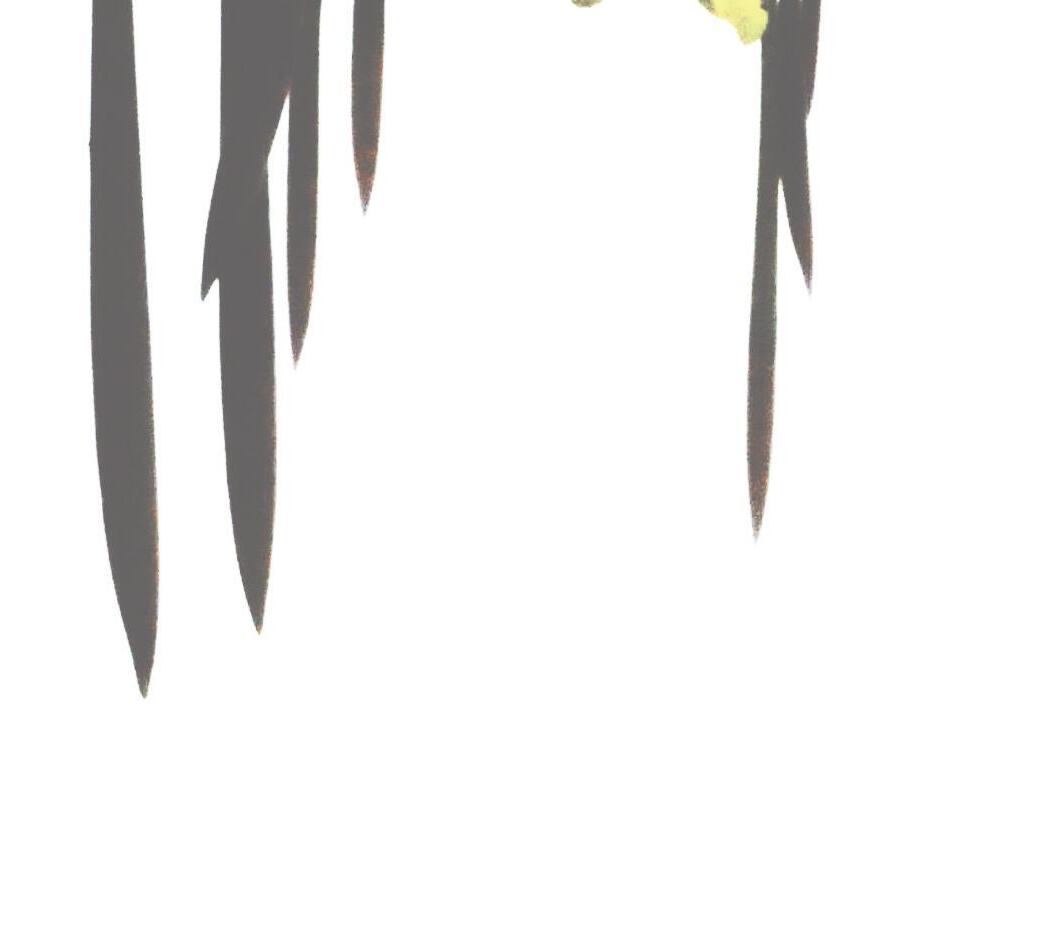



The University of Puerto Rico Sea Grant Program understands the need to have an educa onal tool to aid instructors during the teaching-learning process regarding the marine and coastal resources of the Puerto Rican archipelago. With this goal in mind, we have taken it upon ourselves to produce this Educa onal Guide about mangroves which includes a theme background, a presenta on with notes for instructors, different ac vi es, and the daily lesson plans necessary for teaching. This guide, with resources designed for the 4th through 12th grades, offers various lesson plans about mangroves in a structured, easy-to understand and interdisciplinary manner. The daily lesson plans are aligned with the standards and specifica ons required by the Department of Educa on of Puerto Rico, easing their inser on into the classroom. The ac vi es presented promote ac ve learning, allowing the students to build their own learning, making the process pleasant, a rac ve and interes ng. We hope this manual will prove useful when teaching about our marine and coastal resources and likewise foster in our young people a deeper apprecia on for this ecosystem and mo vate them to promote its conserva on and protec on.

An ecosystem is a community of organisms which interact amongst themselves and with their environment, including non-living elements. Each one of these ecosystem’s components influences the others, and all are vitally important for the preserva on of their way of life. Puerto Rico has a territorial expanse of 3,587 square miles (including its more than one hundred islands and cays), and within this area, one may find eight main ecosystems: tropical rainforest, subtropical dry forest, sand beaches, rocky shores, coral reefs, seagrass meadows, mangroves, and lagoons.
Out of the aforemen oned ecosystems, five are marine ecosystems, and we can find them across the islands 700 miles of shoreline. With the Atlan c Ocean to the north and the Caribbean Sea to the south, the difference in distribu on in these ecosystems is very notable. This can be observed in the variable presence of mangroves throughout Puerto Rico’s shores. The diversity showcased by the marine ecosystems culminates in an interes ng and enriching educa onal adventure.
For decades, Puerto Rico has a ributed li le ecologic and economic value to mangroves, forests composed of trees especially adapted to thrive in coastal areas, because of their appearance and and occasional odor of decaying organic ma er smell. This percep on could not be more mistaken – mangroves are cri cally important for the healthy development of both terrestrial and marine ecosystems. Without mangroves, the seagrass meadows and coral reef ecosystems would not exist as we know them. The biological diversity and the health of these two ecosystems directly depend on the
mangrove’s health. Addi onally, mangrove forests protects our coasts from erosion, strong winds and storm surges, and serve as habitat for many species during their juvenile life stage. Any person who has visited a mangrove forest, whether walking a trail, kayaking, or visi ng the bioluminescent bays, knows that this is a priceless experience. These are just a few reasons why our children need should familiar with this valuable ecosystem.
Once we begin to comprehend how important these resources are, we can strive to use them in a wise manner. As Puerto Ricans, we need to have a sense of stewardship towards out marine ecosystems. For this to happen, we need to know and understand the most common ecosystems in our archipelago, such as the mangroves. It is precisely this limited knowledge regarding the func on and importance of our ecosystems which leads to uncontrolled and poorly planned development in these areas. By integra ng concepts about our coastal ecosystems into school curricula, students will gain awareness and apprecia on for the benefits of caring for mangroves, conserving them and protect them for future genera ons. We will also rediscover our true geographical iden ty as Caribbean islanders.
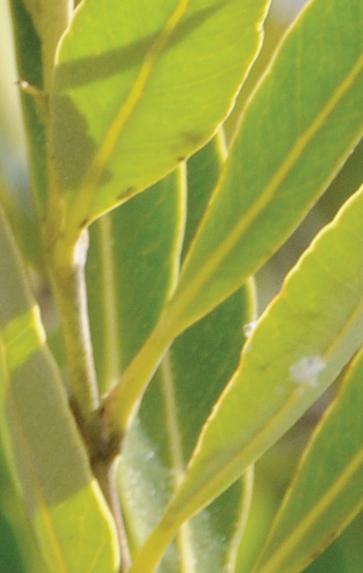


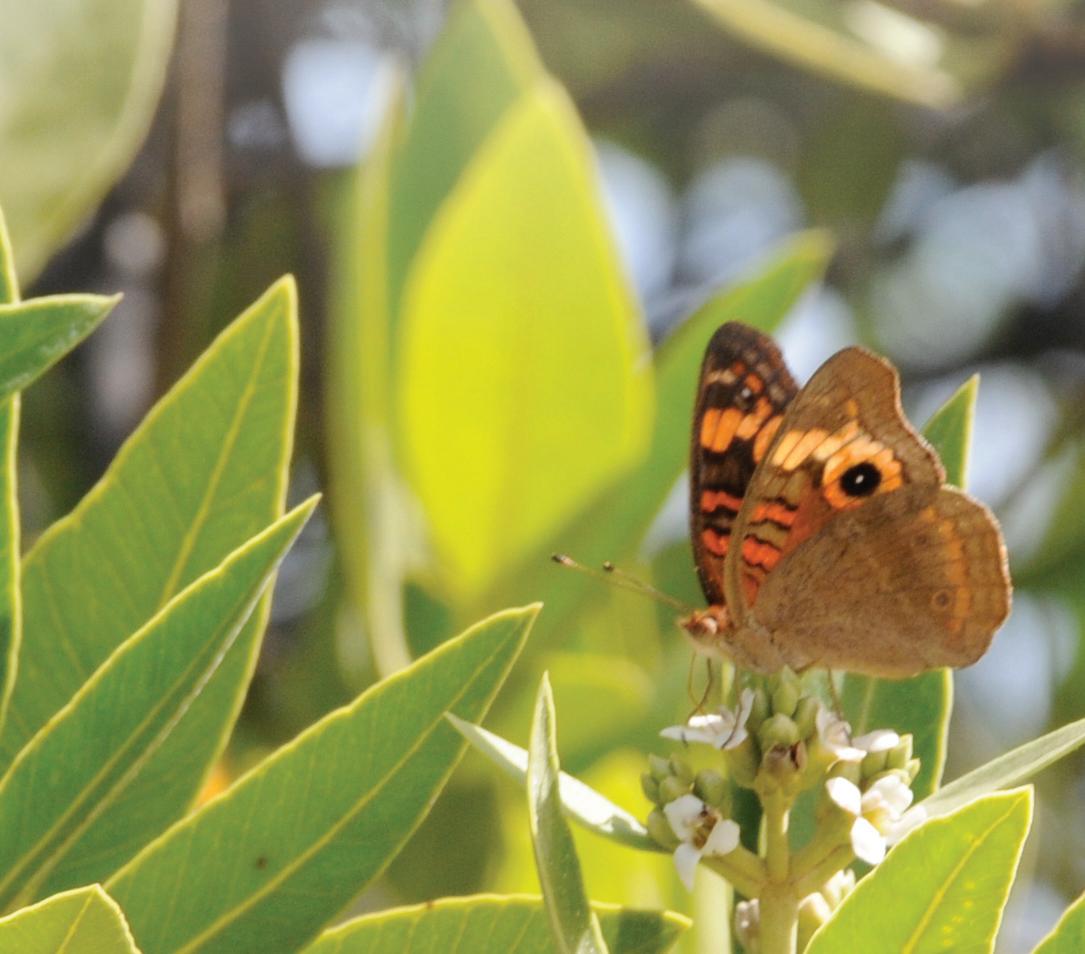



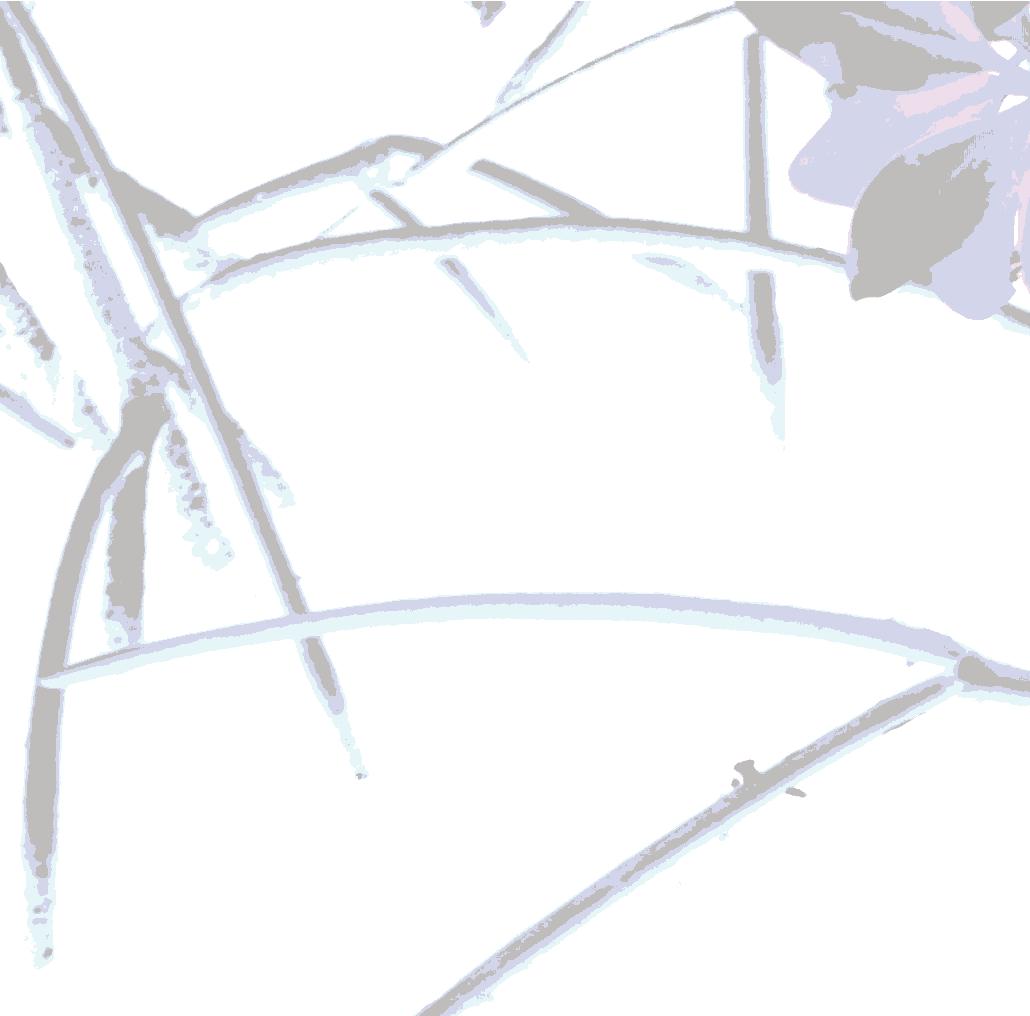

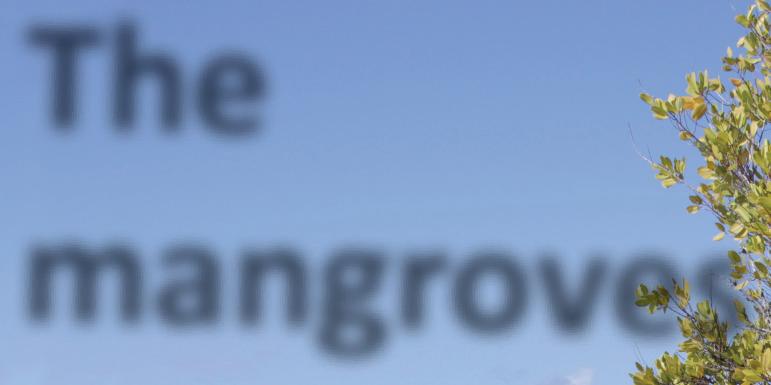
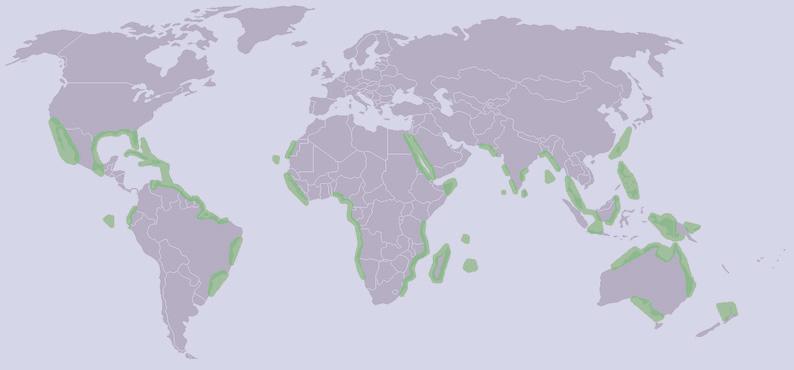
A mangrove forest is a habitat mainly comprised of a group of mangrove trees, growing on the coastline between the sea and the land. Mangroves are commonly found in wetlands or estuaries, where seawater meets and mixes with freshwater from rivers, intermi ent streams, rain runoff or subterranean sources.

A mangrove tree is a tree or shrub that features special physiological and anatomical adapta ons which allow it to thrive in the extreme condi ons typical to the li oral zone between land and sea (Figure 2). The low-lying lands in this area are known for the frequent water intrusions, high salinity, and poor aera on.
Mean high water mark
Mean low water mark
Generally speaking, a mangrove forest develops in places that gather the following five condi ons
1. Mangrove trees need warm temperatures. These should be between 60-86 oF (15-30 oC). The temperature is a determining factor for mangrove distribu on throughout the world (Figure 1), limi ng their development to the tropical and subtropical regions between 30 degrees N and 30 degrees S.
2. Areas with low exposure to waves and surges, with small chance of erosion, are ideal in aiding seeds and young plants se lement.
3. Mangrove development is also greater in zones offering alluvial substrates, rich in organic material (such as silt).
Alluvial substrate - deposit of watertransported sediments
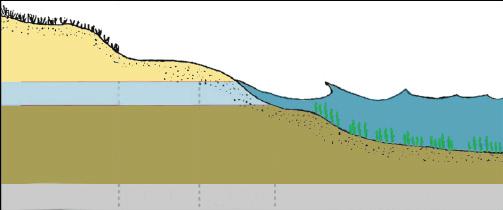
Estuary – habitat in which seawater becomes diluted as it mixes with freshwater draining from the mainland.
Li oral zone (inter dal zone) - coastal area under the direct influence of the rising or subsiding des.
Mangrove - tree or shrub with special adapta ons which allow it to thrive in high salinity and poorly oxygenated condi ons.
Mangrove forest – habitat chiefly comprised of mangrove trees.
Propagule - the mangrove’s viviparous seed, it is a plant in the early stages of development.
Wetland - areas influenced by aqua c systems and terrestrial systems which are frequently flooded.
4. Mangroves occupy land tracts in which strictly terrestrial plants could not survive, such as areas frequently flooded by seawater
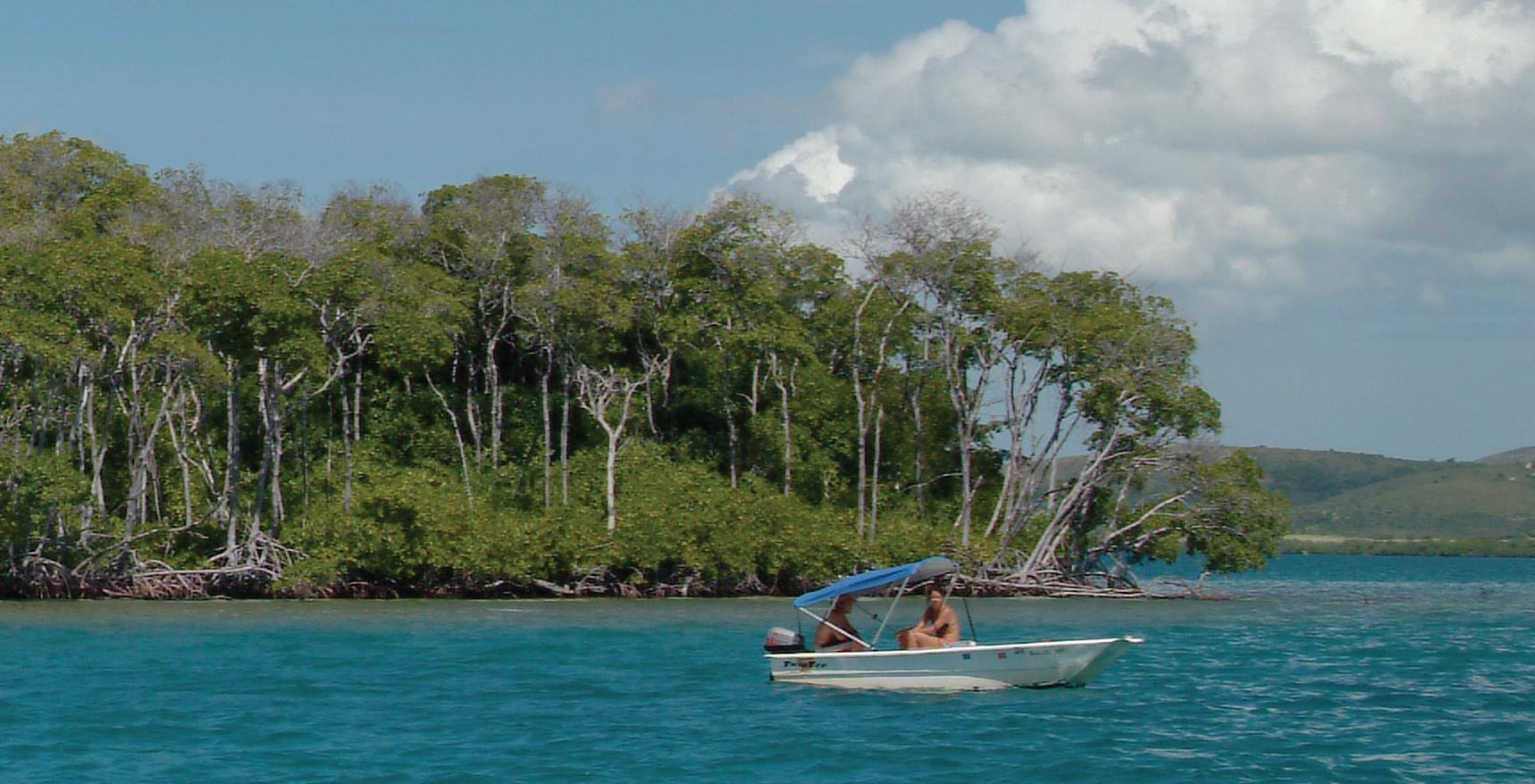
5. Coastal regions with low slopes have a wider li oral zone and therefore provide a more expansive area for mangrove establishment.
Mangrove trees can grow up to a height of approximately 148-164 feet (45-50 m) when situated in op mal condi ons. This may be observed near the equator, where there is a good availability of nutrients, wide expanses of inter dal zones, and rela vely constant, high temperatures. In places with more strenuous condi ons (non-op mal temperatures, very arid soil or extremely high salinity), a mangrove tree only grows as a 3-6 feet (1-2 m) tall shrub.

1. Mangrove thickets are connected to the seagrass meadows and coral reefs. They help retain and stabilize the sediments coming from the mainland, and help control substrate erosion. These trees absorb nutrients and pollutants from the water and are therefore key to clear, clean waters. Mangrove thickets also help reduce freshwater influx into the sea, and are highly produc ve systems. Many fish and crustacean larvae grow and develop in the mangrove thicket habitats before migra ng to other marine ecosystems.
2. Mangroves, like any other plant, use solar energy for photosynthesis, producing oxygen in the process. Photosynthesis allows the mangrove tree to transform solar energy into organic material such as leaves, wood or flowers. Organisms capable of this are known as primary producers.
3. Many other species such as crabs, shrimps and bu erflies feed on the leaves, flowers and other organic material produced by the mangroves. These organisms are known as primary consumers. The organisms which feed on the primary consumers, such as seagulls and fish, are known as secondary consumers. In this manner, mangrove forests fulfill a vital role as the base of the food chain, and are highly produc ve ecosystems.
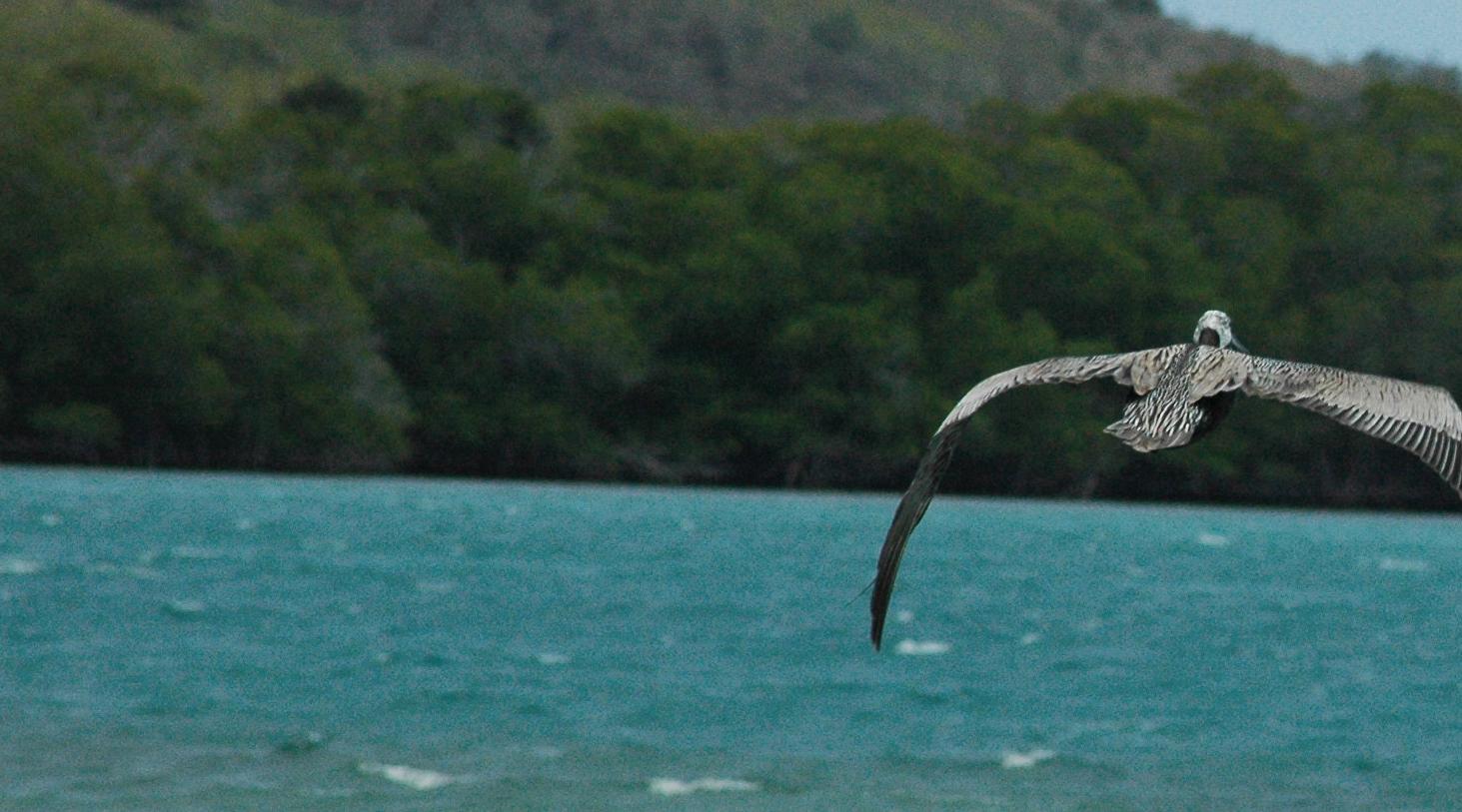
4. Mangrove thickets are important habitats providing food and shelter for many marine species, including mammals, amphibians, birds, rep les, plants, fish, and invertebrates.
5. They serve as nursery zones (offer shelter to species in their juvenile stages), refuge and feeding grounds for many commercially important species such as snapper, lobster and conch.
6. Mangrove thickets offer a nes ng and res ng area for several migratory bird species like the prairie warbler, endemic species like the yellow-shouldered blackbird, or resident species like the American yellow warbler.
7. Mangrove roots stabilize and retain sediments along the shore, protec ng the coast from erosion driven by wind and wave ac on. This is par cularly important during strong surf events like hurricanes, tsunamis or storms.

Primary consumers – Organisms which feed on primary producers.


Primary producers – Organisms which can transform solar energy into ma er through photosynthesis.

Secondary consumers - Organisms which feed on primary consumers.
8. Mangrove forests offer recrea onal opportuni es and benefits to both residents and visitors alike.
The largest mangrove forest in Puerto Rico can be found in the northeast coast (Figure 5), in the Piñones area in Loíza. The north coast mangrove forests are associated with the freshwater influx from rivers and lagoons (basin and riparian mangroves), and from runoff (bank mangroves). Because the Atlan c Ocean features such heavy surf condi ons, mangrove forests on the north coast develop only in loca ons protected from these condi ons. Throughout the southern coast, on the other hand, mangrove forests present a thick border on the coasts (border mangroves) and the cays (cay mangroves). The submerged land shelf in this zone is wider and fla er than the one on the north coast, and the surf and wave condi ons presented by the Caribbean Sea are much calmer than that of the Atlan c Ocean.


There are around 54 mangrove species worldwide. Of these, about ten can be found within the Caribbean region, and only four within Puerto Rico:
a. Red mangrove (Rhizophora mangle)
b. Black mangrove (Avicennia germinans)
c. White mangrove (Laguncularia racemosa)
d. Bu onwood (Conocarpus erectus)
The four mangrove species found in Puerto Rico can be easily iden fied by their main dis nc ve characteris cs: leaf shape, flower and fruit shape, presence of aerial prop roots and presence of pneumatophores; as well as their localiza on inside the mangrove forest. The trees tend to be
distributed in a sequence perpendicular to the coast, from the sea to the mainland. This distribu on is known as zona on (Figure 6). Zona on is characterized by the adapta ons each mangrove species has to the terrain’s extreme condi ons, such as:
• Tolerance to salinity. The species which are be er adapted to high salinity are on the soil furthest from the li oral zone. During the low de, this soil is exposed to the wind and the sun; some of the water evaporates and some filters down through the sediment, leaving behind salt crystals. In the zones closer to the sea, on the other hand, the salts are dissolved in water and are therefore less salty.
• Adapta ons to life in poorly-aerated soils. Mangrove forests are highly produc ve habitats with very high levels of organic decomposi on (for instance, leaves, wood and flower). Some of the bacteria in charge of decomposing this organic material draw their energy from oxygen. However, oxygen content in these soils is low, due in part to the soils being flooded and being composed mainly of fine sediments, which limit aera on. Therefore, a good amount of the organic decomposi on taking place in mangrove forests is performed by anaerobic bacteria which can survive and work in the absence of oxygen.
• Capacity to become established in unstable substrates (waterlogged and muddy soils). Soils in direct contact with the sea tend to be more saturated with water, are usually more unstable and unconsolidated, whereas those soils which are further from the sea tend to be firmer.
Aerial prop root - root growing outwards from the main tree trunk in a s lt shape.
Pneumatophore - type of root which grows upwards from the soil. They are a feature of both the black and white mangrove trees.
Zona on - mangrove species distribu on perpendicular to the coast.
 Figure 6. Mangrove tree zona on on a gradient, from the sea towards the mainland. The bo om of the image shows a blue gradient star ng at the sea, which becomes red in representa on of the increasing salinity. Then, it turns blue again, symbolizing that the soil condi ons in that area are prac cally the same as further inland (low salinity, good oxygena on).
Figure 6. Mangrove tree zona on on a gradient, from the sea towards the mainland. The bo om of the image shows a blue gradient star ng at the sea, which becomes red in representa on of the increasing salinity. Then, it turns blue again, symbolizing that the soil condi ons in that area are prac cally the same as further inland (low salinity, good oxygena on).
The most common species of mangrove in Puerto Rico is the red mangrove. It is usually found in direct contact with the sea, thus becoming the first mangrove species encountered on the coastline, going from the sea towards the land (Figure 6).

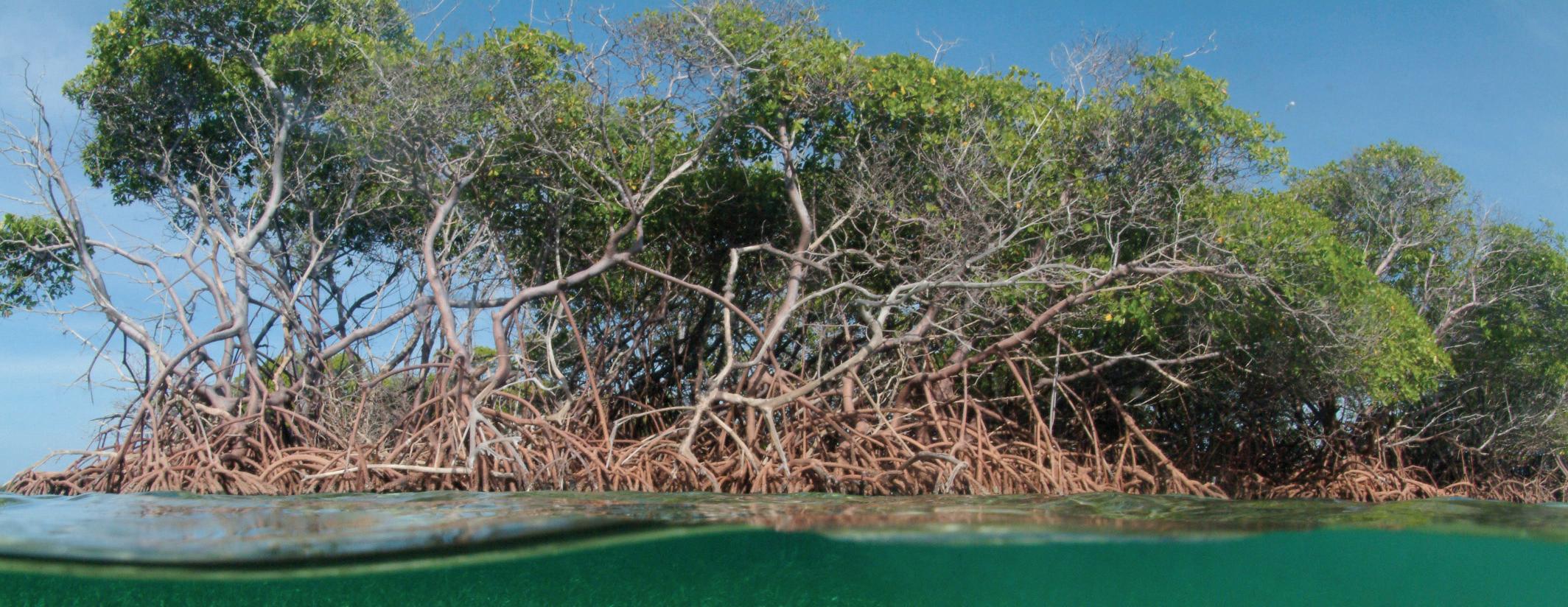

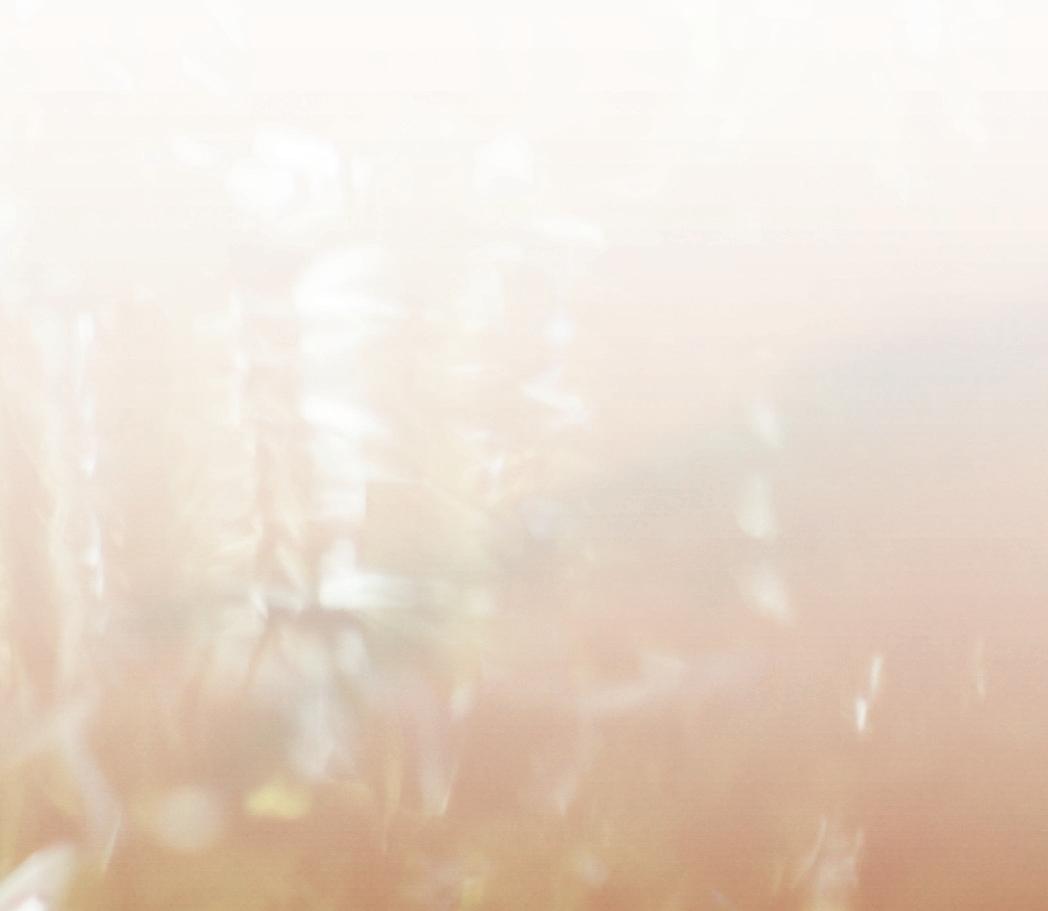



Leaves: Red mangrove leaves are large (8-10 cm in length, 4-5 cm in width), thick and with a waxy texture, which prevents water loss and slows decomposi on. The leaves are simple, opposite (Figure 8) and are usually grouped at the ps of the branches.
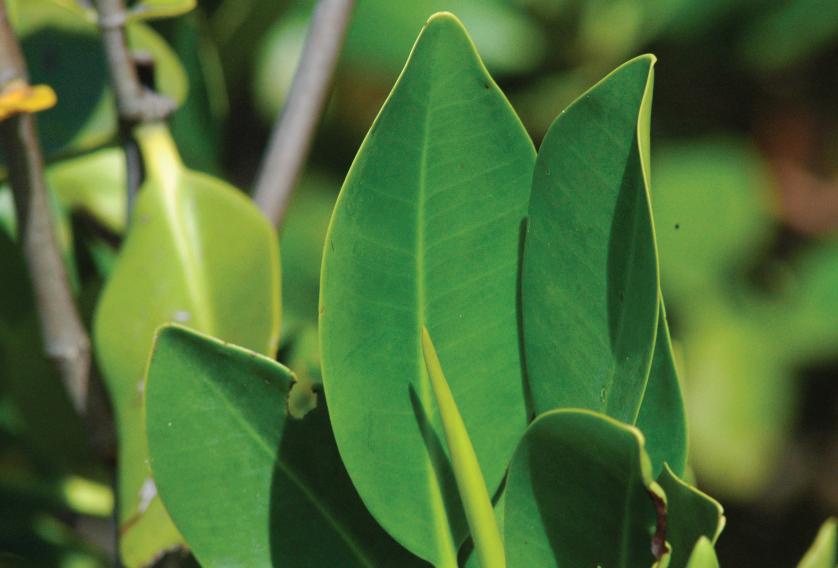
Roots: The red mangrove is the only mangrove presen ng aerial prop roots, which branch out of the trunk or from the lateral branches and droop towards the ground like s lts (Figures 7 and 9). These roots provide the tree with more stability, allowing it to become established in finelysedimented, poorly consolidated soils. Furthermore, the aerial roots fulfill vital func ons such as nutri on, aera on and salt filtra on. The roots filter the salt through osmosis so that the tree can absorb the water necessary to survive. If the mangrove absorbed salt, it would dehydrate.
Bark: The bark covering this mangrove’s roots (Figure 10) contains tannins, organic substances which protect it against bacterial decomposi on and give it a characteris c reddish coloring (tannins are also present in red wine). Also, the bark on the roots and trunk feature pore-like structures called len cels (Figure 11), which aid in the mangrove’s gas exchange (breathing). This is an adap ve response, since the trees grow in poorly-oxygenated or anoxic soils. Red mangrove bark is complete and uniform, differing from other mangrove species.
 Figure 7. Red mangrove ecosystem, Puerto Rico.
Figure 8. Red mangrove leaves.
Figure 9. Red mangrove aerial prop roots.
Figure 10. Bark on the red mangrove roots.
Figure 7. Red mangrove ecosystem, Puerto Rico.
Figure 8. Red mangrove leaves.
Figure 9. Red mangrove aerial prop roots.
Figure 10. Bark on the red mangrove roots.
Flowers: Red mangrove flowers are small, approximately 2.5 cm in diameter, with four thick, lanceolate sepals (Figure 12). The flowers have four white petals which turn dark and fuzzy inside, along with eight stamen. Flowers are o en present year-round.

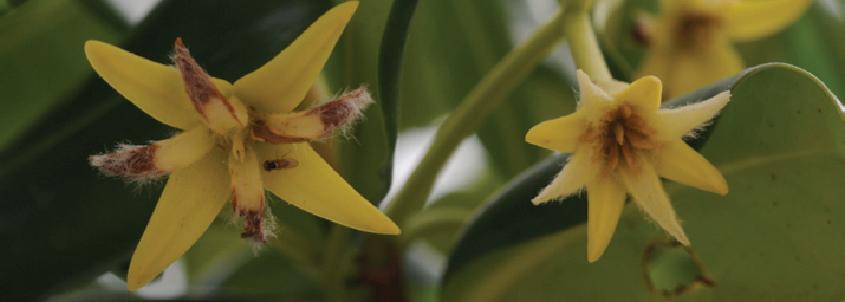






The red mangrove’s fruit germinates while s ll a ached to the tree (Figure 13a). It matures in about two to three months, and develops into an embryo, known as a propagule (Figure 13b). The propagule grows while a ached to the tree for 11 or 12 months, and by the me it detaches, it is already a small plant, with two leaves at the top ready to photosynthesize and establish itself as a new red mangrove tree (Figure 14).
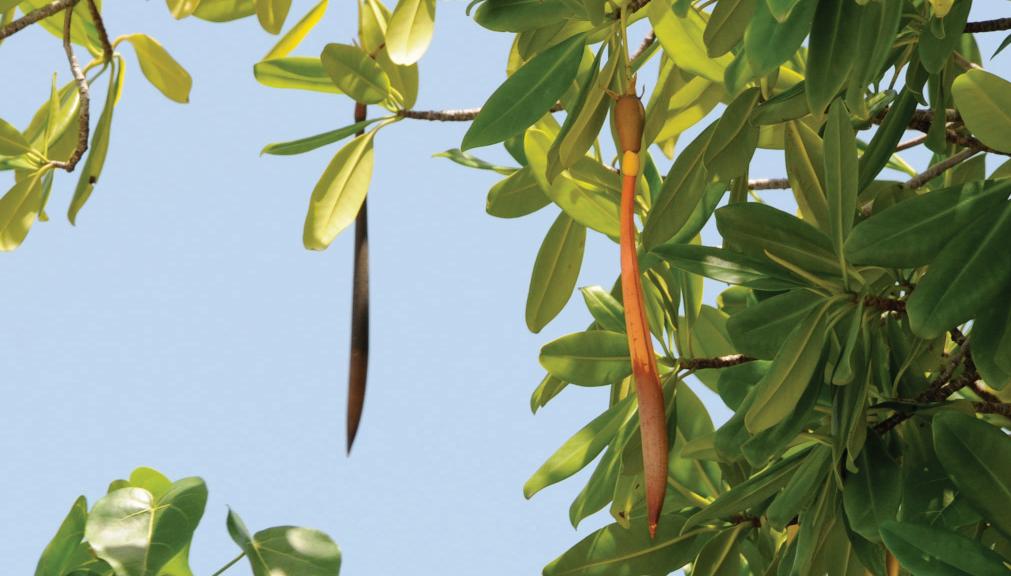



The propagules growing among the established mangrove roots tend to develop as small shrubs of about 1.5 meters in height due to the limited amount of sunlight they receive. These young, small trees are called the dormant forest, and serve as a reserve popula on. When a full-grown mangrove tree dies, a space opens up and allows sunlight to reach the substrate. The small, dormant trees, usually living in the shadow of their larger counterparts, readily take advantage of these new and favorable sunlight and space condi ons and quickly grow to their full size. Thus, the dormant forest eventually replaces the main one through a cyclical process. This is a crucially important process to mangrove forest survival, especially a er suffering the effects of strong weather events like hurricanes or tsunamis. On the other hand, if the propagule falls into the water, it floats to the surface and is transported by currents, since its small trunk is corklike. Ini ally, it floats horizontally, but as it absorbs water, its bo om part becomes heavier and sinks, orien ng the propagule ver cally. Upon reaching a flat surface, the propagule has the chance of establishing itself as a new mangrove tree. This reproduc ve mechanism allows red mangroves to disperse and colonize areas distant from the usual coastal mangrove zones (such as cays).
 lenticels
peduncle sepals
Figure 11. Len cels on the red mangrove tree roots.
Figure 12. Red mangrove flower, with some of their parts. (petals, sepals, peduncle, stamen)
Figure 13b. Red mangrove propagule.
Figure 13a. Red mangrove fruit.
stamen
lenticels
peduncle sepals
Figure 11. Len cels on the red mangrove tree roots.
Figure 12. Red mangrove flower, with some of their parts. (petals, sepals, peduncle, stamen)
Figure 13b. Red mangrove propagule.
Figure 13a. Red mangrove fruit.
stamen
Dormant forest - group of small mangrove trees inhabi ng the shadows from the main forest.

Len cels - projec ons from the tree’s trunk and root surfaces, having a pore to aid in gas exchange.
Osmosis - movement of water molecules through a semipermeable membrane, from an area of higher water concentra on to one with less water concentra on.
Sepals - each of the harder, greenish leaves which form the flower’s calyx.
Stamen - the flower’s male reproduc ve organ, containing pollen.
Tannins - organic substances present in the red mangrove’s vegetal ssue and which provide its characteris c reddish hue; tannins also offer protec on against bacterial decomposi on.

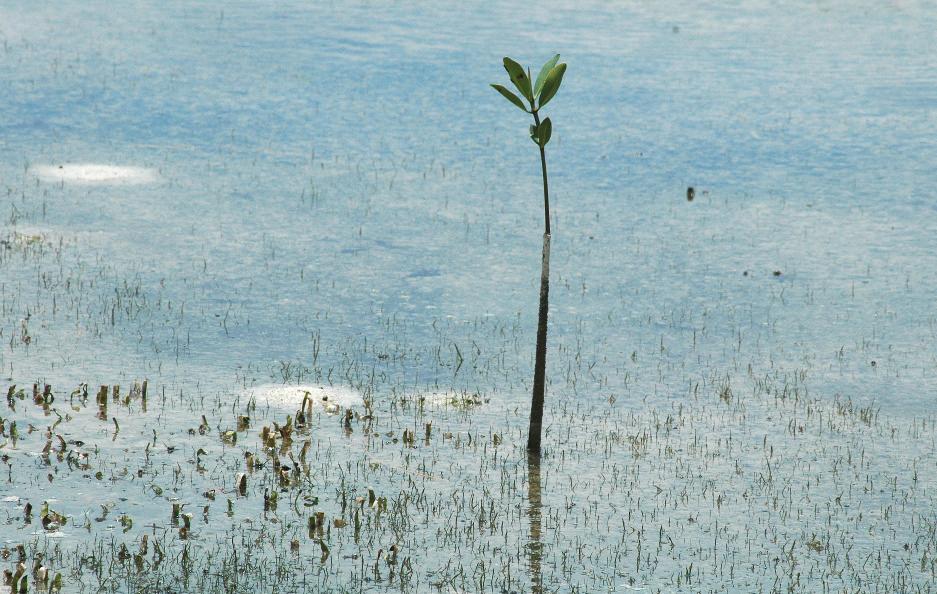 Figure 14. Propagule established in so substrate.
Figure 16. Dormant forest near ground level.
Figure 15. The tannins featured by the red mangrove may give the surrounding water a reddish appearance.
Figure 14. Propagule established in so substrate.
Figure 16. Dormant forest near ground level.
Figure 15. The tannins featured by the red mangrove may give the surrounding water a reddish appearance.
The black mangrove (Figure 17) tends to be located behind the red mangrove, in sal er and less aerated soils. This species tolerates more strenuous climate condi ons and is associated with poor soils or soils with high salinity.

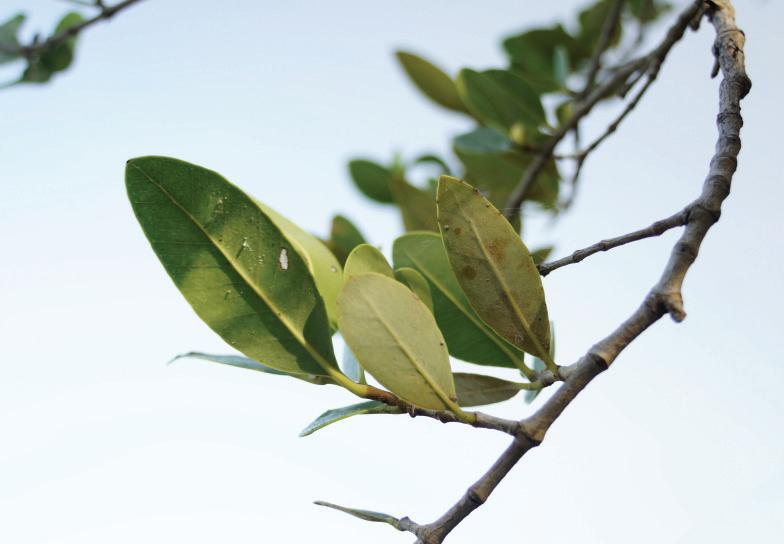
Main characteris cs:
Leaves: The black mangrove’s leaves are smaller than the red mangrove’s, and are lanceolate, with a sharp point at the apex (Figure 18). The dorsal surface (the top side of the leaf) is green, while the ventral surface (the bo om side of the leaf) is yellowish green and opaque (Figure 19). Black mangrove leaves are opposite (begin at the same point on the branch, but in opposite direc ons) and serve as the tree’s salt excretory organs (Figure 18). The salt crystals are deposited on the dorsal surface through stoma. This process ensures that the tree maintains the necessary water it needs for its survival. Older leaves tend to accumulate higher concentra ons of salt before falling off and showing burn spots due to the “magnifying glass” effect created when sunlight is filtered through the salt crystals.

Roots: The black mangrove features a system of super cial roots around the trunk. This system has several long projec ons which protrude from the substrate upwards. These projec ons are known as pneumatophores (Figure 20). The pneumatophores are long and slender (reaching a height of up to 20 cm), and their func on is to allow the mangrove to perform aera on (breathing) in poorly oxygenated soils. Because of their appearance and func on, they are o en referred to as “snorkel roots.”
Bark: The black mangrove tree’s bark has a smooth bark while in the juvenile stage, before becoming fissured. It has a black or dark gray color, with a yellowish interior (Figure 23).



Flowers: Black mangrove flowers are small (0.2 - 0.5 cm in diameter, 0.5 cm in height), with white petals. They bloom in dense clusters (Figure 21).

Fruit: The black mangrove’s fruit is shaped like a small, fla ened, oval capsule (Figure 22). The embryo develops while s ll a ached to the parent tree, and fixes itself onto the substrate upon falling. If it falls into the water, the embryo can float for several weeks, sustaining itself on the cotyledons, un l it reaches an appropriate place on which to se le.
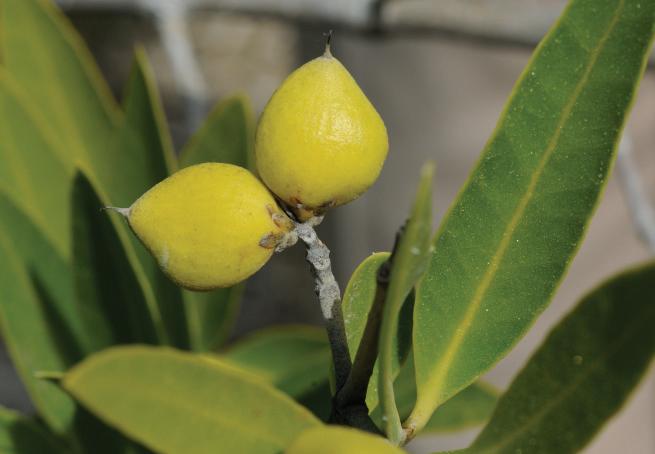
Apex - the outer end of a leaf or branch.
Cotyledons - the shape in which the first leaf of a seed-bearing plant embryo appears.
Dorsal surface - the top side of a plant’s leaf.
Stoma - small pore-like orifices located on a leaf’s surface; they are in charge of regula ng gas Exchange and minimizing water loss.
Ventral surface - bo om or inferior surface on a plant’s leaf.
Figure 23. Black mangrove bark. Figure 20. Black mangrove pneumatophores. Figure 21. Black mangrove flowers. Figure 22. Black mangrove fruit.


White mangroves (Figure 24) are typically located behind the black mangroves, towards the mainland and in salty, poorly-aerated soils. This mangrove, however, can also grow in low-salinity environments. It develops op mally in sandy substrates.




Main characteris cs:
Leaves: White mangrove leaves are thick, oblong (oval) shaped, with a rounded apex. They are opposite, simple, and have a leathery texture. The dorsal surface is grayish green, while the ventral surface is lighter colored (Figure 25a). These leaves feature two glands at the pe ole base, which are in charge of excre ng excess salt from the mangrove in order to maintain a healthy hydra
Roots: Like the black mangrove, white mangroves have a super trunk, with long projec ons growing upwards from the substrate, known as pneumatophores have special ssue at the pneumatophores are shorter and fla er than those on the black mangroves (Figure 26a).
Figure 24. White mangrove ecosystem, Puerto Rico.Bark: Unlike other mangrove species, white mangrove bark is fissured along the length of the trunk (Figure 26b).


Flowers: White mangrove flowers are small (0.2 to 0.3 cm) and plen ful, and their external parts fused to form a tube with five triangular lobes or teeth. At the end of the tube, it grows five ny, rounded petals, about 0.1 cm long. The flowers grow in clusters, forming inflorescences (groups of flowers on the branches) that can measure 3 to 7 cm in length (Figure 27).

Fruit: White mangrove fruits are small, with lengthwise ridges. When immature, they are green. They turn brown as they ripen (Figure 28). The seed usually begins to germinate while the fruit is s ll a ached to the tree. Generally, the embryo develops just before falling off the tree. If it falls into the water, the seeds float and are dispersed by the currents.





Bu onwood (Figure 29) can be found in the inter dal zone furthest from the sea, in low-salinity, elevated, sandy soils, where it mixes with terrestrial vegeta on. Because of this, some field experts do not consider it a true mangrove.
Bu onwood usually grows as a shrub, although in some cases, provided it receives op mal condi ons, it may grow as a fairly large tree, between 15-23 feet (5-7 m) tall. In Puerto Rico, it usually forms small forests along rocky shores. It may also be found bordering very low-salinity lagoons that are distant from the shore.
Main characteris cs:

Leaves: The bu onwood’s leaves are ellip cal and small (4-9 cm long and 2-3 cm wide). It is the only mangrove tree species with alterna ng leaves. The leaf pe ole is small and, like the white mangrove, has two small salt-excre ng organs on each side (Figure 30a). Like all the other mangrove species men oned, it needs to eliminate salt to maintain proper hydra on.

Flowers: Bu onwood flowers are ny (0.2 cm wide), green and fragrant, and grow in large numbers to form round inflorescences measuring 0.6 -12.5 cm in diameter (Figure 30b).

Fruit: Bu onwood gets its name from the shape of its fruit. The round inflorescences become a brown, round, aggregated fruit, similar to a ny pinecone or bu on. (Figure 30c). Each fruit contains a large number of seeds.


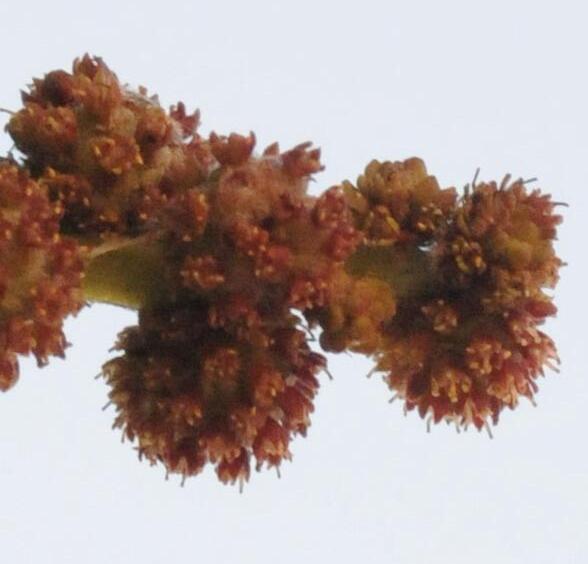
Main disturbances affec ng the mangroves in Puerto Rico

Natural
Sea level rise - In the best case scenario, it would reduce the inter dal zone which mangroves can colonize; in the worst case scenario, it could submerge and exterminate exis ng mangrove forests.
Hurricanes and tsunamis - They create strong winds, rainfall events and storm surges which could poten ally tear mangroves from the substrate.
Coastal urban development - The increase in human popula on in coastal zones has increased wood clearing (including cu ng down mangrove forests), which increases soil erosion and sediment discharge reaching the sea.
Mangrove forest clearing - Usually, mangrove forests are cut so that urban development may occur. Their wood is also harvested and used as construc on material for building fish traps, because of the wood’s resilience to water.
Increased boat traffic on shallow waters - This removes sediments on the bo om (which are usually anoxic; that is to say, without oxygen), and resurfaces the contaminants and toxic substances in the water, to the detriment of water quality and mangrove health, as well as risking the wellbeing of mangrove forest inhabitants.
Increased presence of nutrients, fer lizers and other contaminants - Discharge from rivers or runoff nega vely affects water quality, hurts mangrove health, and risks the wellbeing of mangrove forest inhabitants.
Trash - The des bring in trash which gravely affects the many species inhabi ng the mangrove forest.
Changes in water flow - Altera ons and/or construc on on the coast cause changes in water flow. This changes the water’s characteris cs, such as its temperature or salinity, and can cause widespread ex nc on in the mangrove forest.
In order to preserve these valuable ecosystems, several key issues must be addressed, such as:
coastal development;

effec ve management of runoff, used waters and garbage;
waste reduc on through the use of the three R’s: Reducing the use of disposable materials, Reusing objects as much as possible, and Recycling.
The Department of Natural and Environmental Resources of Puerto Rico (DRNA, by its Spanish acronym) has developed a plan for mangrove protec on and conserva on in Puerto Rico. This plan responds to the public policy established by Law #23, the DRNA Organic Law from June 20, 1972.
There are also a series of federal laws protec ng Puerto Rico’s wetlands. The United States Environmental Protec on Agency (EPA) has a website where any ci zen may anonymously report viola ons to the laws:
h p://www.epa.gov/region02/water/wetlands/viola ons.html

Aerial prop root - root growing outwards from the main tree trunk in a s lt shape.
Alluvial substrate - deposit of water-transported sediments
Apex - the outer end of a leaf or branch.
Bank mangrove - a type of mangrove that develops in zones adjacent to rivers and lagoons, which have li le water flow and which receive li le influence from the des.
Border mangrove - a type of mangrove which grows along the coast, usually in bays and open lagoons, and exposed to low to moderate waves. This type of mangrove is not associated to freshwater influx.
Cay mangrove - mangroves that develop into islands close to the shore. These mangroves are exposed to low to moderate waves.
Cotyledons - the shape in which the first leaf of a seed-bearing plant embryo appears.
Dormant forest - group of small mangrove trees inhabi ng the shaded undergrowth areas of the main forest, among its roots. They grow quickly when sunlight and spa al condi ons become op mal, such as when older trees die off because of strong winds or hurricanes.
Dorsal surface - top or superior surface of a plant’s leaf.
Estuary - habitat in which seawater becomes diluted as it mixes with freshwater draining from the mainland.
Inflorescence - array or group of flowers at the end of a plant’s stalk or a tree’s branch.
Len cels - projec ons from the tree’s trunk and root surfaces, having a pore to aid in gas exchange.
Li oral zone (inter dal zone) - coastal area under the direct influence of the rising or subsiding des.
Mangrove - tree or shrub with special adapta ons which allow it to thrive in high salinity and poorly oxygenated condi ons.
Mangrove forest - habitat chiefly comprised of mangrove trees; they grow in the inter dal zone, in the space between the sea and the land.
Osmosis - movement of water molecules through a semipermeable membrane, from an area of higher water concentra on to one with less water concentra on.
Pe ole - the leaf’s peduncle, or the stem through which it is a ached to the plant stalk.
Pneumatophore - type of root which grows upwards from the soil. They are a feature of both the black and white mangrove trees.
Primary consumers - Organisms which feed on primary producers (the ones that perform photosynthesis).
Primary producers - Organisms which can transform solar energy into ma er through photosynthesis.
Propagule - the mangrove’s viviparous seed, it is a plant in the early stages of development.
Riparian mangrove - it is a type of mangrove which develops in zones under the influence of rivers and water runoff, and are influenced by the des.
Secondary consumers - Organisms which feed on primary consumers.
Sepals - each of the harder, greenish leaves which form the flower’s calyx.
Stamen - the flower’s male reproduc ve organ, containing pollen.
Stoma - small pore-like orifices located on a leaf’s surface; they are in charge of regula ng gas exchange and minimizing water loss.
Tannins - organic substances present in the red mangrove’s vegetal ssue and which provide its characteris c reddish hue; tannins also offer protec on against bacterial decomposi on.
Ventral surface - bo om or inferior surface on a plant’s leaf.
Wetland - area influenced by aqua c systems and terrestrial systems which are frequently flooded or saturated with superficial or subterraneous water for a period of me.
Zona on - mangrove species distribu on perpendicular to the coast.
References:
CONABIO-CONANP. (2009). Mangle blanco (Laguncularia racemosa). Fichas de especies mexicanas. Comisión Nacional para el Conocimiento y Uso de la Biodiversidad y Comisión Nacional de Áreas Naturales Protegidas, México, D.F.
Ecología. Estuarios. Consulted on November 3, 2012. h p://memo.com.co/ecologia/estuario.html
Environmental Protec on Agency (EPA). Wetlands Viola on - Ini al Complaint Form. Consulted on November 3, 2012. h p://epa.gov/region02/water/wetlands/viola ons.html
Feller, I.C. y Sitnik, M. (1996). Mangrove Ecology: A manual for a Field Course. Smithsonian Ins tu on. Washington, DC.
González Lagoa, J.G. y González Toro, C. (2010). Encuentro con el mar. Puerto Rico: Programa Sea Grant.
Li le, E. y Wadsworth, F.H. (1995). Common Trees of Puerto Rico and the Virgin Islands. U.S. Department of Agriculture - Forest Service.
Mcleod, E. & Salm, R. V. (2006). Managing mangroves for resilience to climate change. Gland, Switzerland: The World Conserva on Union (IUCN).
Muñoz-Hincapié, M. (2007). Manual del Botero y Charlas Ecológicas. Puerto Rico: Departamento de Ciencias Marinas. Universidad de Puerto Rico, Recinto universitarios de Mayagüez.
Ramírez Mella, J. Los manglares: ¿Existe un plan de manejo para los manglares? Consulted on November 3, 2012. h p://cremc.ponce.inter.edu/manglares/manejo.htm
Universidad Pública de Navarra. Iden ficación de plántulas con claves dicotómicas. Consulted on November 3, 2012. h p://www.unavarra.es/servicio/herbario/htm/plantula_BAMH_01.htm


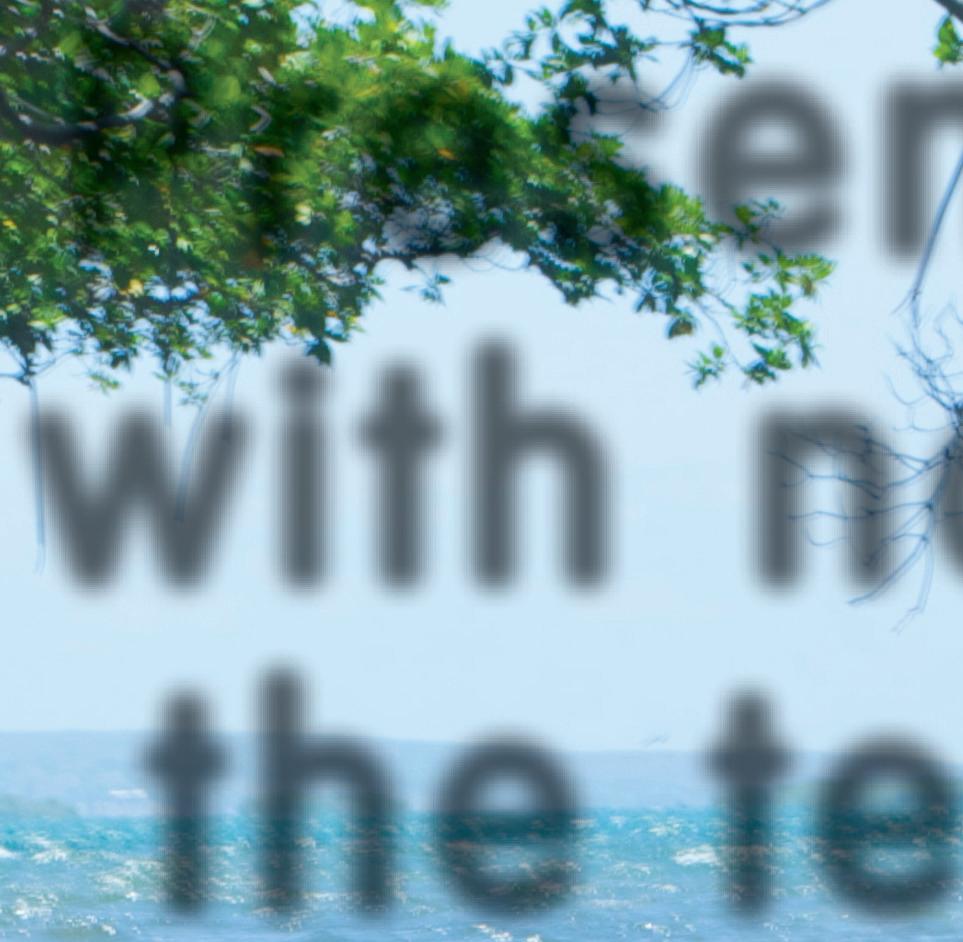
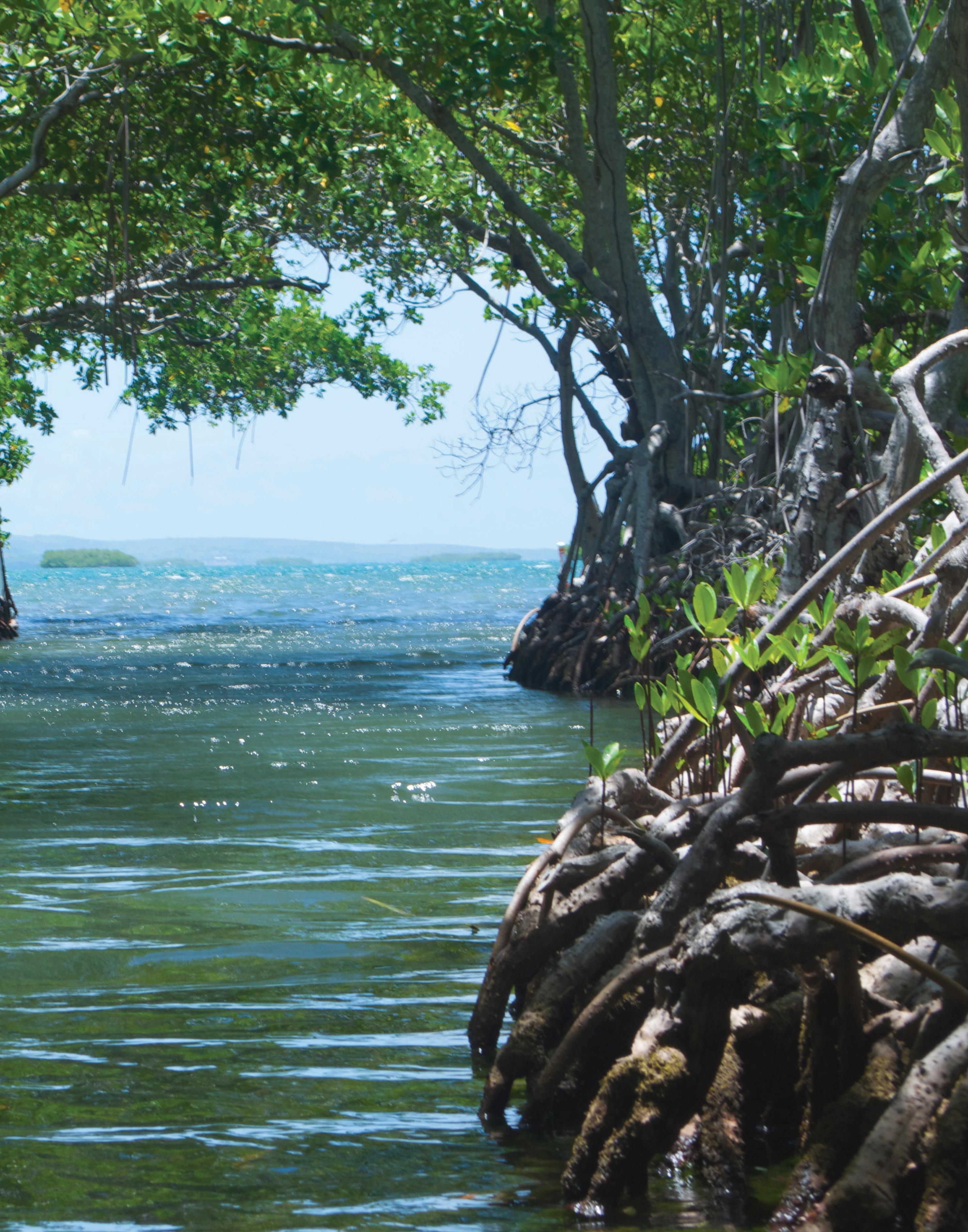
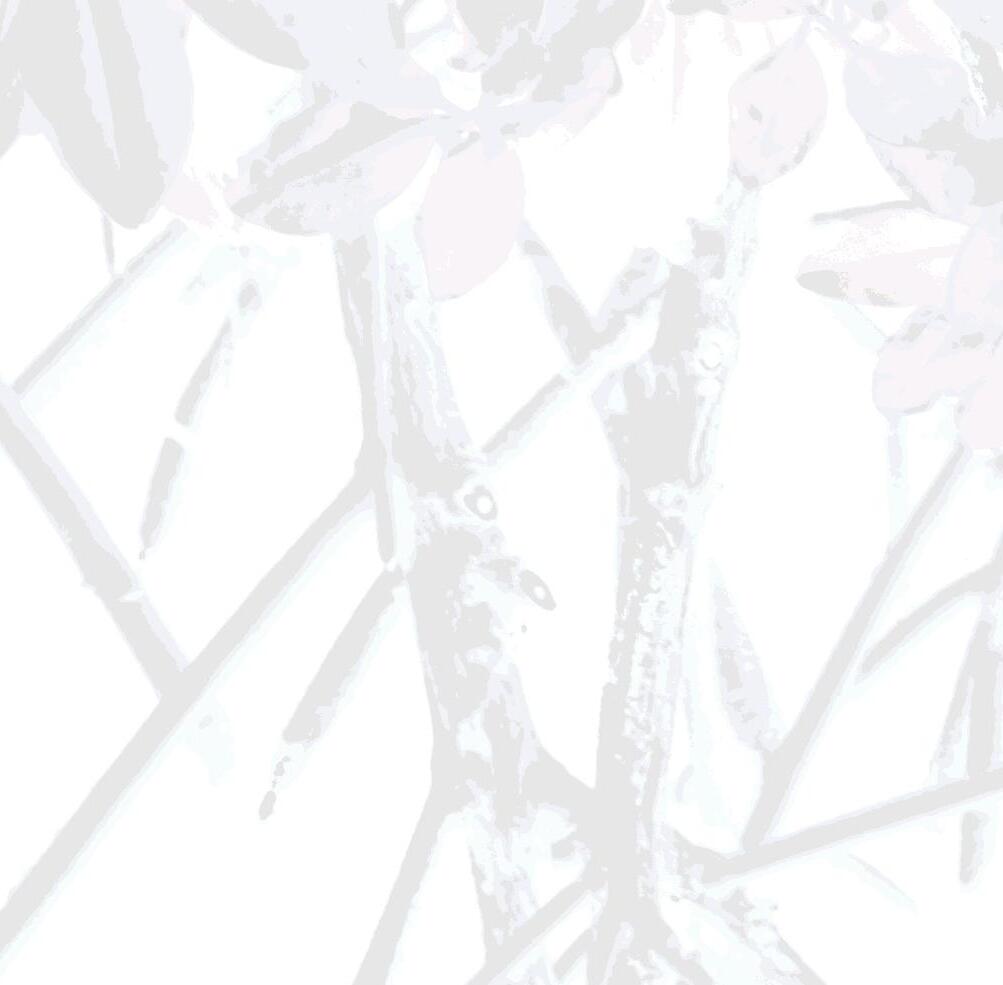

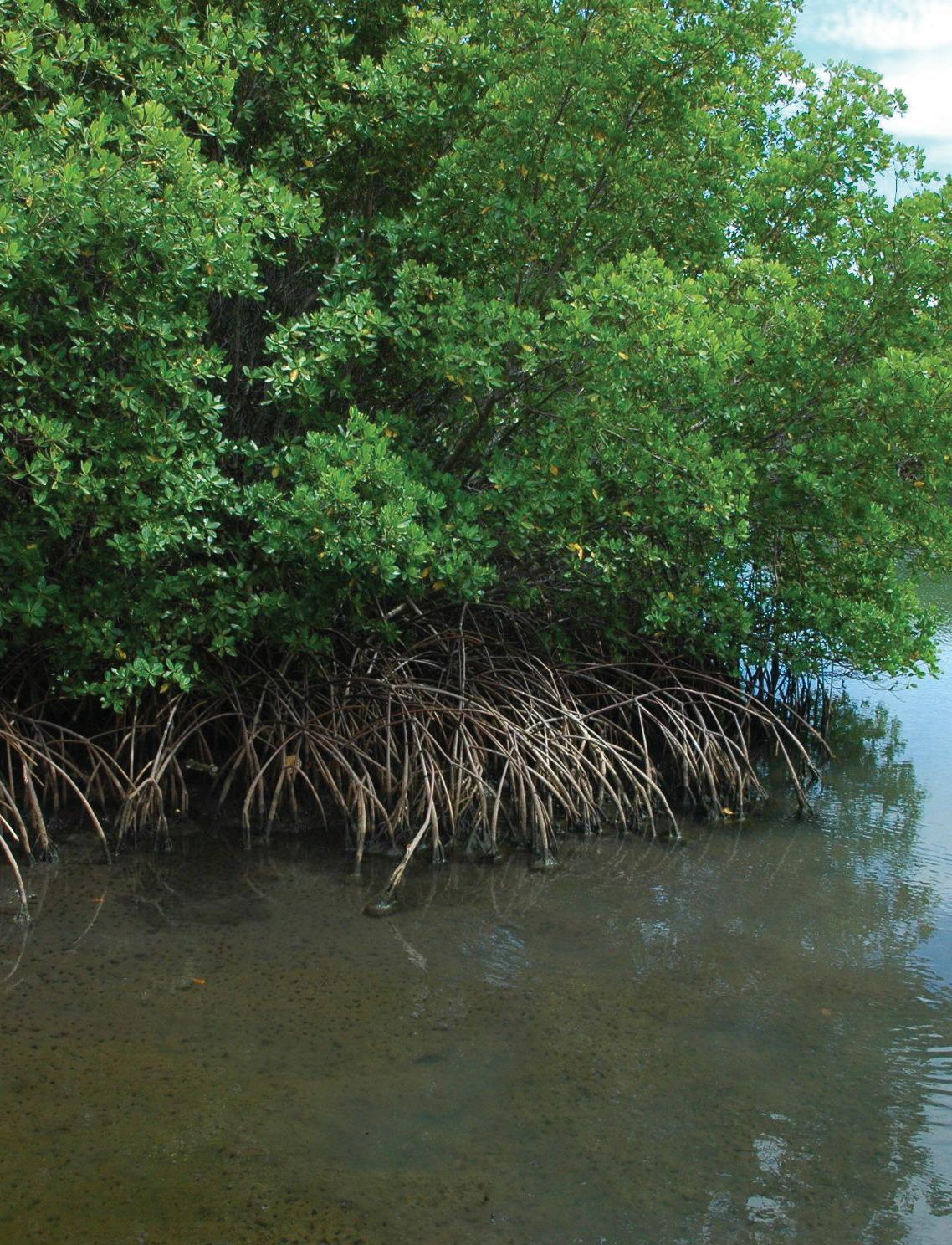






• A mangrove is a tree with special adaptations which allow it to survive in the littoral zoneʼs harsh conditions.
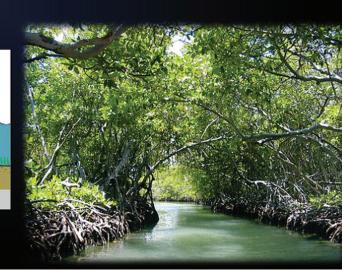


• The littoral zone is located where land and sea meet, and is characterized by being frequently flooded and featuring high salinity and poor aeration.

• A mangrove is a plant, tree or shrub, typical to the li oral or inter dal zone, which are very tolerant to high salinity and poor aera on in the soil.
• In the li oral zone, the soil is subjected to frequent water incursions (flooding), because of their exposure to dal changes in the sea (high and low des); the soil is poorly aerated and features high salinity.
• Mangrove wood is of excellent quality, and is very resistant to rot. In the past, mangroves were cut down to use their wood for cooking or to build fish traps, since they remain in good condi on even a er long periods underwater. In modern mes, mangroves are protected, and it is forbidden to cut them in Puerto Rico.






•A mangrove forest is a forest ecosystem which grows along the coastline and in mainly composed of mangrove trees.
•Mangrove forests are common in wetlands or estuaries where seawater meets and mixes with freshwater coming from rivers, rainwater runoff or subterranean sources.

• Defini on: A mangrove forest is a habitat composed of salt-resistant trees (mangrove trees of one or several species) which occupy the line between sea and land, and areas close to the river mouths which open to the sea. Mangrove forests are only found in tropical and subtropical la tudes.
• Wetlands and estuaries are zones in which seawater meets and mixes with freshwater coming from rivers, rainwater runoff or subterranean sources.

Mangroves can be found in tropical and subtropical regions, in warm temperatures oscillating around 60-77 F (15.5-25 C).


http://www.madrimasd.org/blogs/universo/2011/02/02/138188




• Temperature is a determining factor in world mangrove distribu on, limi ng mangrove forests to tropical and subtropical regions between the 30 degrees north and 30 degree south la tudes.

•Areas slightly exposed to waves and surf surges are ideal for good mangrove forest development.


•Alluvial substrates present in frequently-flooded land favors mangrove forest development.
•Coastal regions with mild slopes have a wide littoral zone, on which mangrove forests can grow.



• Areas exposed to mild waves and surf surges are less likely to be eroded, which makes them ideal for mangrove forests, since it fosters good propagule se lement.

• Soils featuring alluvial substrates are rich in organic material (like silts) which aids mangrove growth.
• Mangrove forests occupy soils on which strictly terrestrial plants could not survive, such as soils frequently flooded by saltwater.
There is a larger distribution of mangrove forests in the southern Puerto Rico region than the north coast.



• The largest mangrove forest in Puerto Rico can be found in the northeastern coast (Figure 5), at the Piñones area in Loíza. The north coast’s mangrove forests are associated with freshwater ingress through lagoons and rivers (bank mangroves), and from rainwater runoff (riparian mangroves). Due to the Atlan c Ocean’s strong surf and surge condi ons, the north coast’s mangrove forests only develop in places protected from these harsh condi ons. Along the south coast, on the other hand, mangrove forests extensively border the coast (border mangroves) and cays (cay mangroves). The underwater seabed is wider and fla er than the one on the north coast, and the surf and surge condi ons on the Caribbean Sea are much calmer than the Atlan c Ocean’s.
• Sugges ons: Here the teacher can point out the loca ons on Puerto Rico which foster mangrove forest development; keep in mind that the green areas represent presence of mangrove forests.


• The teacher must emphasize that mangroves are more common in the southwest, south, and northeast regions in Puerto Rico. Also, they can perform an exercise with the students that can incorporate geography, by iden fying the townships in which mangrove forests may be found.




• Worldwide, there are about 54 species of mangrove.
• In Puerto Rico, there are four species. These are:


– Red mangrove (Rhizophoramangle)
– Black mangrove (Avicenniagerminans)
– White mangrove (Lagunculariaracemosa)

– Buttonwood(Conocarpuserectus)
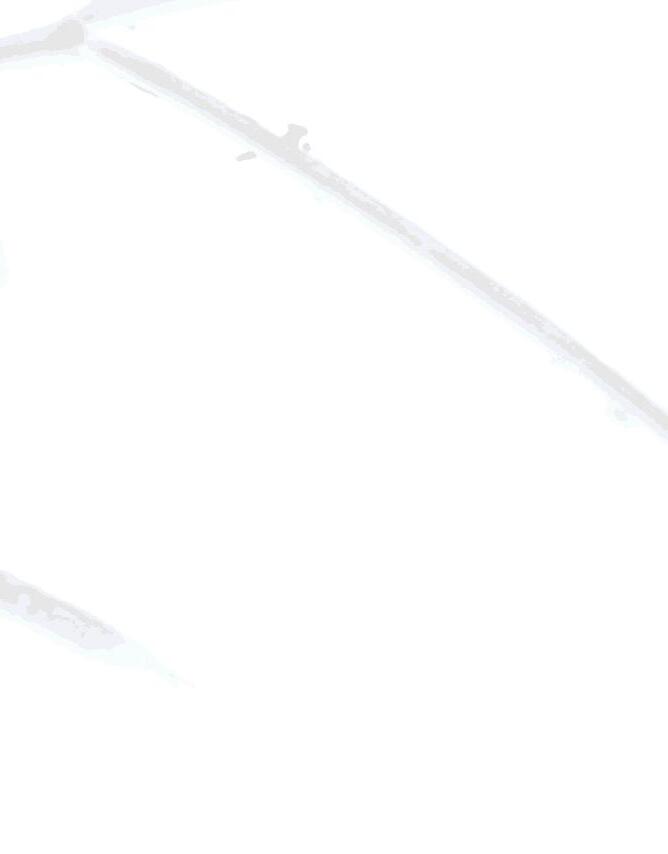
• Out of the 54 species of mangrove exis ng around the world, approximately 10 may be found in the Caribbean area, and only 4 in Puerto Rico.


Mangrove species are distributed in perpendicular order on the coast (zonation), which depends on factors such as:

• toleranceto salinity,



• adaptations to life in poorly-aerated soils, and
• ability to become established on unstable soils.
High salinity
• Different mangrove species are arranged in perpendicular fashion along the coast, from the sea towards the mainland. This distribu on is known as zona on, and it depends on each mangrove species’ adapta ons to the extreme soil condi ons.
• Please observe the zona on shown by the four mangrove species we have in Puerto Rico in the image above.
• We can see that the red mangrove is the first species encountered, always in direct contact with the water.
• Immediately a er the red mangrove, we come upon black mangroves, located further up the coast. It has special adapta ons that allow it to survive in higher salinity concentra ons.
• A er the black mangrove, we can o en find white mangroves. As shown in the diagram, white mangroves can be found further from the water because, much like the black mangrove, it has special adapta ons for life in high salinity condi ons. Black and white mangroves can o en become established in the same areas, so that the posi ons of these two species may be interchangeable.
• Lastly, we may find bu onwood. This mangrove usually grows in the coastal zones furthest from the sea, where exposure to the sea water is minimal. Soils in this area have the least salinity satura on as well as the most oxygena on, and bu onwood readily mixes in with terrestrial vegeta on.
 Buttonwood White mangrove Black mangrove Red mangrove
Buttonwood White mangrove Black mangrove Red mangrove

The diverse mangrove species can be identified by some distinctive traits, such as::
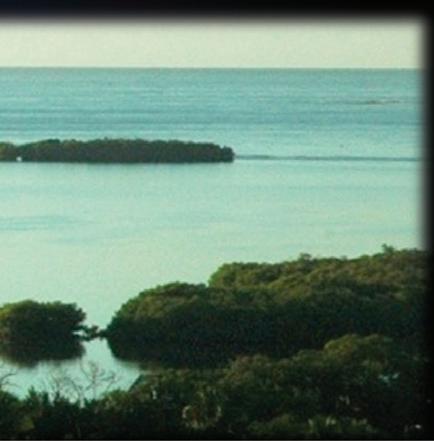


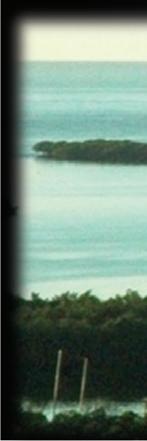
– leafshape,


– flowerand fruitshape,
– presence/absenceof pneumatophores, and




– placementalongthehabitat.
Sugges on: The teacher might take this opportunity to review basic botany concepts.

• Red mangroves are in direct contact with the water.
• This species features aerial prop roots which branch off from the tree trunk and droop towards the ground below.





• The underwater roots create a complex network that comprises a crucially important habitat to many marine organisms, especially during their juvenile life stages.
• The most common mangrove in Puerto Rico is the red mangrove. This tree is the main cay builder seen along the coasts, such as those around La Parguera (Lajas), Cabo Rojo and Guayama, among other townships.

• Red mangroves are commonly found in direct contact with the water. It is the first species encountered along the coastline, going from the sea towards the mainland.
• The red mangrove is the only species presen ng aerial prop roots, which branch off the main tree trunk and droop towards the ground below in s lt-like fashion.
• These aerial prop roots fulfill life-sustaining func ons such as nutri on and aera on and, in their underwater parts, comprise an important habitat which serves as a haven for mainly juvenile organisms.







• The roots aid in soil stabilization.
• The bark is pale olive green. However, the interior is reddish.


• The roots are covered in lenticels, pore-like structures which aid in the mangroveʼs gas exchange.

• These roots provide be er stabiliza on to red mangroves, which allows this species to thrive in so sediment areas and resist high wind and surf condi ons. The roots also trap and stabilize sediments.




• The red mangroveʼs leaves are large, thick, and have a waxy texture.
• They are simple leaves, opposite, and often grouped along the branch tips.
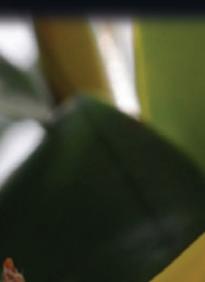

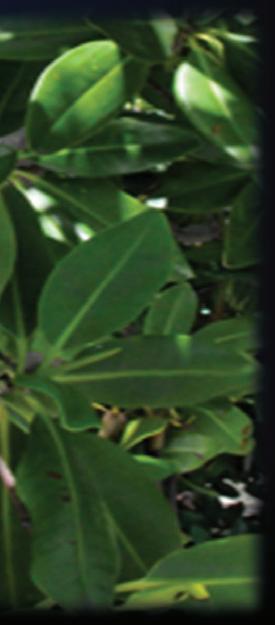





• Red mangrove leaves are large (8-10 cm long and 4-5 cm wide), thick and waxy, which inhibits their decomposi on and water loss.

peduncle sepals


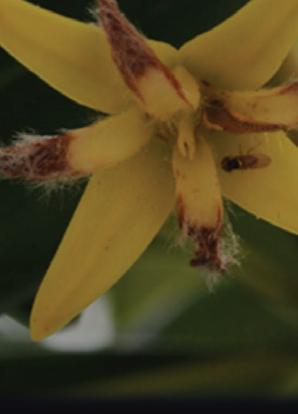

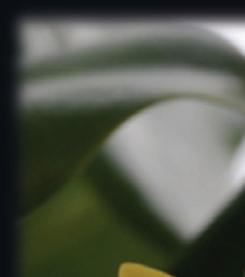


petals

•Flowersare small.
• Each peduncle can sprout between 2-4 flowers.
• Sugges on: The teacher might take this opportunity to review basic botany concepts.



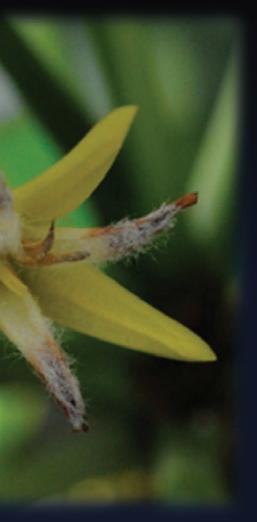
Red mangrove flowers present 4 sepals, 4 white petals, and 8 stamen.
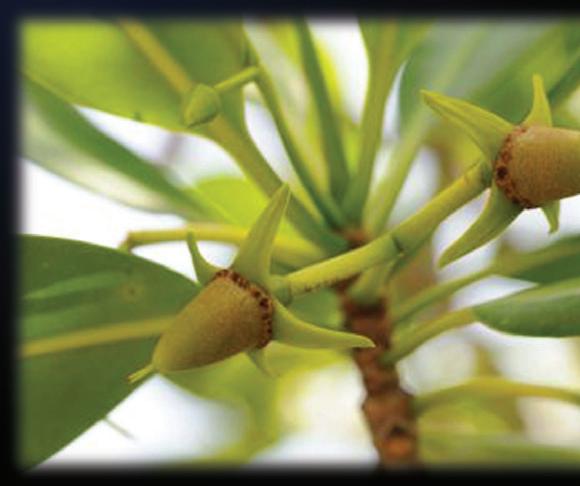
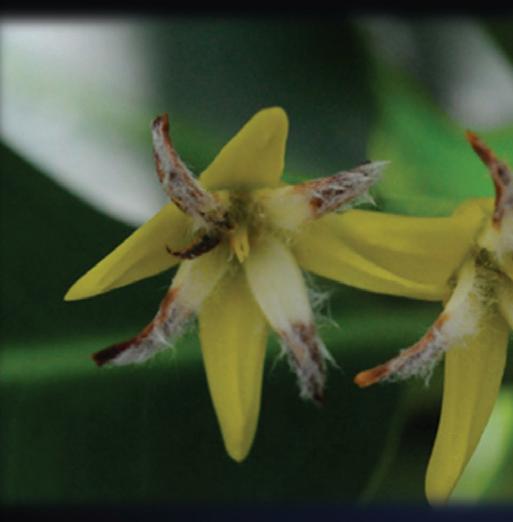
Red mangroves flower throughout the year.
• The












white petals turn dark and fuzzy as me progresses.
These are plants which are fully developed by the time they fall from the tree and become settled in the substrate.
Red mangroves are hermaphrodites; it can be selfpollinized, or become wind pollinized.

The seed sprouts within the fruit (vivipary).


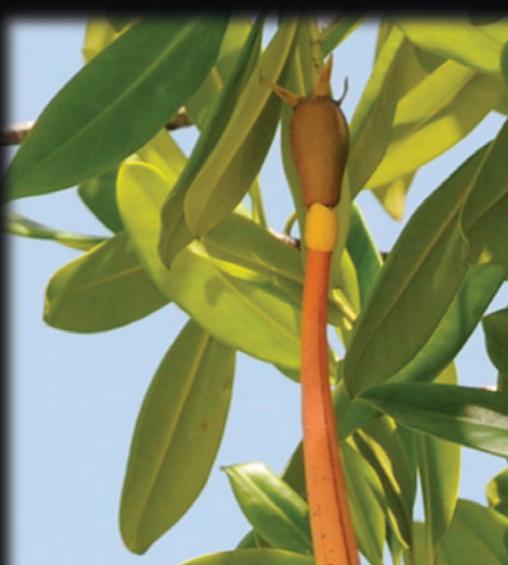
Red mangroves spread through propagules.
Propagules are small, lanceolate trees.

The root develops in the widest section.




By the time it drops from the tree, it already features many lenticels, a stalk, and its first two leaves.


When it drops from the tree, the propagule anchors itself to the substrate and grows into a mangrove tree.

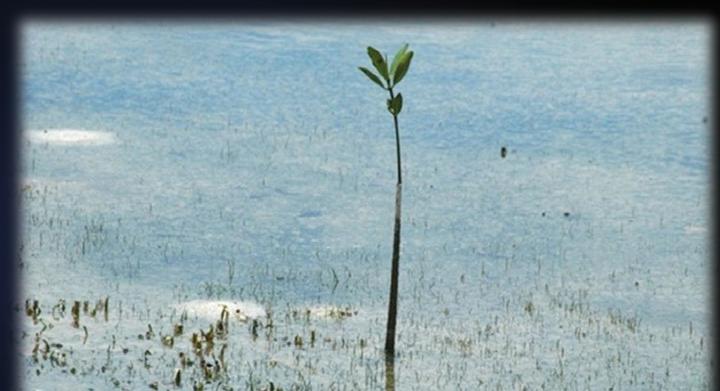
If it falls into the water, the propagule may float for up to a year until it finds an appropriate place to anchor itself and begin to grow.
• When a propagule falls into the water, it floats and is readily transported to other loca ons by sea currents. Although it begins to float horizontally, it quickly begins to absorb water and, due to its torpedo-like shape, it gains more water weight on its thicker, bo ommost part and starts floa ng upright and ver cal.





• This is a very successful reproduc on method which has allowed for the development of cays we commonly find around our coasts.

• Black mangroves develop behind the red mangroves, on soils with higher salinity and less oxygen.
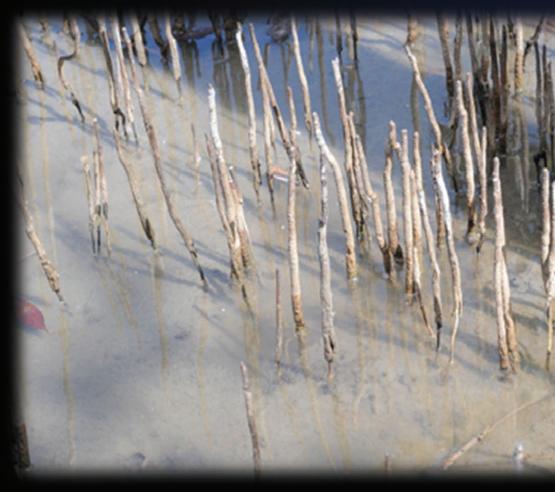

• The tree trunk is gray or black.







• It features pneumatophores, root projections which protrude from the ground and aid in the mangroveʼs gas exchange (O2, CO2)
• Black mangroves have a superficial root system featuring long, fingerlike projec ons which grow out from the substrate and can reach heights above 20 cm above ground. These projec ons are called pneumatophores.
• Pneumatophores are long and slender, and their func on is to allow mangrove aera on in poorly oxygenated soils.
• Remember that plant roots need oxygen for op mal development. For instance, earthworms are a great help to plant development, as they create tunnels which aid the flow of oxygen in the soil.

• Black mangrove leaves grow in opposite array.
• They are lanceolate, with a pointy apex (leaf tip).

• Black mangroves exude salts on the dorsal surface of the leaf, forming crystals.
• Black mangrove leaves are smaller than those of the red mangrove, and are lanceolate shaped with a pointy apex (leaf p).
• The dorsal (top side) part of the leaf is green and the ventral (bo om side) is opaque and yellowish green.
• The leaves on a black mangrove are the main salt excre ng organs featured in the tree. Salt crystals can o en be found on the leaf’s dorsal side, deposited there by the stoma.




• Older leaves can accumulate high salt concentra ons before falling off, and o en present burn spots due to the “magnifying glass” effect created when sunlight is filtered through the salt crystals.






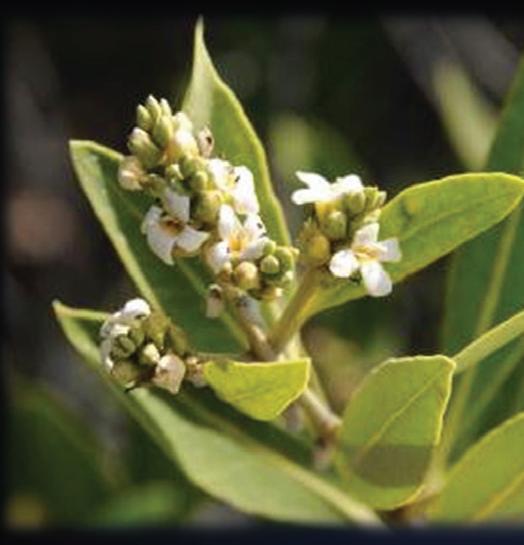




• Theflowersare small, and maybe whiteor yellow. Theybloomin dense clusters.
• Features4 whitepetals and 4 stamen.






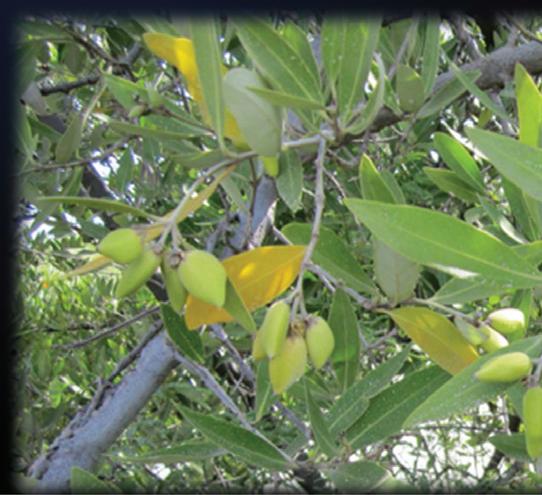

• Thefruitisanoval capsule.
• Insidethefruit, the seedbeginsto germinatebefore dropping.


• Theseedsare released fromthefruitonce it fallsintothewater.
• The black mangrove’s fruit is shaped like a small, fla ened, oval capsule .


• The embryo develops while s ll a ached to the parent tree, and fixes itself onto the substrate upon falling.



• If it falls into the water, the embryo can float for several weeks un l it reaches an appropriate place on which to se le.

•Itistypically located behind the black mangroves, towards the mainland and in salty, poorly-aerated soils.

• Thewhite mangroveʼs bark is rugged and fissured along the length of the trunk. Itislightcolored.
• White mangroves are typically located behind black mangroves, heading towards teh mainland, in salty, poorly-aerated soils.
• It develops op mally in sandy substrates.
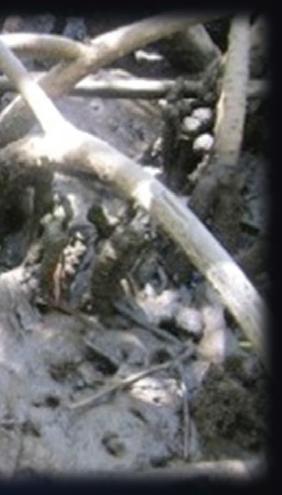









• White mangrovefeaturespneumatophores thataidin gas Exchange.

• Thesepneumatophoresare shorterthanthe onesonblackmangroves.
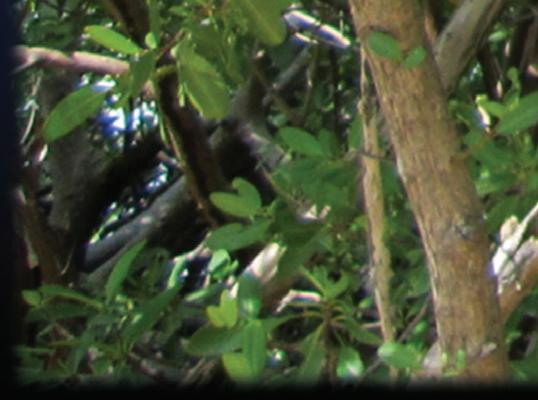

race


• Theleavesare opposite.


• The leaves are simple, thick, and oblong (oval) shaped.




• White mangrove leaves are thick, oblong (oval) shaped, with a rounded apex ( p).


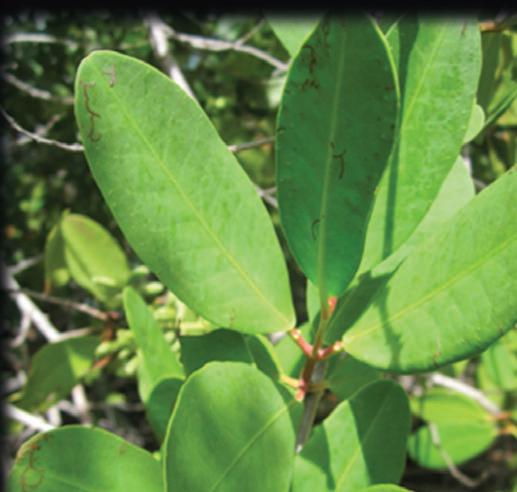
• The dorsal surface is grayish green, while the ventral surface is lighter colored.



Thewhitemangrove features two glands at the petiole base, which are in charge of excreting excess salt


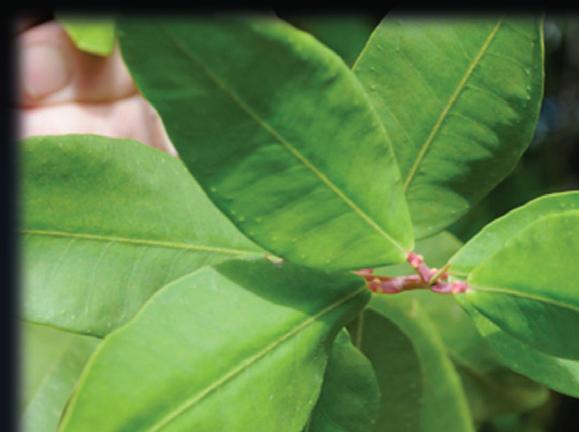




White mangrove flowers are small (0.2 to 0.3 cm), white and plentiful.

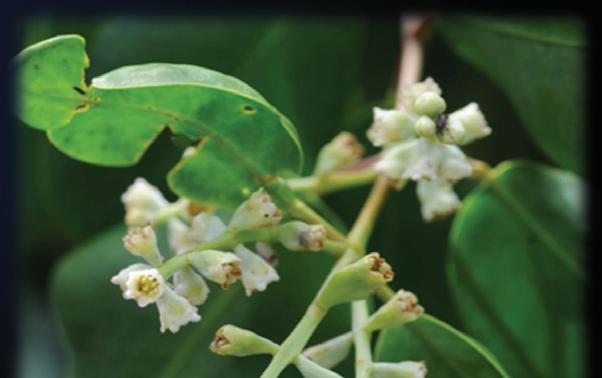
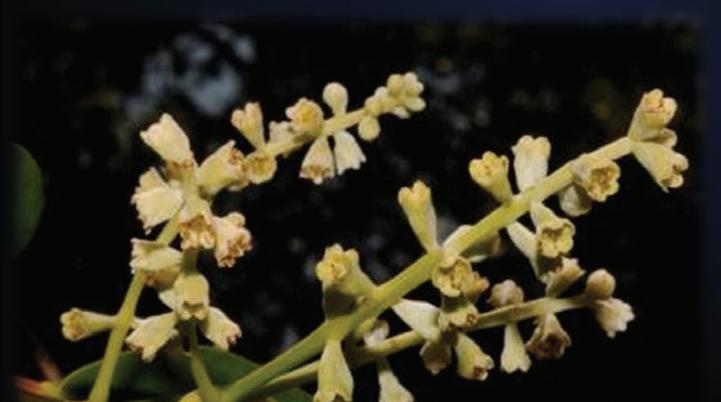
Thepetalsare tube-shaped.
• White mangrove flowers are small (0.2 to 0.3 cm) and plen ful, and their external parts fused to form a tube with five triangular lobes or teeth.
• At the end of the tube, it grows five ny, rounded petals, about 0.1 cm long.




• The flowers grow in clusters, forming inflorescences (groups of flowers on the branches) that can measure 3 to 7 cm in length.





• Thefruitfeatureslengthwiseridges, and iscolored greenwhenitisimmature. Itturnsbrownas it ripens.






• Thesingle seedwithinthefruitisviviparous.
• Generally, the embryo develops just before falling off the tree.
• If it falls into the water, the seeds float and are dispersed by the currents.
• The fruit is drupe. A drupal fruit is a fleshy or pulpy fruit. Other drupal fruits include peaches, plums and mangoes.
• Buttonwoodcan be foundin elevated, low-salinity, sandysoils.
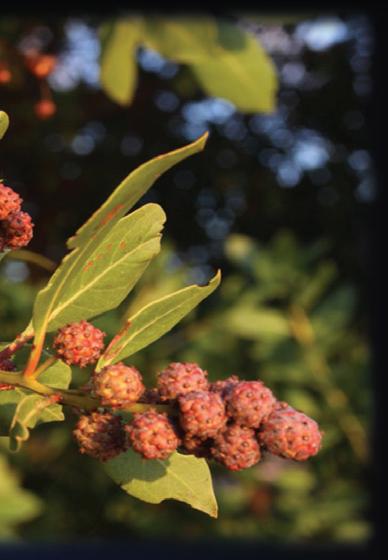
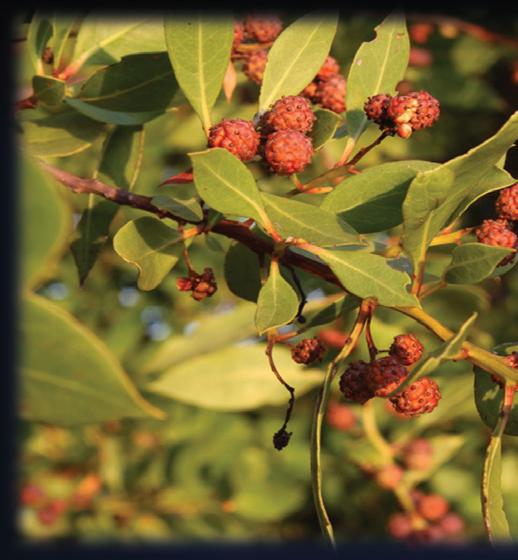
• Ithas elliptical, alternateleaves(theonlymangrove speciesin Puerto Rico to featurethis).
• Leavesfeaturetwoglandsonthepetiolewhichexcrete excesssalts.





• Bu onwood can be found in the inter dal zone furthest from the sea, in low-salinity, elevated, sandy soils, where it mixes with terrestrial vegeta on. Because of this, some field experts do not consider it a true mangrove.
• Bu onwood usually grows as a shrub.
• The bu onwood’s leaves are ellip cal and small (4-9 cm long and 2-3 cm wide).
• The leaf pe ole is small and, like the white mangrove, has two small salt-excre ng organs on each side.




• The flowers are tiny, green and fragrant.
• Clusterand grow intoglobe-shaped, rounded inflorescences.


• Eachglobecontains severalseeds.



• Bu onwood flowers are ny (0.2 cm wide) and grow in large numbers to form round inflorescences.field experts do not consider it a true mangrove.


• Buttonwood gets its name from the shape of its fruit, similar to a tiny pinecone or button.


• Buttonwoodisnot considereda true mangrove, butrather, a peripheralspecies.



• Mangroves s are e carbon n sinks s and g oxygen n producers rs r .























• Mangrove e forests s provide e home and g shelter r for r many p y species s and d their youngg.

• Mangroves s protect t the e coasts s from g strong p g winds s and d waveses.
• As all other forests, mangrove forests have global importance since they absorb carbon dioxide (CO2) during their photosynthesis process. They also release oxygen as a waste product.




• By consuming atmospheric carbon dioxide, mangroves help reduce the Earth’s greenhouse effect and therefore, reduce climate change (global warming).

• Photosynthesis lets the mangrove convert solar energy into organic material such as leaves, flowers and wood. The organisms capable of doing this are known as primary producers.

• They serve as nursery zones (offer shelter to species in their juvenile stages), refuge and feeding grounds for many commercially important species such as snappers, land crabs, lobsters and conch.
































• Mangrove forests are characterized by their enormous biological diversity. In a mangrove forest, one can find a large number of bird, fish, crustacean and mollusk species.


• Mangroverootsand leavesdecomposeand becomeinorganic nutrientsand substancesthatotherorganismsuse.






• Mangrovesretainand stabilizesedimentsand pollutants comingfromtheshore, helpingcleanthewatersflowinginto thesea.

• Mangrove forests are highly produc ve habitats and they export some of that energy in the form of biomass or nutrients for other ecosystems. For instance, fish and crustacean larvae grow and develop in mangroves, and later migrate to other marine ecosystems.
• Mangrove trees absorb nutrients and pollutants from the water, and are therefore fundamentally important to keeping the waters clean and clear.
• Seagrasses and corals thrive in clear waters that allow sunlight to reach the bo om so that the grasses and microalgae associated to coral polyps can perform photosynthesis.

• Mangroveforestsare nestingareasformanybirdspecies, and are importantrestingzonesformigratorybirdspecies.
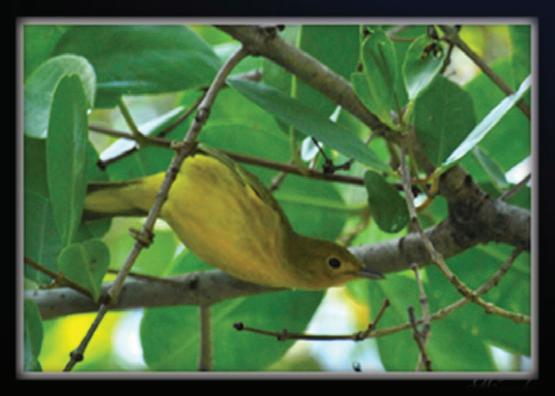

• Mangrovesprovideeconomicbenefitsto human communities (e.g. eco-tourism, fishery).




• Mangrovesare partof thegreatmangrove‒seagrassmeadow ‒coral reefecosystem.
• Mangroves are zones in which many birds nest and rest, including the African ca le egret, or some endemic species such as the yellow-shouldered blackbird.
• Mangrove health depends on seagrass meadow and coral reef health. These three ecosystems are interconnected and depend on each other.
 American yellow warbler. Photo by MaisidraVega.
Mangrove forest canal, Ensenada Grande, Culebra Photo by: Gonzalo Dean.
American yellow warbler. Photo by MaisidraVega.
Mangrove forest canal, Ensenada Grande, Culebra Photo by: Gonzalo Dean.



• One of the current problems mangrove forests face is that, due to their place between the sea and the mainland, trash from both sea and land affect them, harming all the species which inhabit it.






• Many mangrove trees have been cut to make way for construc on or to access the beach (docks, ar ficial beaches like Playita Rosada, in La Parguera). In the photo supplied above, we can see how several homes occupy an important part of the coastline, previously formed only of mangrove trees.





Normal waterflowchangescause mangroveforestfiresdueto excessivesalinityin thesoil.




• This is an example of how mangrove forests have been affected in the Cabo Rojo, PR, area, more specifically near the entrance to Playuela (Playa Sucia).


• A er a hurricane, water flow to the area became modified and restricted; the water became sal er and warmer, and caused the death of the mangrove trees (mostly black mangroves) that lived there.
 Dr. Juan G. González
Dr. Juan G. González



Between1980 and 2005, anestimated20% -30% of mangroveswerelostworldwide.
In Puerto Rico, the1970ʼs presenteda considerable lossin mangroveforests.
Thanksto legal protectionsincethe1980ʼs, mangrove coveragehas beenslowlyrecoveringthroughouttheisland.
• In the past, large tracts of mangrove forests have been lost worldwide.
• Thankfully, the undertaken mangrove forest management measures have shown posi ve results. In the last decades, important increases in mangrove forest coverage in the Caribbean have taken place, including in our local area.




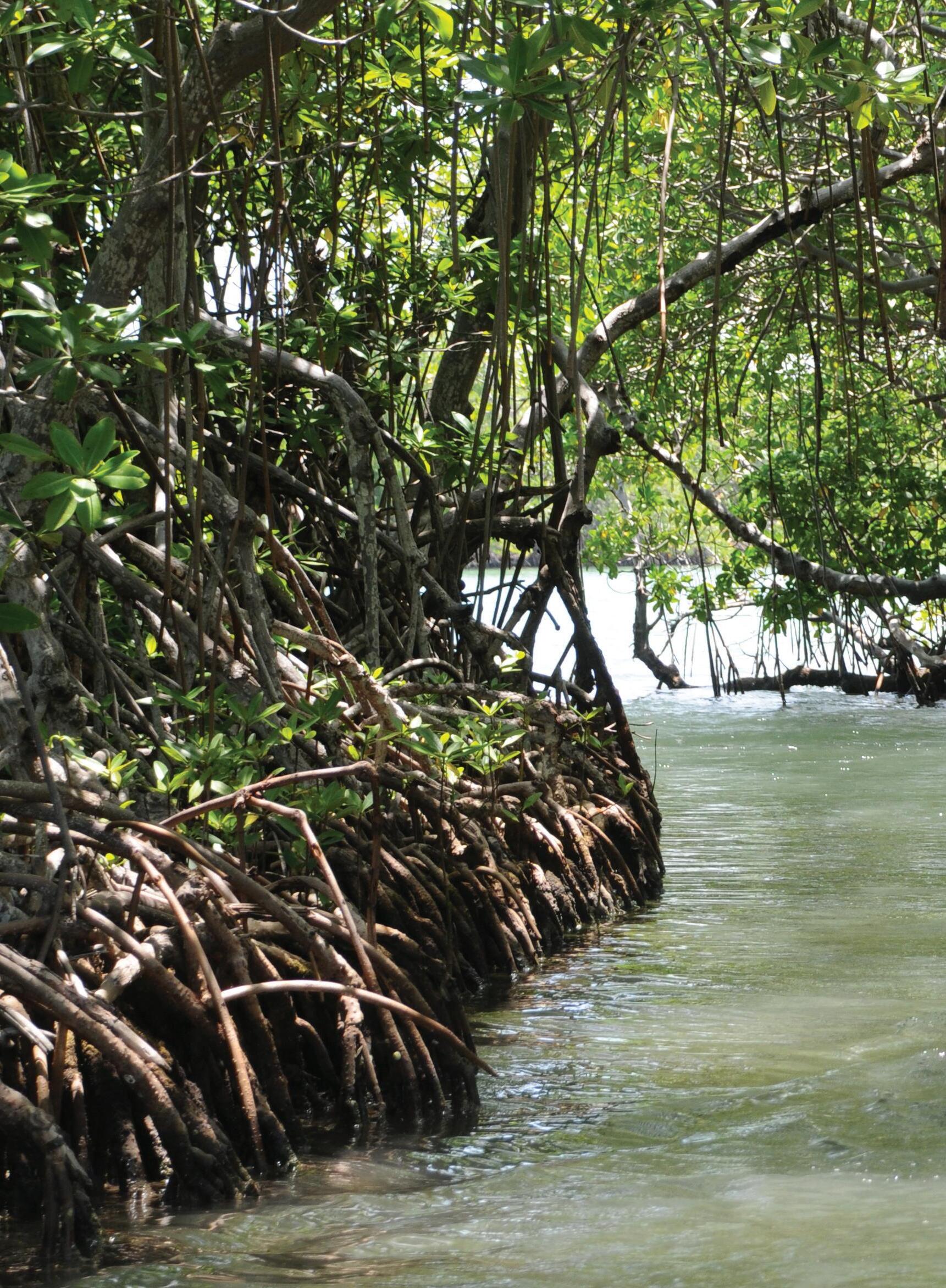
Time: 1 period
Teaching strategy: ECA


What are mangroves and mangrove forests?
What are mangroves and mangrove forests?


Types of mangrove forest Types of mangrove forest
Objec ves:
Phases: explora on, conceptualiza on and applica on
Teaching method: demonstra ve, inquiry-based, ac on or ac vity
Teaching technique: coopera ve work, discussion, homework
Assessment technique: open ques ons, graphic organizer, puzzle
Integra on with other subject ma ers: Biology, Ecology
Materials:
• Mangroves: Teacher’s Manual
• Mangrove-shaped graphic organizer slide
• Mangrove characteris cs chart
• Puzzle with pictures of the four mangrove types
• Magnifying glass
Depth of knowledge level:
Level I: Memory thinking
Level II: Process thinking
A er studying the topic What are mangroves and mangrove forests? and the types of mangrove, the student will be able to:
• correctly define a mangrove tree. (conceptual)
• explain what is a mangrove forest. (conceptual)
• explain each mangrove’s characteris cs. (conceptual)
• compare and contrast mangroves with other common trees. (procedural)

• iden fy the four (4) types of mangrove found in Puerto Rico (white mangrove, black mangrove, red mangrove and bu onwood). (procedural)
• share their knowledge with their peers. (a tudinal)
1. Gree ngs
2. Administra ve business – roll call, etc. (performed internally)
3. Reflec on: “If there are no mangrove forests, then the sea will have no meaning. It is like having a tree with no roots, for the mangroves are the roots of the sea.” Andamanese fisherman. Taken from: The Mangrove Decade and Beyond (1990-2001) h p://www.mssrf. org/csr/csr-pub/03-Mangrove%20decade%20and%20beyond.pdf.
4. The teacher will begin class by projec ng a graphic organizer shaped like a red mangrove tree on the board. In the ‘Leaf’ sec on, the teacher will write the ‘Mangrove’ concept, and ask students to men on their thoughts on the concept. The resul ng words or phrases will be placed in the mangrove root area.
5. Later, the teacher will ask the students to use the men oned words and phrases and build a defini on of ‘Mangrove tree’. The teacher may aid the students when making their defini on by asking: Is the mangrove a tree? What’s the difference between a mangrove tree and other trees commonly found in Puerto Rico? What are the similari es? Students may also make a list of the differences and similari es between a mangrove tree and a regular tree such as a mango, avocado or breadfruit tree, or an oak, mahogany, holywood (guayacán), Spanish elm, or any other tree commonly found in their area.
6. Having defined what a mangrove tree is, students will then have to explain what a mangrove forest is.
Mangrove tree: a tree or shrub that can grow in places in which the soil is permanently or temporarily flooded; it may also grow in the water. It is a very tolerant plant that can adapt to both salt water and fresh water sources such as rivers or lagoons. A mangrove tree may grow in hypersaline waters, or soils less saturated with salt (Programa Semillas para el Ambiente, 2006-07).
Mangrove forest (general defini on students may provide): a forest formed by tropical trees typical to coastlines, that feature special adapta ons for growing in saline and flooded environments.
Mangrove forest (formal defini on): a forest ecosystem comprised of tropical trees typical to coastlines that feature special morphological adapta ons that allow it to grow in saline and flooded environments with poor soil oxygena on, and poor seed germina on condi ons. These forests are subject to periodical dal ac on and are dominated by one or more arboreal mangrove species.
Mangrove forests fulfill an important func on in protec ng the coasts against wind- and wave-driven erosion, feature high produc vity, and shelter a large variety of aqua c,
amphibian and terrestrial organisms. Also, they serve a cri cal role in coastal and con nental shelf fisheries, since they provide habitat for the juvenile stages of hundreds of fish, mollusk and crustacean species. Moreover, they serve as temporary habitat for many northern and southern migra ng bird species (Diccionario Enciclopédico Dominicano de Medio Ambiente, 2012). Finally, mangrove forests keep coastal waters clean by trapping sediment. Because of this, mangroves accrete, or collect soil and are considered “land builders.”
1. A er having clearly defined mangrove trees and mangrove forests, the teacher will split the class into four (4) groups and give them a chart describing the four (4) types of mangrove and their most prominent features. Then, each group will receive a jigsaw puzzle with a photograph of a mangrove species. The photo includes the tree itself, and close-ups of the roots, leaves, seeds and flowers.
2. The students must build the puzzle and glue their pieces onto an 11”x17” poster board. Once the pieces have been glued, students will observe the photo carefully, using a magnifying glass to compare the photo with the characteris cs presented in the chart. In this manner, they will iden fy the species of mangrove they received. This ac vity can be performed as a race, in which the first group to finish may receive a small prize, such as a s cker, a complete photo of a mangrove, etc. (The prize is up to the teacher.)
Alternate op on: If the classroom is computer-enabled, the teacher may search for free jigsaw puzzle making so ware using the mangrove tree photographs. One sample of this free so ware is BrainBreaker 5, but there are many other op ons. It is worth men oning that neither the Sea Grant Program nor the University of Puerto Rico endorse any par cular program or brand.
3. Following the previous step, each sub-group of students will present to the rest of the group the completed photograph and will report on which mangrove tree species it is. They will explain the characteris cs they observed and what led them to their conclusion. The teacher will use this opportunity to discuss and explain the topic with the students.
Note: The teacher must be fully knowledgeable about these characteris cs, so that the discussion is effec ve and informa ve. Please read the mangrove species characteris cs sec on thoroughly.
1. To conclude the class, retake the red mangrove graphic organizer from the beginning of class and ask a volunteer to explain, in his/her own words, what mangrove trees and forests are.
2. Then, the students can summarize what they have studied in class about mangrove types, men oning the main characteris cs that set them apart from other mangrove species. This will indicate the level of learning and objec ves achieved.
Main characteris cs:
Red mangrove: aerial prop roots and propagules

Bu onwood: seed is bu on-shaped, ny green flowers in clusters
Black mangrove: salt on leaf surface (it excretes salt through its leaves), prominent, long pneumatophores
White mangrove: salt-excre ng glands at the leaf pedicel, shorter pneumatophores than on black mangroves
3. Any remaining ques ons about the subject will be addressed.
Note: If the puzzles were glued to cardboard, selected students may put them up on the classroom wall while the lecture on mangrove species is taking place.
If the teacher wishes to reuse the pieces, the constructed puzzle may be laminated before cu ng it. This way, once the students have finished building the puzzle and using the image as an aid while covering the subject, the puzzle may be put away and reused at a later date.
Homework:
1. Students will be asked to find images of the different mangrove types found in Puerto Rico. The images must be of a suitable size to be glued to a map. Students may use different sources, such as the internet.

Praxis reflec on:
The reflec on will be performed by the teacher a er class is concluded.
Reasonable accommoda on:
Reasonable accommoda on will be offered to all students who need it. Students with physical or cogni ve difficul es will be offered reasonable me in which to do their tasks, tutoring during office hours and all the necessary opportuni es, according to their par cular cases.
Ocean literacy: Essen al principles and fundamental concepts
Principle 5: “The ocean supports a great diversity of life and ecosystems.”

e. The ocean is three-dimensional, offering vast living space and diverse habitats from the surface through the water column to the seafloor. Most of the living space on Earth is in the ocean.
Content standards and grade expecta ons
Biological sciences
Standard: Theme Organiza on Levels and Structure
Expecta ons and indicators:
From molecules to organisms: Processes and structures
1.B.CB1.EM.2 Makes observa ons with the inten on of describing the structures needed by plants and animals so they can grow and thrive.
3.B.CB1.EM.1 Observes and describes pa erns in plant characteris cs to determine their classifica on. Deduce that plants (grasses, shrubs and trees) have a set of structures that aid their classifica on.
3.B.CB1.EM.2 Iden fies plants according to their structure and the many kinds of stalks: grasses have not developed hardened woody structures and are so ; woody plants have developed hardened structures; roots (fibrous, ramified, or primary); and leaves (simple or compound, and according to the vein pa ern: parallel, penninerve, or palminerve; according to their margin: en re, undulate, dentate, serrated or lobate; and according to their stemming: alternate, opposite or basal).
4.B.CB1.EM.2 Men ons and poses arguments about the func onal advantages of the structural adapta ons.
Expecta ons and indicators:
The inheritance and varia ons in characteris cs
1.B.CB3.EM.1 Makes observa ons, describes and groups plants, animals and humans according to characteris cs that make them similar or different.
Standard: Interac ons and Energy
Expecta ons and indicators:
From molecules to organisms: Processes and structures
K.B.CB1.IE.3 Dis nguishes and describes different types of habitat in which living creatures live and adapt.
Expecta ons and indicators:
Biological evolu on: unity and diversity
2.B.CB4.IE.1 Recognizes ecosystems as places in which living and non-living things interact. Iden fy different aqua c (freshwater, such as rivers and creeks) and terrestrial (forests, deserts) ecosystems.


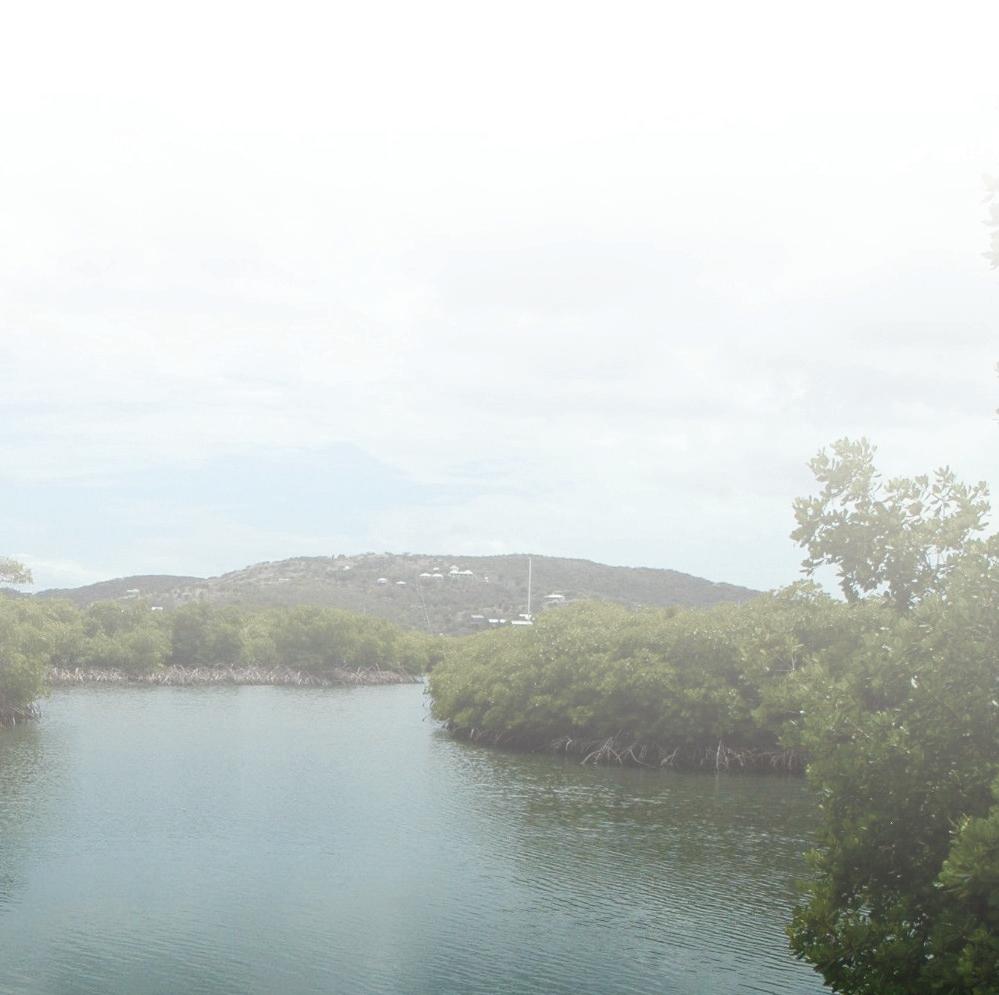
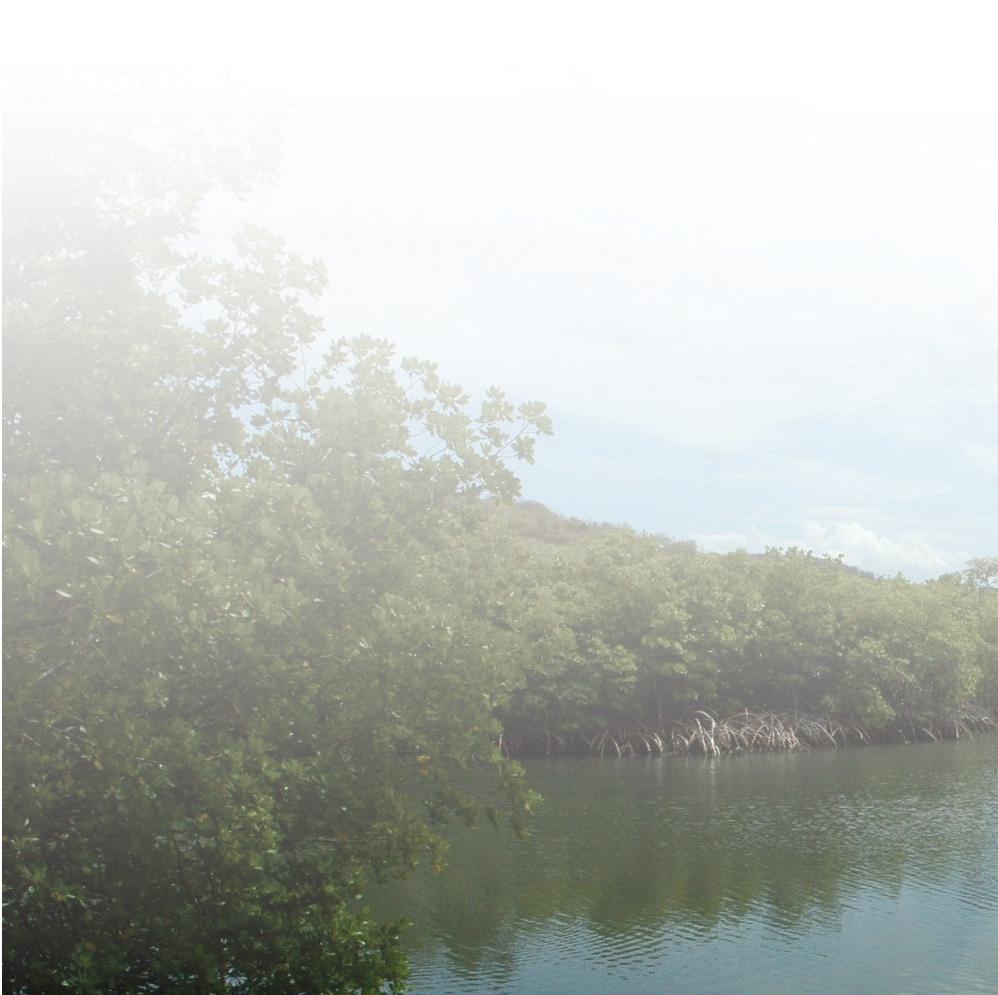
ons about biodiversity in terrestrial and aqua emphasizing in comparing ecosystem diversity.
2 2.B.CB4.IE.3 3 Makkes d direct obbserva ons b about b bi d odiiver i sity i in terrestriial l and d aqua c systems, in comparing
Standard: Conserva on and Change
Expecta ons and Indicators:
From Molecules to Organisms: Processes and Structures
4.B.CB1.CC.1 Defines, iden fies and uses evidence to prepare arguments about the adap ve mechanisms plants and animals feature that allow them to survive and react to changes in the environment.
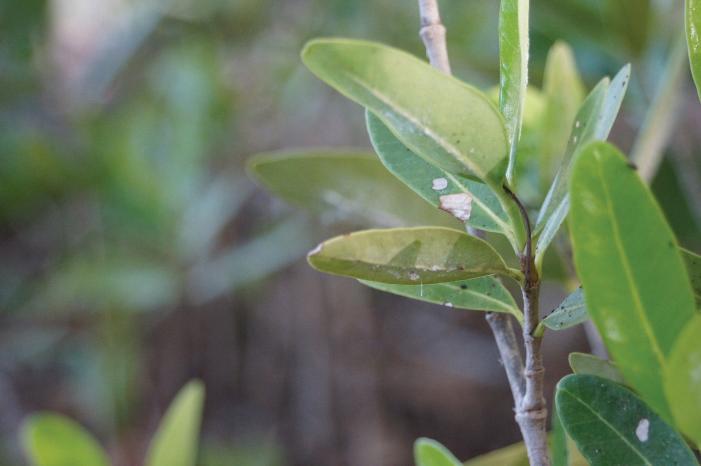

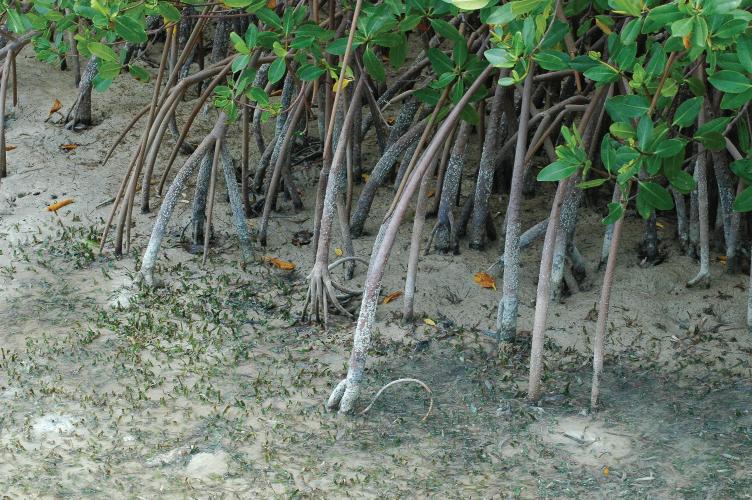
Physical Sciences
Standards: Subject Structure and organiza on levels
Expecta ons and indicators:
The subject and its interac ons
4.F.CF1.EM.1 Measures, compares and contrasts the subject’s physical proper es.
6.F.CF1.EM.1 Groups and classifies the subject by its chemical and physical proper es.
References:
Diccionario Enciclopédico Dominicano del Medio Ambiente. Zonación. Consulted on October 7, 2012, through h p://www.dominicanaonline.org/diccionariomedioambiente/ es/definicionVer. asp?id=615
University of Puerto Rico’s Sea Grant Program. (2010). El manglar. Consulted on October 18, 2012, through h p://www.youtube.com/watch?v=Ac5amhWk2-Y&list=UU83zZurmP8H44OtoKVfpmqA&i ndex=19&feature=plcp
Programa Semilla para el Ambiente. (2006-07). Manglares. Consulted on October 18, 2012, through h p://www.proambientepr.org/semillas/temas_educa vos/manglares/
Taken and adapted from: http://www.edupics.com/coloring-page-mangroves-i9469.html
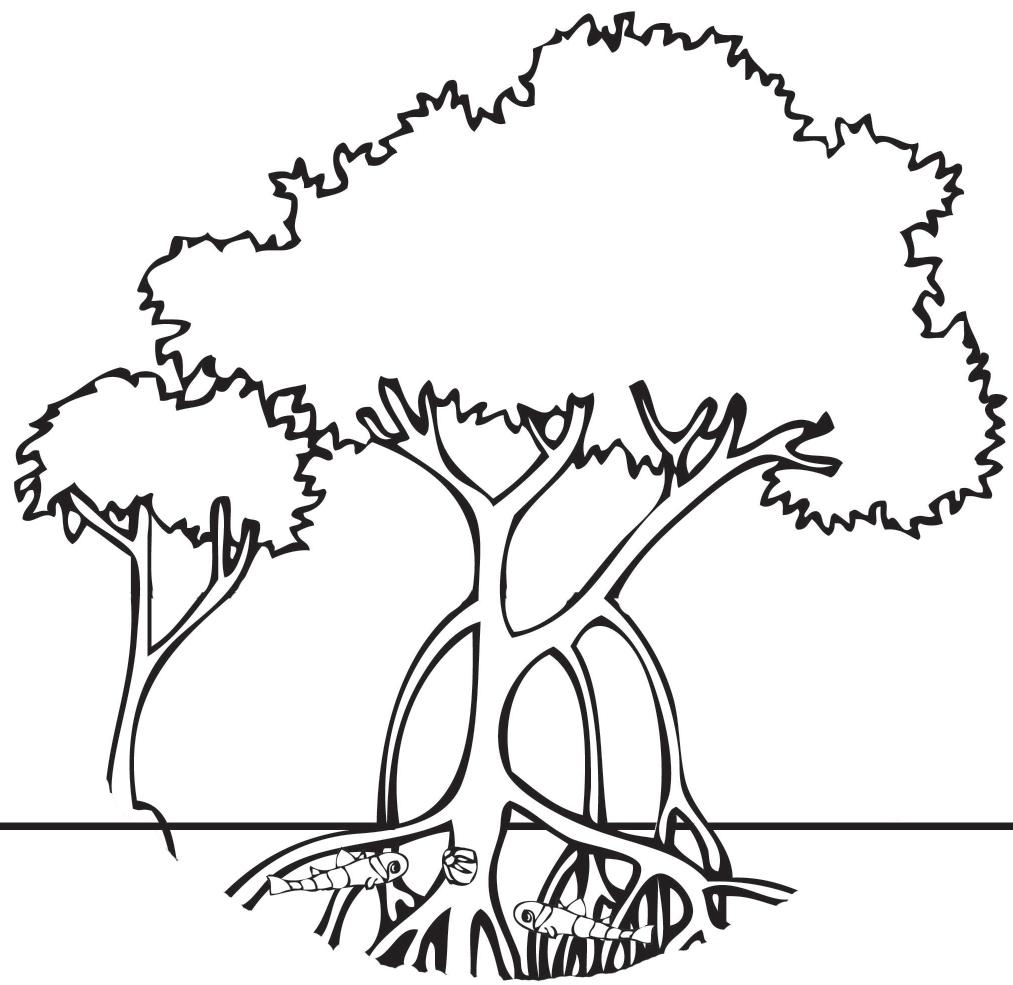
Characteristics
University of Puerto Rico
Mayagüez Campus
Sea Grant Program

Mangroves
Types of mangrove
Types of mangrove
Mangrove Red White Black Buttonwood
Roots Prop roots, tangled, aerial No prop roots, feature pneumatophores
Leaves Large, thick, waxy and oval-shaped
Oval-shaped, and with two glands at the petiole base
Flower
Small, with four White petals
Oval-shaped and brown
Fruit
Germinates on the tree itself, and is known as a propagule
Small and bountiful; feature five tiny petals, white and rounded
It is small, and features lengthwise ridges; when it is unripe, it is green, but it turns brown as it ripens
Feature pneumatophores (long, projecting roots) N/A
Lanceolate (sharply pointed on one end) and with salt crystals on the surface
Small, with white petals, and growing in dense clusters
Small, ellipticalshaped, and alternate; Features 2 glands
Tiny, green and forming globeshaped inflorescences (groups of flowers)
Capsule-shaped, small, oval and flattened; it is yellow
Round fruit, shaped like a decorative button










Time: 1 period
Teaching strategy: ECA
Mangrove zona on, geographic distribu on and zona on, distribu on necessary condi ons for mangrove development necessary condi ons for mangrove
Objec ves:
Phases: explora on, conceptualiza on and applica on
Teaching method: demonstra ve, inquisi ve, ac on or ac vity
Teaching technique: lecture, review, puppet demonstra on
Assessment technique: open ques ons, labyrinth
Integra on with other subject ma ers: Biology, Ecology, Geography
Materials:
• Mangroves: Teacher’s Manual
• Mangroves PowerPoint presenta on


• Story: Pepe Uca’s Treasure
• Puppets/masks
• Maze
• Mangrove zona on illustra on
• World map illustra ng mangrove forest growth
• Map of Puerto Rico
• Small printouts of red mangrove picture

Depth knowledge level:
Level I: Memory thinking
Level II: Process thinking
Level III: Strategic thinking
* Content standards and grade expecta ons from the Puerto Rico Department of Educa on Science Program can be found at the end of each lesson plan.
* Fact sheets, assessment tools and other educa onal material to be used during each class are included at the end of each lesson plan and in the Guide’s CD.
A er studying the themes and topics related to mangrove zona on, geographic distribu on and the necessary condi ons for mangrove forest development, students will be able to:
• explain worldwide geographic mangrove forest distribu on. (conceptual)
• jus fy the reasons mangrove forests grow develop where they are found. (conceptual)
• explain the zona on concept adequately. (conceptual)
• locate some of the areas in Puerto Rico that feature mangrove forests. (procedural)
• iden fy the condi ons necessary for mangrove forests to grow and thrive. (procedural)
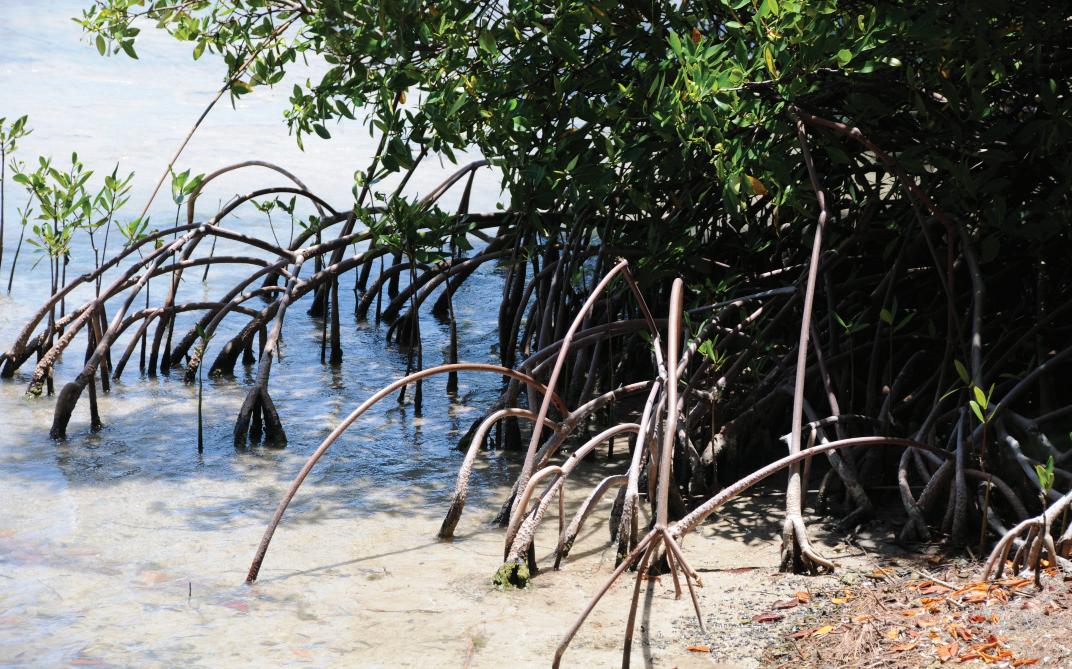
• correctly iden fy mangrove forest zona on in Puerto Rico. (procedural)
• share informa on with their peers. (a tudinal)


1. Gree ngs
2. Administra ve business – roll call, etc. (performed internally)
3. Reflec on: “There is always an open book for all eyes: nature.”
Jean Jacques Rousseau4. The teacher will begin by reviewing the concepts studied in the previous class. Using the jigsaw puzzles previously solved, the teacher will ask ques ons so that students review the concepts. If desired, the teacher can use the “The Mangroves” PowerPoint presenta on to offer an in-depth explana on of what a mangrove and a mangrove forest are, and the four types of mangrove found in Puerto Rico (this should be a review and therefore, not involve much more than 5 minutes).
1. A er reviewing the concepts and recalling the main characteris cs shown by the four types of mangrove, the teacher will instruct students to listen to a story. The students should take note of the Puerto Rico loca ons that feature mangrove forests and which the main character visits. They should also remember the places in which mangrove forests are less developed.
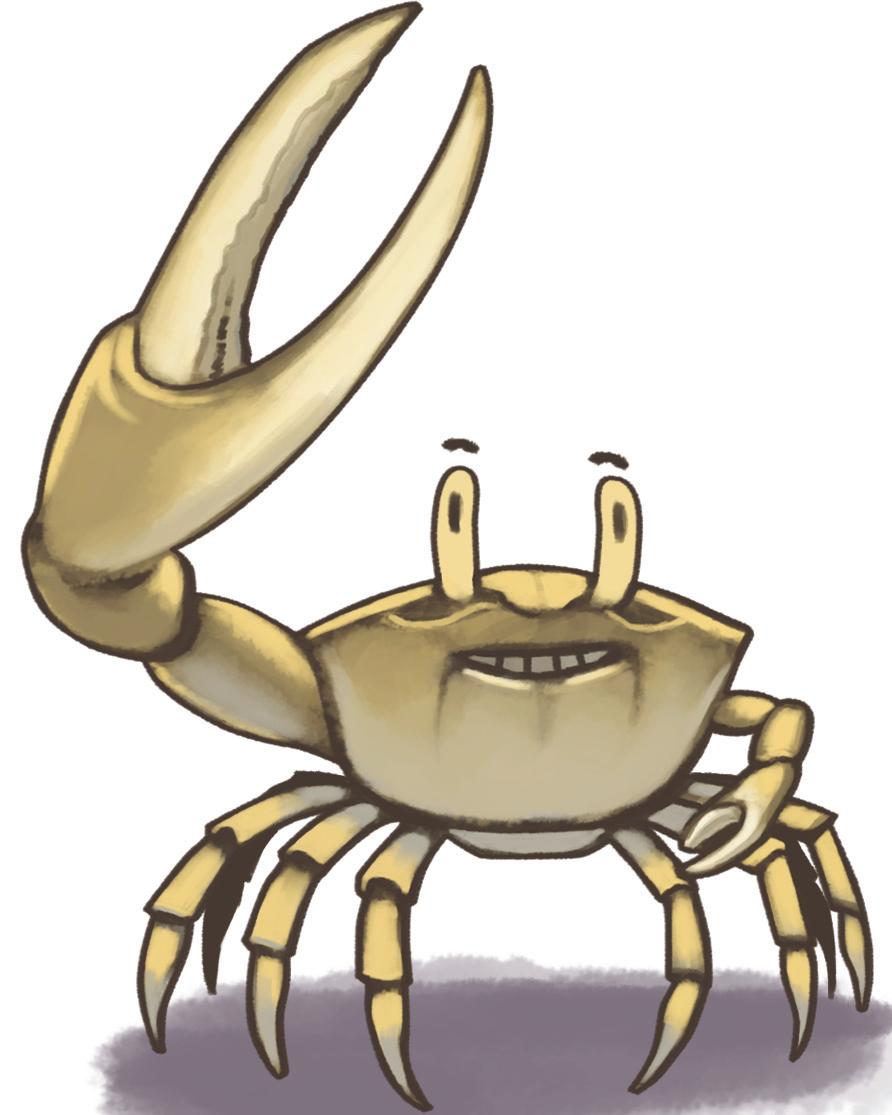
Note: The teacher should drama ze the story with the puppets/masks provided in this guide (specifically, within the El Tesoro de Pepe Uca storybook). The book includes a model so that the teacher can construct the puppets. Teachers may also use the provided models and make masks, so that students can act out the story, if so desired. If the teacher cannot make the puppets or masks, then s/he can employ ac ve storytelling techniques and drama ze the characters’ voices and expressions.
2. A er reading the story, the teacher will hand out a schema c map of Puerto Rico. Students must glue the mangrove depic ons (drawings or photographs), assigned the previous day, around

the map, focusing on the areas that support mangrove forests. If the students failed to bring the pictures, the teacher can hand out the ones included within this plan. These can be printed on adhesive labels or on paper that the student can tape to the map.
To help students remember the story and aid them when performing the ac vity, the teacher can ask the following ques ons:
Where did Pepe come from? Where was his home? In what area of Puerto Rico did his journey begin? Where did he meet Lulo?
Where was it that the dog tried to eat them?
Where were they when the iguana tried to give them direc ons? When the big wave washed them out to sea, what part of Puerto Rico was that? Were there any big mangrove forests in that area?
3. A er the students finish their maps, the teacher can use the presenta on slide showing the areas in Puerto Rico that hold mangrove forests, emphasizing the areas mangrove forests can be found and were not featured in the story.
4. Later, the students will be asked: Why does Puerto Rico have mangrove forests in some places but not in others? The teacher may remind them of the story, when Pepe and Lulo say goodbye to the wise Mulato. What did Mulato tell the main characters about the area they were in?
The students must reply that mangroves don’t thrive in the northwestern coast of Puerto Rico because the waves are too strong and don’t allow proper mangrove growth.
5. The teacher should also remind students about other factors, such as temperature, which affect mangrove forest development. These trees only grow in tropical or subtropical regions. Here, the teacher may present the slide featuring the world map which shows the places mangrove forests grow. If there isn’t a computer or projector available, the teacher may photocopy the map included in this plan and give it to the students.
1. In closing, the teacher will show students the picture illustra ng the general zona on mangrove forests follow and will ask them to use the knowledge acquired during this and the previous class, and iden fy the mangrove types seen in the picture and observe the order in which they grow. This is how the teacher can verify the students’ learning, and help students be er grasp mangrove zona on. The teacher can specify that mangroves tend to grow in a par cular order which may change according to the loca on’s physiography (physical geography).
Zona on - The distribu on of plants or animals into specific zones according to such parameters as al tude or depth, each characterized by its dominant species. (Oxford Dic onaries, 2016).
Generally, the red mangrove is first (near and in the water). Then comes the black mangrove, followed by the white mangrove, and lastly, bu onwood (González y González, 2010). Black and white mangroves can mix within the same area. The posi on of these two trees can be switched.


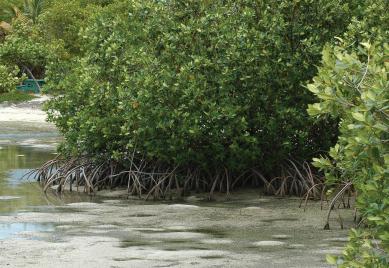
Homework:
1. Students will be given a maze to help Boba find Pepe and Lulo’s home. A er they find their way through the labyrinth, students should write a story describing the journey home through Puerto Rico’s western coast.
Praxis reflec on:
The reflec on will be performed by the teacher a er class is concluded.
Reasonable accommoda on:
Reasonable accommoda on will be offered to all students who need it. Students with physical or cogni ve difficul es will be offered reasonable me in which to do their tasks, tutoring during office hours and all the necessary opportuni es, according to their par cular cases.

Ocean literacy: Essen al principles and fundamental concepts
Principle 5: “The ocean supports a great diversity of life and ecosystems.”
f. Ocean habitats are defined by environmental factors. Due to interac ons of abio c factors such as salinity, temperature, oxygen, pH, light, nutrients, pressure, substrate and circula on, ocean life is not evenly distributed temporally or spa ally, i.e., it is “patchy”. Some regions of the ocean support more diverse and abundant life than anywhere on Earth, while much of the ocean is considered a desert.
h. Tides, waves and preda on cause ver cal zona on pa erns along the shore, influencing the distribu on and diversity of organisms.
Content standards and grade expecta ons
Biological sciences
Standard: Theme organiza on levels and structure
Expecta ons and indicators:
From molecules to organisms: Processes and structures
5.B.CB1.IE.1 Acknowledges some of the factors affec ng plant growth, such as the presence or absence of the Sun or a light source, space, the presence or absence of water, minerals, terrain, and types of soil.
Standard: Interac ons and energy
Expecta ons and indicators:
Biological evolu on: unity and diversity
3.B.CB4.IE.2 Builds an evidence-based argument to explain how, given a par cular environmental se ng, some kinds of organisms thrive, some survive with difficulty, and others perish.
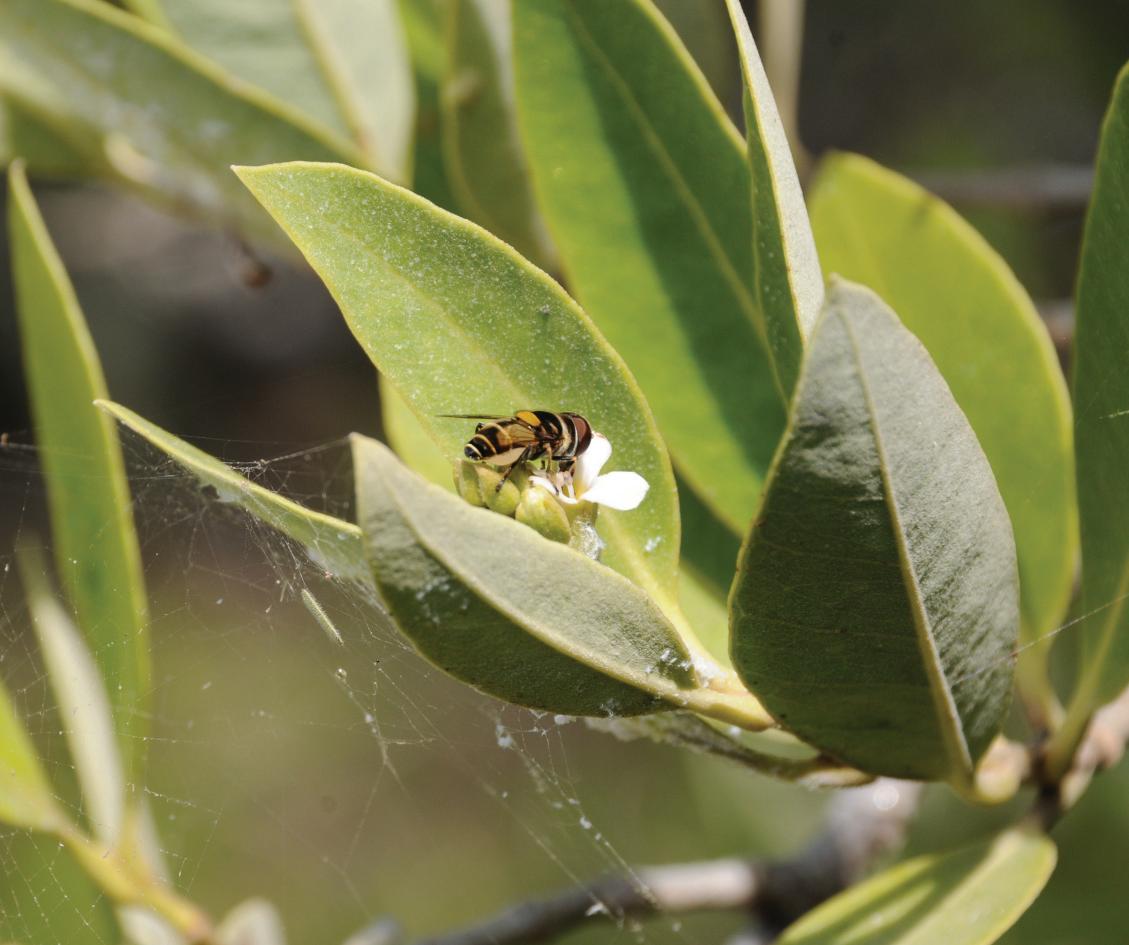
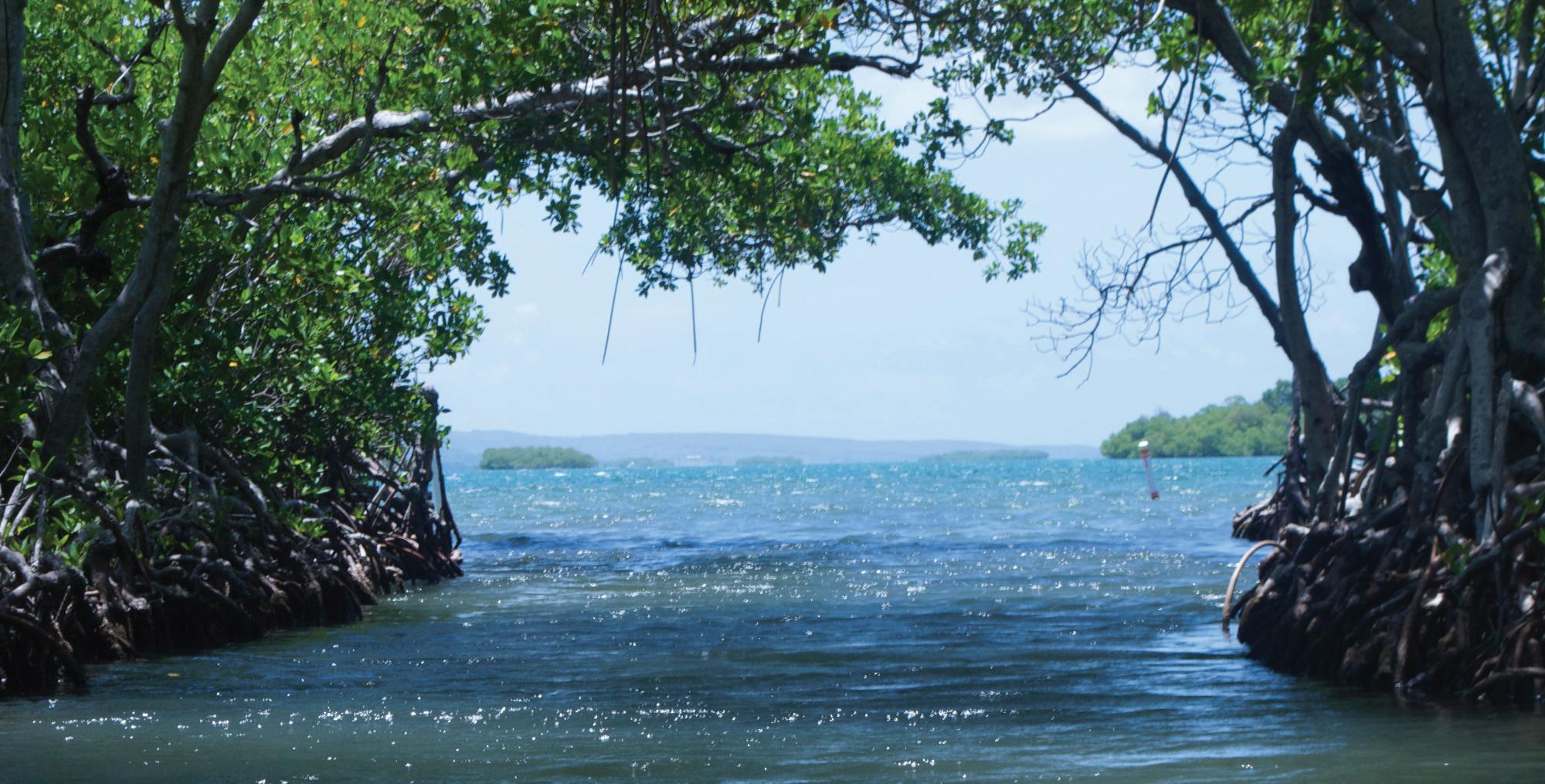
Standard: Theme organiza on levels and structure
Expecta ons and indicators:
Earth systems
4.T.CT2.EM.4 Interprets and analyzes map data to describe pa erns in the Earth’s characteris cs.
References:
Biology Online. Zona on. Consulted on September 24, 2016, through h p://www.biology-online.org/ dic onary/Zona on
Oxford Dic onaries. Zona on. Consulted on September 24, 2016, through h ps://en.oxforddic onaries. com/defini on/zona on

It was a bright, sunny day. There was a slight breeze, and the waves moved back and forth gently. Life in the mangrove forest was enviously peaceful. Everybody went about their usual daily rou nes: the pelicans and the frigate birds scouted for sardines and herrings; the yellow warblers, bu erflies and bees darted among the flowers; ny fish searched for food and hid among the red mangrove’s roots to hide from bigger fish like tarpons and barracudas. The younglings played and Pepe Uca, a young fiddler crab, walked around the wetland, thinking about his life up un l that moment. He’d lived his en re life there with his family, among the mangroves, with the birds and the fish. He had plenty of food, a beau ful home, and friends who offered support and affec on.
It was a perfect life. And yet, ever since he was li le, he had always wondered about life beyond the mangrove forest. He always asked himself about other places, of what life would be like elsewhere. He felt an inexplicable anxiety and he felt as if something was missing. He needed to feel excitement, have adventures, and live through different experiences that would allow him to discover the world. That day, while observing the sea, he made his decision. —“I’m leaving!” —he firmly said to himself: —“I’ll explore other places and find my des ny.”
He spent the rest of the day planning his journey, imagining all the things he would see. At dusk, when everyone else was off res ng, Pepe gathered enough food for several days and marched off. He le his mangrove forest, le the familiar salt flats of La Parguera, and began his travels across the southern coast of Puerto Rico. He felt nostalgia as he le everything behind, but he was excited because he would discover new places. The days went by and Pepe marveled at all the things he saw: tall palm trees, huge mountains, the blue sky, an everchanging sea, and plants and animals he’d never seen before. In the distance, he could see something that resembled a mangrove forest. However, he would have to cross something to reach it - a flat area with a hard, rough and hot surface. Several huge, noisy objects went along this surface, moving at great speeds. They scared him, but they could not dampen his adventurous spirit. So he decided to cross as quickly as he could. He was so scared when those great objects went past him! Nervous and shaking all over, he managed to get to the other side. He

stopped for a moment to catch his breath and gather his strength. But while he was res ng, he heard footsteps, and a shy voice that said: —“How could you cross that dangerous street, all full of cars? Did you look both ways before you did that?”
Wondering who spoke, Pepe looked around. He was surprised to see a fiddler crab, just like him, who had a scared look on his face. — “Who are you?”— asked Pepe. —“My name’s Lulo, and I want to welcome you to my community, the Guayama mangrove forest! I saw you crossing the street! Are you crazy? I tried to cross a while ago, and I almost got run over. I am so scared, I never even leave this place anymore.”
Pepe gave him an astonished look and said: — “Why wouldn’t you ever try to leave? What a coward! You just need to be careful. You know what? You should come with me. It’s always good to share experiences with a friend.”— Lulo thought for a while, and decided that it’s not every day that one meets a bold and fun character like Pepe, and he decided to accompany Pepe on his trip.
Thus, Pepe and Lulo became traveling companions. They crossed several mangrove forests and, when moving across Las Cabezas de San Juan, in Fajardo, Lulo saw a dog approaching them quickly and yelled: — “Mommy! Mommy! Mommy! Mommy!”
—“What’s wrong? Where’s your Mommy?”— Pepe shouted. — “No, it’s that dog! It’s coming straight for us! It wants to eat us!” — Lulo replied.
—“Quick! Let’s hide between the mangrove roots! Come on!”— Pepe exclaimed.
Once the danger was past, they resumed their journey, crossing the towns of Luquillo, Río Grande, Canóvanas and Carolina. They a empted to cross the tarmac in the Luis Muñoz Marín Interna onal Airport and, just when they were right in the middle of it, they felt a loud roar that stunned them. It was a depar ng plane, and it made so much noise and wind that it pushed the fiddler crabs over to the Isla Verde beach. There was a fes val going on, and there were so many people dancing to the music that Pepe and Lulo nearly got stepped on. They hid under a trashcan, and had to wait un l nigh all to resume their journey.
Then, they reached the San Juan Bay Estuary. They were astonished at how big the estuary was.
—“WOOOW! Look at all those buildings, boats, cars and noise in this place! I’ve never seen anything like it!”— Pepe exclaimed. —“And did you see how many tourists are visi ng?”— Lulo asked. “I heard someone say that there used to be a lot more trees, right where those hotels are now,” he added, in a though ul tone of voice.
They were red, and felt lost. Suddenly, they heard someone offering direc ons in a voice nged with a foreign accent. It was a travelling iguana, with cool sunglasses and everything. The iguana had been observing the fiddler crabs and thought: —“Even though I usually eat plants, today, I’m in the mood for crab! I’ll lure them out of the mangrove, so they have nowhere to hide. Buahahahahaha!”
—“Hey, come here! Are you guys lost? I, the Travelling Iguana, am here to help. I know you need to get to a mangrove forest so you can rest, so I’m going to tell you how to get there. You have to keep going
west, towards the sunset. That’s how you get to where you’re going.”— The crabs took the iguana’s advice and con nued their travels. The iguana kept an eye on them, following them.
They were already near the northwest corner of the island, having traversed nearly all of Puerto Rico. They were red and hungry, and needed a safe place to rest. They looked and looked, but could not find an adequate place with food and shelter. They couldn’t find any mangrove forests. Lulo began to cry, feeling sad and desperate.
—“Se le down! Help me figure out what to do!” — Pepe exclaimed.
Lulo felt someone watching them, and his li le legs trembled. Suddenly, something jumped on them, making them run in panic. It was the iguana, who decided it was dinner me. While running away, the fiddler crabs reached the beach, but could not find anywhere to hide.

A huge wave crashed over them and dragged them out to sea! Lulo screamed, —“Help! Help me! Mommyyyyyy!”— Meanwhile Pepe, exhausted, tried to fight the current but it was so much stronger than him. Then, he remembered his family and his home. There, he had shelter, food, and the waters were peaceful. Now, he was in an unfamiliar place, there wasn’t any of the mangrove’s comfor ng shade, and to top it all off, the sea current was taking him out to deep waters, along with a friend who would not stop shou ng.
Just as they were losing hope, they felt something pull them out of the water. It was Mulato, a ghost crab who had seen the fiddler crabs out on the beach. — “What are you two doing so far from home?”— he asked. —“I have seen other crabs like you, and they weren’t so lucky.”
The adventurers replied, —“We le our mangrove forests hoping to find new and be er places to live. However, all we found was the opposite of that!”
Then, Mulato, who was a very wise old crab, told them: —“You have to get back home. There, you have everything you need to have a healthy life. This place doesn’t have the appropriate condi ons for crabs like you. The waves here are too strong and won’t let mangrove forests develop. However, not all of it was bad. You managed to find one of life’s most precious gi s: … friendship.”
A brown booby swooped past. This is a common bird along Puerto Rico’s coasts. Mulato called the booby over. The Booby got near, and Lulo got scared, but she asked him to calm down and not be afraid. Mulato asked the Booby if she would help his new friends and take them back to their mangrove homes. The fiddler crabs climbed onto the Booby and said goodbye to Mulato. They were happy, since they were alive and well, and headed towards their most precious treasure … their home.
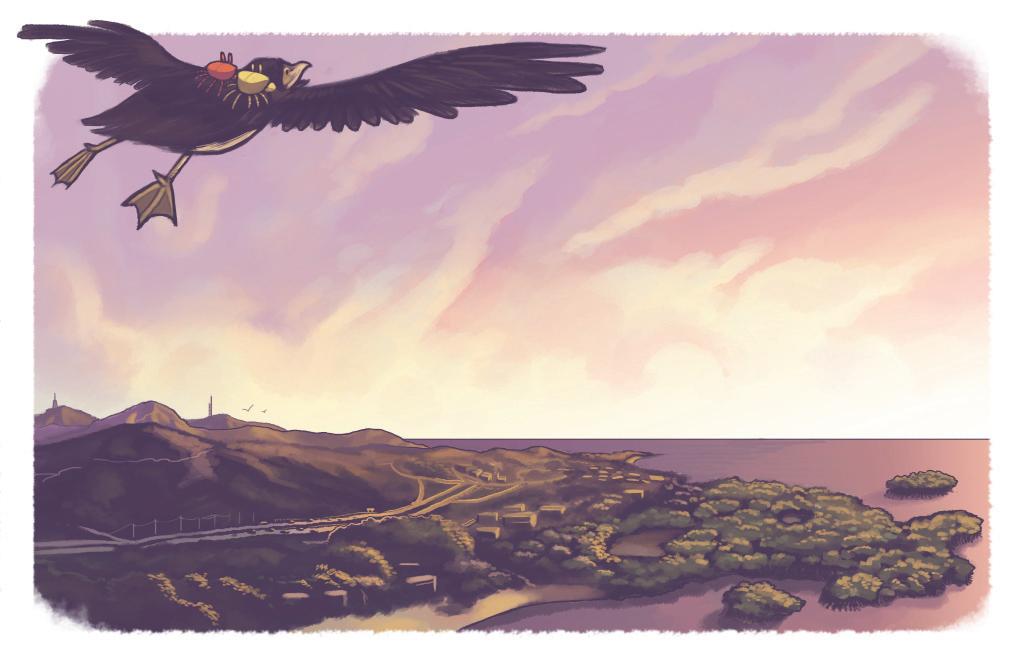
University of Puerto Rico
Mayagüez Campus
Sea Grant Program
Mangroves
Geographic Distribution Map

Puerto Rico Mangroves
Date: ____________________________
Grade-Group: ______________________
Name: ___________________________________
Professor: _________________________________
Instructions: After reading the short story El tesoro de Pepe Uca (Pepe Uca’s treasure), carefully search the map of Puerto Rico and find the towns Pepe visited. These towns are just some of the ones which featur e mangrove forests, and they represent the areas in which mangr ove can grow. At each location, place a red mangrove picture and write the town’s name in the spaces provided. Then, observe the Puerto Rico zon es in which mangrove forests are less developed.
Puerto Rico and its
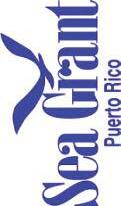

































Date: ____________________________
Grade-Group: ______________________
Name: ___________________________________
Professor: _________________________________
Instructions: Carefully observe the mangrove zoning diagram presented below, and identify the type of mangrove in the space provided. Write the order in which the mangroves are found.



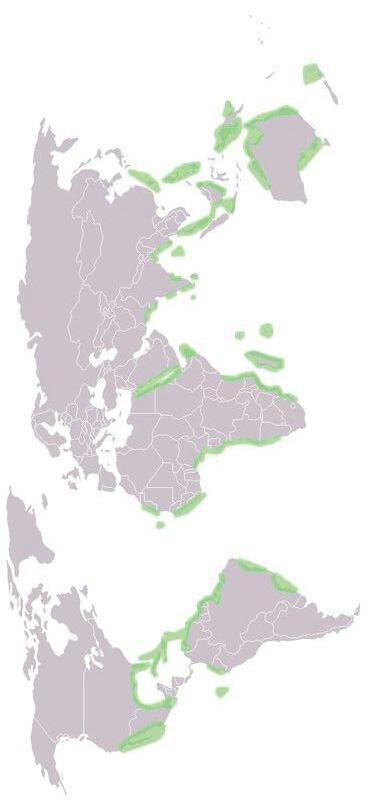

Name: ____________________________

Date: ____________________________




Professor: _________________________ Grade-Group: ______________________
Instructions: Carefully observe the following labyrinth and help Boba find Pepe and Lulo’s home. Draw a line through the . Then, write a short story describing their voyage as they return home by crossing western Puerto Rico.


Use the space provided to write a short story describing Boba, Pepe and Lulo’s journey back home across western of Puerto Rico. ______________________________________________ ______________________________________________ ______________________________________________ ______________________________________________ ______________________________________________ ______________________________________________

Time: 1 period
Teaching strategy: ECA
Phases: explora on, conceptualiza on and applica on
Teaching method: demonstra ve, inquisi ve, ac on or ac vity
Teaching technique: lecture, review, puppet demonstra on
Assessment technique: open ques ons, concrete poem
Integra on with other subject ma ers: Biology, Ecology
Materials:
• Mangroves: Teacher’s Manual
• Mangroves PowerPoint presenta on



• “The mangrove forest” poster, Sea Grant Program
• Video: Conversando con mi amigo…EL
MANGLAR (Speaking with my friend…THE MANGROVE FOREST)

• Tradi onal bomba song: “Soy el manglar”
• Song: “El manglar”
Depth knowledge level:
Level I: Memory thinking
Level II: Process thinking
Level III: Strategic thinking
* Content standards and grade expecta ons from the Puerto Rico Department of Educa on Science Program can be found at the end of each lesson plan.
* Fact sheets, assessment tools and other educa onal material to be used during each class are included at the end of each lesson plan and in the Guide’s CD.
Objec ves:
A er teaching the importance of mangrove forests topic, students will be able to:
• iden fy the factors that make mangrove forests important. (procedural)
• correctly explain these factors and the benefits obtained from this ecosystem. (procedural)
• value mangrove forests’ importance for other marine ecosystems and organisms which surround it. (a udinal)
• share informa on with their peers. (a udinal)
1. Gree ngs
2. Administra ve business – roll call, etc. (performed internally)

3. Reflec on: “Nature does nothing in vain.” Aristotle
4. The teacher will place the chairs in a circle before engaging in the class ac vity.
5. To begin class, place the “The mangrove forest” poster on the board and students to brainstorm to explore what they know about the importance of mangrove forests. The teacher will write a list of their responses.
1. The teacher will show the students the video tled Conversando con mi amigo…EL MANGLAR (Speaking with my friend…THE MANGROVE FOREST), and ask students to observe the video carefully: h p://www.youtube.com/watch?v=uoqkdrUxFjM
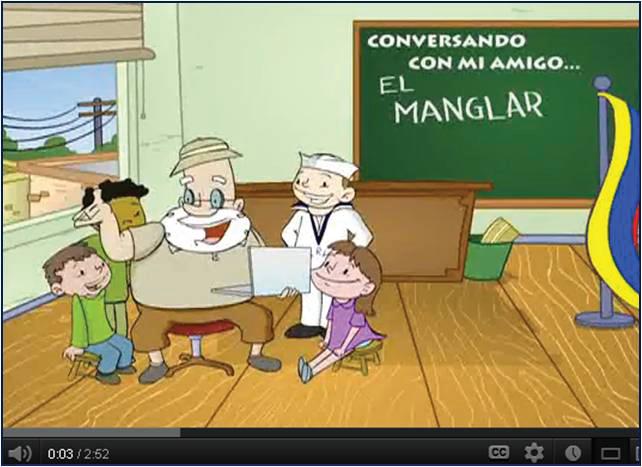
2. When the video finishes, the teacher will analyze, along with the students, the mangrove forests’ importance, according to what they have learned through the video and the “Mangroves” PowerPoint presenta on (provided by the Sea Grant Program).
Note: The teacher must reference the mangrove forests background, in the sec on tled Importance of mangrove forests
The significant features are:

1. Protects the coast from erosion.
2. Works as a barrier holding back strong winds and waves.
3. Serves as a filter, and are crucial for keeping the waters clean and clear.
4. Helps retain and stabilize sediments coming from the mainland.
5. Provides a home for many marine species.
6. Shelters resident and migratory bird species.
7. Provides food for several marine species.
8. Serves as a hatchery for several species during their juvenile stages.
Note: The video shows the destruc on of mangrove forests in order to construct shrimp farms. This doesn’t occur in Puerto Rico. However, since it was shown in previous classes that mangrove forests grow in tropical and subtropical regions, the teacher can specify that this shrimp industry happens in countries like Ecuador. In Puerto Rico, it’s more common for mangrove forests to be cleared for building tourism facili es, hotels, residen al buildings, airports and factories.
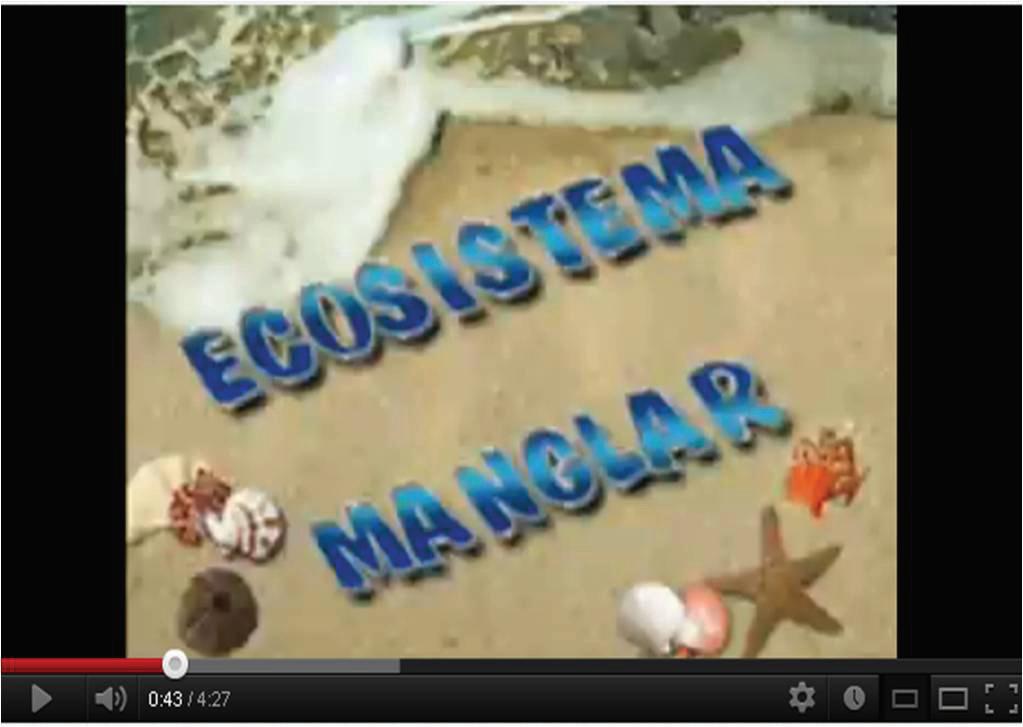
1. To close the class and review what has been learned, the teacher can play the Sea Grant Program’s “Soy el manglar” song and will ask the students to sing and dance along with the song, using the space created when arranging the chairs at the beginning. This song reviews, in a simple manner, the importance and benefits afforded by the mangrove forest.
Another op on: The teacher may also use the “El manglar” song, available through: h p://www.youtube.com/watch?v=lUGWXS4fwmo.
Homework:
1. Students will be in charge of wri ng a concrete poem with the word Mangrove. This poem should reflect the mangroves’ significance and importance.
2. Students should also look for informa on about the threats faced by this ecosystem, and the ways it could be preserved.
Praxis reflec on:
The reflec on will be performed by the teacher a er class is concluded.
Reasonable accommoda on:
Reasonable accommoda on will be offered to all students who need it. Students with physical or cogni ve difficul es will be offered reasonable me in which to do their tasks, tutoring during office hours and all the necessary opportuni es, according to their par cular cases.
Ocean literacy: Essen al principles and fundamental concepts
Principle 5: “The ocean supports a great diversity of life and ecosystems.”
e. The ocean is three-dimensional, offering vast living space and diverse habitats from the surface through the water column to the seafloor. Most of the living space on Earth is in the ocean.
i. Estuaries provide important and produc ve nursery areas for many marine and aqua c species.

Principle 6: “The ocean and humans are inextricably interconnected.”
a. The ocean affects every human life. It supplies freshwater (most rain comes from the ocean) and nearly all Earth’s oxygen. It moderates the Earth’s climate, influences our weather, and affects human health.
b. From the ocean we get foods, medicines, and mineral and energy resources. In addi on, it provides jobs, supports our na on’s economy, serves as a highway for transporta on of goods and people, and plays a role in na onal security.
c. The ocean is a source of inspira on, recrea on, rejuvena on and discovery. It is also an important element in the heritage of many cultures.
d. Much of the world’s popula on lives in coastal areas.

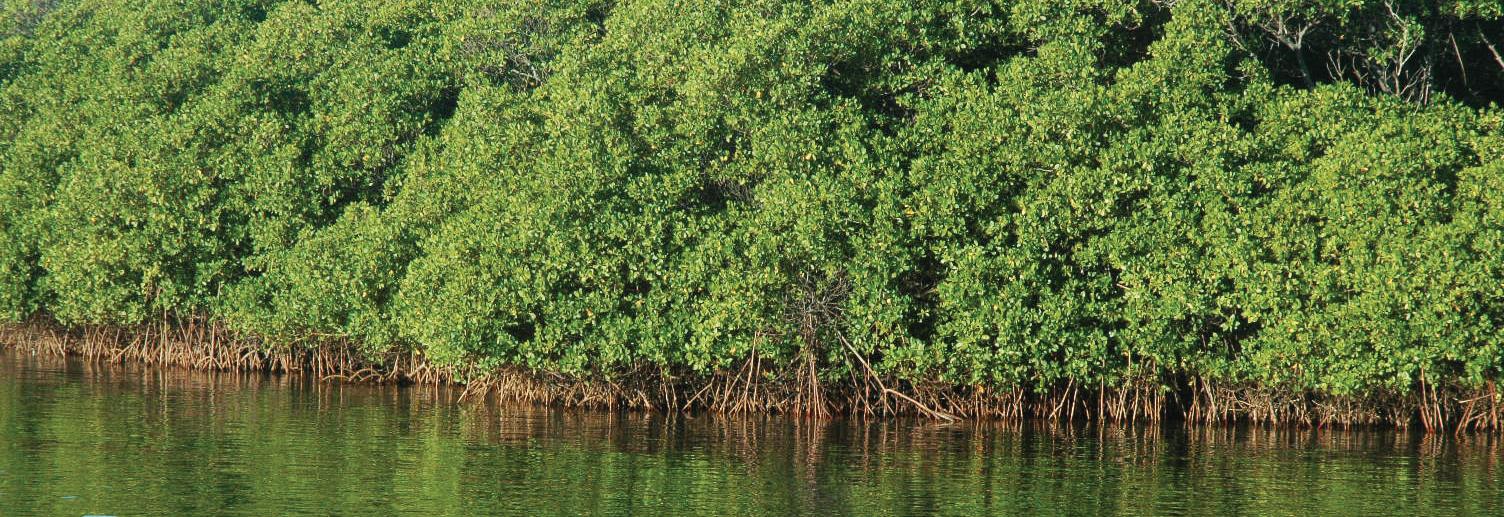
Content standards and grade expecta ons
Biological sciences
Standard: Interac ons and energy
Expecta ons and indicators:
Ecosystems: Interac ons, energy and dynamics
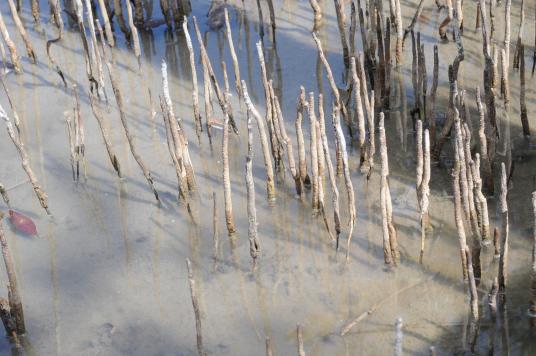
3.B.CB2.IE.1 Acknowledges that living beings need other living beings and their environment to survive.

Ritmo Gracimá (Mayagüez) o Cuembé (Loíza)
Escrito por: El Manglar
Colaboración: Jorge I. Casillas Maldonado
Coro
//Un saludo soy el manglar, Yo te invito a conocerme
Un saludo soy el manglar, Da de pa’ protegerme//
A muchos vida yo le doy
Soy hogar y alimento
Es importante ser manglar, Y orgulloso yo me siento
Coro (una vez)
Cuando viene el huracán
Te protejo de los vientos
Yo evitó la erosión
Protejó los corales nuestros
Coro (una vez)
Limpio el aire que respiras
Soy un mangle doy descanso
En mí los pájaros anidan
Cuando ellos vienen migrando
Coro (una vez)
Hablo por el mana
Los os ones, los cangrejos
La jarea el chucho el pargo
La esponja y el canario
Coro (una vez)
Viven entre mi raíz
Muchos peje chiqui tos
Soy hogar de un organismo
Que en las noches da brillito
Coro (dos veces) FINAL
Gracimá (Mayagüez) or Cuembé (Loíza) rhythm
Wri en by: El Manglar
Collabora on: Jorge I. Casillas Maldonado
Chorus
//Gree ngs to you, I’m the mangrove I would like for you to meet me Gree ngs to you, I’m the mangrove Do your part to help protect me//
I give life to so many I am food and I am shelter It’s important to be a mangrove, I feel very proud

Chorus (once)
When the hurricanes arrive I protect you from the winds I prevent erosion I protect our coral reefs
Chorus (once)
I clean the air you breathe I am a forest, I offer res ng place Birds build nests in me When they migrate here
Chorus (once)
I speak for the manatee the oysters and the crabs the mullet, the rays and the snappers the sponges and the canaries
Chorus (once) Among my roots live many ny fishes I am the home to an organism which lights up at night
Chorus (twice)
Sea Grant Program
Mangroves
Example of a concret poem (also called a shape poem)


Time: 1 period
Teaching strategy: ECA
Phases: explora on, conceptualiza on and applica on
Teaching method: demonstra ve, inquisi ve, ac on or ac vity
Teaching technique: lecture, discussion
Assessment technique: open ques ons, syntu or cinquain poem, le er composi on Integra on with other subject ma ers: Biology, Ecology, Spanish, Art, Social Studies
Materials:
• Mangroves: Teacher’s Manual
• Mangroves PowerPoint presenta on


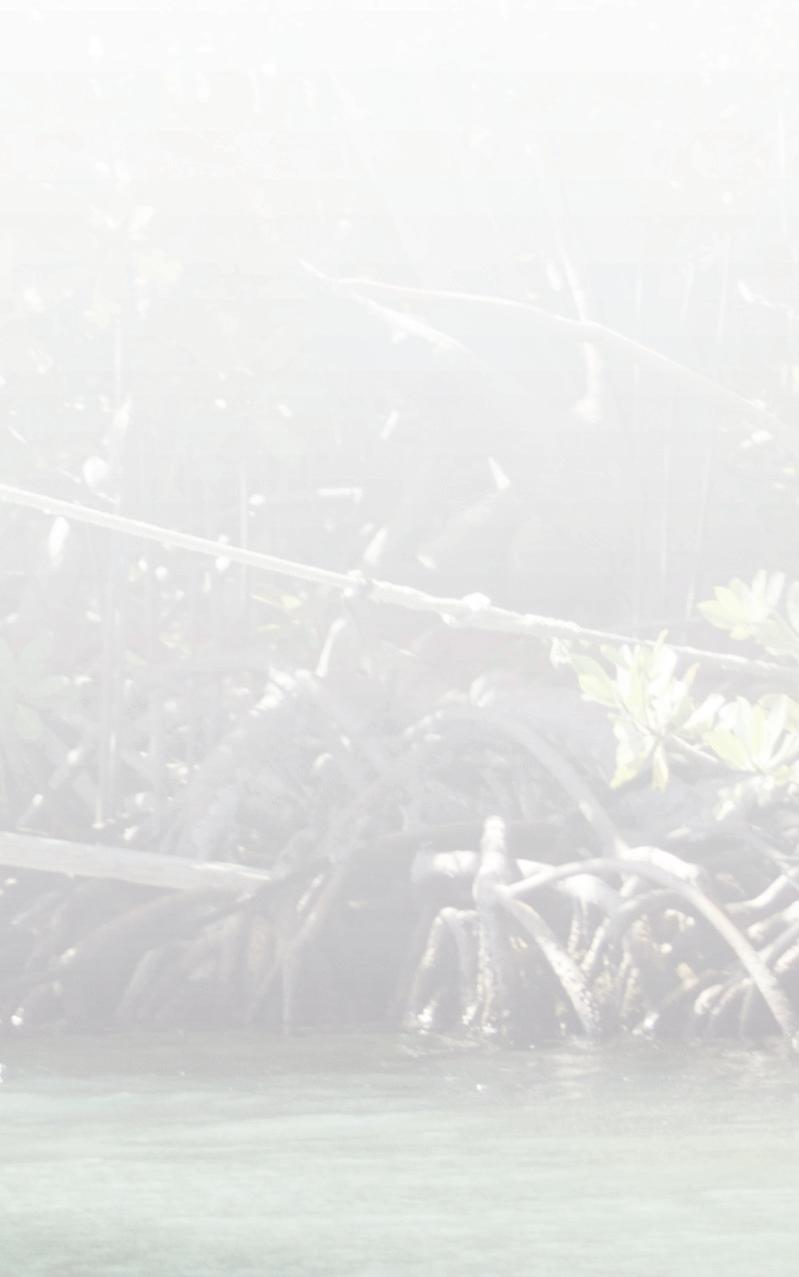

• Poster demonstra ng the disturbances and damages suffered by mangrove forests (image of healthy ecosystem and the factors that cause a nega ve impact upon it)
• Instruc on sheet for le er composi on ac vity
• Cinquain or syntu poem sheet
Depth knowledge level:
Level I: Memory thinking
Level II: Process thinking
Level III: Strategic thinking
Level IV: Extended thinking
Objec ves:

A er studying about the disturbances suffered by the mangrove forests and ecosystem conserva on methods, students will be able to:
• iden fy the likely factors impac ng and altering the mangrove forest ecosystem. (procedural)


• effec vely analyze these disturbances in order to understand their effect on this resource. (procedural)
• acknowledge that humankind is the main element damaging the mangrove forests, but that it also has the poten al to rescue them. (conceptual)
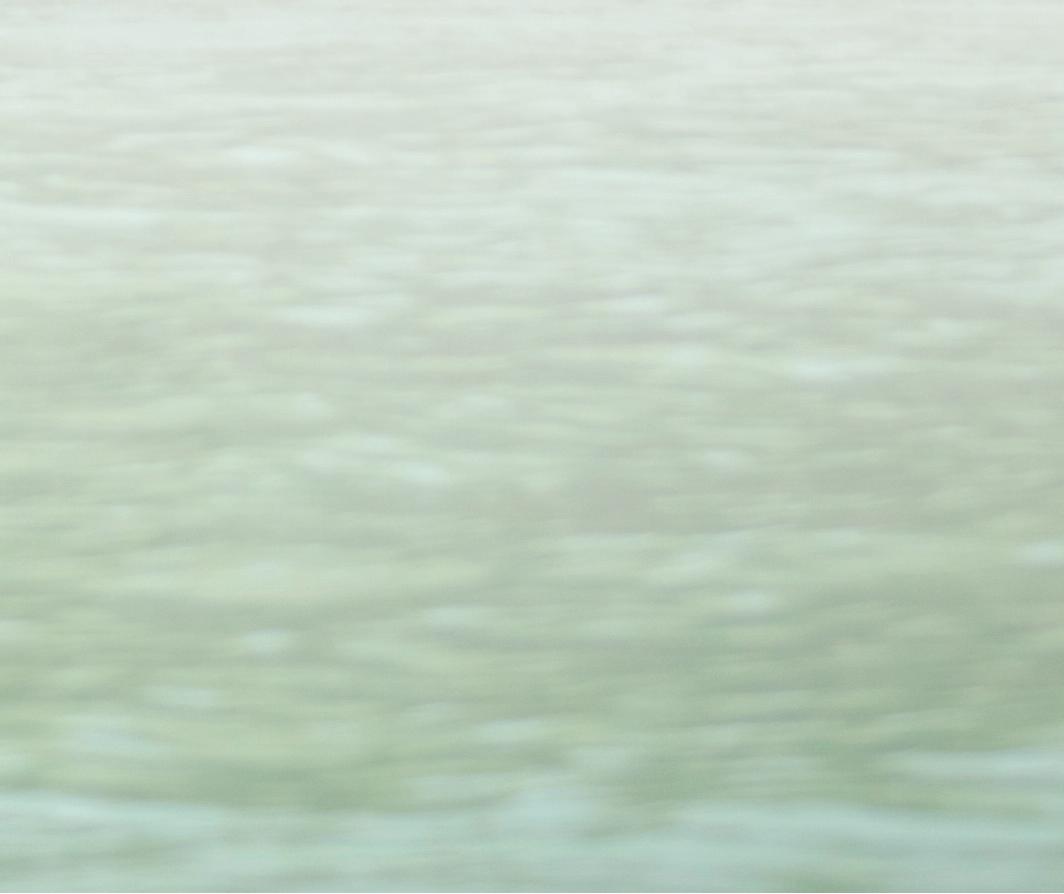
• propose effec ve solu ons for conserving and protec ng this ecosystem. (procedural)
• write a le er that shows and analyzes the nega ve impacts taking place in mangrove forests, and solu ons to those impacts. (procedural)
• respect the mangrove forest ecosystem. (a tudinal)
• become responsible for this ecosystem’s care and protec on. (a tudinal)
1. Gree ngs
2. Administra ve business – roll call, etc. (performed internally)

3. Reflec on: “We have modified our environment so radically that we must now modify ourselves in order to exist in this new environment.” Norbert Wiener (1894-1964) North American mathema cian

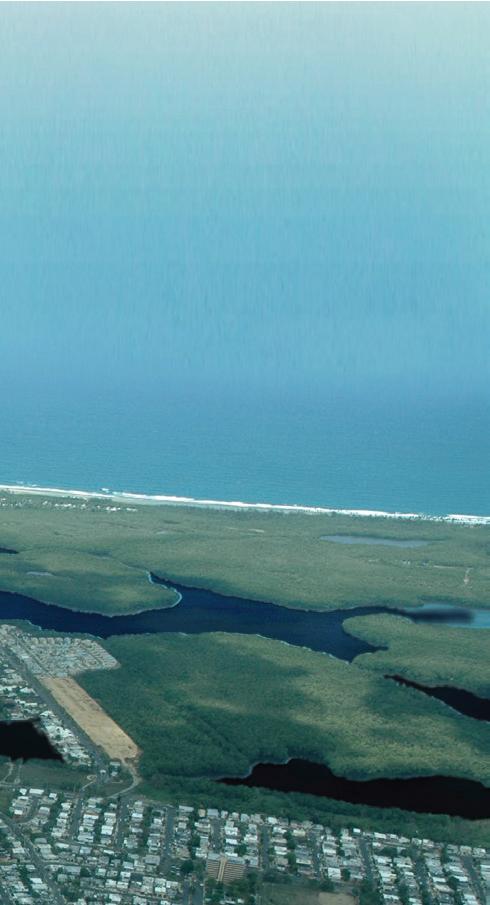
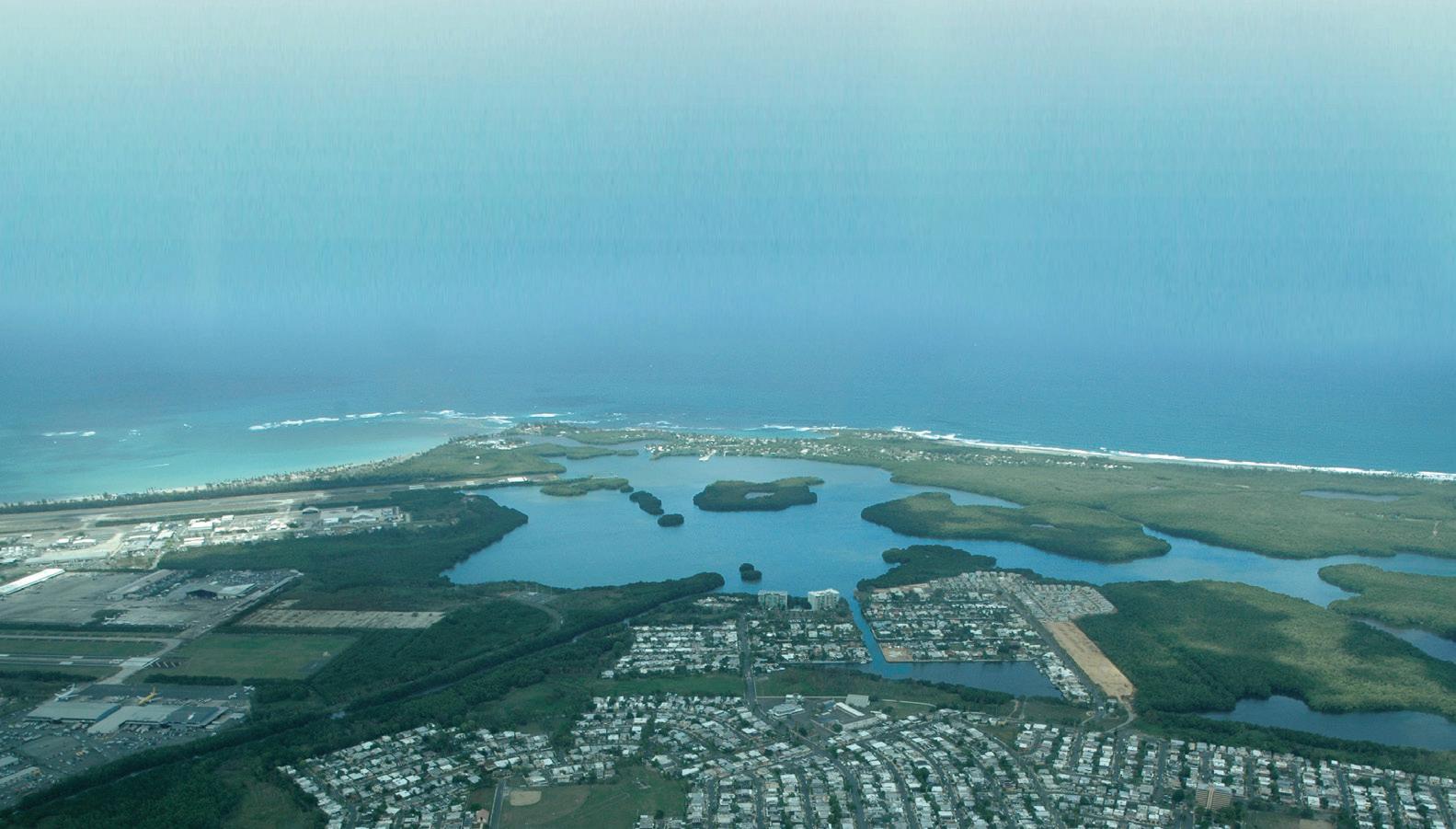
4. The teacher will use the PowerPoint presenta on “The Mangrove Forest” as means to review the mangrove forest’s importance. The teacher may also use some of the concrete poems built by the students in the previous class.



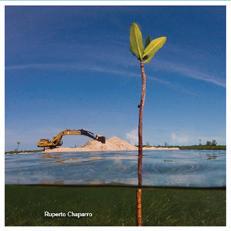
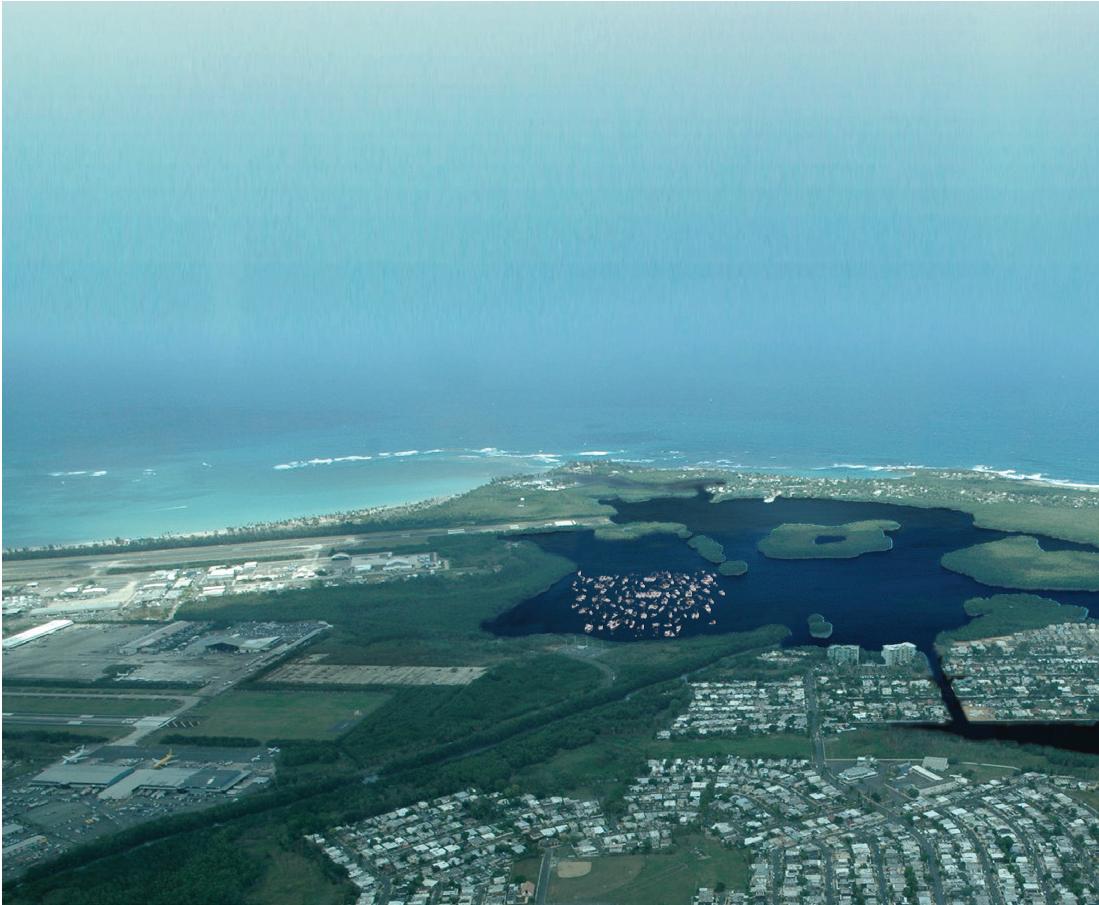
1. The teacher will project the poster showing various disturbances to mangrove forests. This interac ve poster is made in Acrobat. It features an image of a mangrove forests being used in inappropriate ways. Over the image, the teacher will find highlighted prac ces that alter the ecosystem.
2. The students must carefully observe the poster and iden fy everything that, in their es ma on, can nega vely affect the mangrove forest. Every me students iden fy something, they must explain their reasoning as to how this would affect the ecosystem. Then, the students must men on what they would do in order to eliminate this disturbance.
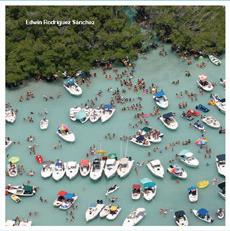
Students will then use the computer to select the image of that disturbance to learn how the healthy, undisturbed ecosystem would look. This sequence must take place un l all the disturbances are gone and the picture shows a healthy ecosystem.
3. It is worth men oning that whenever a disturbance is removed, the teacher should take the opportunity to discuss the disturbance and the ways in which the ecosystem can recover. Students must be allowed to analyze the problem carefully and propose solu ons.
1. In closing, students must write a le er to a government agency, ins tu on, or to their families, presen ng the mangrove forest’s importance, the factors altering this ecosystem, and the proposed solu ons for restoring and preserving it. Students must also include a collabora on pe on so that these solu ons can become a reality.
2. The le ers can be read in the classroom, and students can build a list of the most important requests. Then, the students can write a group le er and send it to the governor, the House of Representa ves, the Senate president, the Mayor, and the elected officials of their district or area.
Note: This exercise can be undertaken during another class period, and the teacher may take the opportunity to teach proper le er dra ing. Also, the Social Studies teacher may be asked to teach about the different branches of Puerto Rican poli cs, integra ng it into the class.
3. Ques ons regarding the topic will be discussed and answered.
Homework:
1. Students will be asked to write a cinquain or syntu poem, following the recommenda ons offered below (Aguirre, 2001):
Cinquain:
1. Name (selected term or concept)
2. Two (2) words that describe the ini al word (adjec ves)
3. Three (3) words that show ac on related to the ini al word (verbs)
4. Four (4) words that show the author’s feelings or knowledge in regards to the ini al word
5. Name, term or concept related or similar to the one used at the beginning
Example: Corals

Colorful, beau ful
Protect, feed, offers shelter Serve as protec ve barrier

Corals
Syntu:
1. Selected term or concept (object, place, event or feeling).
2. Descrip on of term or concept (through any of the senses).
3. Expression of a feeling or ac on in regards to the selected term or concept.
4. Descrip on of an observa on using a different sense from those used in Step 2.
5. Term or concept related or similar to the ini al term or concept
Example (taken from Aguirre, 2001): Sand Shines upon the coast Brings me solitude and freedom Warm, caressing my feet Beach
Praxis reflec on:
The reflec on will be performed by the teacher a er class is concluded.
Reasonable accommoda on:
Reasonable accommoda on will be offered to all students who need it. Students with physical or cogni ve difficul es will be offered reasonable me in which to do their tasks, tutoring during office hours and all the necessary opportuni es, according to their par cular cases.
Ocean literacy: Essen al principles and fundamental concepts
Principle 1: “The Earth has one big ocean with many features.”
g. The ocean is connected to major lakes, watersheds and waterways because all major watersheds on Earth drain to the ocean. Rivers and streams transport nutrients, salts, sediments and pollutants from watersheds to estuaries and to the ocean.
Principle 6: “The ocean and humans are inextricably interconnected.”
e. Humans affect the ocean in a variety of ways. Laws, regula ons and resource management affect what is taken out and put into the ocean. Human development and ac vity leads to pollu on (point source, non-point source, and noise pollu on) and physical modifica ons (changes to beaches, shores and rivers). In addi on, humans have removed most of the large vertebrates from the ocean.
f. Coastal regions are suscep ble to natural hazards (tsunamis, hurricanes, cyclones, sea level change, and storm surges).
g. Everyone is responsible for caring for the ocean. The ocean sustains life on Earth and humans must live in ways that sustain the ocean. Individual and collec ve ac ons are needed to effec vely manage ocean resources for all.
Content standards and grade expecta ons
Biological sciences
Standard: Conserva on and change
Expecta ons and indicators:
Biological evolu on: unity and diversity
3.B.CB4.CC.2 Establishes an approach to solve a problem caused by environmental changes that impacts the plants and animals living there.

Expecta ons and indicators:
Ecosystems: Interac ons, energy and dynamics
5.B.CB2.CC.1 Iden fies ways to preserve the survival of organisms in their environment.
5.B.CB2.CC.2 Develops solu ons that humans can use to help manage and protect the bio c and abio c factors in the ecosystems.
Earth and space sciences
Standard: Interac ons and energy
Expecta ons and indicators:
Earth and human ac vi es
4.T.CT3.IE.4 Describes and iden fies environmental problems caused by humankind’s interac ons with bodies of water, soil, and the terrain (plateaus, mountains, hummocks, hills, valleys, canyons, gullies, basins, ridges, plains).
Standard: Conserva on and change
Expecta ons and indicators:
Earth and human ac vi es
K.T.CT3.CC.1 Analyzes ways in which humankind can reduce the waste and pollu on affec ng their environment.
1.T.CT3.CC.1 Iden fies and explains conserva on prac ces (reduce, reuse, recycle) and the effects pollu on has on different resources (water, soil, and air).
1.T.CT3.CC.2 Evaluates how human ac vi es have increased environmental pollu on, and develop a community-wide plan of ac on towards the situa on.
2.T.CT3.CC.1 Acknowledges all the ways in which humans pollute their community.
2.T.CT3.CC.2 Develops plans that contribute to the preserva on at a local community level, focusing on alterna ve methods when using natural resources.
3.T.CT3.CC.1 Acknowledges the consequences of the damages caused by humankind to other living beings and the environment.
3.T.CT3.CC.2 Compares and contrasts the changes or damages suffered by the planet as a result of natural phenomena and human ac vi es.
3.T.CT3.CC.3 Develops a plan aimed at reducing the human-caused effects and damages affec ng the Earth’s systems.
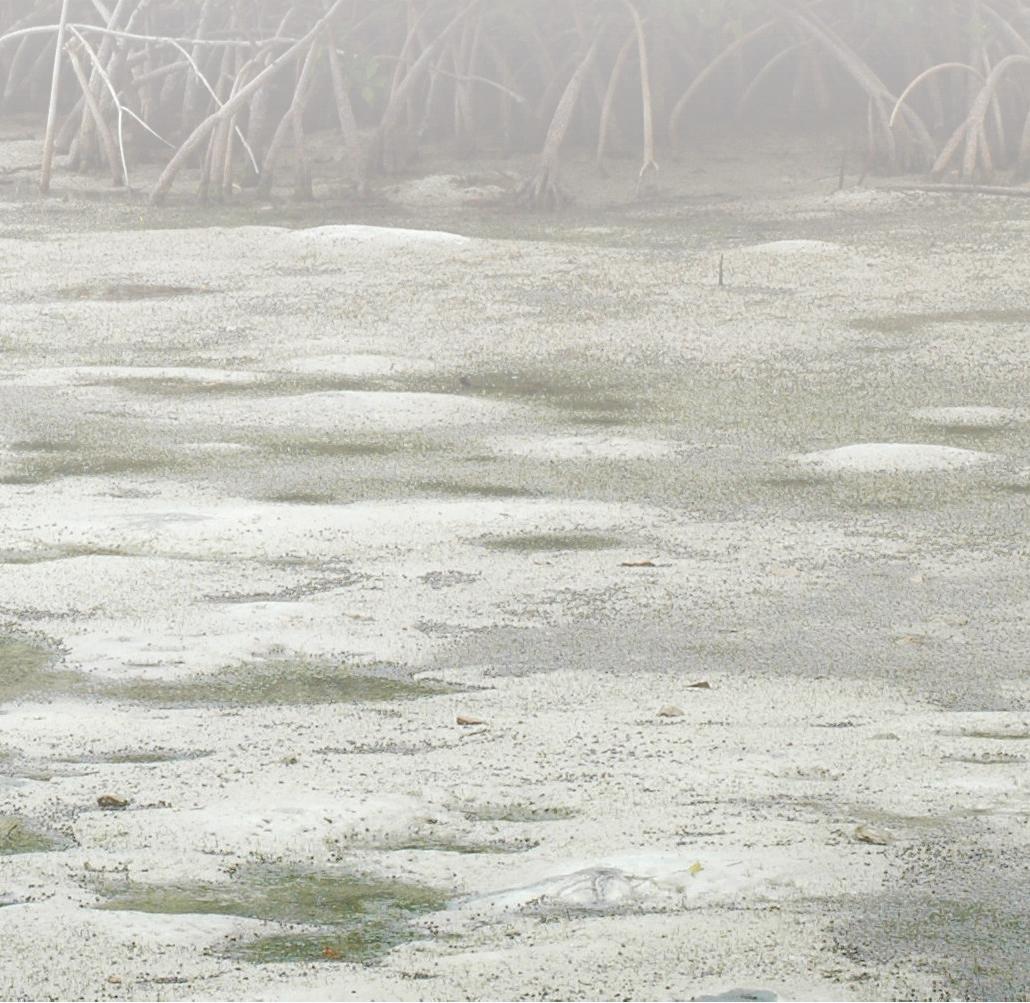


3.T.CT3.CC.4 Develops a logical argument related to the use and conserva on of the natural resources.
4.T.CT3.CC.2 Develops alterna ve solu ons to human-caused impact on the environment, focusing on Puerto Rico’s ecosystems and environments.



References:
Aguirre, M. (2001). Assessment en la sala de clases. San Juan, Puerto Rico: Publicaciones Yuquiyú.
Orengo, J. (2005). Guía prác ca para la elaboración de ejercicios de medición, “assessment” y evaluación. Hato Rey, Puerto Rico: Publicaciones Puertorriqueñas, Inc.

Instructions: Use the space provided to write a letter expressing the need to protect the mangrove forests. This letter must include the following:
1. Summary of the importance of mangrove forests
2. Description of the problem or situation
3. Proposals to improve the ecosystem or solve the problem
4. Request for collaboration in solving the problem


Name: _____________________________ Date: ____________________________
Professor: ___________________________ Grade-Group: ______________________
Instructions: Use the space provided to write a cinquain-style poem about mangroves. Use the following structure: _______________________________________
Name or term selected ________________________ _________________________
Two (2) words that describe the initial name or concept
________________________ _________________________ ________________________
Three (3) words that show action in relation to the initial name or concept (verbs)
__________________ ___________________ __________________ __________________
Four (4) words that show the author’s or knowledge about the selected name or concept
_______________________________________
Name or term related or similar to the one at the top
University of Puerto Rico
Mayagüez Campus
Sea Grant Program


Syntu Poem
Name: _____________________________
Date: ____________________________
Professor: ___________________________ Grade-Group: ______________________
Instructions: Use the space provided to write a syntu-style poem about mangrove forests. Use the following structure: _______________________________________
Name or term selected ______________________________________________________
Description of the observation
__________________________________________________________________
Expression of a feeling or action related to the selected concept. ________________________________________________________________________
Description of an observation that uses a different sense that the one used in Step 2. _______________________________________
Name or term selected related or similar to the one at the top


Time: 1 period
Teaching strategy: ECA
Phases: explora on, conceptualiza on and applica on
Teaching method: demonstra ve, exposi onal, inquisi ve, ac on or ac vity
Teaching technique: field trip, exposi on
Assessment technique: open ques ons reflexive diary
Integra on with other subject ma ers: Biology, Ecology
Materials:
• Mangroves: Teacher’s Manual
• Mangroves PowerPoint presenta on

• Reflexive diary form
Depth knowledge level:
Level I: Memory thinking
Level II: Process thinking
Level III: Strategic thinking
Level IV: Extended thinking
Objec ves:
A er studying about the disturbances suffered by the mangrove forests and ecosystem conserva on methods, students will be able to:
• review the knowledge obtained regarding mangrove forests. (conceptual)
• acknowledge the importance mangrove forests have in their environment and the organisms surrounding it, including humankind. (conceptual)
• observe the mangrove forest ecosystem firsthand in the same place in which they grow. (procedural)
• take photographs in this ecosystem. (procedural)
• complete an exposi on showing the important aspects of this ecosystem, with the inten on of preserving it. (procedural)
• respect the mangrove forest ecosystem. (a tudinal)
• become responsible for this ecosystem’s care and protec on. (a tudinal)

1. Gree ngs
2. Administra ve business – roll call, etc. (performed internally)
3. Reflec on: We can dominate nature if we obey it.” Francis Bacon
4. The teacher will take the students on a field trip to see the mangrove forest ecosystem.

Note: Before going on the field trip, the teacher must have selected the beach to which the students will be taken, processed the corresponding permissions (parents, administra on, etc.), coordinated transporta on, and performed all other arrangements. The teacher must have also coordinated with the resident biologist or Department of Natural and Environmental Resources staff so they can arrange a lecture regarding the ecosystem. Finally, the teacher must ask students to bring their cameras.
Some of the beaches students can be taken to include:
Caño Tiburones Reserve
Playita Rosada, in Lajas
La Parguera Nature Reserve, Lajas
Loíza boardwalk
Las Cabezas de San Juan, in Fajardo
San Juan Bay Estuary –Enrique Mar Coll Lineal Park
Bahía de Jobos Estuarine Research Reserve, Guayama
Iris L. Alameda Fish and Wildlife Refuge, Boquerón, Cabo Rojo (E Although this refuge is not located on the beach, it is an excellent place in which to observe the mangroves.)
Humacao Nature Reserve
Piñones forest
1. Upon reaching the desired loca on, the teacher will review with the class the concepts learned about in previous classes. This me, students will get a firsthand look at the four (4) types of mangrove and their characteris cs. Students will also be able to see the organisms inhabi ng the mangrove forest, and get a comprehensive look at the en rety of the ecosystem.
2. The teacher will ask students to take photographs of whatever sparks their interest while they walk through the forest. They can photograph the different kinds of mangrove trees, the factors endangering their existence, the human ac vi es occurring therein, the organisms living there, and any invasive species they no ce, among others.
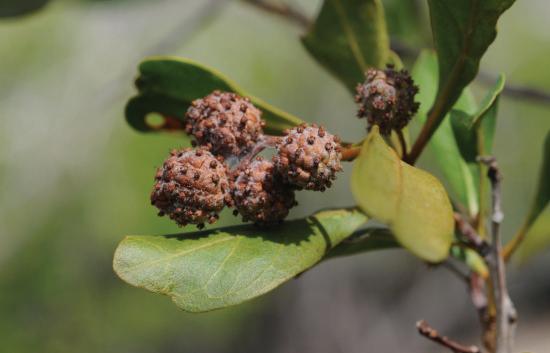

1. A er finishing their field trip in the mangrove forest and reviewing its importance, the disturbances to the ecosystem, and the ways in which it can be preserved, students will return with their photographs, ready to undertake an interes ng project.
2. Students will be given a reflexive diary form so they can think about the en re process.
3. If students have any doubts about the ecosystem, the teacher can use the opportunity to clear them up.
Homework:
1. Students will be asked to print their photographs in a larger size (when possible). If students are unable to do so, the teacher may help.
Praxis reflec on:
The reflec on will be performed by the teacher a er class is concluded.
Reasonable accommoda on:
Reasonable accommoda on will be offered to all students who need it. Students with physical or cogni ve difficul es will be offered reasonable me in which to do their tasks, tutoring during office hours and all the necessary opportuni es, according to their par cular cases.
1. Students will hold a photography exposi on with the pictures they took of the mangrove forest ecosystem. The exposi on can be held in the school library, or any loca on determined by school faculty, and can be le in place for several days so that the community (school staff, other students, and parents) can enjoy it. Students and teachers may also upload the photographs onto a school blog or website, if available.

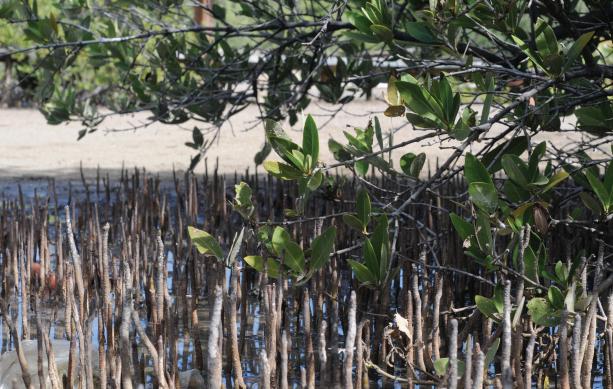

On the photograph exposi on opening day, students may each present their photograph and explain their reasons for taking the photograph, and what it means.
Students may be offered prizes.
2. Finally, as a legacy school project, students can plant a bu onwood (silver) mangrove tree in the school garden (if the school has enough space for it). Of course, students must then care for and maintain the tree (the group who planted the tree, and the students arriving a erwards). In this manner, other students will learn about the tree, and its importance.

Ocean literacy: Essen al principles and fundamental concepts
Principle 5: “The ocean supports a great diversity of life and ecosystems.”
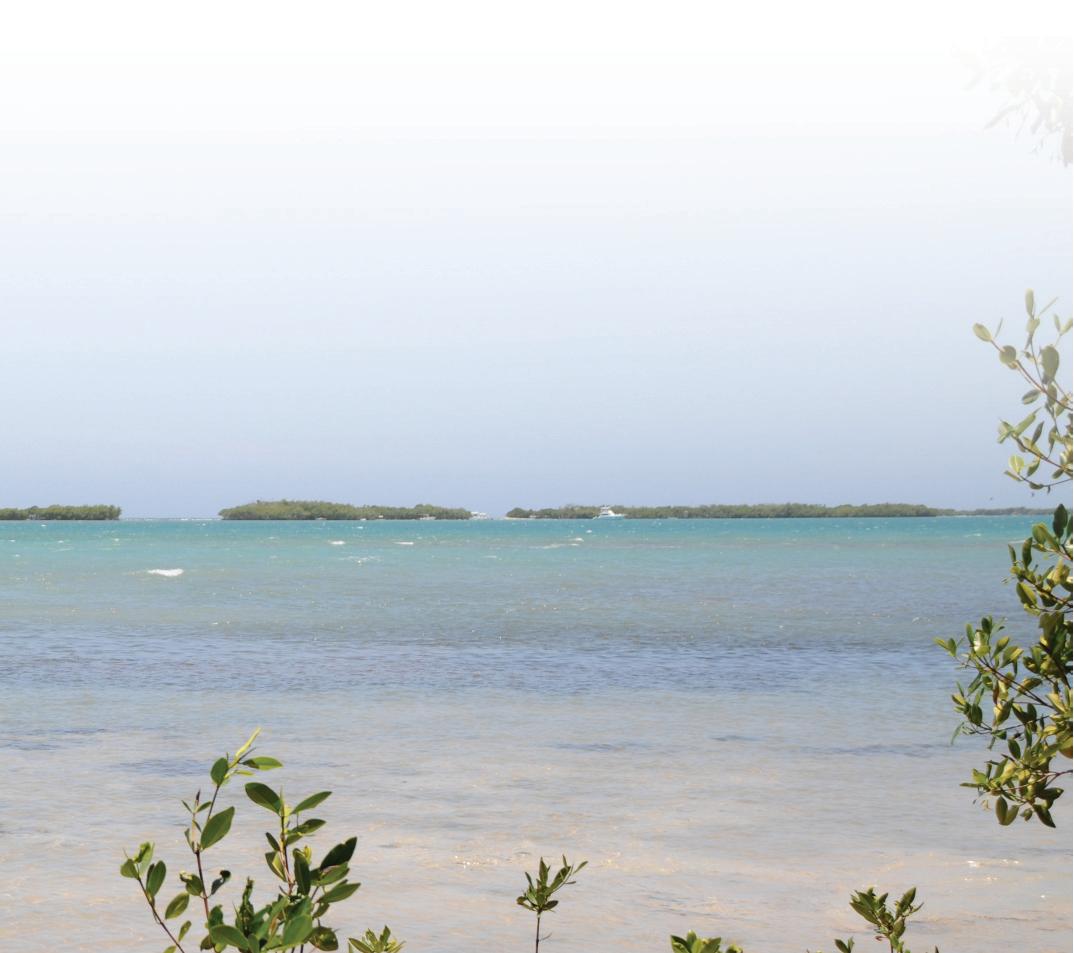


e. The ocean is three-dimensional, offering vast living space and diverse habitats from the surface through the water column to the seafloor. Most of the living space on Earth is in the ocean.
This class will consist of reviewing the concepts learned in previous lessons. Because of this, all previously men oned standards apply.


Name: _____________________________ Date: ____________________________
Professor: ___________________________ Grade-Group: ______________________
Instructions: Look at the pictures below, and select the one that best matches the experience you’ve had studying mangrove forests. Write an ‘X’ below the figure. Then, answer the questions below the chart.
How was your experience studying the mangrove forest ecosystem?
Did the activities performed in class help you learn about the ecosystem?
Did the field trip help you learn more about the importance of this ecosystem?
How did you feel while you learned about the topic?



Did you understand everything studied in class?
How was your participation in class?
Excel
Out of all the activities done in class, which was your favorite?
What could be improved?


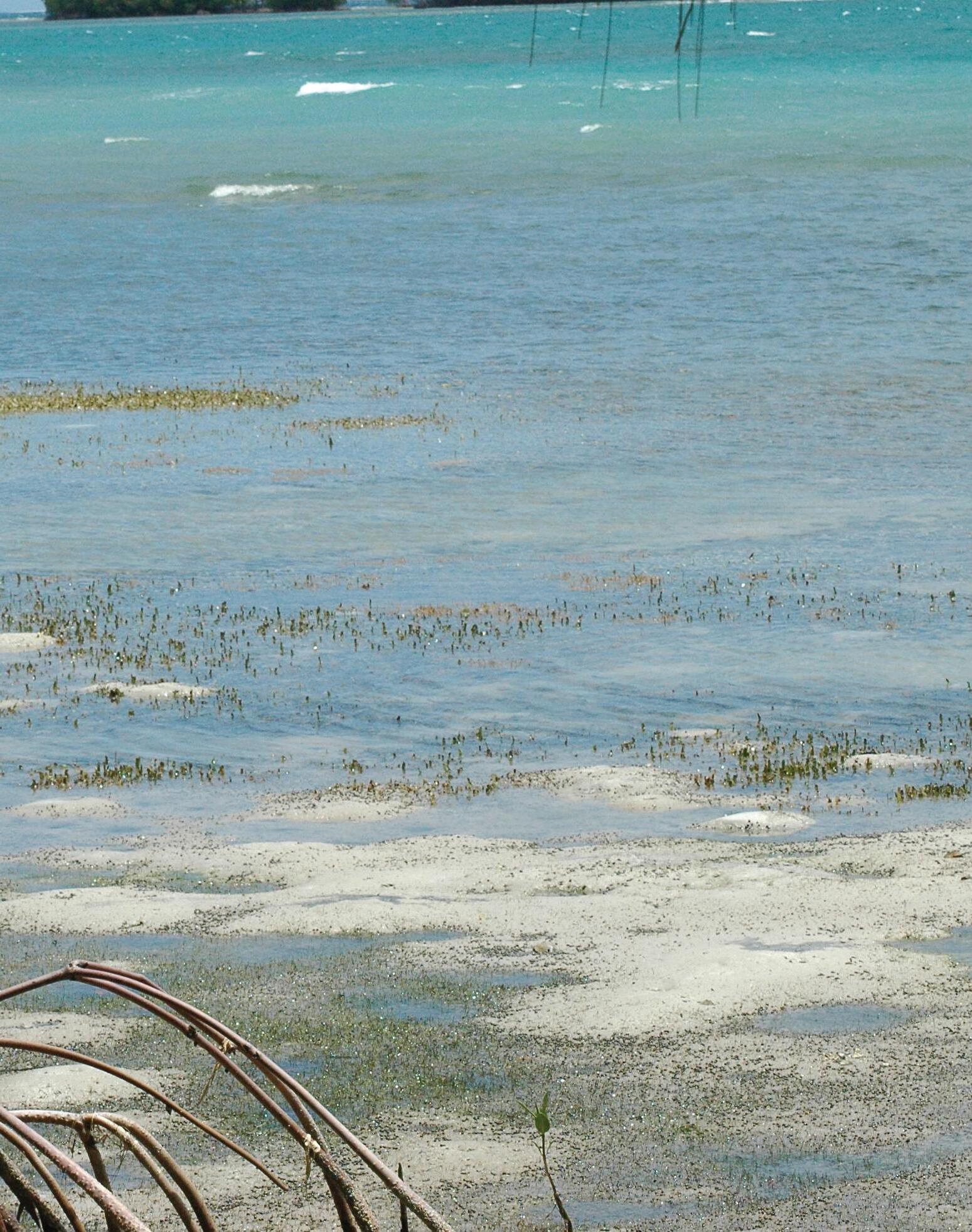
7. Groups, within one class, the subject, events, processes or phenomena (classification).
Third Grade
1. Makes questions and defines problems. X X
2. Develops and uses models. X X
3. Plans and performs research.
4. Analyzes and interprets data.
5. Proposes explanations and designs solutions. X X
6. Makes arguments based on reliable evidence. X X X X
7. Acquires, evaluates and communicates information. X X
8. Groups, within one class, the subject, events, processes or phenomena (classification). X X
Fourth Grade
1. Makes questions and defines problems. X X
2. Develops and uses models. X X X
3. Plans and performs research and experiments.
4. Analyzes and interprets data. X X X X
5. Uses mathematics and computer skills.
6. Proposes explanations and designs solutions. X X X
7. Makes arguments based on reliable evidence. X X X X
8. Acquires, evaluates and communicates information. X X
9. Groups, within one class, the subject, events, processes or phenomena (classification). X X X
Fifth Grade
1. Makes questions and defines problems.
2. Develops and uses models. X X X
3. Plans and performs research and experiments.
4. Analyzes and interprets data. X X
5. Uses mathematics and computer skills.
6. Proposes explanations and designs solutions. X X
7. Makes arguments based on reliable evidence.
8. Acquires, evaluates and communicates information.
9. Groups, within one class, the subject, events, processes or phenomena (classification).
Sixth Grade
1. Makes questions and defines problems.
2. Develops and uses models.
3. Plans and performs research and experiments.
4. Analyzes and interprets data.
5. Uses mathematics and computer skills.
6. Proposes explanations and designs solutions.
7. Makes arguments based on reliable evidence.
8. Acquires, evaluates and communicates information.
9. Groups, within one class, the subject, events, processes or phenomena (classification).


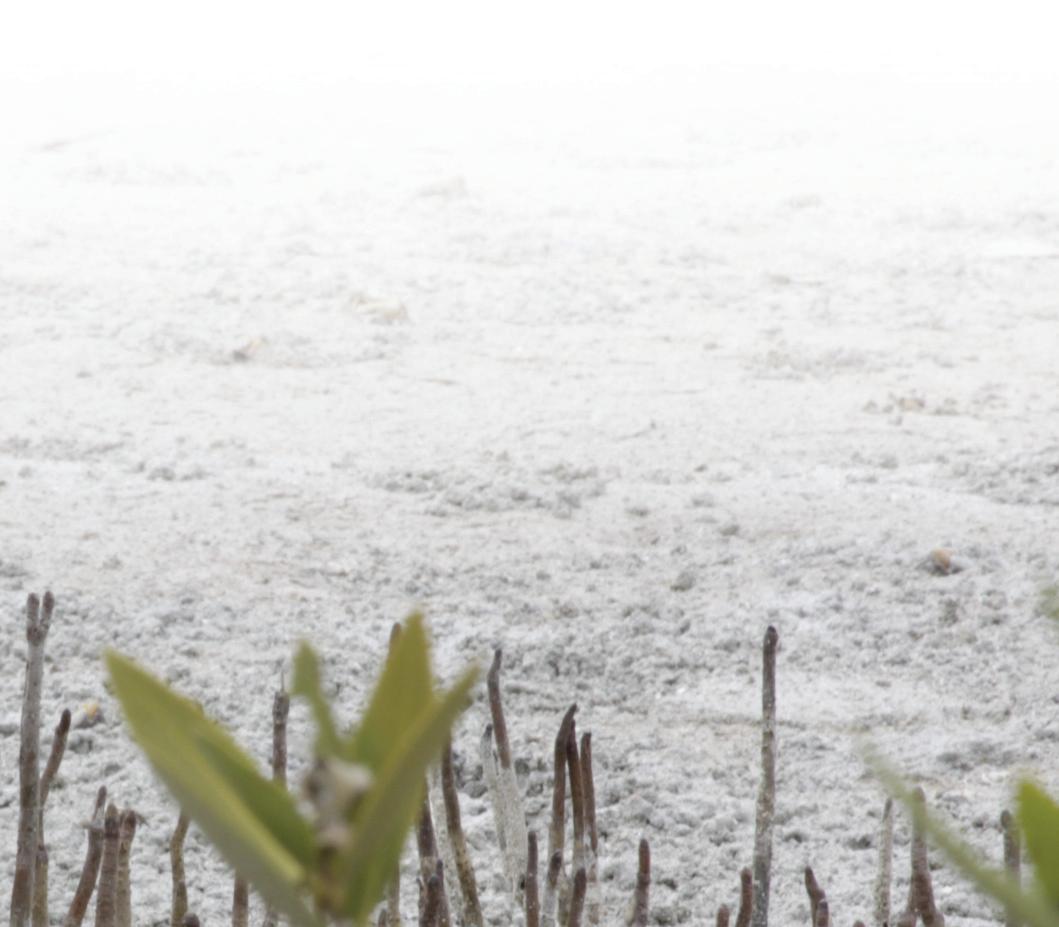

1. Scientific knowledge is based on empirical evidence.
2. The sciences answer questions about the world around us.
3. Sciences, engineering and technology influence humans, society and the natural world.
4. Sciences, engineering and technology are interdependent.
5. Scientific research uses various methods.
First Grade
1. Scientific knowledge is based on empirical evidence.
2. The sciences answer questions about the world around us.
3. Scientific knowledge follows a natural and consistent order.
4. Sciences, engineering and technology influence humans, society and the natural world.
5. Sciences, engineering and technology are interdependent.
6. Scientific research uses various methods. X X X
Second Grade
1. Scientific knowledge is based on empirical evidence.
2. The sciences answer questions about the world around us.
3. Scientific knowledge follows a natural and consistent order.
4. Scientific models, laws, mechanisms and theories explain natural phenomena.
5.
6.
1.
2.
2.
3.
4. Scientific models, laws, mechanisms and theories explain natural phenomena.
5. Science is an intrinsic part of human beings. X X
6. Sciences, engineering and technology influence humans, society and the natural world. X X
7. Sciences, engineering and technology are interdependent.
8. Scientific research uses various methods. X X X X
Fifth Grade
1. Scientific knowledge is based on empirical evidence.
2. The sciences answer questions about the world around us.
3. Scientific knowledge follows a natural and consistent order.
4. Scientific models, laws, mechanisms and theories explain natural phenomena.
5. Science is an intrinsic part of human beings.
6. Sciences, engineering and technology influence humans, society and the natural world.
7. Sciences, engineering and technology are interdependent.
8. Scientific research uses various methods.
Sixth Grade
1. Scientific knowledge is based on empirical evidence.
2. The sciences answer questions about the world around us.
3. Scientific knowledge follows a natural and consistent order.

4. Scientific models, laws, mechanisms and theories explain natural phenomena.

5. Science is an intrinsic part of human beings.
6. Sciences, engineering and technology influence humans, society and the natural world.
7. Sciences, engineering and technology are interdependent.
8. Scientific research uses various methods.
Plan 1: structures, plants, roots, leaves, stems, growth, survival, patterns, feeding, adaptation mechanisms, living beings, ecosystems (aquatic, terrestrial), habitats
Plan2: plant reproduction, adaptation, survival, habitat, environmental changes
Plan 3: living beings, environment, survival
Plan 4: environmental changes, ecosystems, environment, natural resource conservation, environmental impact, environmental pollution, environmental conservation, reducing, reusing, recycling, contamination, natural resources, water, human activities, environment, community, deforestation, human impact
Plan 5: All concepts learned in previous classes will be reviewed.
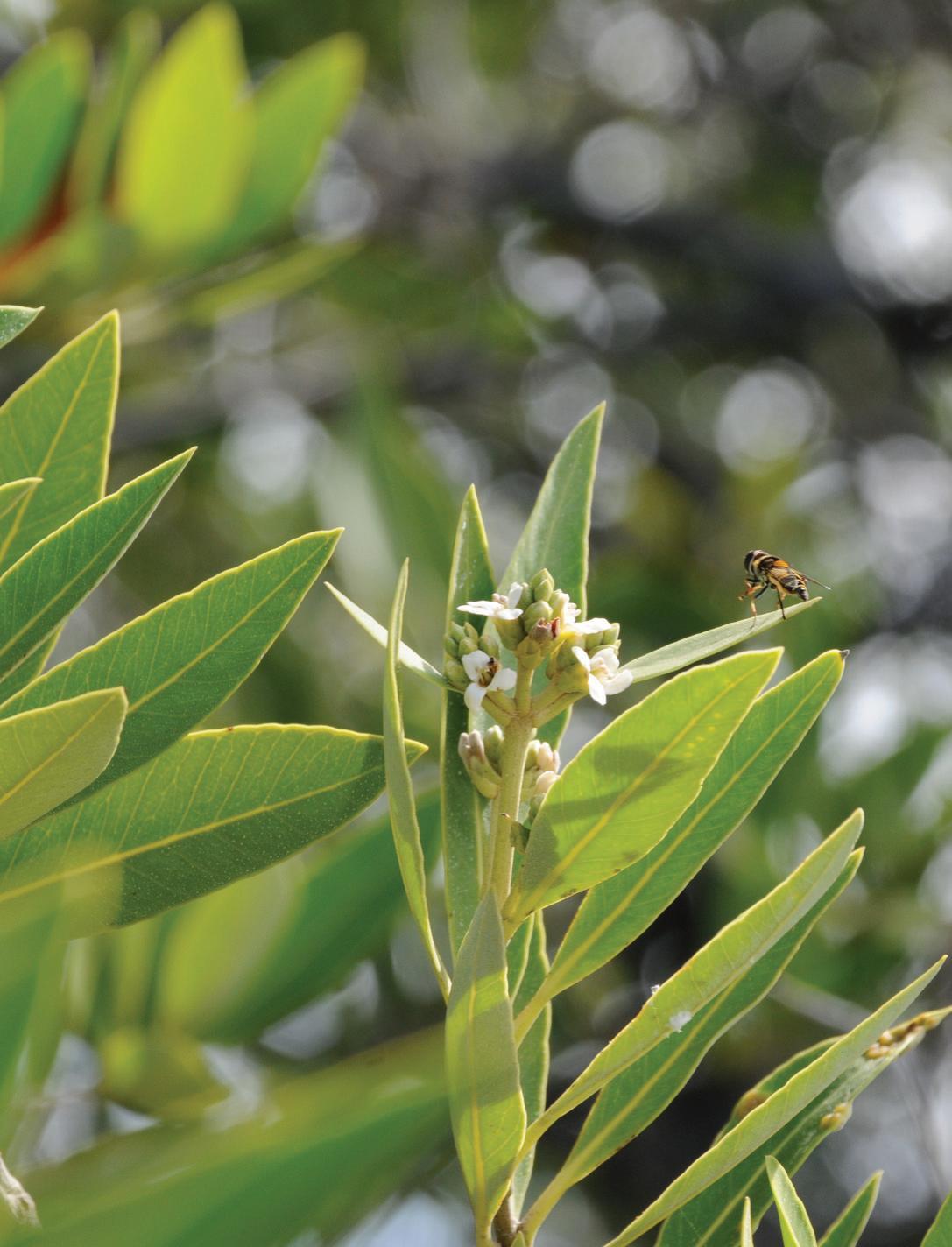








Time: 1 period
Teaching strategy: ECA
Phases: explora on, conceptualiza on and applica on
Teaching methods: demonstra ve, inquisi ve, ac on or ac vity
What are mangroves and mangrove forests?
What are mangroves and mangrove forests?
Types of mangrove forest Types of mangrove forest
Teaching techniques: coopera ve work, discussion, homework
Assessment technique: open ques ons, graphic organizer, par ally filled outline
Integra on with other subjects: Biology, Ecology
Materials:
• Mangroves - Guía educa va para maestros Educa onal Guide
• Mangrove-shaped graphic organizer slide
• Par ally filled outline
• Photos of the 4 types of mangroves
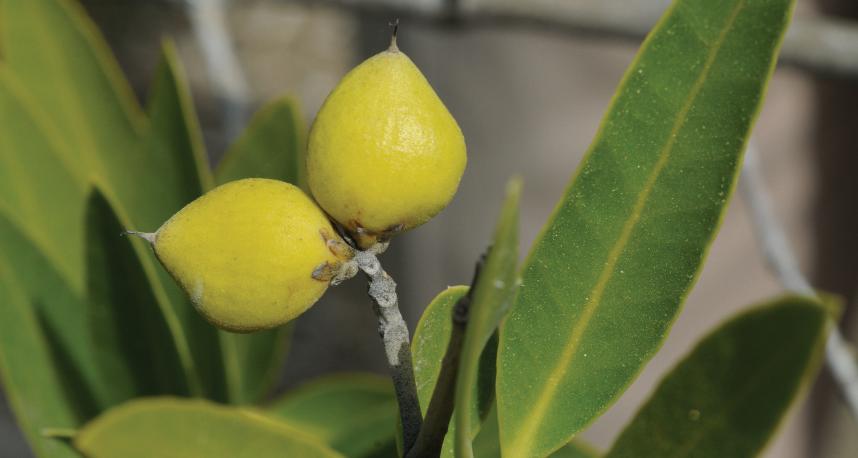
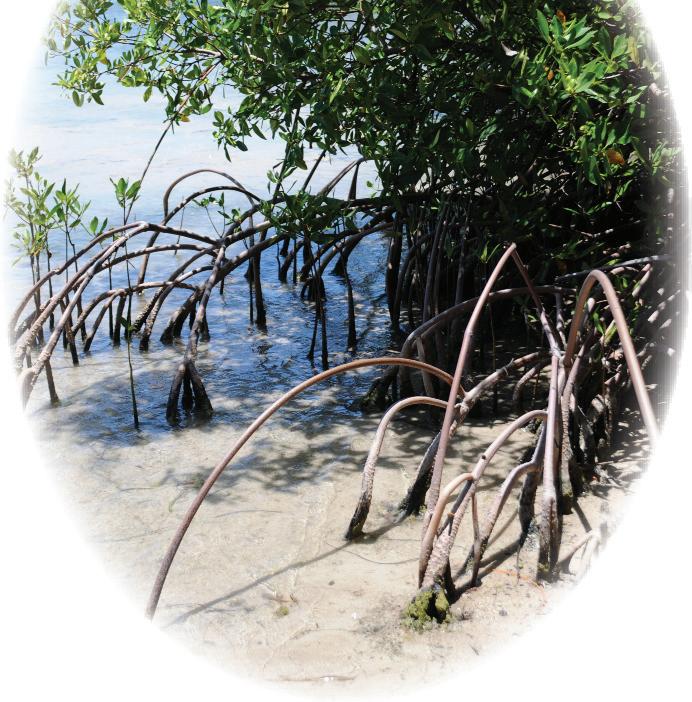
• Video: The mangrove (filmed by the Sea Grant Program)
Depth knowledge level:
Level I: Memory thinking
Level II: Process thinking
Objec ves:
A er studying the topics What is a mangrove and a mangrove forest? and Types of mangrove, the student will be able to:
• correctly define a mangrove tree. (conceptual)
• explain what is a mangrove forest. (conceptual)
• explain each mangrove’s characteris cs. (conceptual)
• compare and contrast mangroves with other common trees. (procedural)
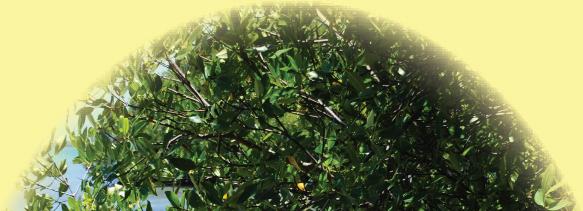
• iden fy the four (4) types of mangrove exis ng in Puerto Rico (white mangrove, black mangrove, red mangrove and bu onwood). (procedural)
• share their knowledge with their peers. (a tudinal)
1. Gree ngs
2. Administra ve business – roll call, etc. (performed internally)
3. Reflec on: “If there are no mangrove forests, then the sea will have no meaning. It is like having a tree with no roots, for the mangroves are the roots of the sea.” Andamanese fisherman. Taken from: The Mangrove Decade and Beyond (1990-2001) h p://www.mssrf. org/csr/csr-pub/03-Mangrove%20decade%20and%20beyond.pdf.
4. The teacher will begin class by projec ng a graphic organizer shaped like a red mangrove tree on the board. In the ‘Leaf’ sec on, the teacher will write the ‘Mangrove’ concept, and ask students to list their thoughts on the concept. The resul ng words or phrases will be placed in the mangrove root area.
5. Later, the teacher will ask the students to use the men oned words and phrases and build a defini on of ‘Mangrove tree’. The teacher may aid the students when making their defini on by asking: Is the mangrove a tree? What’s the difference between a mangrove tree and a more common or more familiar type of tree? What are the similari es? Students may also make a list of the differences and similari es between a mangrove tree and a regular tree such as a mango, avocado or breadfruit tree, or an oak, mahogany, holywood (guayacán), Spanish elm, or any other tree commonly found in their area.
6. Having defined what a mangrove tree is, student will then have to explain what a mangrove forest is.
Mangrove tree: a tree or shrub that can grow in places in which the soil is permanently or temporarily flooded; it may also grow in the water. It is a very tolerant plant that can adapt to both salt water and fresh water sources such as rivers or lagoons. A mangrove tree may grow in hypersaline waters, or soils less saturated with salt (Programa Semillas para el Ambiente, 2006-07).
Mangrove forest (general defini on students may provide): a forest formed by tropical trees typical to coastlines, that feature special adapta ons for growing in saline and flooded environments.
Mangrove forest (formal defini on): a forest ecosystem comprised of tropical trees typical to coastlines that feature special morphological adapta ons that allow it to grow in saline and flooded environments with poor soil oxygena on, and poor seed germina on condi ons. These forests are subject to periodical dal ac on and are dominated by one or more arboreal mangrove species.
Mangrove forests fulfil an important func on in protec ng the coasts against wind- and wave-driven erosion, feature high produc vity, and shelter a large variety of aqua c, amphibian and terrestrial organisms. Also, they serve a cri cal role in coastal and con nental shelf fisheries, since they provide habitat for the juvenile stages of hundreds of fish, mollusk and crustacean species. Moreover, they serve as temporary habitat for many northern and southern migra ng bird species (Diccionario Enciclopédico Dominicano de Medio Ambiente, 2012).

1. A er having clearly defined mangrove trees and mangrove forests, the teacher will play the video tled The Mangrove (filmed by the Sea Grant Program), accessed through the following address: h p://www.youtube.com/watch?v=Ac5amhWk2-Y&list=UU83zZurmP8H4 4OtoKVfpmqA&index=19&feature=plcp

Before watching the video, hand out copies of the par ally-filled outline, so that students can complete it as they watch the video. This outline has a table in which students must write the four (4) types of mangrove (black mangrove, red mangrove, white mangrove, and bu onwood) and their main characteris cs.
2. A er watching the video, the teacher will split the class into four (4) groups and give each group a photo of a mangrove tree. The photo includes the tree itself, and close-ups of the roots, leaves, seeds and flower. Students will be asked to use the characteris cs they took note of in their outlines and iden fy the mangrove in the photo they received. To do this, the students must observe the photo carefully, analyze each part of the mangrove tree and discuss the possibili es among themselves.
3. One student from each group will show the rest of the class the photo they received, and will inform the class which mangrove tree it is. Also, they will explain the characteris cs observed and what led them to that conclusion. The teacher can add to the discussion and join the students while explaining the topic, as needed.
Note: The teacher must be fully knowledgeable about these characteris cs, so that the discussion is effec ve and informa ve. Please read the mangrove species characteris cs sec on thoroughly.
1. To conclude the class, retake the red mangrove graphic organizer from the beginning of class and ask a volunteer to explain, in his/her own words, what a mangrove tree and forest is.
2. The students can summarize what they have studied in class about mangrove types, men oning the main characteris c that sets them apart from other mangrove species. This will indicate the level of learning and objec ves achieved.
Main characteris cs:
Red mangrove: aerial prop roots and propagules
Bu onwood: seed is bu on-shaped, ny green flowers in clusters
Black mangrove: salt on leaf surface (it excretes salt through its leaves), prominent, long pneumatophores
White mangrove: salt-excre ng glands at the leaf pedicel, shorter pneumatophores than on black mangroves
3. Any remaining ques ons about the subject will be addressed.
Homework:
1. Students will be asked to gather informa on about the geographic distribu on of mangrove forests in Puerto Rico and the rest of the world. Students can use any source available, including the Internet.

Praxis reflec on:
The reflec on will be performed by the teacher a er class is concluded.
Principle 5: “The ocean supports a great diversity of life and ecosystems.”

e. The ocean is three-dimensional, offering vast living space and diverse habitats from the surface through the water column to the seafloor. Most of the living space on Earth is in the ocean.
Taken from the Ocean Literacy Network.
Reasonable accommoda on:
Reasonable accommoda on will be offered to all students who need it. Students with physical or cogni ve difficul es will be offered reasonable me in which to do their tasks, tutoring during office hours and all the necessary opportuni es, according to their par cular cases.
Biological sciences
Standard: Theme organiza on levels and structure
Expecta ons and indicators:
From molecules to organisms: Processes and structures

EI.B.CB1.EM.9 Establishes the characteris cs used to group organisms through a classifica on system.
References:
Diccionario Enciclopédico Dominicano del Medio Ambiente. Zonación. Consulted on October 7, 2012, through h p://www.dominicanaonline.org/diccionariomedioambiente/ es/definicionVer. asp?id=615 asp?id=615

Sea Grant Program

Partially filled outline
Name: ____________________________
Professor: _________________________
Date: ____________________________
Grade-Group: ______________________
Instructions: Finish filling out the following outline while you study the mangrove forest topic.
I. Definition
a. Mangrove tree
b. Mangrove forest
II. Types of mangrove tree: While viewing the Los Manglares film (prepared by the Sea Grant Program), fill out the following table:
Characteristics
Mangrove Roots Leaves Flower Fruit
Mangrove types
IV. Where are Puerto Rico’s mangrove forests? Draw a line around the areas in which mangrove forests are located in Puerto Rico. Then, use the space provided to write in at least five towns in which mangroves can be found.

Towns Insular platform

V.Necessary conditions for mangrove forest development


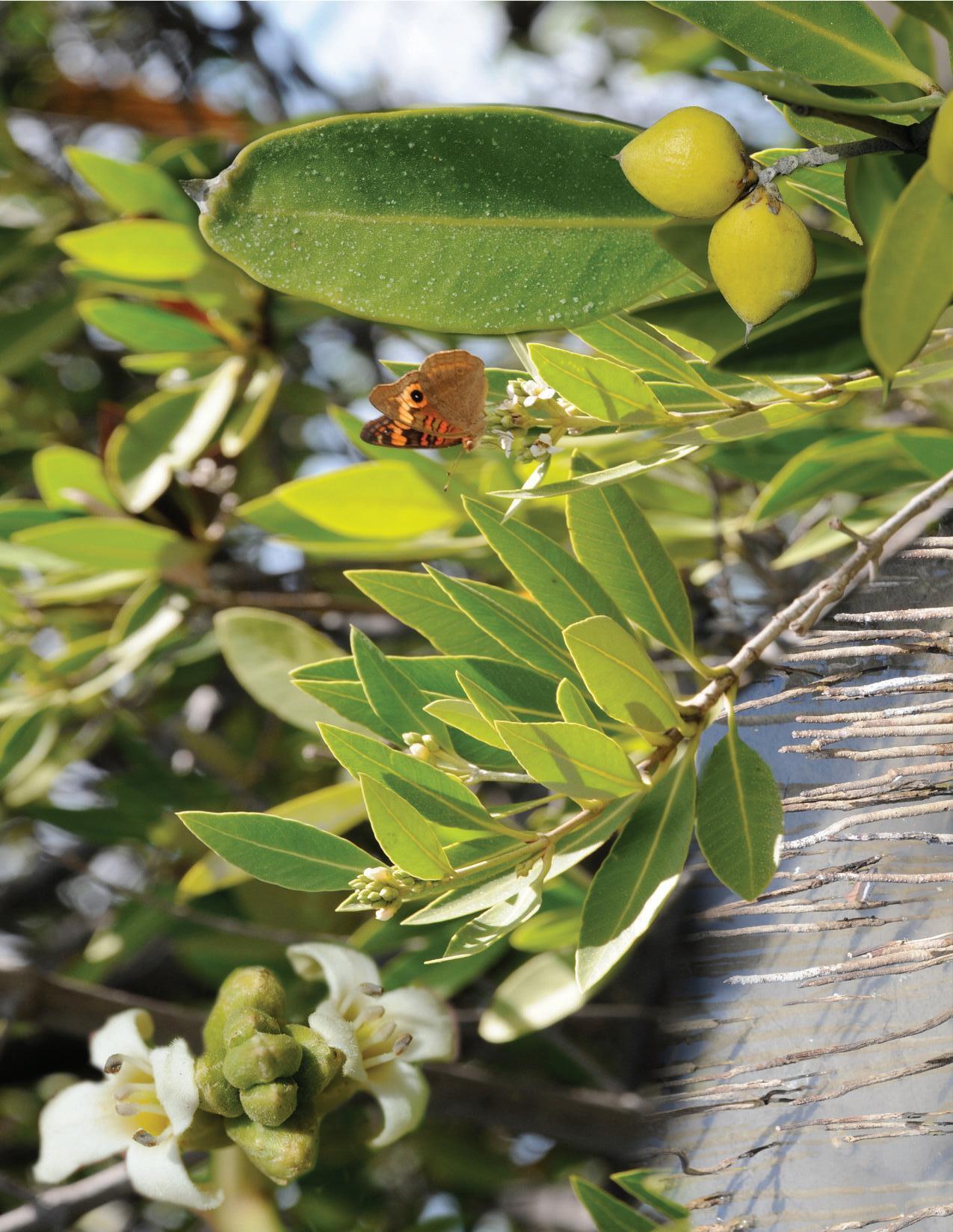


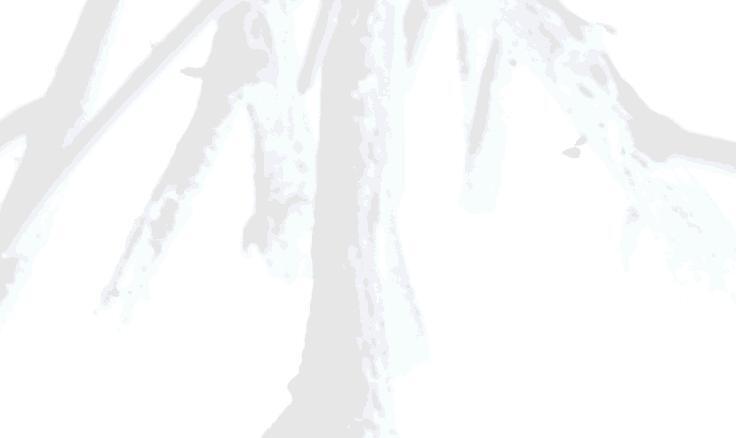
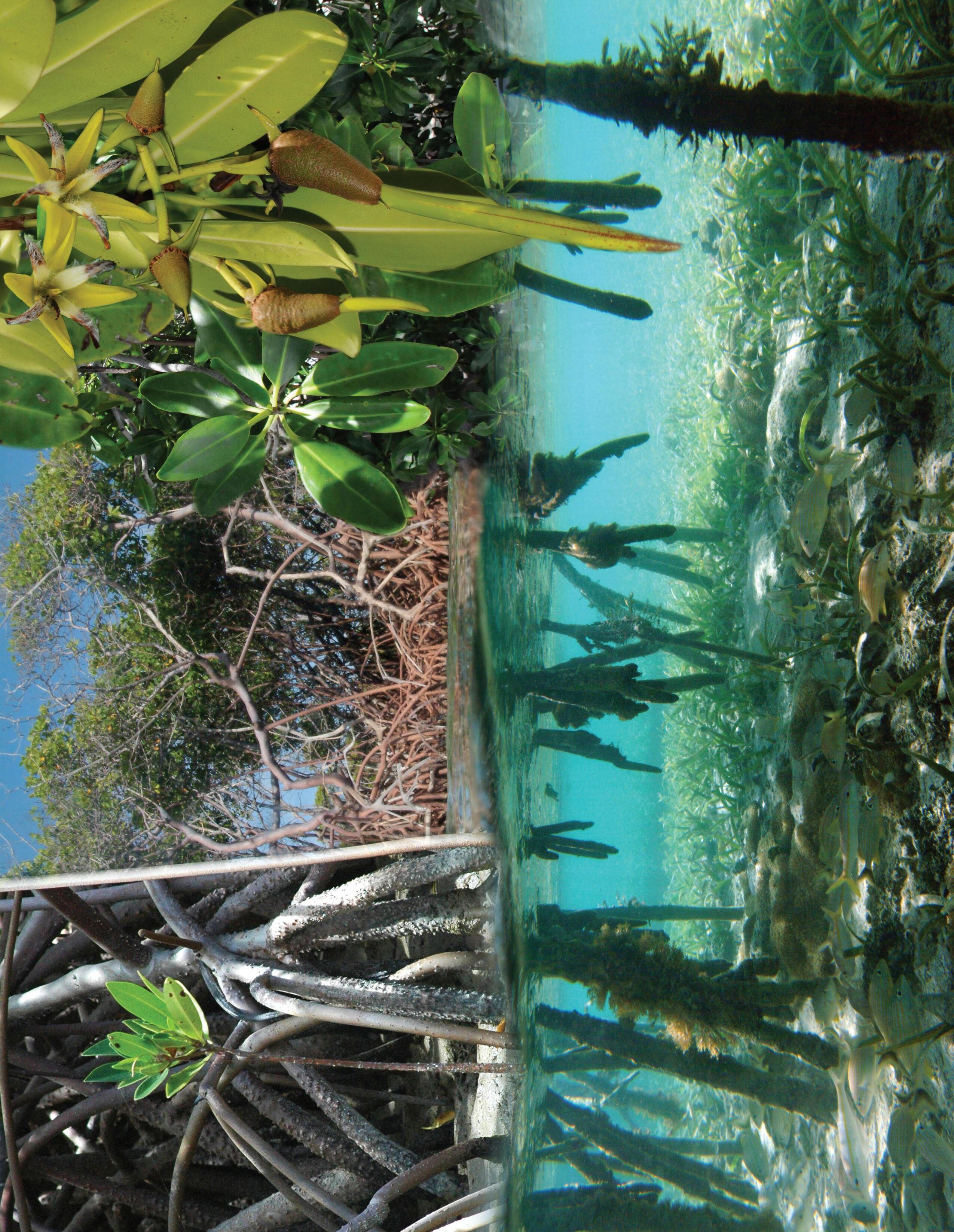















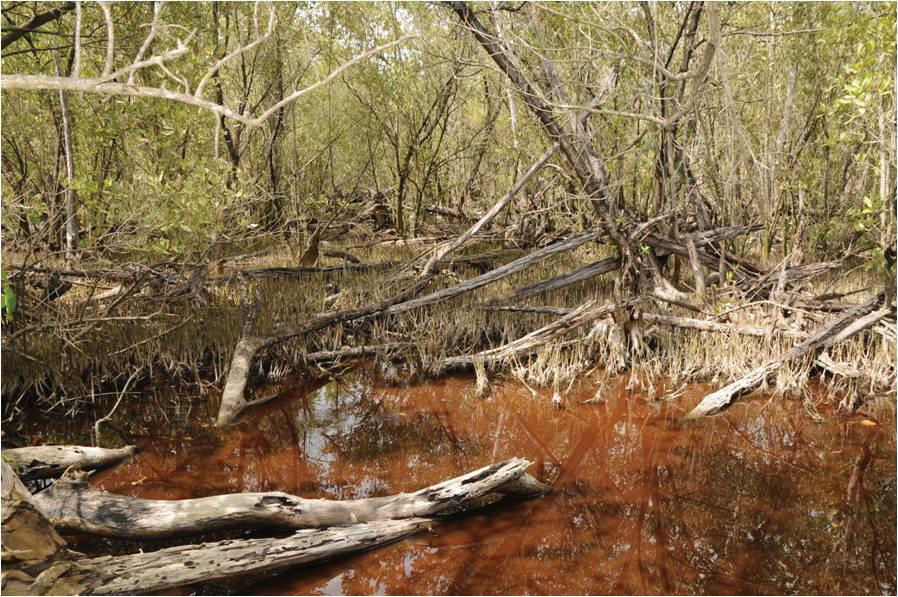







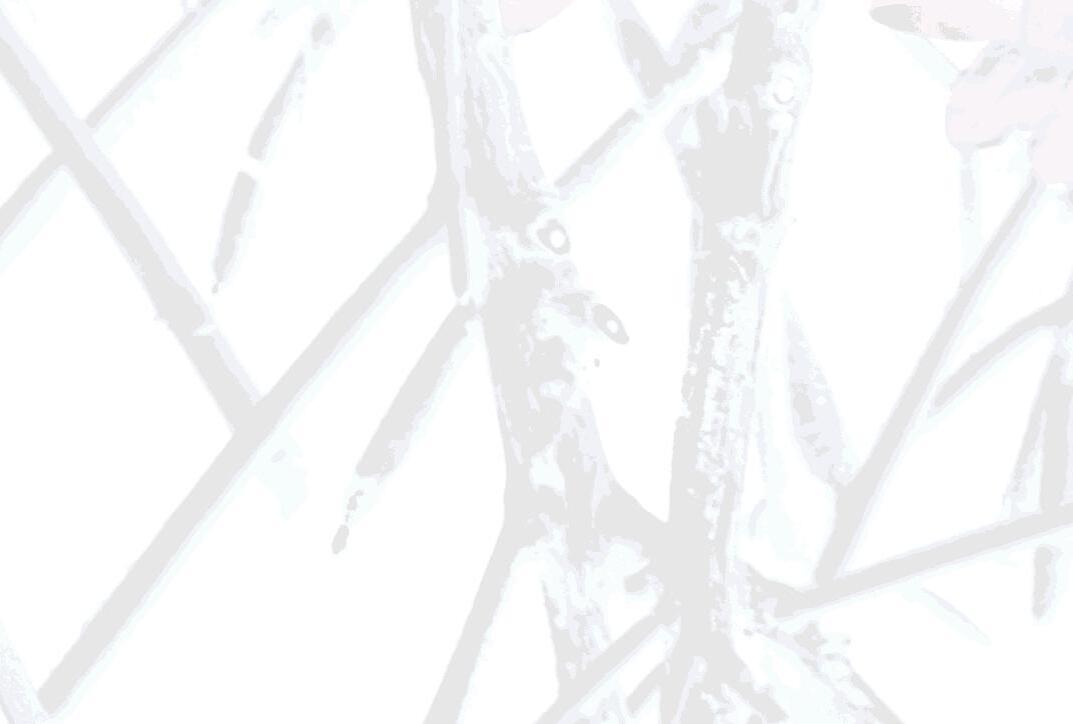




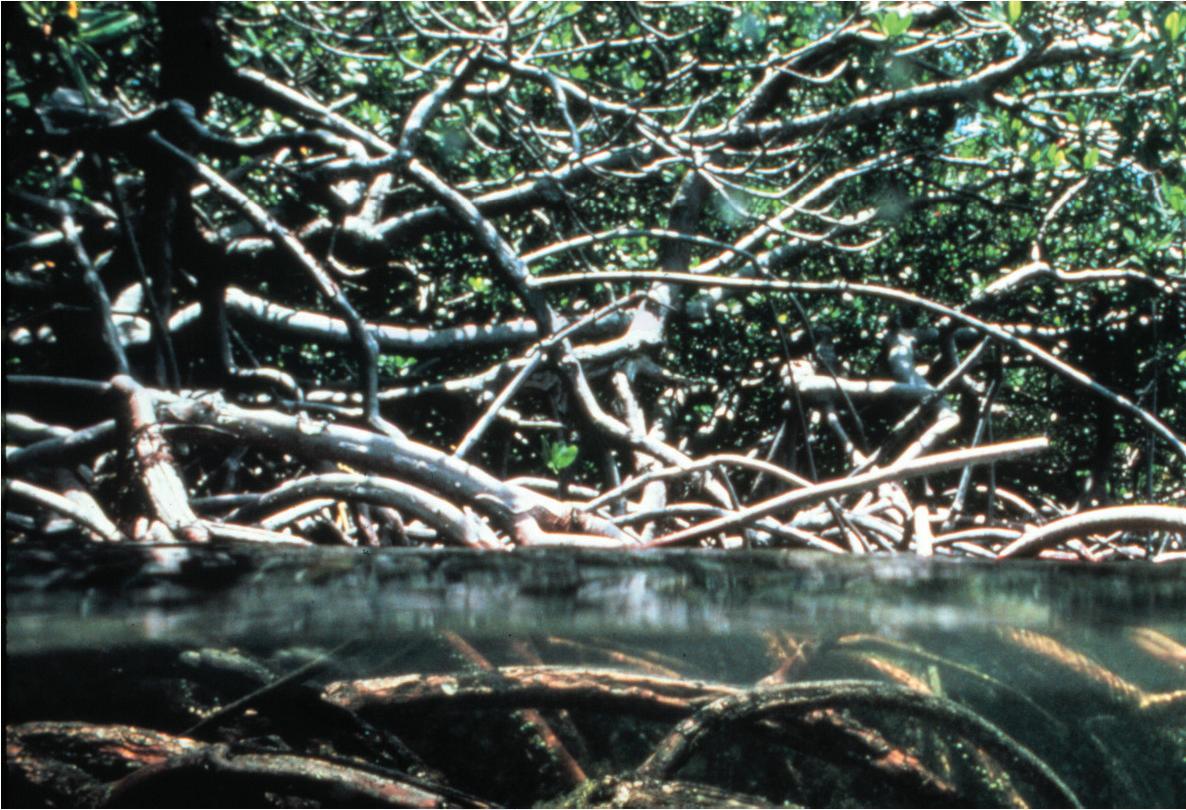

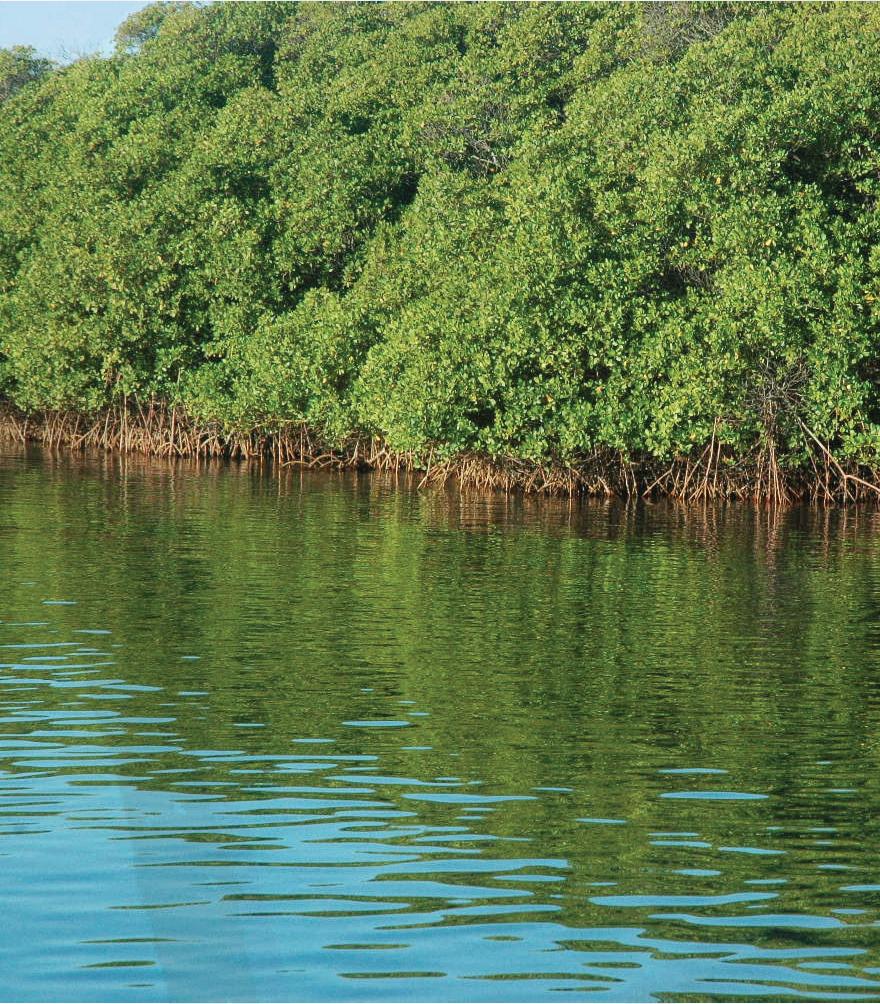
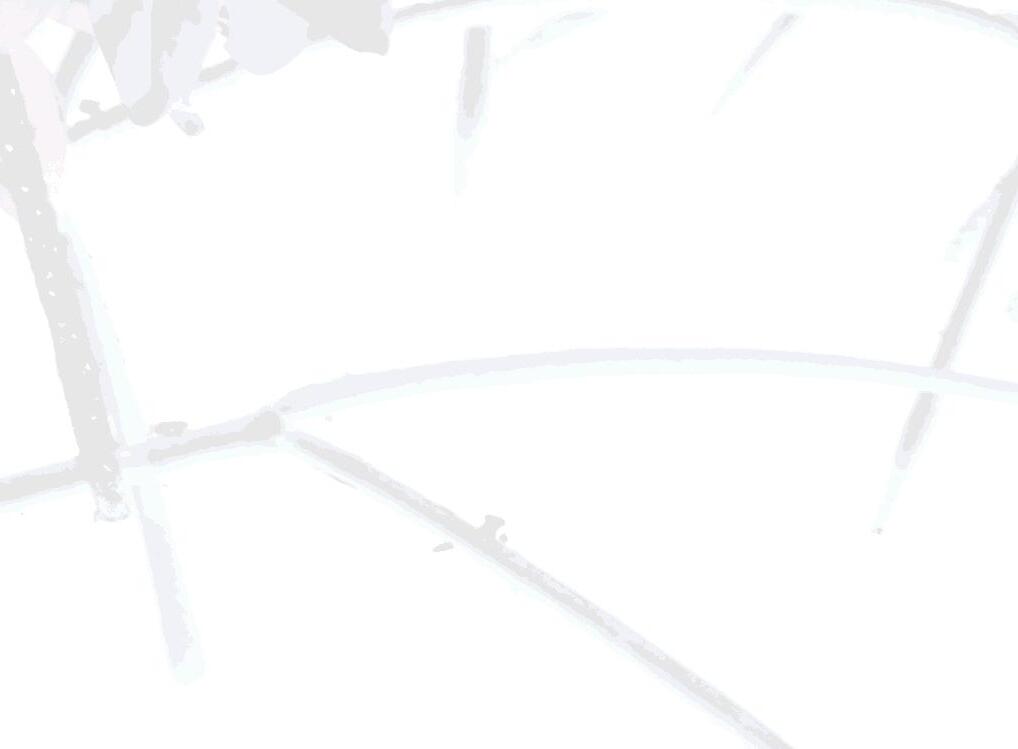




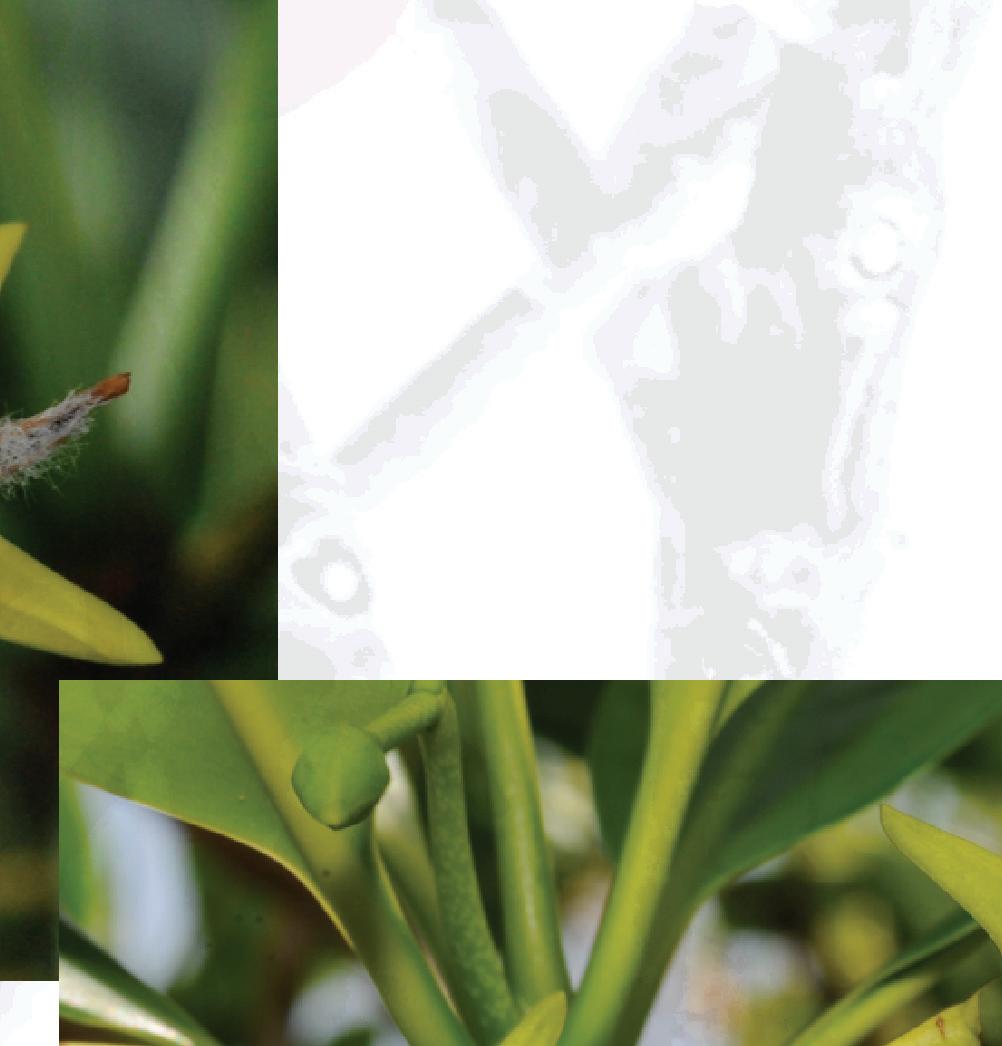
























Time: 1 period
Teaching strategy: ECA
Phases: conceptualiza on and applica on
Teaching method: demonstra ve, inquiry-based
Teaching technique: conference, review, sharing/ pair work
Assessment technique: open ques ons, par allyfilled outline, one minute paper
Integra on with other subjects: Biology, Ecology, Geography
Materials:
• Mangroves - Teacher’s Educa onal Guide
• Mangrove forests PowerPoint presenta on

• One Minute Paper instruc on sheet
• Par ally filled outline
• World map with mangrove forest growth area distribu on
• Map of Puerto Rico
Depth knowledge level:
Level I: Memory thinking
Level II: Process thinking
Level III: Strategic thinking
Objec ves:
A er studying the topics Mangrove forest zona on and geographic distribu on, the student will be able to:
• correctly explain zona on. (conceptual)
• explain the geographic distribu on of mangrove forests worldwide (conceptual)
• iden fy the characteris cs of a tropical zone. (conceptual)
• correctly iden fy mangrove forest zona on in Puerto Rico. (procedural)

• locate some of the towns in Puerto Rico that feature mangrove forests using a map and coordinates (la tudes and longitudes). (procedural)
• compare temperate zones with tropical zones using the mangrove forest ecosystem. (procedural)
• share their knowledge with their peers. (a tudinal)

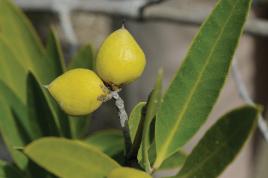
1. Gree ngs
2. Administra ve business – roll call, etc. (performed internally)
3. Reflec on: “There is always an open book for all eyes: nature”. Jean Jacques Rousseau
4. Asking open-ended ques ons, the teacher will guide students to recall and review informa on learned in the previous class. Then, the teacher will use the Mangrove forests PowerPoint presenta on to fully explain mangroves, mangrove forests, and the four types of mangroves (this is a brief review, and should not be very me-consuming).
1. A er reviewing concepts and the characteris cs of the four mangrove species, the teacher will explain zona on, specifying that mangrove trees grow in a par cular order that may change depending on the loca on’s physiography (physical geography). Later, students will be asked to observe their par ally-filled outline, the mangrove forest
zona on illustra on, and iden fy the order in which they grow. This ac vity can be performed in pairs. Students will be asked to choose a work partner (or the teacher will assign the partner), and consult with each other regarding the order.
The teacher will discuss the usual order with the students. In general terms, the first tree found will be the red mangrove (near and within the water). Then comes the black mangrove, the white mangrove, and finally, the bu onwood (González y González, 2010). Black mangroves and bu onwoods may mix within the same area. Therefore, these two trees’ posi ons may be interchanged.

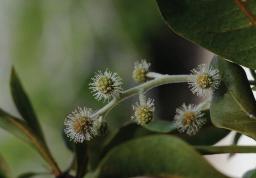
Zona on - distribu on of organisms in biogeographic zones (Merriam-Webster, 2017).

2. The teacher will explain to the students that there are 54 mangrove species growing in different parts of the world, and out of these, 4 grow in Puerto Rico. The students will be asked to share the informa on they gathered about the places in which mangrove forests can be found. A world map may be projected so that the informa on can be be er visualized. Students will be asked: Which parts of the world feature mangrove forests? What type of climate do these areas have? Here, the teacher can take the opportunity to compare tropical and temperate zones.

Each zone’s characteris cs can be wri en on the board. Two photographs showing the difference between both types of forest (tropical and temperate) can be shown.
1. To close the class, students will return their focus to Puerto Rico and receive a map of our archipelago. They will be given at least 6 coordinate sets so they can locate some of the places in Puerto Rico in which mangrove forests may be found. The towns located at the coordinates show just a few of the areas that feature this ecosystem. This will be discussed with the students with the map provided, or with the Google maps tool, if there is Internet access in the classroom.
2. Students will be given the One Minute Paper worksheet so they can iden fy what they understood and what they may s ll have ques ons about.
Praxis reflec on:
The reflec on will be performed by the teacher a er class is concluded.
Reasonable accommoda on:
Reasonable accommoda on will be offered to all students who need it. Students with physical or cogni ve difficul es will be offered reasonable me in which to do their tasks, tutoring during office hours and all the necessary opportuni es, according to their par cular cases.
Principle 5: “The ocean supports a great diversity of life and ecosystems.”

f. Ocean habitats are defined by environmental factors. Due to interac ons of abio c factors such as salinity, temperature, oxygen, pH, light, nutrients, pressure, substrate and circula on, ocean life is not evenly distributed temporally or spa ally, i.e., it is “patchy”. Some regions of the ocean support more diverse and abundant life than anywhere on Earth, while much of the ocean is considered a desert.
h. Tides, waves and preda on cause ver cal zona on pa erns along the shore, influencing the distribu on and diversity of organisms.
Biology
Standard: Conserva on and change
Expecta ons and indicators:
Ecosystems: Interac ons, energy and dynamics
ES.B.CB2.CC.2 Builds a model that represents and explains the steps involved in an ecosystem’s ecological succession.
Environmental sciences
Standard: Subject structure and organiza on levels
Expecta ons and indicators:
Earth systems
ES.A.CT2.EM.4 Gathers evidence about the geologic origin, the loca on, and the importance of Puerto Rico’s natural resources, and compare this evidence with that from the other Greater An lles.
ES.A.CT2.EM.5 Iden fies the characteris cs in the natural environment in a tropical region in order to establish a contrast with other world regions.

ES.A.CT2.EM.6 Classifies and describes the characteris cs, the loca on and the importance of forests in Puerto Rico. Compare other forests in the world to tropical ones.
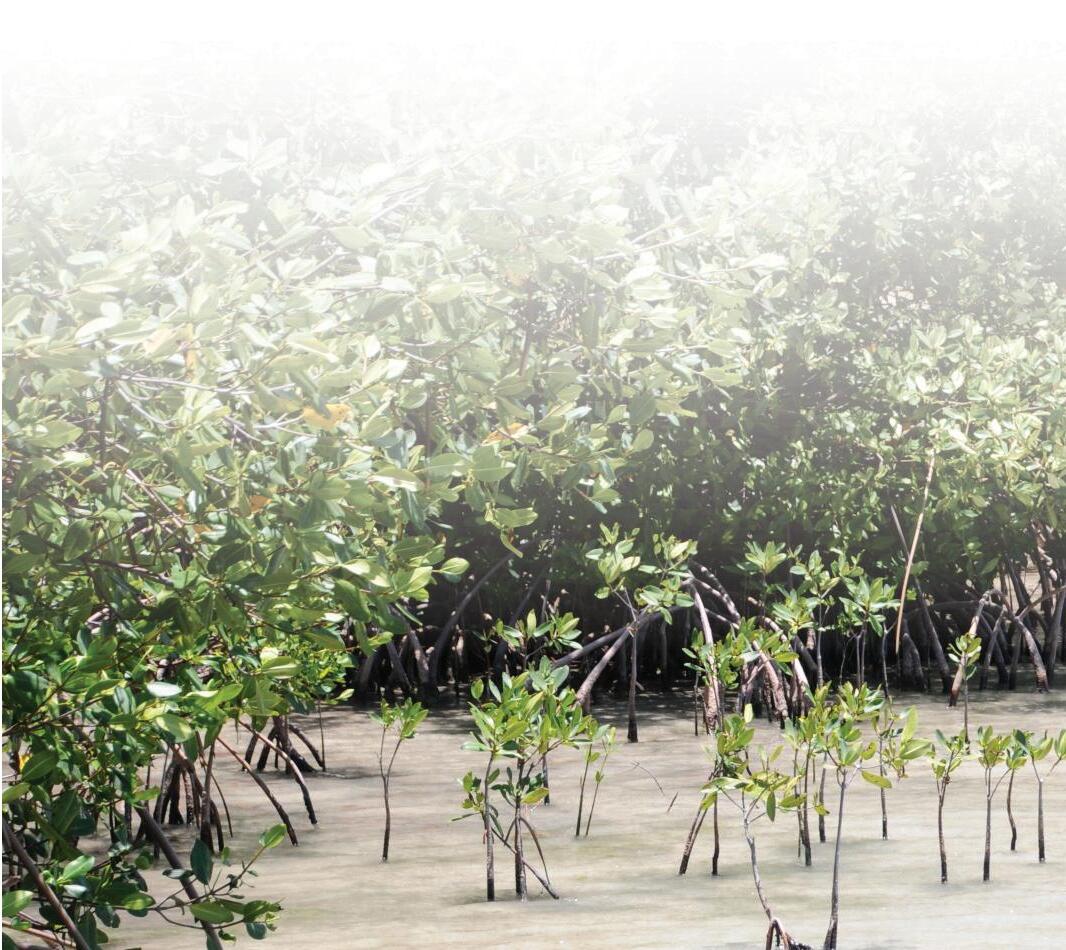
References:

Diccionario Enciclopédico Dominicano del Medio Ambiente. Zonación. Consulted on October 7, 2012, through h p://www.dominicanaonline.org/diccionariomedioambiente/ es/definicionVer. asp?id=615
Merriam-Webster Dic onary. Zona on. Consulted on March 16, 2017, through h ps://www.merriamwebster.com/dic onary/zona on




University of Puerto Rico

Mangrove Forests
Map of Puerto Rico and geographic coordinates of mangrove forests
Date: _____________________________
Grade-Group: ______________________
Name: ____________________________
Professor: _________________________
n the map of Puerto Rico provided in the next page. Use the space provided to write the towns in which the coordinates are found. These towns are some of those which feature mangrove forests along their co asts. Latitudes
Instructions: Look for the following latitudes and longitudes

Mayagüez Campus
Sea Grant Program
Mangrove forests
One Minute Paper
Name: _____________________________ Date: ____________________________
Professor: ___________________________ Grade-Group: ______________________
Instructions: Read the following questions and answer as honestly as possible. You have one minute to write your answers.
1.What was the most important thing you learned today?
2. What questions do you still have?
Mayagüez Campus
Sea Grant Program


Mangrove forests
One Minute Paper
Name: _____________________________ Date: ____________________________
Professor: ___________________________ Grade-Group: ______________________
Instructions: Read the following questions and answer as honestly as possible. You have one minute to write your answers.
1.What was the most important thing you learned today?
2. What questions do you still have?




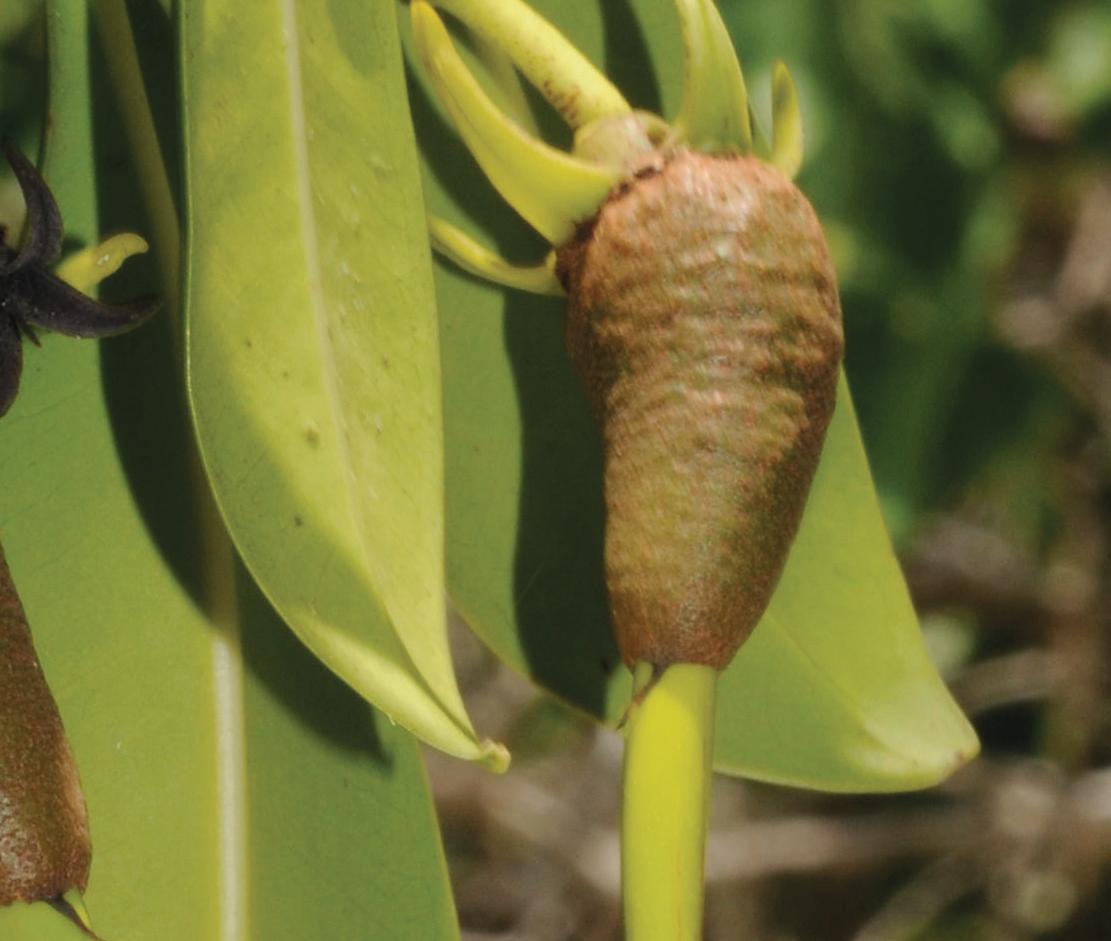


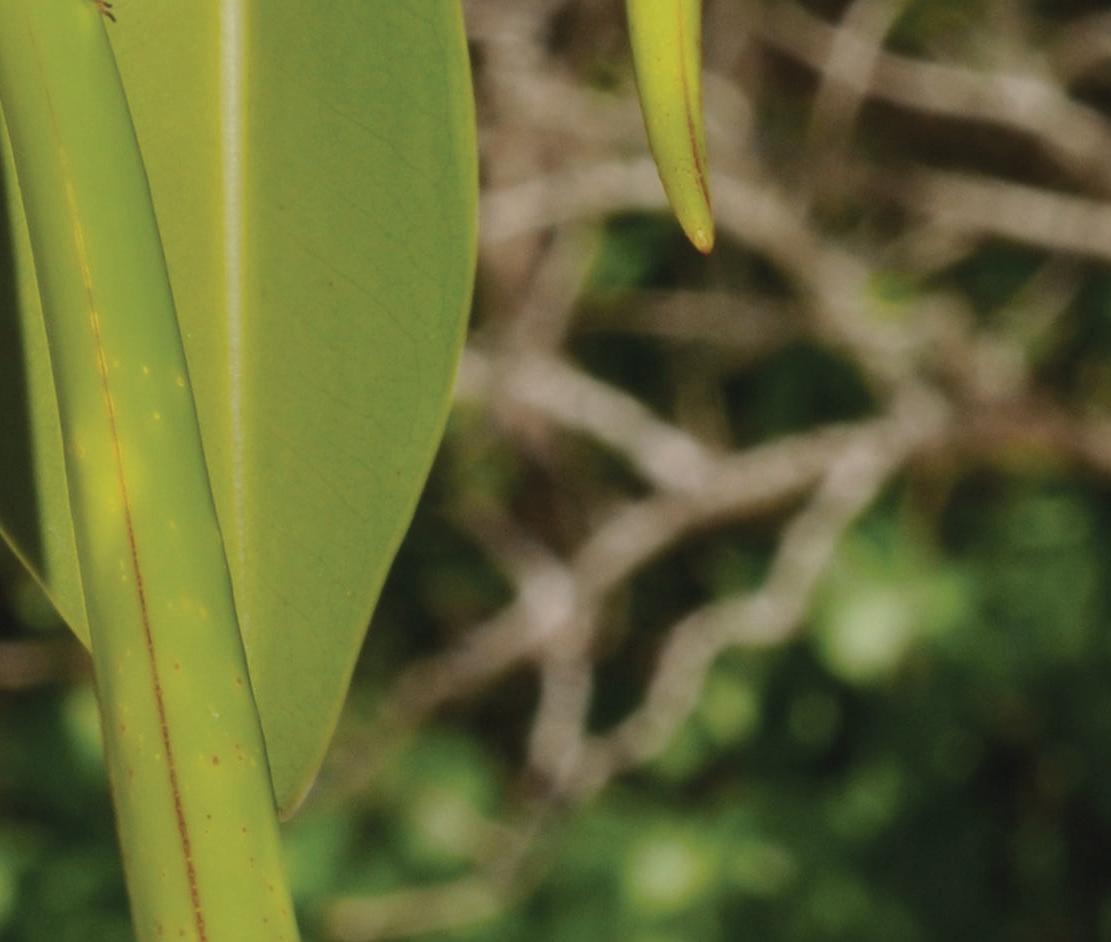




Time: 1 period
Teaching strategy: ECA
Phases: conceptualiza on and applica on
Teaching methods: demonstra ve, inquiry-based, ac on or ac vity
Teaching technique: conference, review, homework
Assessment technique: open ques ons, par ally-filled outline
Integra on with other subjects: Biology, Ecology, Geography, Mathema cs
Materials:
• Mangroves - Teacher’s Educa onal Guide

• Mangrove forests PowerPoint presenta on

• Par ally filled outline
• World map with mangrove forest growth area distribu on
• Map of Puerto Rico
• Mangrove forest fact sheet
Depth knowledge levels:
Level I: Memory thinking
Level II: Process thinking
Level III: Strategic thinking
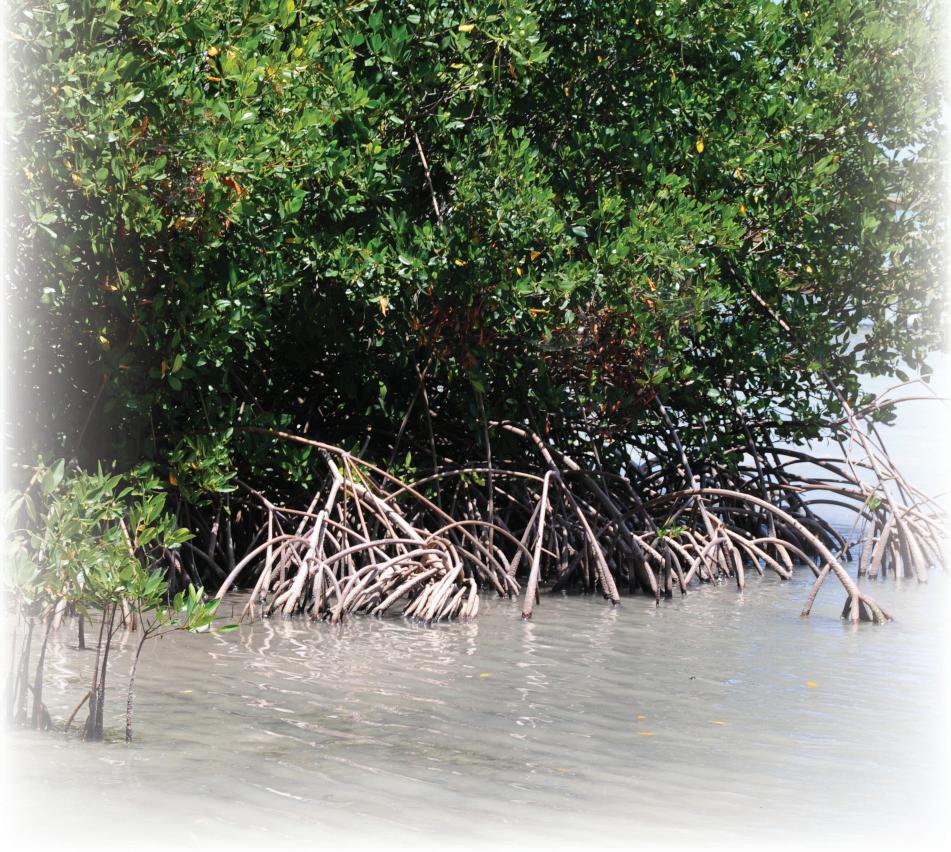

Objec ves:
A er studying the topic regarding the necessary condi ons for mangrove forest development, the student will be able to:
• correctly analyze the coastal surf and temperature data in Puerto Rico. (conceptual)
• correctly analyze the coastal temperature and precipita on data for various world regions. (conceptual)
• correctly correlate the variables previously men oned. (procedural)
• iden fy the necessary condi ons for mangrove forest growth and development. (procedural)
• jus fy the reason for which mangrove forests grow and develop in the places in which they are found. (conceptual)
• share informa on with their peers. (a tudinal)
1. Gree ngs
2. Administra ve business – roll call, etc. (performed internally)
3. Reflec on: “In all things of Nature, there is a touch of the marvelous” Aristotle
4. The teacher will begin class by reviewing the concepts students indicated were ‘misunderstood’ or ‘not understood’ in the previous class’ One Minute Paper exercise.
1. World map and the map of Puerto Rico which the students worked with the previous day, resume discussions on the places in which mangroves may be found. Students will be asked to carefully observe both maps so they can indicate what they observe in the world map, and iden fy which parts of Puerto Rico do not feature mangrove forests.
2. Students will realize, upon reviewing the informa on they brought and the informa on they discovered through the previous ac vity, that mangroves grow in specific places. The teacher will then ask them why they believe mangroves grow in certain places only.
3. The teacher will split the group into sub-groups and will be handed a sheet containing several facts about coastal temperature and precipita on in several parts of the world. Discuss the condi ons in the regions containing mangroves, and those that do not. The teacher will offer instruc ons to the students on how to analyze the data. Temperatures will be wri en in Fahrenheit, and students will be asked to convert the recorded temperatures into Celsius (and thus prac ce conversions) using the following equa on:
oC = 5/9 (oF – 32)
Students will then iden fy in the world map the regions which support mangrove forests, and the areas that do not. Students will speak among themselves regarding their discoveries and conclusions. While this takes place, the teacher may project the world map so that students may observe the areas featuring mangrove forests. Students will discuss their conclusions with the group as a whole. The teacher may ask the students: Which characteris cs do these places have in terms of temperature and surf condi ons? Students will be asked to compare the areas featuring mangrove forests with areas that do not feature these specialized trees. They will be guided so that they may correlate mangrove forest growth with the different parameters studied in class.
4. The worksheet includes several facts about coastal surf and temperature in different zones in Puerto Rico. These facts are part of the research done by Dr. Miguel Canals Silander, from the University of Puerto Rico at Mayagüez. Students will be asked to analyze these facts and show the areas in Puerto Rico that support mangrove forests. They will realize there is a correla on between surf condi ons and mangrove forest growth. Areas with high surf condi ons cannot support mangrove forest development. The teacher should discuss this with the students as they come to this conclusion.
1. To conclude the class, the teacher will use the Mangrove forests PowerPoint presenta on and discuss the reasons men oned about the condi ons mangrove forests need to thrive. In this manner, the mangrove’s geographic distribu on is summarized and students can observe the characteris cs featured by tropical regions and their forests.
Homework:
1. Students will be asked the following ques on:
The coast of San Juan, Puerto Rico, features high surf condi ons; however, mangroves grow there. Can you explain the reason why this phenomenon is possible?
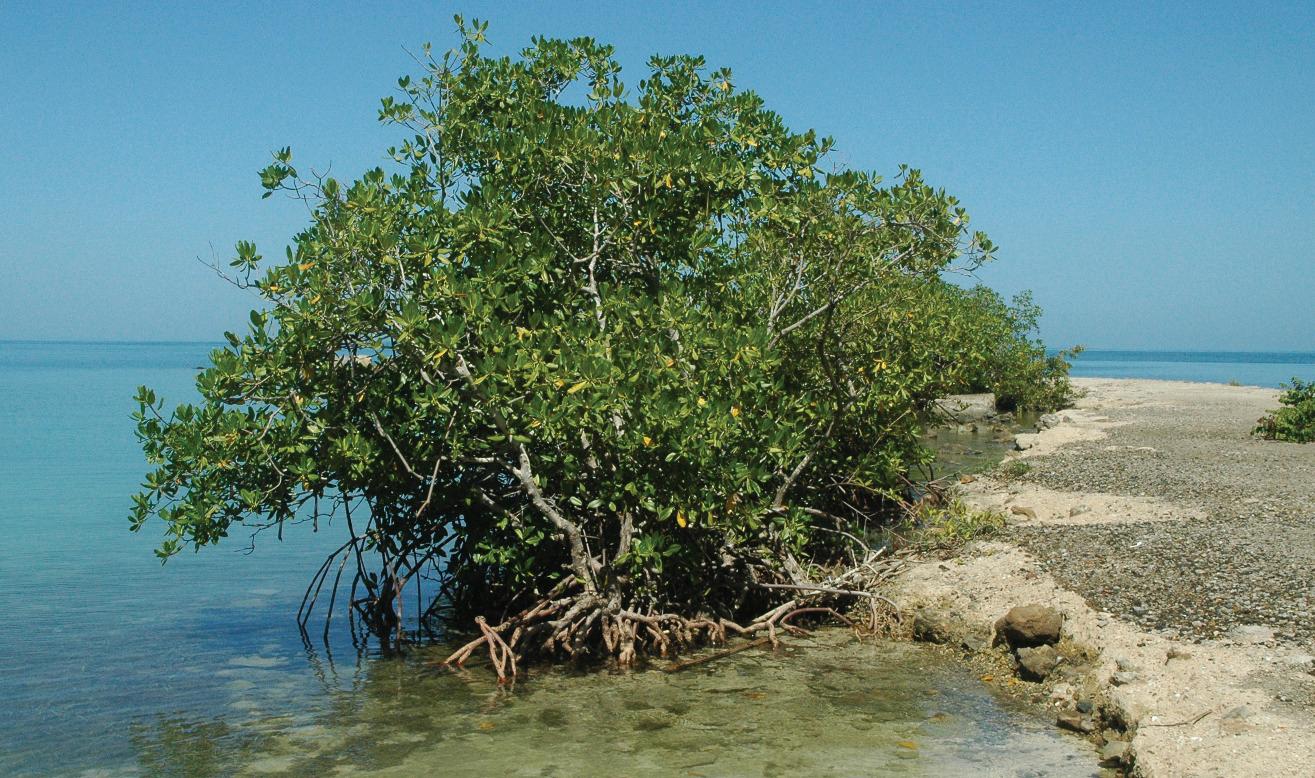
Praxis reflec on:
The reflec on will be performed by the teacher a er class is concluded.
Reasonable accommoda on:
Reasonable accommoda on will be offered to all students who need it. Students with physical or cogni ve difficul es will be offered reasonable me in which to do their tasks, tutoring during office hours and all the necessary opportuni es, according to their par cular cases.
Ocean literacy: Essen al principles and fundamental concepts
Principle 5: “The ocean supports a great diversity of life and ecosystems.”
f. Ocean habitats are defined by environmental factors. Due to interac ons of abio c factors such as salinity, temperature, oxygen, pH, light, nutrients, pressure, substrate and circula on, ocean life is not evenly distributed temporally or spa ally, i.e., it is “patchy”. Some regions of the ocean support more diverse and abundant life than anywhere on Earth, while much of the ocean is considered a desert.
h. Tides, waves and preda on cause ver cal zona on pa erns along the shore, influencing the distribu on and diversity of organisms.
Content standards and grade expecta ons
Biological sciences
Standard: Interac ons and energy
Expecta ons and indicators:
From molecules to organisms: Structures and processes

EI.B.CB1.IE.2 Evaluates how gene c and environmental factors influence an organism’s growth. Engages how scien sts use gene c knowledge in order to predict progeny.
Biology
Standard: Conserva on and change
Expecta ons and indicators:
Ecosystems: Interac ons, energy and dynamics
ES.B.CB2.CC.1 Iden fies environmental factors to posit an argument about its nega ve and posit effects in popula on growth.
Standard: Subject structure and organiza on levels
Expecta ons and indicators:
Ecosystems: Interac ons, energy and dynamics
ES.B.CB2.EM.1 Uses mathema cal or technological representa ons to support explana ons about the factors affec ng ecosystems’ carrying capacity at different scales.
ES.B.CB2.EM.2 Uses mathema cal representa ons to support and review evidence-based explana ons regarding the factors affec ng ecosystem biodiversity and popula ons at different scales.
Standard: Interac ons and energy
Expecta ons and indicators:
Ecosystems: Interac ons, energy and dynamics
ES.B.CB2.IE.4 Evaluates the asser ons, evidences and ra onales that, in stable condi ons, complex interac ons within ecosystems maintain the amounts and types of organisms in a rela vely consistent manner. However, changes in condi ons can result in a new ecosystem.
Environmental sciences
Standard: Interac ons and energy
Expecta ons and indicators:
Earth systems
ES.A.CT2.IE.2 Analyzes geoscience data to assert that a change in Earth’s surface may generate a reac on that produces change in other terrestrial systems.

Data sheet: Mangrove forest geographical distribution
Name: ____________________________
Professor: _________________________
Date: ______________________
Grade-Group: _______________
Part 1. Observe and complete the following table. Remember Fahrenheit to Celsius degrees by using the following equation:
oC = 5/9 (oF – 32)
arefully observe the world map showing mangrove forests’ worldwide distribution. In the last column, write an X if there are mangrove forests present or a 0 if mangrove forests are absent in the different countries or regions listed.
*ppm = parts per thousand
Part 2. Answer the following questions using complete Use the facts gathered from the previous table.
1. How many countries or regions feature mangrove forests? Which do not?
2. Which parameters do you think control the worldwide mangrove forest distribution? Is it salinity, temperatur , or both? Why?
Part 3. Observe the following table carefully and answer the questions related to it. Remember to write your answers in full statements.
1.Which cardinal point in Puerto Rico features the towns with the highest coastal surf conditions? Which features the towns with the lowest? You can write the cardinal points as: North, South, East, West, Northeast, Northwest, Southeast and Southwest.
2.Observe the temperatures. Can you identify any pattern?
3.At a local level, which parameters do you think determine mangrove forest distribution? Temperature, surf conditions, or both? Explain.
4.What other parameter do you think promotes this ecosystem’s development?
5.Which conditions would prevent this ecosystem from developing?
6.If you wanted to visit a well-developed mangrove forest, to which cardinal point on the Island would you go? North, South, East, West, Northeast, Northwest, Southeast or Southwest?

Time: 1 period
Teaching strategy: ECA
Phases: conceptualiza on and applica on
Teaching method: exposi onal, demonstra ve, inquiry-based, ac on or ac vity
Teaching technique: laboratory, conference, homework
Assessment technique: open ques ons, comic strip
Integra on with other subjects: Biology, Ecology, Mathema cs
Materials:
• Mangroves - Teacher’s Educa onal Guide
• Mangrove forests PowerPoint presenta on
• Comic strip sheet
• Laboratory ac vity sheet
Depth knowledge levels:
Level I: Memory thinking
Level II: Process thinking
Level III: Strategic thinking
Objec ves:
A er performing the Monitoring the Mangrove Forest laboratory ac vity, students will be able to:
• recognize the importance of mangrove forests for the other marine ecosystems and organisms surrounding them. (conceptual)
• carefully observe the mangrove forest areas in La Parguera, Lajas, Puerto Rico. (procedural)



• calculate the areas featuring mangrove forest, housing development and land use within the same area. (procedural)
• share informa on with their peers. (a tudinal)
1. Gree ngs
2. Administra ve business – roll call, etc. (performed internally)
3. Reflec on: “There is a me for everything, and a season for every ac vity under the heavens.” Ecclesiastes 3:1.
4. The teacher will begin class by reviewing the concepts students indicated were ‘misunderstood’ or ‘not understood’ in the One Minute Paper from Lesson 2.
1. The teacher will divide the class into sub-groups so they can perform a laboratory ac vity about adverse impacts to the mangrove forest in La Parguera, Lajas, Puerto Rico. A er
dividing the class into sub-groups, it is recommended the small groups split once more. This will allow each sub-group to examine the images simultaneously and accelerate the process during class me. If the image analysis cannot be completed in class, students will take the third image home with them and analyze it as a homework assignment. Then, there will be a class discussion.

2. Students will receive the Laboratory Sheet. This will feature several photographs or diagrams taken of the La Parguera coastline over the course of three years. This will allow students to see how the mangrove forest has increased or decreased through me. The images will be overlaid by a grid which represents the area covered by the mangrove. Each square is equivalent to 5 square meters.
3. The teacher will review the scien fic method. Remind students to follow the steps as they proceed through this exercise: 1) Make an observa on, 2) Form a hypothesis, 3) Design and conduct an experiment; 4) Gather, record, and analyze data; and 5) Draw conclusions.
4. Students will carefully observe each photo and locate the mangroves. Each image is overlaid with grid, the squares of which represents 5 square meters. Students will count and record the number of squares in the grid that cover a) mangrove areas, b) developed areas, and c) undeveloped areas (unaltered non-mangove areas). By coun ng the squares containing mangroves, human development, or undeveloped unaltered areas, they will determine the percentage of the total area covered by each.
5. Students will write down their observa ons and calcula ons. They will then analyze and discuss the data and draw conclusions about possible reasons for the changed mangrove areas.
1. The teacher will join the students and discuss the importance of maintaining the mangrove forest areas within the Puerto Rican archipelago stable. They may use the Mangrove forests PowerPoint presenta on and explain this relevance by emphasizing the connec vity between the mangrove forests and the other coastal ecosystems (seagrass beds and coral reefs). Other factors will be discussed during the following class.
2. Ques ons and concerns will be addressed.
Homework:
1. Students will be asked to prepare a comic strip explaining the connec on between mangrove forests and the other ecosystems.
Praxis reflec on:
The reflec on will be performed by the teacher a er class is concluded.
Reasonable accommoda on:
Reasonable accommoda on will be offered to all students who need it. Students with physical or cogni ve difficul es will be offered reasonable me in which to do their tasks, tutoring during office hours and all the necessary opportuni es, according to their par cular cases.

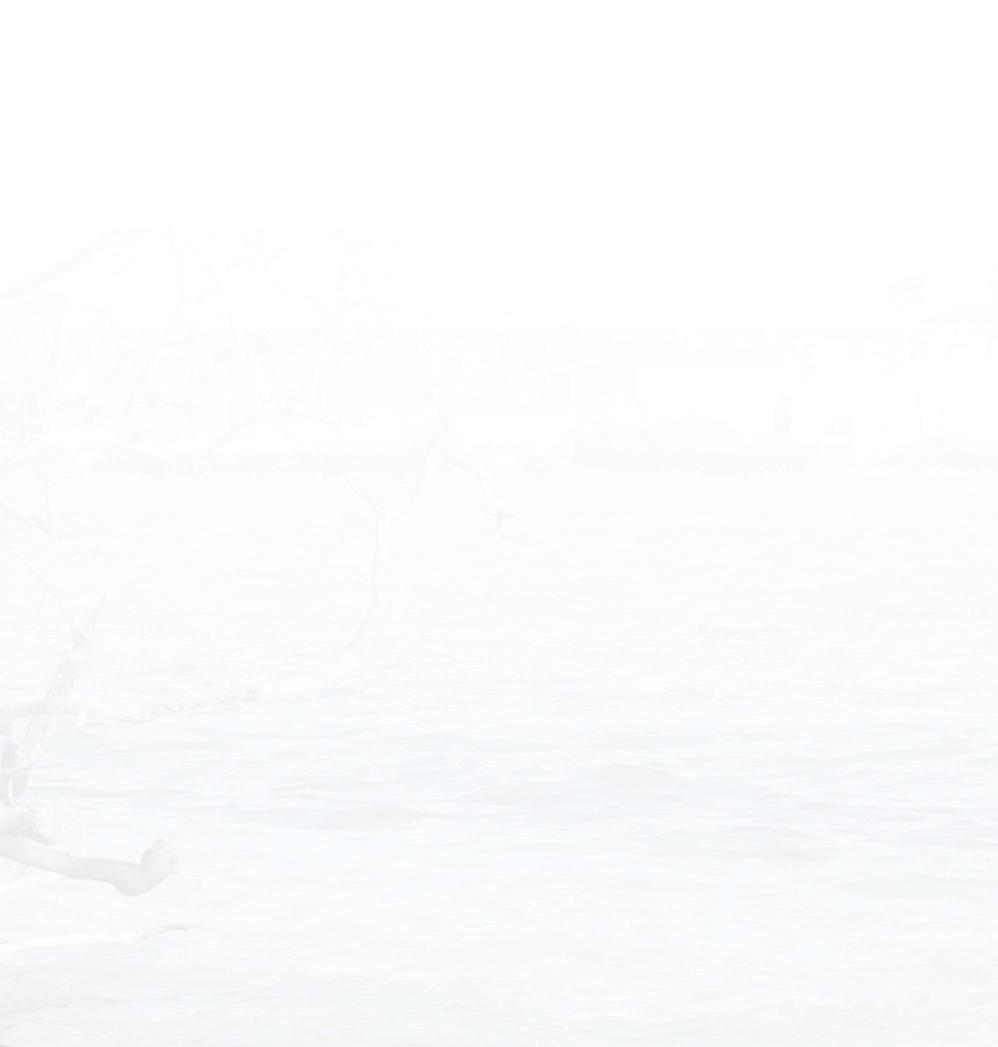
Principle 7: “The ocean is largely unexplored.”
a. The ocean is the last and largest unexplored place on Earth—less than 5% of it has been explored. This is the great fron er for the next genera on’s explorers and researchers, where they will find great opportuni es for inquiry and inves ga on.
b. Understanding the ocean is more than a ma er of curiosity. Explora on, inquiry and study are required to be er understand ocean systems and processes.
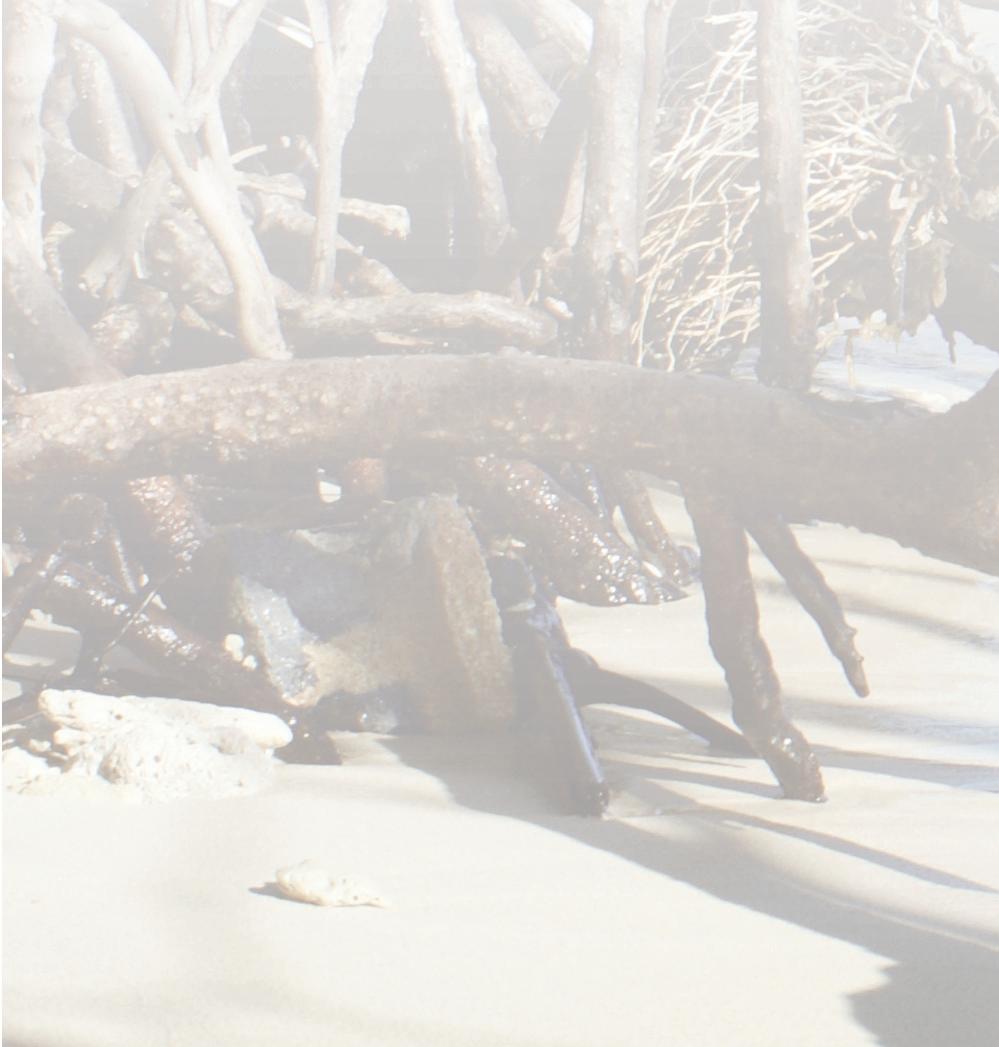
c. Over the last 40 years, use of ocean resources has increased significantly, therefore the future sustainability of ocean resources depends on our understanding of those resources and their poten al and limita ons.
d. New technologies, sensors and tools are expanding our ability to explore the ocean. Ocean scien sts are relying more and more on satellites, dri ers, buoys, subsea observatories and unmanned submersibles.
e. Use of mathema cal models is now an essen al part of ocean sciences. Models help us understand the complexity of the ocean and of its interac on with Earth’s climate. They process observa ons and help describe the interac ons among systems.
f. Ocean explora on is truly interdisciplinary. It requires close collabora on among biologists, chemists, climatologists, computer programmers, engineers, geologists, meteorologists, and physicists, and new ways of thinking.
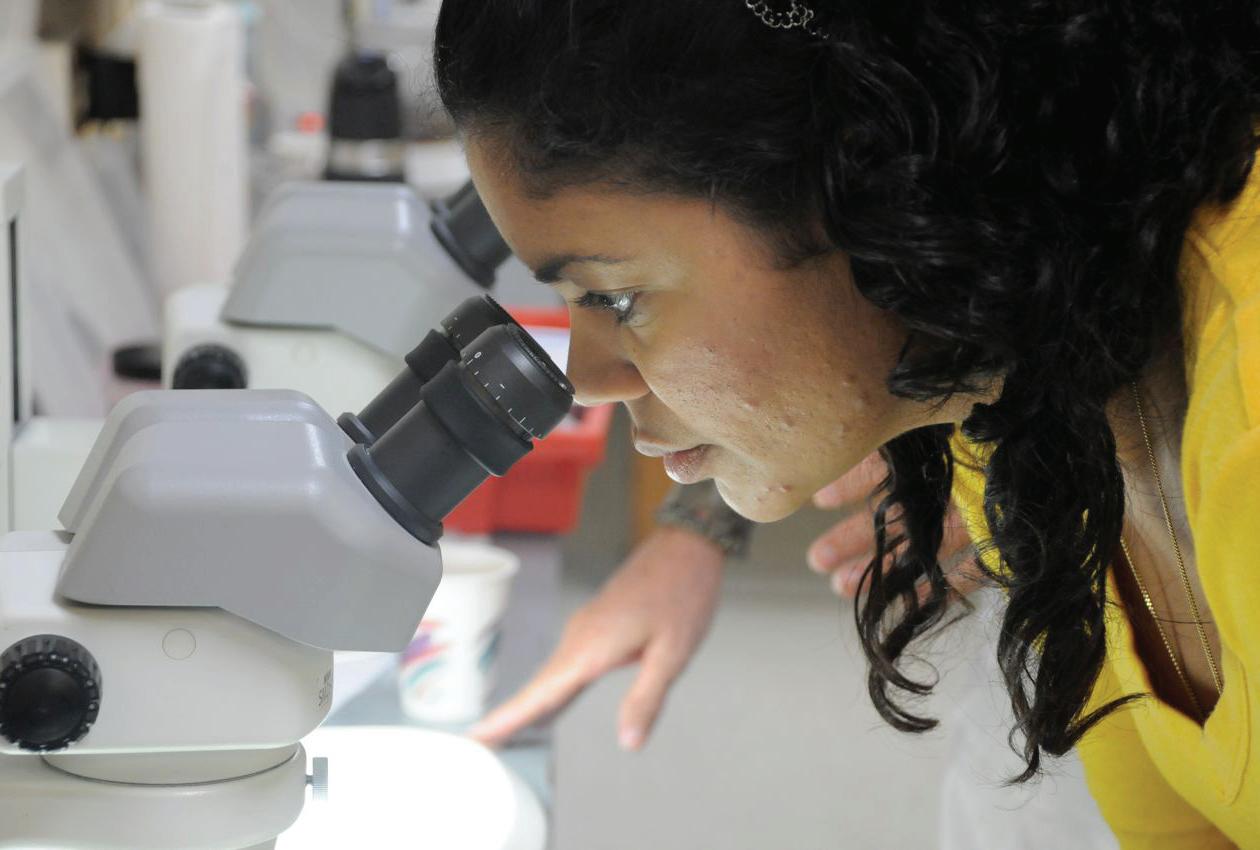
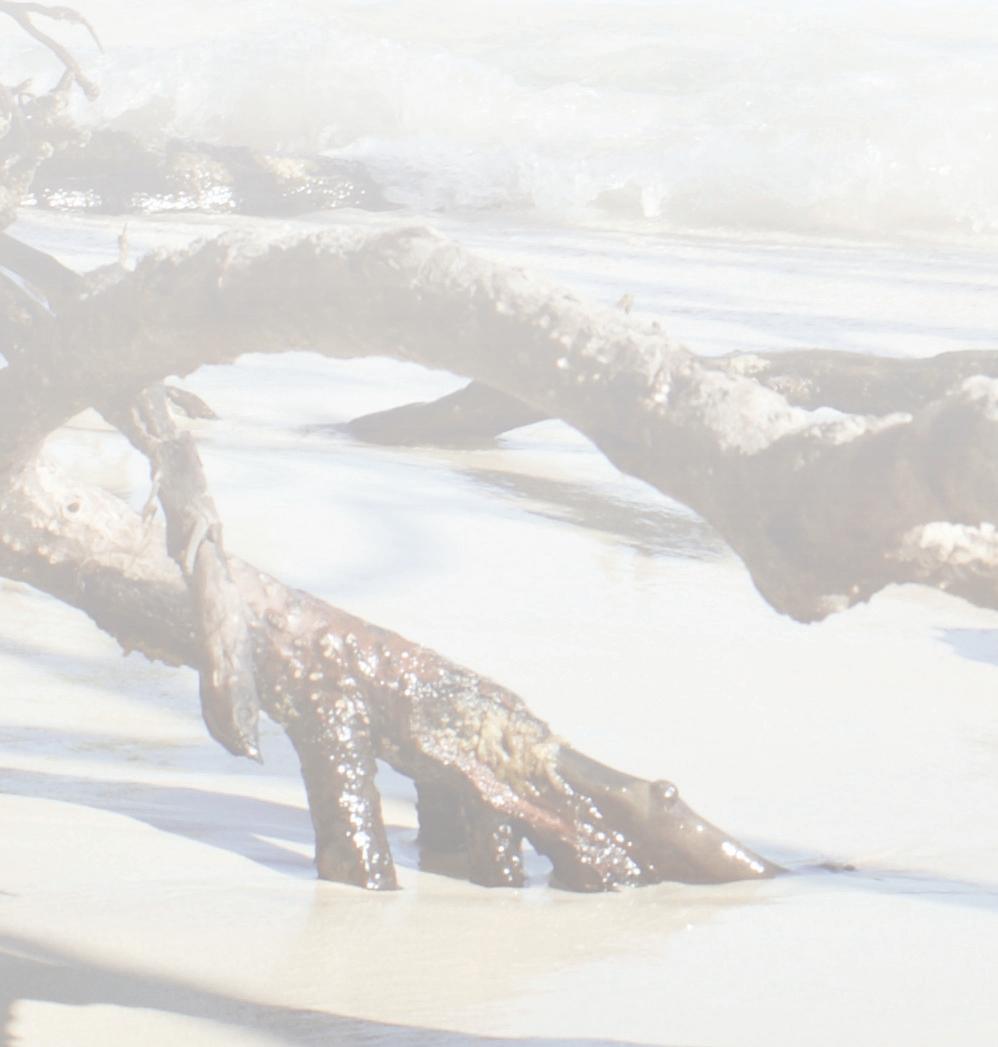

Content standards and grade expecta ons
Earth and space sciences
Standard: Conserva on and change

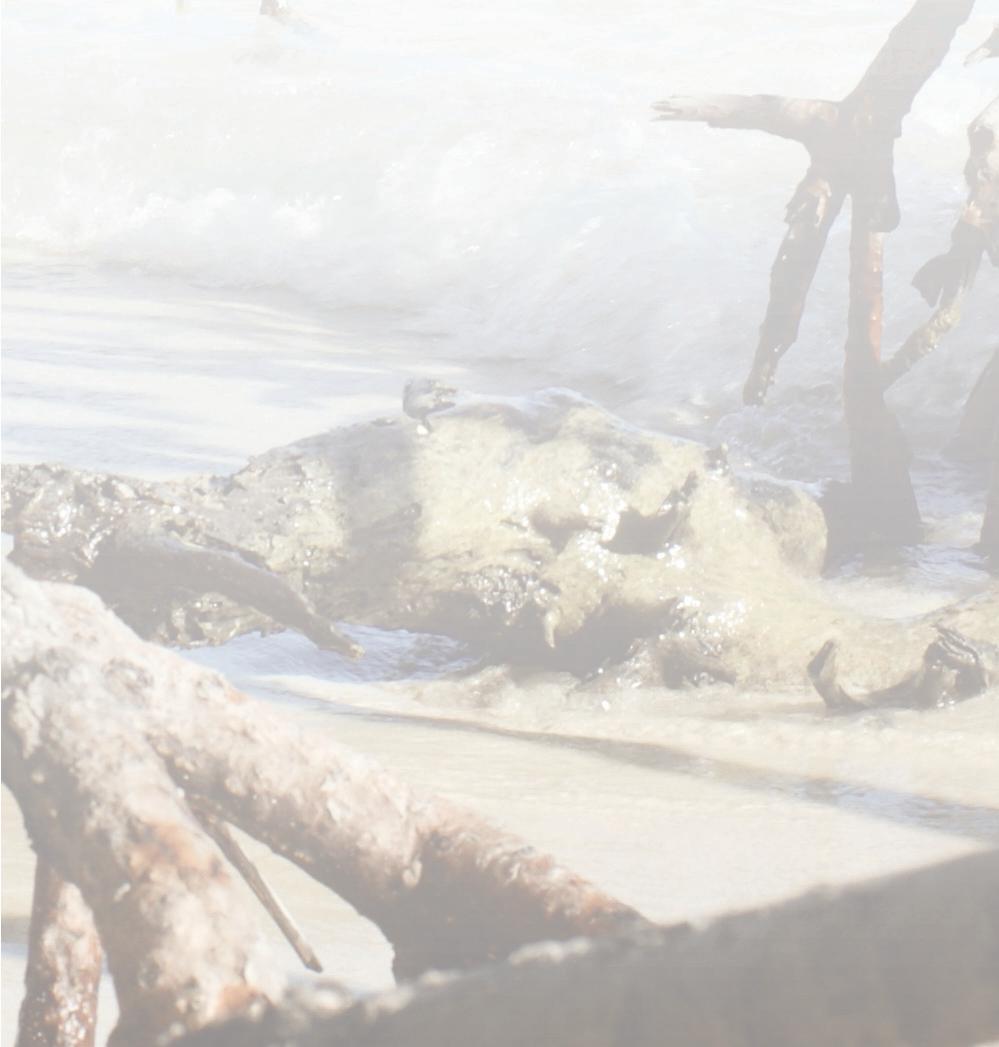
Expecta ons and indicators:
Planet Earth and human ac vity
EI.T.CT3.CC.1 Applies scien fic principles and designs a monitoring method aimed at minimizing human impact on the environment.
Biology
Standard: Subject structure and levels of organiza on
Expecta ons and indicators:
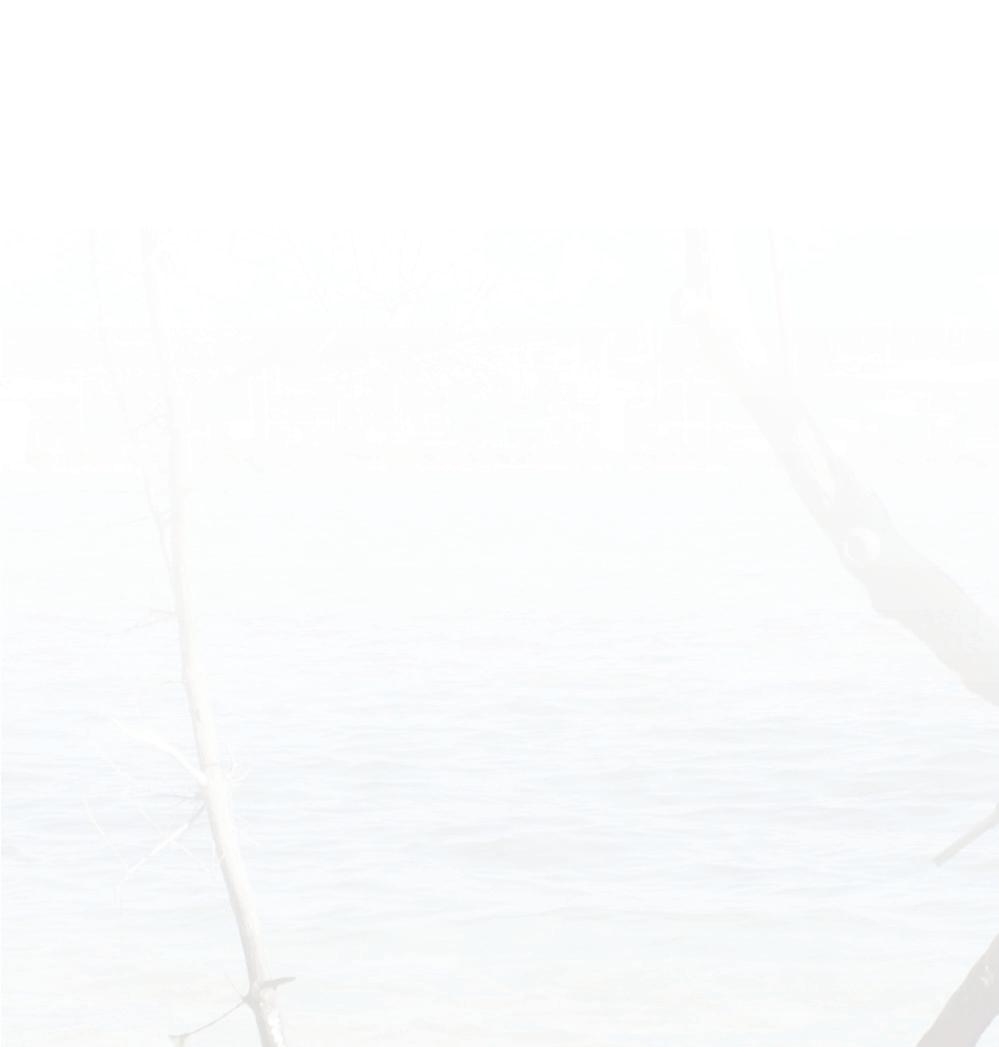
Ecosystems: Interac ons, energy and dynamics
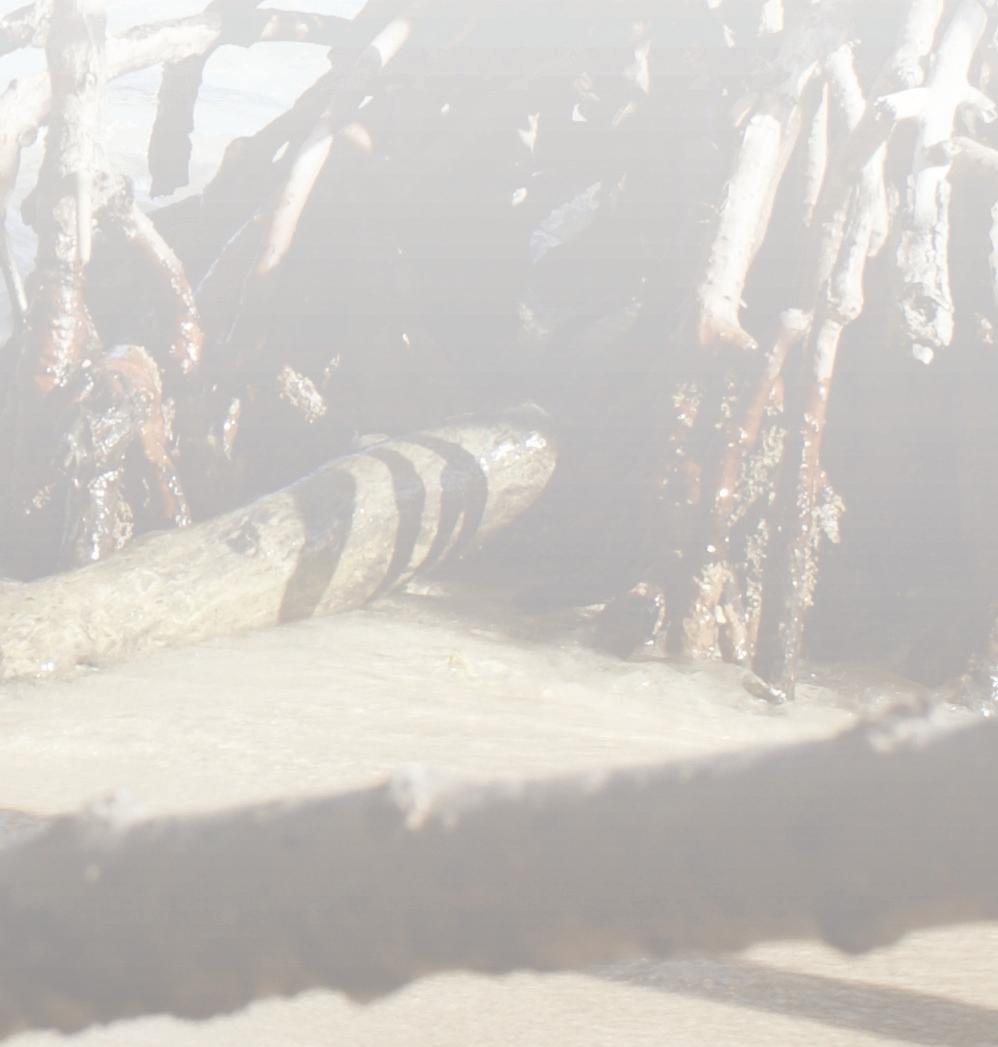

ES.B.CB2.EM.1 Uses mathema cal or technological representa ons to support explana ons about the factors affec ng ecosystems’ carrying capacity at different scales.
ES.B.CB2.EM.2 Uses mathema cal representa ons to support and review evidence-based explana ons regarding the factors affec ng ecosystem biodiversity and popula ons at different scales.

Mangrove Forests
Laboratory Activity Sheet: Monitoring the Mangrove Forest
Part I. Answer the following questions in complete sentences. Then, prepare a hypothesis using those answers as guidance.
1.Do you believe the area (m2) covered by mangrove forest on the coast changes frequently?
2. If it changes, how do you think this ecosystem’s time (does it grow, shrink, or remain the same)?
3. Why is this ecosystem changing time? What are the factors causing these changes?
Hypothesis ______________________________________________________________________________ ______________________________________________________________________________ ______________________________________________________________________________
Part II. Carefully observe each 1936, 2004 and 2009 se them to determine how the mangrove forest coverage has changed, if it has changed at all. Identify the areas featuring mangrove forest, the areas featuring developments (houses, hotels, roads, etc.) and the (clean areas with exposed terrain). Calculate the area covered by each category. Write the required information in the spaces provided below each photograph.

You can calculate the area by counting the squares overlying the image. Each square represents 5 square meters. You can use pencils or fine-tipped markers to trace and









1.Remember that the mangrove forests lie close to the water, and the squares on the water don’t count.
2.The calculations you’ll perform will be approximations of the covered area for each category. There will always be a margin of error. The important thing to keep in mind is to recognize the changes in the mangrove forest ecosystems and surrounding areas.
La Parguera, Lajas 1936









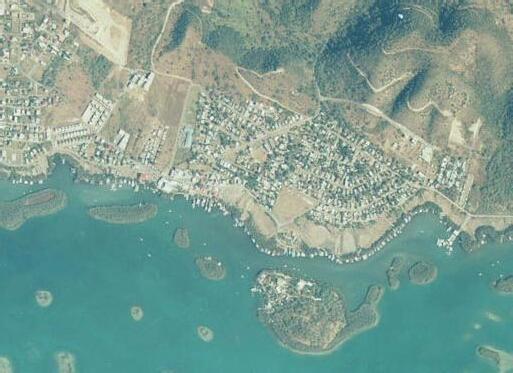
Part III. your data in the following table and calculate the change percentage for each year and for each category. Then graph your results using the information compiled about the . Use a bar graph for this.
*Note: Use the following equation to calculate the change percentage:









– Aknwn * 100 = Percentage of change in area

Donde:
Acalc - is the value for an area for which you will calculate the change percentage; in this case, it will always be the value corresponding to the most recent year to which you’re comparing data. For instance, if you’re comparing data from 1936 to data from 2004, Acalc will be the value from 2004.
Aknwn – is the value for the area for which the change percentage is known; in this case, it will always correspond to the value in the older year to which you’re comparing data. For instance, if you’re comparing data from 1936 to data from 2004, Aknwn will be the value from 1936.
Depending on the result’s sign, you will know the area grew or shrank between the years compared. If the result’s sign is negative, it means the area shrank; if it is positive, then the area grew.
Use this area your calculations.
a bar graph to compare the changes in area for the three categories you (mangroves, development and ). Remember to include all parts in the graph.
Part IV. Carefully read the following questions, and answer them in sentences.
1.Which was the year with the most mangrove forest coverage? Which year had the least mangrove forest coverage?
2.Which year featured the most developed areas? Which featured the least?
3. Which year showed the most area left ? Which year showed the least?
8. Is there any observable increase in the area covered by the mangrove forest? Do you think conservation efforts?
9.What conservation measures would you recommend to protect and restore this valuable ecosystem?
Conclusion: Carefully observe the totality of the photographs. Using complete sentences, write a paragraph the conclusions you reached after performing this laboratory activity. Remember to include the answers you found to the hypothesis you established at the beginning of the activity. Finally, write your recommendations for preserving this ecosystem

Name: ___________________________________ Date: ________________________
Section: __________ Class: ________________________
Topic: ___________________________________ Prof.: _________________________
Evaluation Criteria 3 2 1 0
1. Answers all laboratory questions in a clear, succinct manner, in complete sentences and without grammar errors.
2. Writes a coherent hypothesis, using the knowledge gained, and can explain said hypothesis.
3. Correctly performs the unit conversions needed to make the measurements required in the laboratory.
4. Performs the required measurements (obtains data).
5. Correctly calculates the area of mangroves forests, coastal development, and general purpose (undeveloped) terrains. Presents all the corresponding procedures and calculations. Uses the appropriate measurement units.
6. Graphs the data and identifies patterns.
7. Effectively analyzes the results and describes behavior patterns.
8. Makes predictions based on result analysis.
9. Writes accurate and objective conclusions based on the observations, calculations and analysis performed.
10. Determines if the hypothesis proposed at the beginning was supported by the data.
11. Effectively coordinates when working in a team. Shows responsibility and engagement with the task and teammates.
12. Submits a neat, organized laboratory report at the specified time.
SUB-TOTAL
TOTAL
Professor’s signature: ____________________
Student signature: ____________________

Time: 1 period
Teaching strategy: ECA
Phases: conceptualiza on and applica on
Teaching method: demonstra ve, inquiry-based, ac on or ac vity
Teaching technique: Role playing, forum, homework
Assessment technique: open ques ons, par ally-filled outline, concrete poem
Integra on with other subjects: Biology, Ecology
Materials:
• Mangroves - Teacher’s Educa onal Guide
• Mangrove forests PowerPoint presenta on
• Par ally filled outline
• Sheet with reading ‘Naturally Resilient Communi es - Solu on: Mangroves’
Depth knowledge levels:
Level I: Memory thinking
Level II: Process thinking
Level III: Strategic thinking
Objec ves:
A er studying about the importance of mangrove forests, the student will be able to:
• iden fy the factors which make mangrove forests important. (procedural)
• correctly explain these factors, and the benefits obtained from this ecosystem. (procedural)
• value the importance of mangrove forests to other marine ecosystems and the organisms around it. (a tudinal)

• share informa on with their peers. (a tudinal)

1. Gree ngs
2. Administra ve business – roll call, etc. (performed internally)
1. Reflec on: “Nature does nothing in vain.” Aristotle
2. The teacher will place the chairs in an oblong shape so that the class can complete two ac vi es.
3. As a way to review, students will perform a role playing exercise in the middle of the classroom. The game will involve all concepts studied during the previous classes about the connec vity between mangrove forests and other marine ecosystems (coral reefs and seagrass beds). Students will be asked to voluntarily play various roles. Some students will be the mangroves, others will be the seagrass, and others will be the corals. Each group will sit in a row in the order they are found: mangroves along the shore, then seagrass beds, and corals farthest from land. Then other students will be asked to represent a large run-off stream moving from the land to the sea.
There will be three scenes: the first will feature mangrove forests and the third will show the result of the impact. In the first scene, when the run-off stream reaches the shore, most of the sediment and other materials dragged by it will get stuck with the mangroves (stumbling through them). This will filter all this material and very li le of it will reach the seagrass beds and the reef, which will keep the water for these two sunlight-dependent ecosystems clear. Seagrass beds need sunlight to perform photosynthesis and corals need clear waters and plenty of sunlight as well.

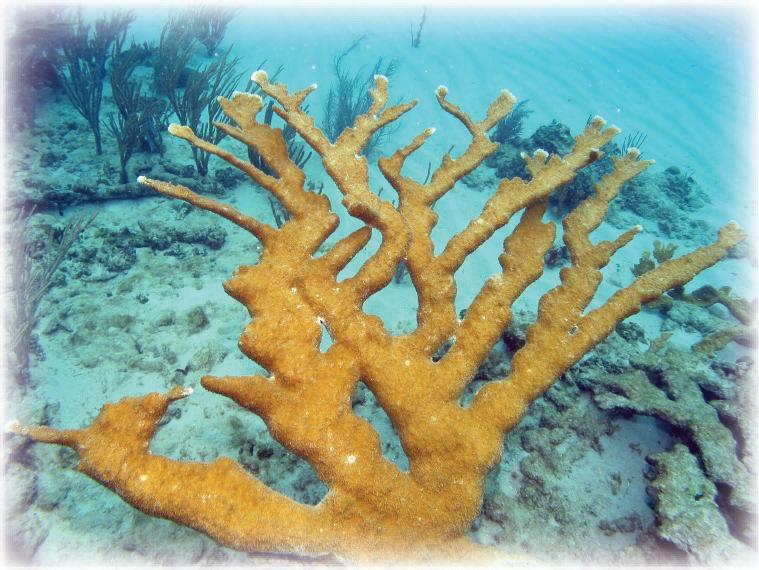
In the second scene, the developer comes in remove the mangroves. The “developer” will remove the mangroves by moving them from their row (the shoreline) to the side of the classroom. Ask students to come up with a hypothesis about what effect this will have. In the third scene, the run-off stream comes in, but this me, there are no mangroves to filter it. This lets all the sediment and debris directly impact the seagrass beds and the corals. In this manner, the ecosystems will not survive because of the lack of sunlight.

Students will analyze the importance of mangrove forests.
Run-off –The draining away of water (or substances carried in it) from the surface of an area of land, a building or structure, etc. (Oxford Living Dic onaries, 2016)
That part of the precipita on, snow melt, or irriga on water that appears in uncontrolled (not regulated by a dam upstream) surface streams, rivers, drains or sewers. (US Geological Survey, 2016).
1. The teacher will hand out a reading about the importance of mangrove forests. This reading features many other factors which make the mangrove forests a very valuable ecosystem. Let the students have several minutes to read in silence.
2. The students will also be asked to take out the informa on they gathered about the importance of mangrove forests as part of a previous homework assignment. The teacher will moderate a forum with the students and discuss the topic. The teacher will guide the discussion by posing ques ons and interjec ng, as needed, in the students’ conversa on. The students on the other hand, will ask ques ons, comments, reply their classmates ques ons, talk about their experiences, etc. The important thing is for everyone to par cipate. Some of the ques ons the forum moderator can ask are:
What happened during the role-playing game?
What happened with the run-off when there were no mangroves to hold it back?
What elements are carried by run-off?
Sediments
Trash
Nutrients
Fer lizers
How do these run-off materials affect other marine ecosystems?
Turbidity – does not allow sunlight to penetrate and inhibits photosynthesis. Stresses corals because of the zooxanthellae’s inability to perform photosynthesis.
Provokes physical harm on the coral polyps as debris scrapes against them. Causes asphyxia.
What is the importance of the mangrove forests?
At a local level, what do you think is the mangrove forest’s main importance? For Puerto Rico? For your town?
At a global level, what do you think is the mangrove forest’s main importance?
Note: The teacher should address the conversa on in a way that makes it relevant to the students, and the geographical zone they inhabit.
1. To close the session and sum up the salient points, the teacher will play the music file Soy el Manglar. Students may be allowed to dance or sing along if they wish. This song briefly sums up the important factors and benefits afforded by the mangrove forest. Students will finish filling out the par ally-filled outline using this informa on.
2. Ques ons, uncertain es and comments will be addressed.
Homework:
1. Students will be asked to write a concrete poem with the word Mangrove. This poem should reflect their meaning and importance.
2. They must also look for informa on about the factors which nega vely affect the mangrove forest and the ways in which this ecosystem may be preserved.
Praxis reflec on:
The reflec on will be performed by the teacher a er class is concluded.
Reasonable accommoda on:
Reasonable accommoda on will be offered to all students who need it. Students with physical or cogni ve difficul es will be offered reasonable me in which to do their tasks, tutoring during office hours and all the necessary opportuni es, according to their par cular cases.
Ocean literacy: Essen al principles and fundamental concepts
Principle 5: “The ocean supports a great diversity of life and ecosystems.”
e. The ocean is three-dimensional, offering vast living space and diverse habitats from the surface through the water column to the seafloor. Most of the living space on Earth is in the ocean.

i. Estuaries provide important and produc ve nursery areas for many marine and aqua c species.

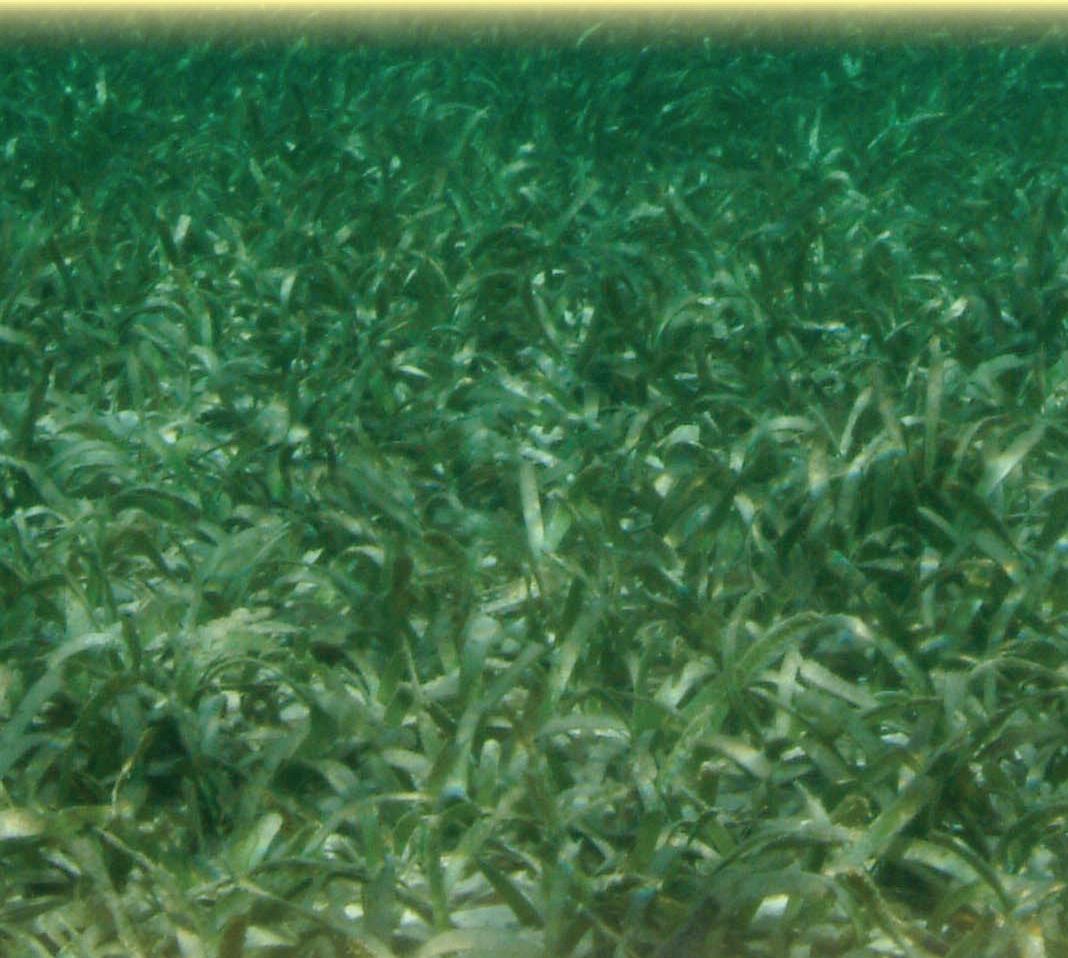
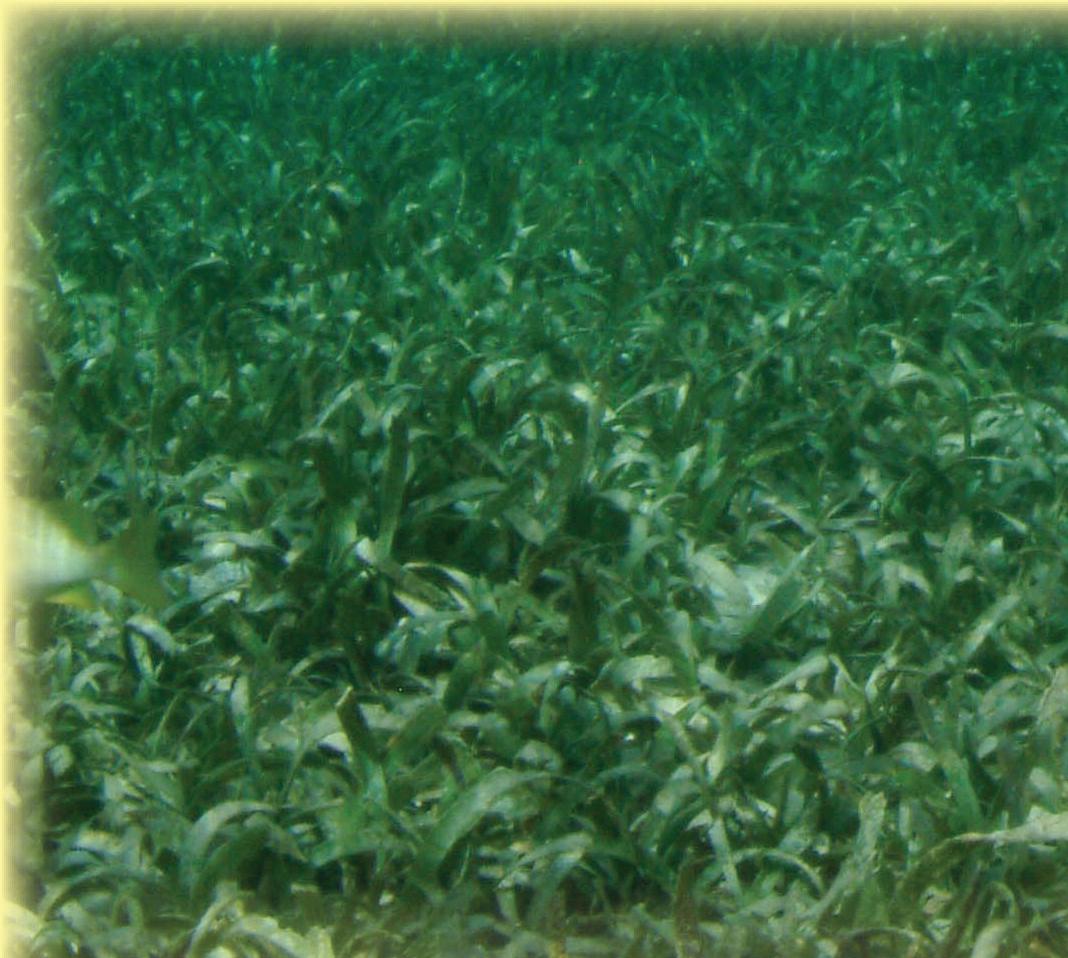
Principle 6: “The ocean and humans are inextricably interconnected.”
a. The ocean affects every human life. It supplies freshwater (most rain comes from the ocean) and nearly all Earth’s oxygen. It moderates the Earth’s climate, influences our weather, and affects human health.
b. From the ocean we get foods, medicines, and mineral and energy resources. In addi on, it provides jobs, supports our na on’s economy, serves as a highway for transporta on of goods and people, and plays a role in na onal security.
c. The ocean is a source of inspira on, recrea on, rejuvena on and discovery. It is also an important element in the heritage of many cultures.
d. Much of the world’s popula on lives in coastal areas.
Taken from the Ocean Literacy Network
Environmental sciences
Standard: Interac ons and energy
Expecta ons and indicators:
Earth systems
ES.A.CT2.IE.11 Discusses the importance of aqua c ecosystems for water-dependent species and proposes alterna ves for its preserva on.
Expecta ons and indicators:
Earth and human ac vity
ES.A.CT3.IE.3 Describes the ecosystem’s value and argues about the importance of its conserva on and protec on, and the conserva on and protec on of their organisms, specifically including Puerto Rico’s ecosystems and organisms.
References:
Oxford Living Dic onaries. Run-off. Consulted on June 6, 2017, through h ps://en.oxforddic onaries. com/
US Geological Survey. Run-off. Consulted on June 6, 2017, through h ps://water.usgs.gov/edu/runoff html
San Juan Bay Estuary Program. Los beneficios de los mangles. Consulted on June 6, 2017, through h p://www.estuario.org

Solution:
Mangroves are a type of coastal or estuarine wetland, characterized by the presence of salt adapted trees and shrubs, that grows along the coast in tropical or subtropical latitudes throughout the world. Many mangrove forests can be recognized by their dense tangle of prop roots that make the trees appear to be standing on stilts above the water. These root systems often serve to both support the trees and, in some species, provide a means of getting air to the roots while they are submerged during higher tidal events.
While there are as many as 80 species of mangrove trees globally, only four species – red, black, white, and buttonwood mangroves – are found in the continental United States, mainly in southern Florida with some stretches throughout the Gulf Coast. One of the largest mangrove forests in the world is found on the southwest coast of Florida.

Mangroves provide an important habitat to a wide array of marine and terrestrial species. The quieter, more protected waters found among mangrove roots provide breeding, foraging, and spawning areas for commercially and recreationally
Mangroves are among the most effective natural forms of coastal protection found in the world. Their complex root systems and physical structure are able to absorb wave energy and reduce wave heights from storm surge. Studies suggest wave height can be reduced by 13 to 66 percent over a 100-meter-wide mangrove belt, while wave height can be reduced by 50 to 100 percent over a 500-meter-wide mangrove belt. The vegetation found in a mangrove also reduces wind speeds over the water surface, lessening the likelihood of waves increasing in height within mangrove areas. Wave height reduction within a mangrove forest depends on the width of the forest, mangrove tree morphology, water depth, topography, and wave height.
The same physical structure that reduces wave energy also serves to settle sediment out of the water column. The combination of lessened wave energy and increased sedimentation serves to reduce coastal erosion and, in some cases, can even allow mangroves to keep pace with sea level rise through accumulation of sediment and vertical growth over time, providing ongoing protection even as sea levels increase.
Hazards Addressed
Coastal Erosion
Coastal Flooding
Regional Considerations
Southeast
Gulf of Mexico
Community Type
Urban
Suburban
Rural Scale
Community
Coastal development is the single greatest threat to mangroves in the United States. In addition to direct impacts to mangrove forests from urbanizing coastal development also brings with it change to the tidal cycle through human driven water management practices, such as mosquito ditching and dredging of coastal waterways.
and to the tidal regime have resulted in increased salinity and impacts to the overall health of mangrove forests in the United States. The combination of these practices, as well as shoreline hardening practices and other coastal management efforts, have resulted in considerable losses of mangrove swamps.
on mangroves. Increased sea levels have the potential to drown mangrove forests when there is not enough sediment available for mangroves to grow at the same pace vertically. Increased water temperatures are also having an impact on mangroves, actually resulting in the apparent beginnings of northward migration of mangrove species as warmer waters are creating new areas where mangroves may survive.
In addition to reducing the impacts of storm events and and bird species, creating opportunities for recreational activities such as kayaking and wildlife viewing. In Florida produce as much as $1 billion in annual value.
Mangroves also play an important role in carbon
capable of effectively trapping carbon in their soils, creating opportunities for much longer term carbon storage than other habitats that store carbon solely in the form of biomass. Additionally, both through accumulation of sediment and the settling out of pollutants, mangroves can perform a vital role in improving coastal water communities but also to seagrasses and coral reefs that may be located just offshore of mangroves.

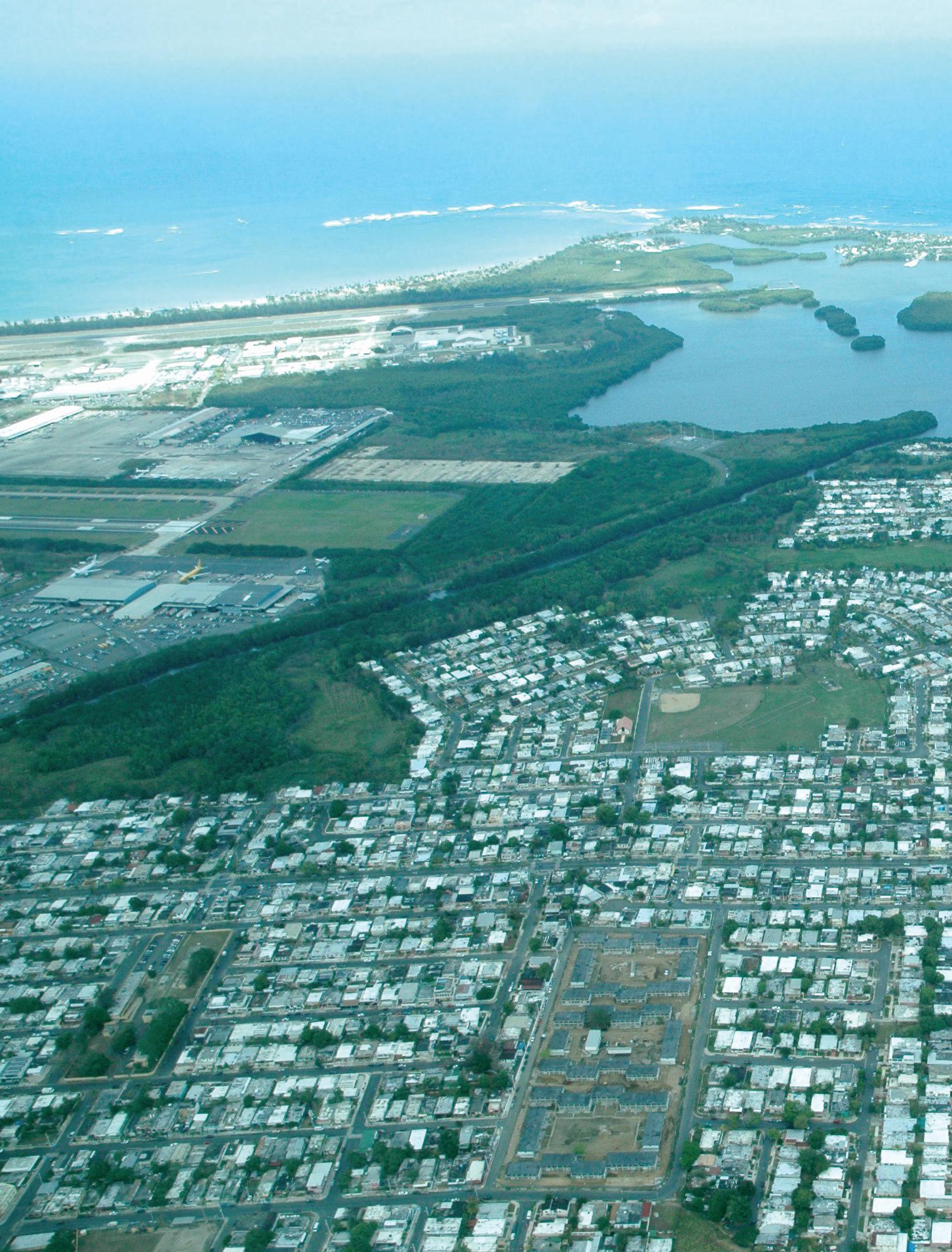
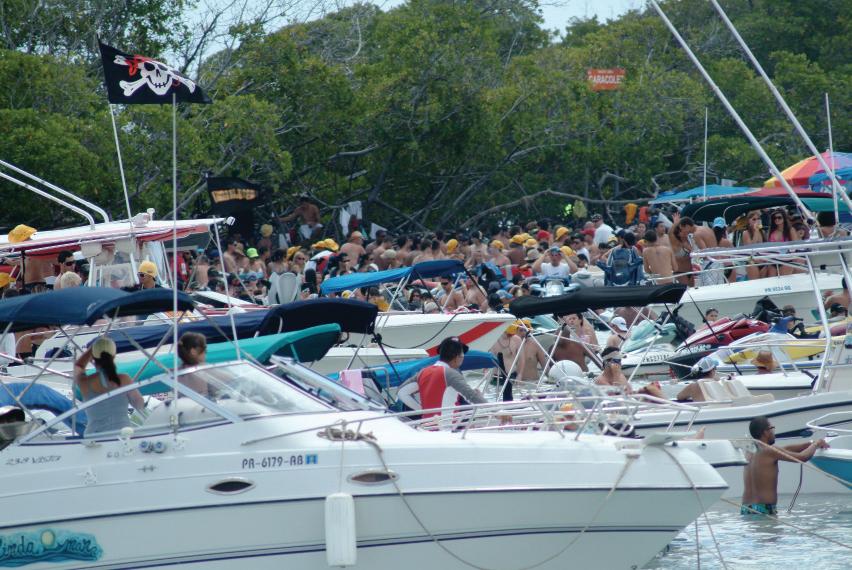
Time: several periods (The teacher will adjust the schedule according to the me and material available).
Teaching strategy: PBL (problem based learning)
Teaching method: exposi onal, demonstra ve, inquiry-based, ac on or ac vity
Teaching technique: coopera ve work, project, pedagogic situa on, field trip
Assessment technique: open ques ons, par ally-filled outline, interviews, reflexive diary
Integra on with other subjects: Biology, Ecology, Spanish, Art (photography and graphic design)
Materials:

• Mangroves - Teacher’s Educa onal Guide
• Mangrove forests PowerPoint presenta on


• Par ally filled outline
• Outline for building the management plan instruc on sheet
• Pedagogic situa on instruc on sheet
• Reflexive diary instruc on sheet
Depth knowledge levels:


Level I: Memory thinking
Level II: Process thinking
Level III: Strategic thinking
Level IV: Extended thinking
Objec ves:
A er studying about disturbances caused to mangrove forests and methods for conserva on for this ecosystem, the student will be able to:
• recognize that human beings are the main element harming the mangrove forest, but at the same me, have the poten al for rescuing it. (conceptual)
• iden fy the possible factors impac ng and altering the mangrove forest ecosystem. (procedural)
• effec vely analyze the disturbances impac ng mangrove forests to be er understand their effect on this resource. (procedural)
• propose effec ve solu ons to preserve and protect this ecosystem. (procedural)

• design a magazine showing and analyzing the environmental problems and solu ons for them. (procedural)
• design a management plan for the sustainable use of the ecosystem. (procedural) This will be used if the teacher chooses the second alterna ve.
• respect the mangrove forest ecosystem. (a tudinal)
• take responsibility for the care and protec on of this ecosystem. (a tudinal)
• share the informa on with their peers. (a tudinal)
1. Gree ngs
2. Administra ve business – roll call, etc. (performed internally)
3. Reflec on: “We have modified our environment so radically that we must now modify ourselves in order to exist in this new environment.” Norbert Wiener (1894-1964) North American mathema cian
4. The teacher will use the Mangrove forests PowerPoint presenta on and review the importance of the mangrove forest. Some of the concrete poems wri en by students in the previous class may also be used.
1. The teacher will split the group into 4 or 5 sub-groups. Each group will receive a pedagogic situa on which students must carefully analyze. Give the students a few minutes so they can read it. From there, they must iden fy the ac ons or behaviors which harm the mangrove forest. Having iden fied them, effec ve solu ons must be formulated to help restore and protect the ecosystem.
2. A erwards, the teacher will hand the students an instruc on sheet detailing how to complete a research project in which the students will become environmental journalists. Each group will select the role each student will play, and the topics for which each student will be responsible. The teacher may suggest topics and themes such as:
Environmental problems threatening this ecosystem’s existence
Economic, social and recrea onal benefits obtained from mangrove forests

Sustainable use of the ecosystem


3. Students must divide the topics amongst themselves and the teacher must allow them some me to organize themselves. The desired result for this project is for students to write a magazine with stories of their own crea on, wri en with help from the teacher. Students must research the mangrove forest closest to their community. They must also perform interviews, take photographs, and complete other components a magazine would usually feature (Sugges ons and explana ons included below). The stories and ar cles can be about any topic, as long as it takes place in the mangrove forest. They may also take any form, such as comics, romance, science fic on, or other genres.
1. Students will report to the teacher on how they divided the work, and each students’ roles and responsibili es.
2. The teacher must explain that the next step is a field trip, which they must all help coordinate.
3. Ques ons, concerns and comments will be addressed.
Homework:
1. Students will be asked to start researching their project.
2. They must have their cameras ready and interview ques ons dra ed.
3. Students will be asked to bring signed permission slips for the field trip. The teacher must perform all the necessary processes, and issue instruc ons for the students.
Praxis reflec on:
The reflec on will be performed by the teacher a er class is concluded.
Reasonable accommoda on:
Reasonable accommoda on will be offered to all students who need it. Students with physical or cogni ve difficul es will be offered reasonable me in which to do their tasks, tutoring during office hours and all the necessary opportuni es, according to their par cular cases.
Second period:
1. Students visit a mangrove forest. It should be as near to their community as possible, so that it becomes relevant for the students.

2. Students should have their cameras and dra ed interview ques ons.
3. Upon reaching the mangrove forest, the teacher can take a few minutes to review the concepts learned during previous class sessions. The teacher may ask students to iden fy different types of mangrove tree by their characteris cs (leaves, roots, flower, seeds) and iden fy the trees’ zona on.
4. Allow students to carefully observe their surroundings and ask them to photograph whatever sparks their interest. The teacher should remind the students to take note of those problems causing the mangrove forest harm. They will record these when they return to the classroom.

5. Students should observe buildings, wastewater discharges, docks, or other structures near the ecosystem. They should also look for signs of erosion, poor farming prac ces, and other ac vi es that may impact the ecosystem.


6. The students can interview resource users, long me residents (they can speak about changes to the beach over the years), and shopkeepers. They can also interview marine biologists (when they return) and get informa on about research and other important facts.
7. Homework: A er returning from the fieldtrip, the students must organize the informa on they gathered and determine if they need to conduct more interviews in-person or by phone to gather addi onal informa on. They should research laws protec ng the resource and check if any person or ins tu ons are making efforts to protect the habitat. They must do this outside the classroom.
Third period:
1. The teacher may integrate this project with the Spanish course, and ask that subject’s teacher to coordinate a wri ng workshop or a class on how to properly write an ar cle.
Fourth period:
1. In the fourth period, the teacher should give the students me to write their ar cles.


2. Students must hand in these ar cles to their teacher to verify and correct them before returning them so students can create their magazine.
3. Homework: Students will use their crea vity and design and present a magazine. They will give it an a rac ve and interes ng name and dra it using any graphic design program, such as Publisher, InDesign or any other program they have access to, including Word. If they don’t have those resources, they may build the magazine manually by cu ng and pas ng images and text.
1. Students will present their magazine. They must share their finished product, explain the topics they decided to emphasize, and why these topics drew their a en on.
2. A discussion must be generated regarding the factors they observed in the mangrove forest that could nega vely affect the ecosystem, and what their proposals are for protec ng and preserving it.
3. At the end of class, the students will receive a reflexive diary instruc on sheet. There, they will write out their feelings and things they learned during the en re process.
Note: The teacher may showcase the magazines in the school library for a short me. This would allow the other students, parents and community to see their work and appreciate the effort the students have made. Then, the magazines may be used as reference material for other students.

Ac vi es:
1. Gree ngs


2. Administra ve business – roll call, etc. (performed internally)


3. Reflec on: “We have modified our environment so radically that we must now modify ourselves in order to exist in this new environment.” Norbert Wiener (1894-1964) North American mathema cian

4. The teacher will use the Mangrove forests PowerPoint presenta on and review the importance of the mangrove forest. Some of the concrete poems wri en by students in the previous class may also be used.
1. The teacher will split the group into 4 or 5 sub-groups. Each group will receive a pedagogic situa on which students must carefully analyze. Give the students a few minutes so they can read it.
2. A erwards, the teacher will hand the students a sheet with instruc ons for wri ng a management plan. This sheet will include an outline that will guide the students while wri ng this plan. Each group will choose which roles each student will play, and which parts of the outline each student will complete.
3. Students will divide the topics amongst themselves, and the teacher should allow them me to organize themselves. To write their plan, the students must research the mangrove forest featured in the pedagogic situa on they received. They must also perform interviews, take photographs, and complete other tasks per nent to their plans.

1. Students will report to the teacher on how they divided the work, and each students’ roles and responsibili es.
2. Ques ons, concerns and comments will be addressed.
Homework:
1. Students will be asked to begin compiling informa on for their project.

2. They should search for photographs on the internet and other sources.
3. Groups will meet and work together outside of class to make phone calls and interviews (a biologist, a planner, etc).
4. They must iden fy laws and regula ons that protect the mangrove and other efforts being made to preserve and restore the ecosystem.
Praxis reflec on:
The reflec on will be performed by the teacher a er class is concluded.
Reasonable accommoda on:
Reasonable accommoda on will be offered to all students who need it. Students with physical or cogni ve difficul es will be offered reasonable me in which to do their tasks, tutoring during office hours and all the necessary opportuni es, according to their par cular cases.
Second period:
1. The teacher may integrate this project with the Spanish course, and ask that subject’s teacher to coordinate a wri ng workshop or a class on how to properly write a management plan.
2. During this period, students will be given me to compose, with the teacher’s help, the sec ons of the management plan they were assigned.
3. Homework: Students will combine their parts of the management plan and publish it in Word.
Last period:
1. Students will present their management plan. They must share the final version, and explain it in a clear, precise way.
2. The students will lead a class discussion about the factors they could iden fy in their situa on which nega vely impacts the ecosystem and what they propose to protect and conserve it.
3. At the end of class, the students will receive a reflexive diary instruc on sheet. There, they will write out their feelings and things they learned during the en re process.
Note: The teacher may showcase the management plans in the school library for a short me. This would allow the other students, parents and community to see their work and appreciate the effort the students have made.
Ocean literacy: Essen al principles and fundamental concepts
Principle 1: “ The Earth has one big ocean with many features.”
g. The ocean is connected to major lakes, watersheds and waterways because all major watersheds on Earth drain to the ocean. Rivers and streams transport nutrients, salts, sediments and pollutants from watersheds to estuaries and to the ocean.
Principle 5: “The ocean supports a great diversity of life and ecosystems.”
e. The ocean is three-dimensional, offering vast living space and diverse habitats from the surface through the water column to the seafloor. Most of the living space on Earth is in the ocean.
i. Estuaries provide important and produc ve nursery areas for many marine and aqua c species.


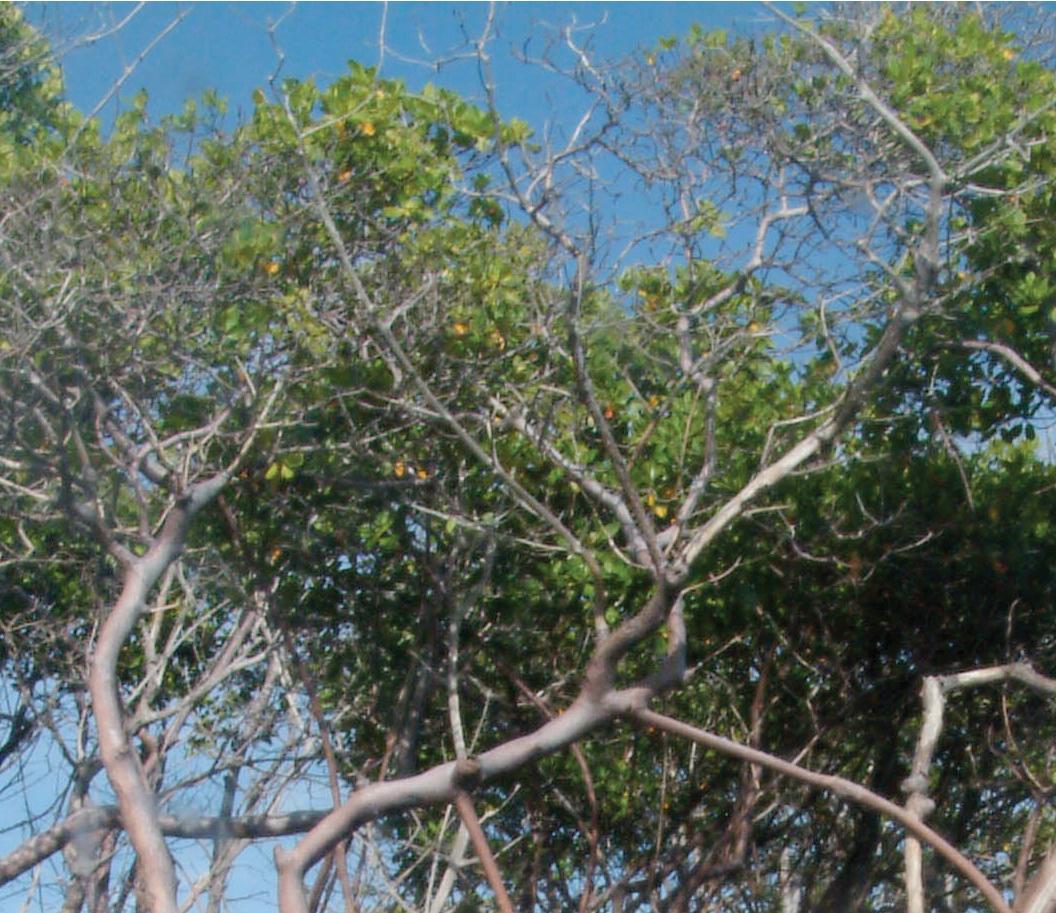
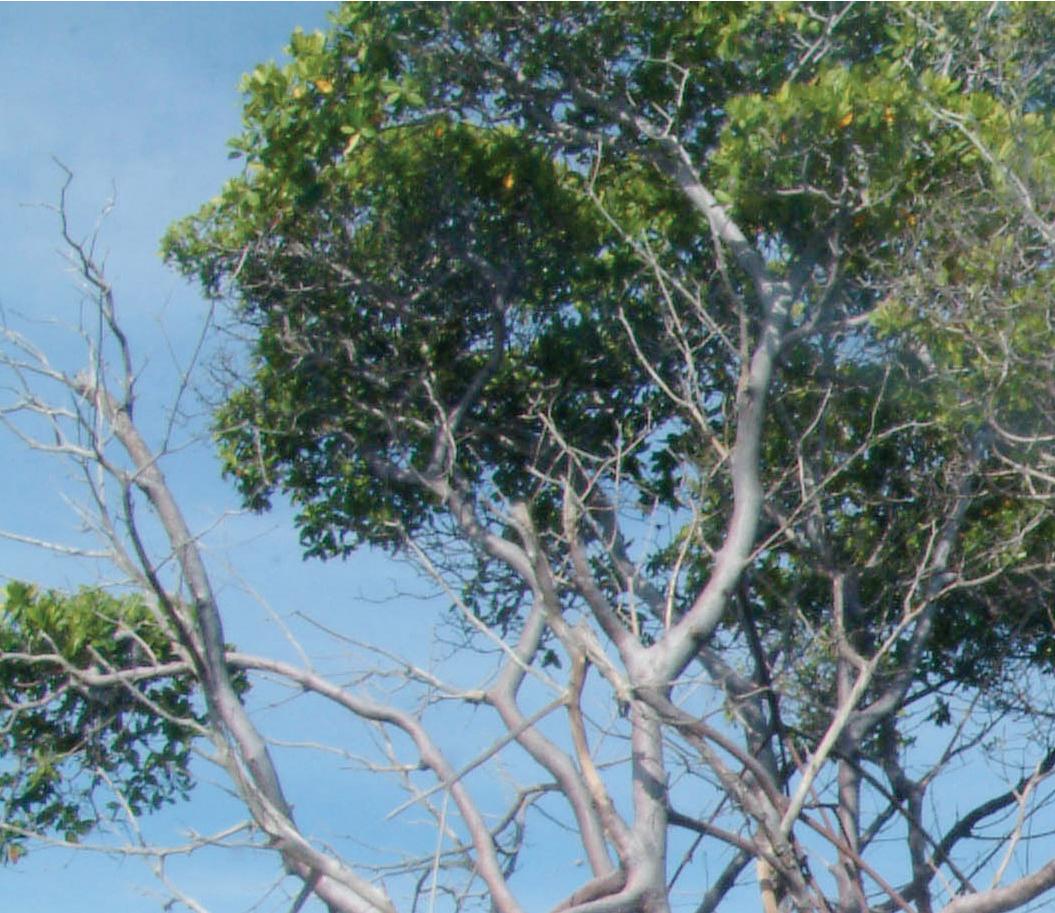
Principle 6: “The ocean and humans are inextricably interconnected.”
a. The ocean affects every human life. It supplies freshwater (most rain comes from the ocean) and nearly all Earth’s oxygen. It moderates the Earth’s climate, influences our weather, and affects human health.
b. From the ocean, we get foods, medicines, and mineral and energy resources. In addi on, it provides jobs, supports our na on’s economy, serves as a highway for transporta on of goods and people, and plays a role in na onal security.
c. The ocean is a source of inspira on, recrea on, rejuvena on and discovery. It is also an important element in the heritage of many cultures.
d. Much of the world’s popula on lives in coastal areas.
Earth and space sciences
Standard: Interac ons and energy
Expecta ons and indicators:
Earth and human ac vity
EI.T.CT3.IE.2 Builds an evidence-supported argument regarding the increase in human popula on and per capita consump on of natural resources, and how these factors impact life on Earth.
Biology
Standard: Conserva on and change
Expecta ons and indicators:
Ecosystems: Interac ons, energy and dynamics
ES.B.CB2.CC.4 Designs, evaluates and refines a solu on for reducing the impacts human ac vity has on the environment and biodiversity.
Expecta ons and indicators:
Biologic Evolu on: Unity and diversity
ES.B.CB4.CC.1 Evaluates the evidence that supports the following statements in regards to climate condi ons resul ng in: (1) increase in the individuals in a species, (2) the emergence of new species, and (3) the ex nc on of other species.
ES.B.CB4.CC.3 Analyzes how human beings have the responsibility of keeping the environment in a state of wellbeing for the con nued survival of its species.
Environmental Sciences
Standard: Interac ons and energy
Expecta ons and indicators:
Earth Systems
ES.A.CT2.IE.11 Discuss the importance of aqua c ecosystems for water-dependent species and proposes alterna ves for its conserva on.
Expecta ons and indicators:
Earth and Human Ac vity
ES.A.CT3.IE.3 Describes the value of these ecosystems and poses arguments regarding the importance of their conserva on and protec on, and that of their organisms, including the specificity of ecosystems and organisms in Puerto Rico.

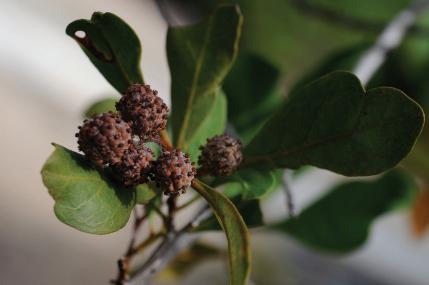


ES.A.CT3.IE.6 Evaluates documents and communica ons about governmental laws and proposals about environmental conserva on.
Standard: Conserva on and change
Expecta ons and indicators:
Earth and Human Ac vity
ES.A.CT3.CC.2 Uses technology to illustrate the rela onships between natural resource management, human popula on sustainability and biodiversity.

ES.A.CT3.CC.4 Uses representa ons to illustrate the rela onships between Earth systems, and how these rela onships are modified by human ac vity.
ES.A.CT3.CC.5 Evaluates design solu ons which compete and develop, manage and use energy and mineral resources based on cost indexes and benefits.
ES.A.CT3.CC.6 Evaluates or proposes a technological solu on that reduces human ac vity impacts on natural systems
ES.A.CT3.CC.8 Posits solu ons, considering the scien fic and economic development of Puerto Rico as they relate to the natural environment’s wellbeing.
ES.A.CT3.CC.9 Proposes alterna ves which help preserve our ecosystems for future genera ons, making sure they include economic development and sustainability.

ES.A.CT3.CC.13 Builds a model showing how balance among environmental systems is affected if it is altered beyond their carrying capacity.
Standard: Design for engineering
Expecta ons and indicators:
Defines and determines engineering problems
ES.A.IT1.IT.3 Proposes effec ve ways to create conscience and promote possible solu ons for environmental problems such as air, soil and water pollu on, waste management, species and resource protec on, and promotes sustainable development.
ES.A.IT1.IT.9 Iden fies innova ve projects that allows sustainable development.

ES.A.IT1.IT.11 Analyzes situa ons and makes individual and group decisions to address environmental problems.


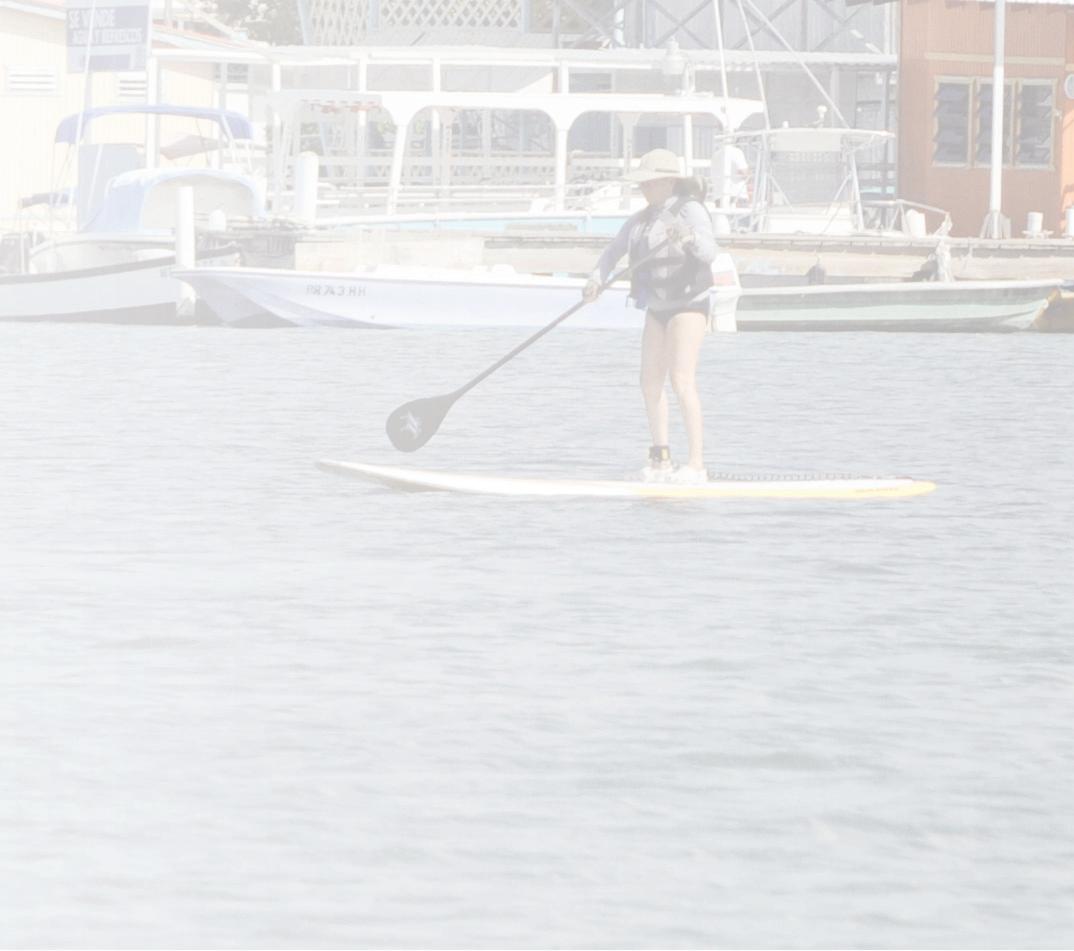

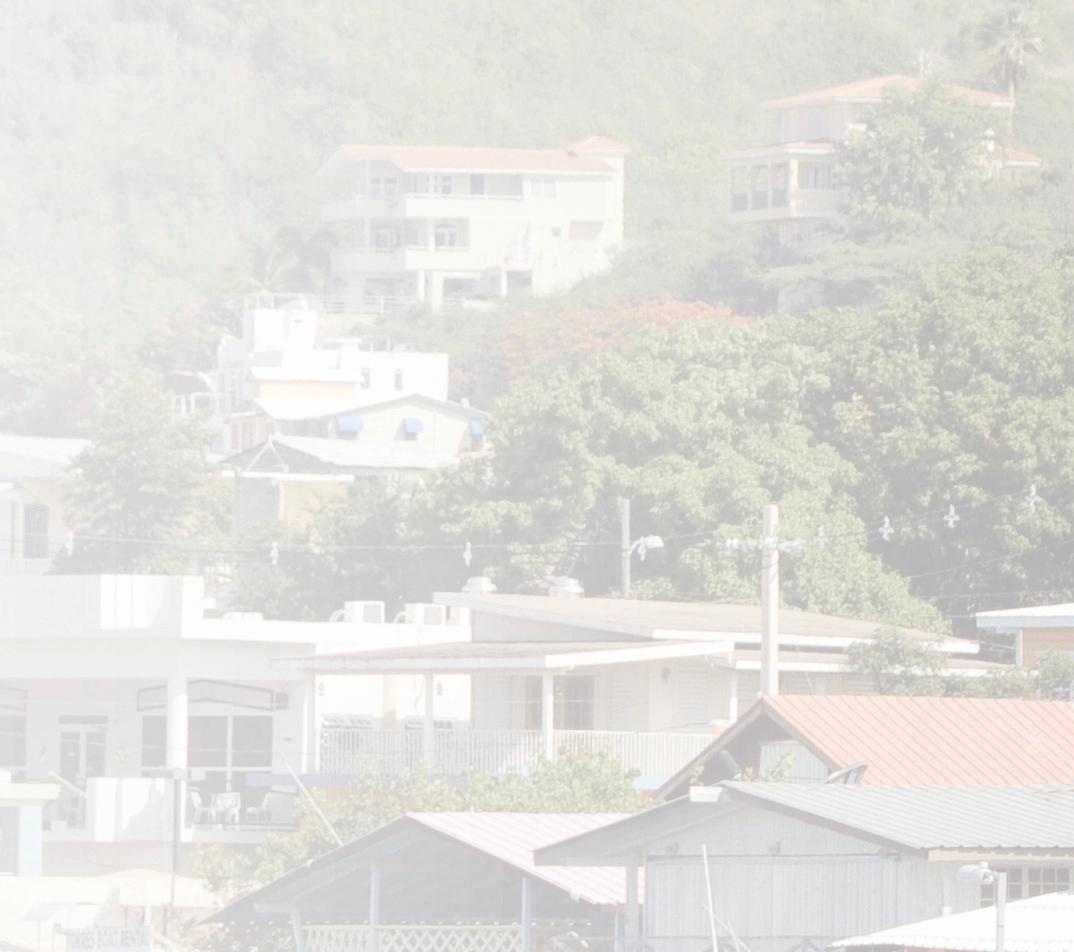


Pedagogic situa ons for comple ng the management plan
Instruc ons: Carefully read the pedagogic situa on presented below and imagine you are a natural resorce management officer who must write a plan to manage the mangrove forest area. You must iden fy the following aspects: the boundaries of the area to be covered by the plan, ac vi es taking place in the area, and any possible adverse impacts to the environment or natural resources in the area from these ac vi es.Then, write a management plan in which you propose effec ve solu ons so that the resource can be sustainably used (used with the least possible impact). A ached to this document, you will find an outline to guide you as you write your plan.
Note: The teacher will hand each sub-group one of the following pedagogic situa ons, along with the outline they will follow.
1. You are fishing along the shores of the Piñones mangrove forest and you no ce a person unloading several kayaks from the back of a pickup truck. You no ce how difficult it is to get the kayaks to the water, since the facili es are very primi ve and not well-kept. At the same me, you no ce several tourists arriving and parking their cars on the salt-flats, almost on top of the mangrove trees. Then, three youths come to help the owner of the kayaks. These are local people who apparently work with the kayak-rental company. As a management officer, you must write a plan to manage the ac vi es in the Piñones mangrove forest area in such a way as to reduce adverse impacts to the area’s resources.
2. You’re walking around the Boquerón village and you no ce a sign about public hearings. They are being conducted because of a proposal for building an all-inclusive hotel in the Boquerón hills, less than a mile away from the mangroves. You read about the project and, according to the developer’s press release, will provide numerous benefits to the area. Some of these benefits include employment for nearly 150 people, an addi onal tourism area, a large casino, revitaliza on of local businesses, and moreover, the hotel builders aim to use ‘green prac ces’ such as installing solar energy panels and farming locally the produce used in the hotel restaurant. However, environmental protec on and social groups are firmly opposed to the project. As a management officer, you must write a plan to manage the uses of the Boqueron mangrove forest resources for this and other development ac vi es in order to minimize adverse impacts to the area’s natural resources.
3. It’s a long weekend and, while driving along the Guayama coast, you no ce several cars pulling boats. You con nue driving, and you observe that along the seaward side of the road, among the mangrove trees, many clandes ne boat ramps have been built. The area is very muddy (the usual soil type in mangrove forests) and many trucks and cars have a difficult me ge ng out of it. The lines to use these ramps are endless, and the visitors are leaving huge amounts of trash.
You talk with one of the users, and hear that the illegal, muddy ramps are being used because the privately-owned ramps charge money for access, or have limited working hours. However, these private ramp areas are clean and have many ameni es, such as bathrooms and parking lots. As a management officer, you must write a plan to manage ac vi es and resource use in the Guayama mangrove forest area in a manner that minimizes adverse impacts to the area’s resources while allowing their use.

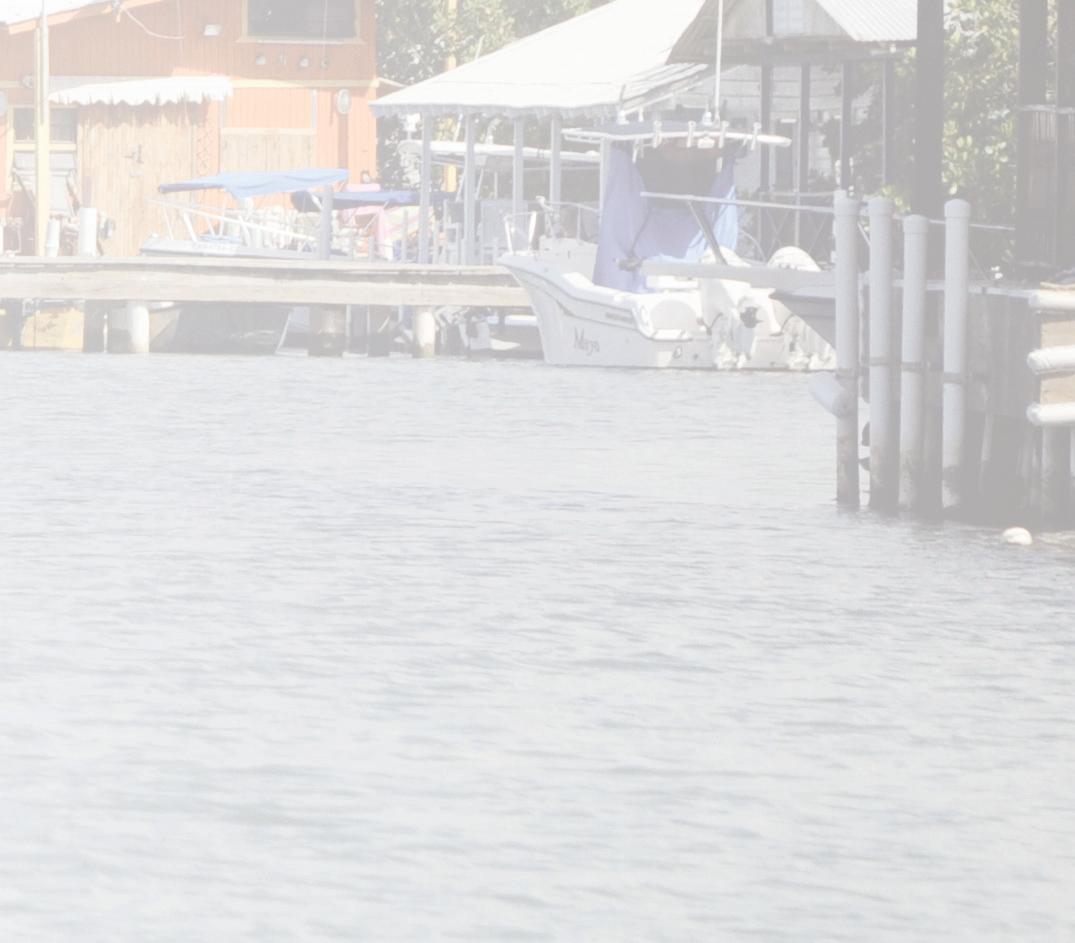

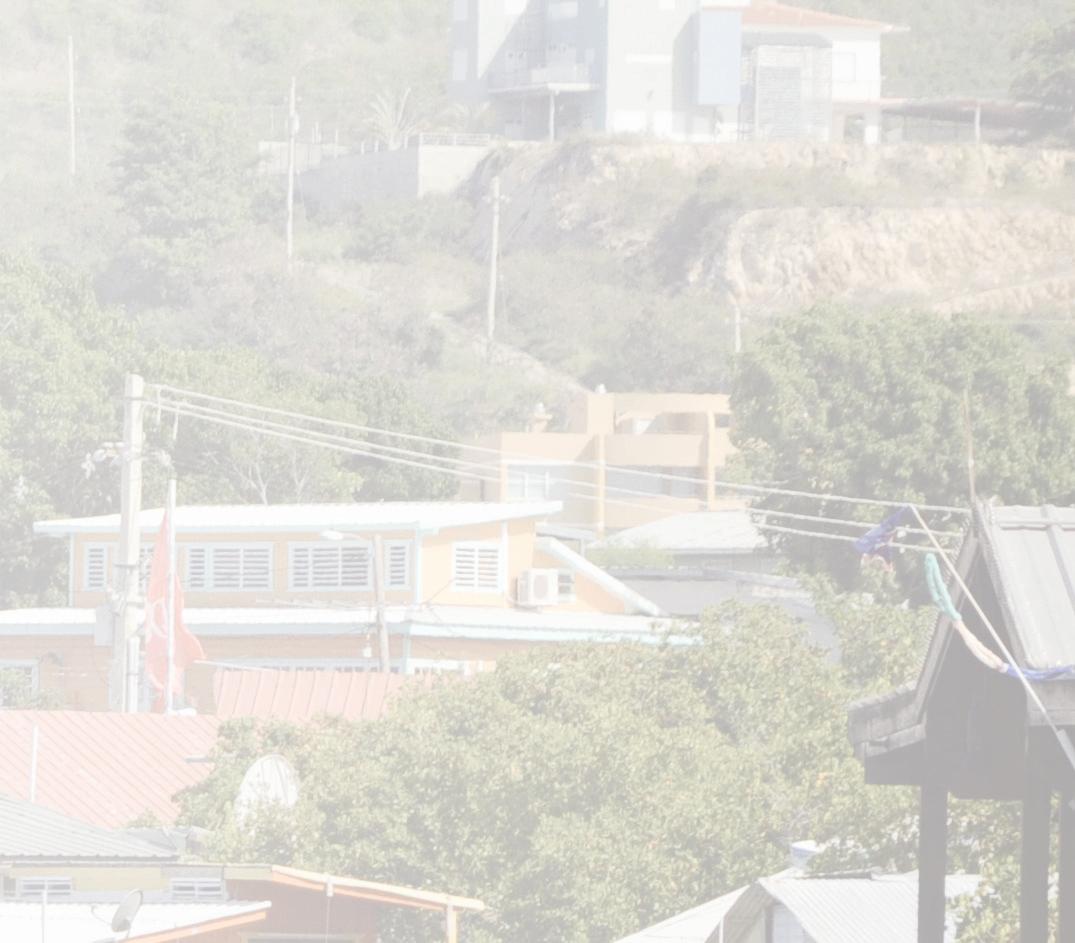

4. You decide to go on a boat ride in the mangrove forest lagoons in La Parguera. You observe the birds, fish and other organisms found there. As you proceed, you no ce the many houses built on the shore and extending out over the water. You ask the tour guide how long have those houses been there, and the guide replies that the houses have been there for over 50 years. You also find out that the owners of these houses are wealthy and influen al people. On the other hand, you hear about a community group which wants the houses removed. They claim that the houses lie within the mari me-terrestrial zone and that this area is within public domain. As a management officer, you must write a plan to manage the ac vi es in the La Parguera mangrove forest area in a manner that minimizes adverse impacts to the area’s resources while allowing their use.

Instruc ons: This document describes what a management plan is, and how to develop one. The document also includes a basic outline of the parts this plan should feature. Carefully read each sec on and write a management plan for the situa on you and your group received. You must research the area and ac vi es that take place there, the situa on or conflicts, relevant laws and regula ons, and then interview experts, residents, and stakeholders (those with an interest in the area). All of this informa on will be required to write an effec ve plan.
Note: It is worth men oning that the management plan featured here has been adapted to the level in which the work is assigned. These documents are usually much more complex and are shaped according to the area under study and the loca on’s specific and unique needs.
a) What is planning?
It is a structured, methodical process used to define goals and objec ves, generate mul ple possible solu ons, and choose the alterna ve best suited to achive those goals and objec ves.
Planning must take into considera on the problems or situa ons so as to develop mechanisms to resolve or avoid them. It is composed of several stages:
• Defines the problem or issue, the goal and the objec ves: This involves literature review (newspapers, professional documents, etc.), interviews and consulta ons with interested sectors. This step is fundamental, since the suggested ac ons and recommenda ons will depend largely on the informa on gathered about the problem or issue.
A ‘problem’ does not necessarily mean a difficulty, but rather in terms related to the topic for which we are planning.
• Alterna ve selec on: In this sec on, students must complete a literature review (professional documents, books, etc.) in order to iden fy and consider all possible alterna ves to address and mi gate the problems. Then, select the most viable (performable) alterna ves for the specific case students received and are working on.
• Implementa on: In this part of the planning process, the proposed ac ons are performed.
CAREFUL! The best alterna ve isn’t always the least expensive, the most expensive, or the easiest alterna ve. The possible ac ons to be implemented do not work the same in all places and contexts. Each case is par cular, so they must all be evaluated carefully and the alterna ves analyzed, taking into account all the variables each case can feature.
Evalua on will take place three (3) mes during the process: in the short term, medium term and long term. This means two (2) years a er implementa on, then five (5), and then ten (10).
• Evalua on: Each planning process ends with an evalua on, to determine if the desired outcomes were accomplished. If they were not, make the necessary adjustments and correc ons.
A Management Plan (MP) is a guide for the conserva on of ecosystems, natural and cultural resources within a defined area. It provides a descrip on of the area and the region, summarizes the informa on from scien fic research, presents the various cri cal situa ons, the problems, the threats, the relevant ac vi es and the conserva on opportuni es. The plans must be created so that they involve par cipa on and collabora on among the various stakeholders (non-governmental organiza ons, government, community groups and ci zens in general). An MP is also a guide for the ac vi es that must be performed on a daily basis, and suggests the ac vi es or ac ons that should take place for the proper management of the area in ques on. This is NOT wri en in stone; it is a flexible instrument which must mold itself to
needs and changes as they occur. The MP must be evaluated and updated so it can adapt be er to emergent situa ons.
Management Plans, as a document, must include a few basic parts, detailed below.
Overview (Must not exceed 300 words. Here, you will offer a general summary of your management plan).

Introduc on


a. Overview – historic overview of the municipality featuring the area under study.
b. Legal founda on or precedent (if available)
c. Public policy (other laws and/or regula ons which apply to the area, if available)
Ra onale –explain why this area needs to be protected.
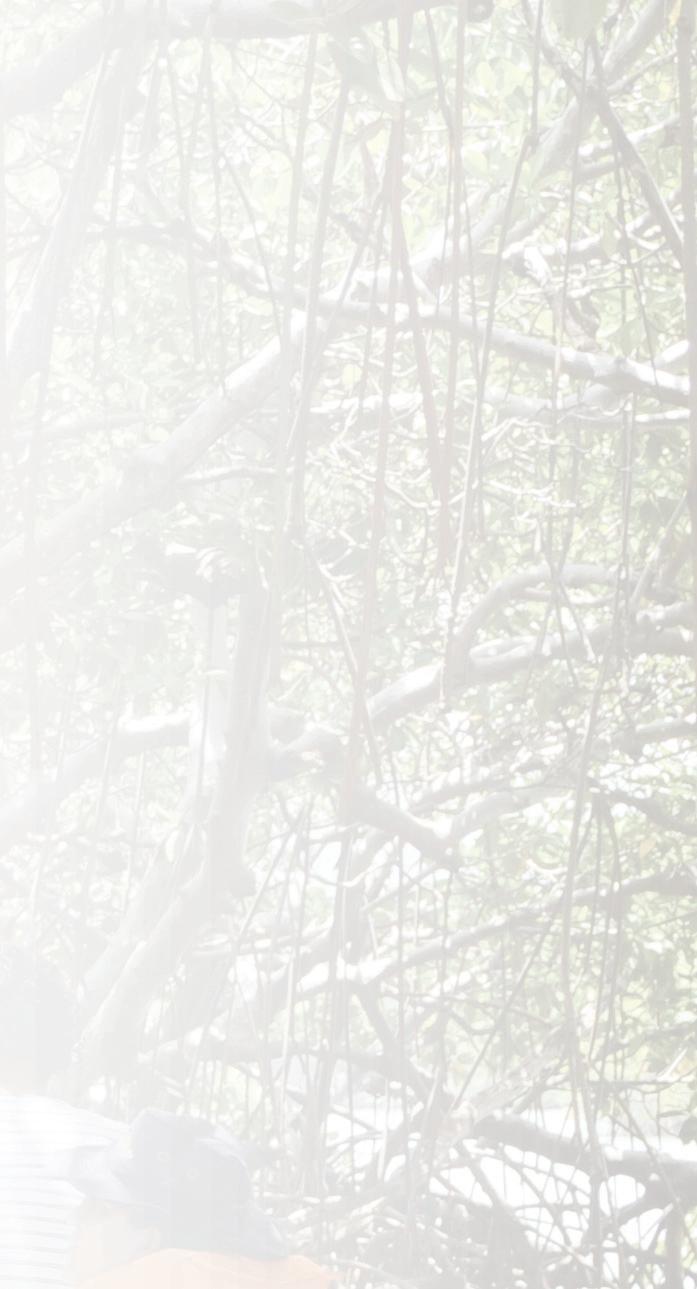
Goal and objec ves
Area descrip on
a. Land loca on and tling (where the site of study is located and who owns it)
b. Acceses – how the site may be reached.
c. Climate and physical characteris cs (soil type, wave pa erns, weather, hydrology, etc.)
d. Flora and fauna (emphasizing the threatened or endangered species and their habitats)
Area a ributes
a. Educa onal
b. Fishing

c. Historic and archeological
d. Recrea onal
e. Research Situa on analysis
a. Actual uses of the area
b. Incompa ble uses of the area
c. Possible conflict between users
d. Problem
a. Biodiversity conserva on

b. Sustainable uses of the resource

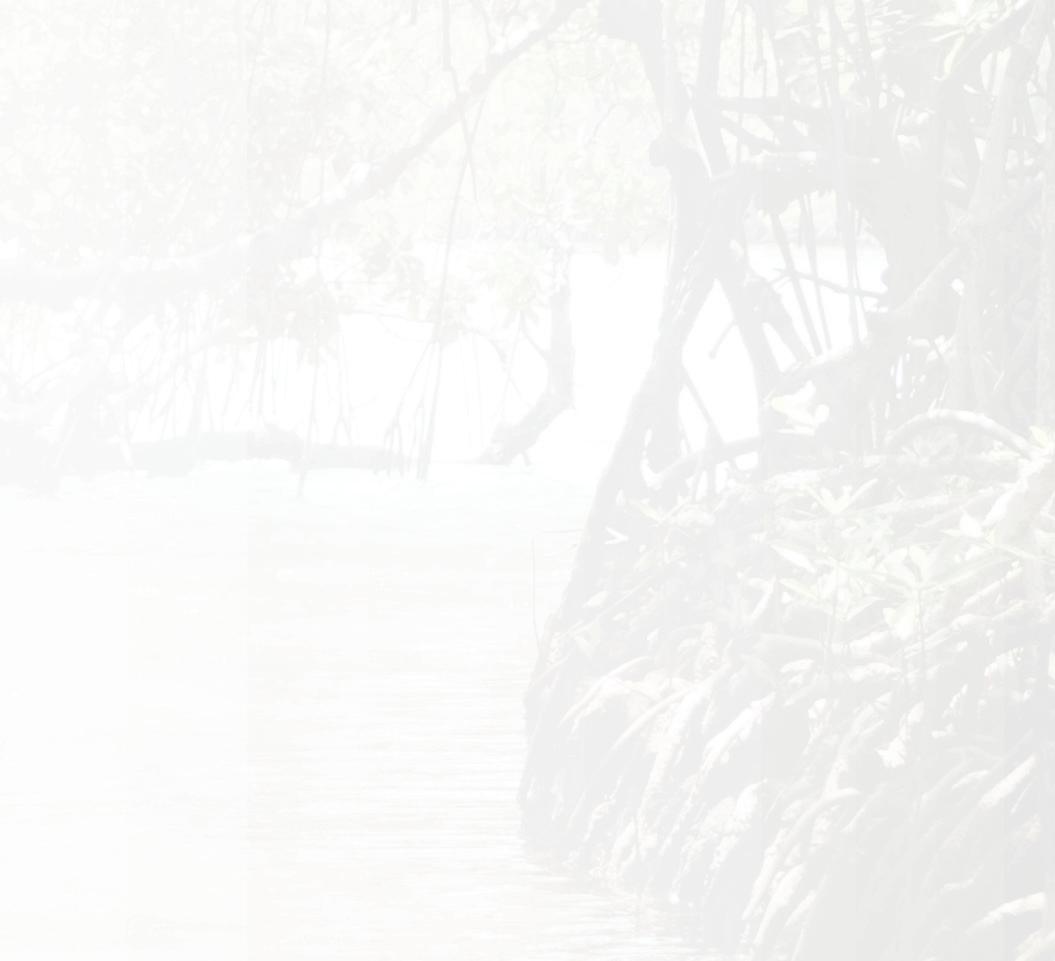
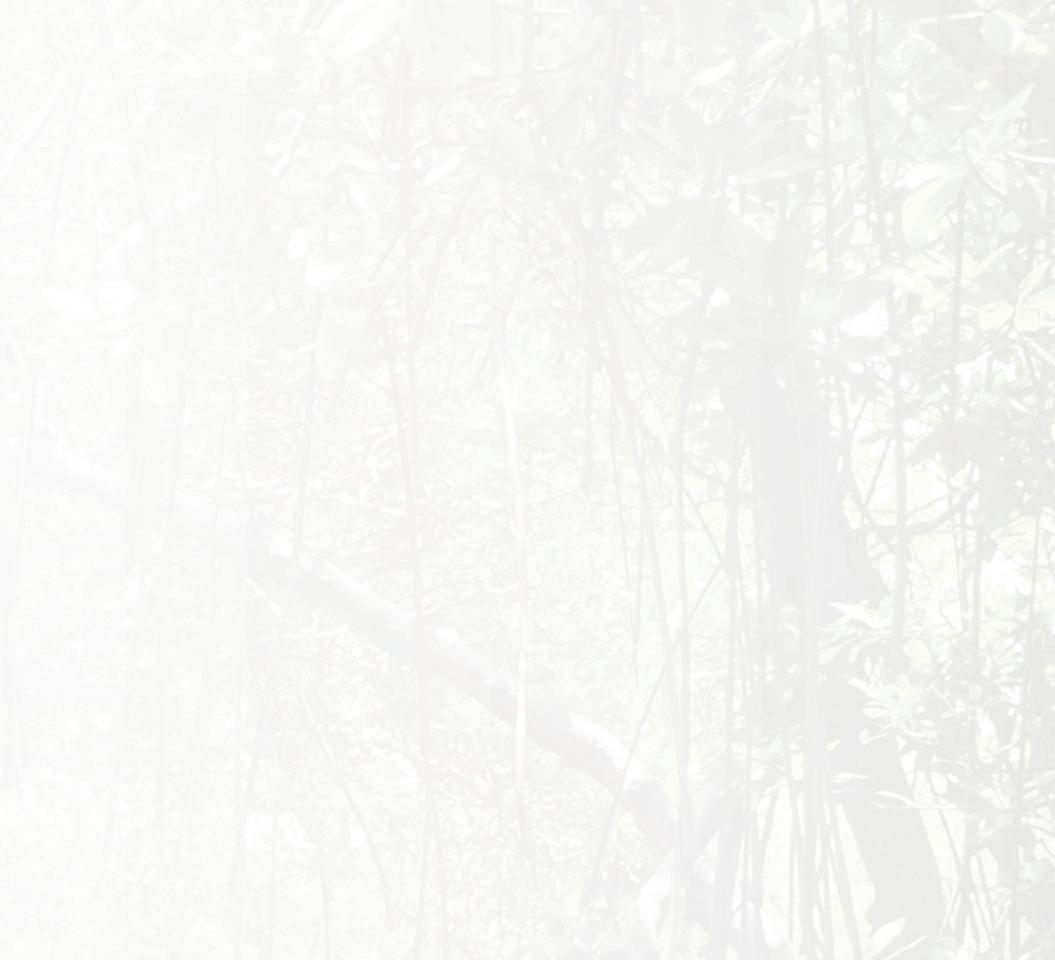
c. Administra on (who will be in charge of this effort)
d. Educa on and communica on for the community
a. Par cipa ng en es (government, community group, universi es, etc.)
b. Par cipa on of the sectors engaged (what role will each of them play)
c. Management plan dissemina on
d. Budget
e. References
f. Appendices (if necessary)
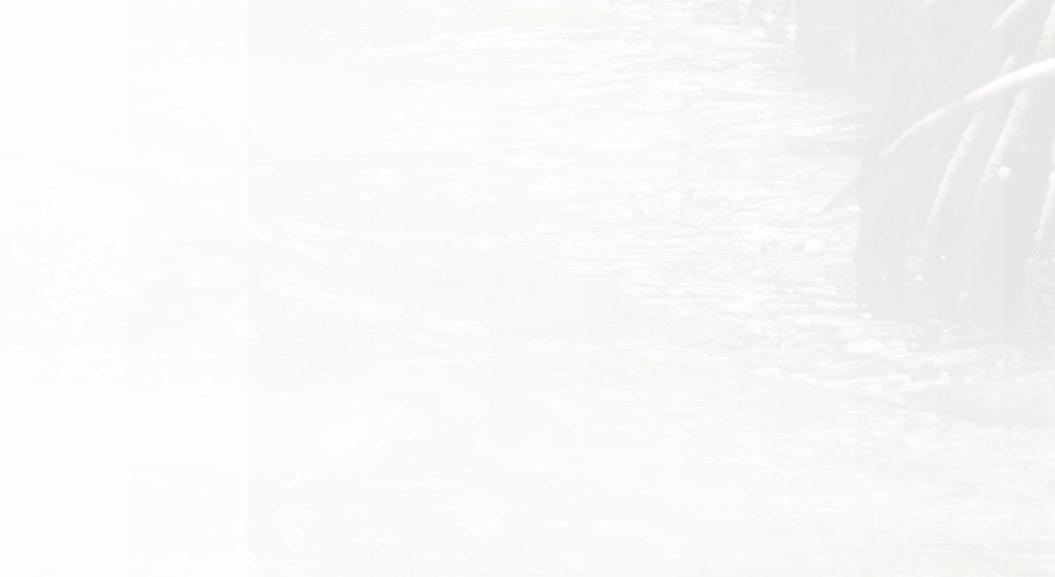
Name: _____________________________
Professor(a): ___________________________
Introduc on
Date: ____________________________
Grade-Group: ______________________
The reflexive diary is an assessment technique that will drive the student towards becoming self-aware about their learning and reflect about the experiences that have enriched their development. Through this, students may express their thoughts and concerns. Furthermore, students can develop cri cal thinking and metacogni ve ability that will allow them to analyze their academic and professional development.
Carefully read the following guide ques ons and answer each of them taking into considera on your experiences during your work as an environmental journalist or manager. Be specific, clear and honest when wri ng your replies. You can provide examples, if necessary. Remember to write out your answers in complete sentences.
Guide ques ons
1. Describe your experience as an environmental journalist or manager. What was the most significant event that happened during the process?
2. Explain how the knowledge gathered and the capaci es, abili es and skills developed during the project’s dura on will help your professional development in the future.
3. What has been the greatest challenge you faced while doing your work?
4. What have you gained during this process?
5. What has been your greatest strength?
6. What has been your biggest weakness?
7. Which of the ac vi es done in class was your favorite?
8. What could be improved? What sugges ons to you have for how to improve it?
9. How did you feel when you finished the work or ac vity?

Name: ___________________________________
Section: __________
Date: ________________________
Course: _______________________
Topic: ___________________________________ Prof.: _________________________
Plan Characteristics 3 2 1 0
Comments
Content
1. Overview Effectively summarizes the facts presented in the management plan. Shows the main ideas for the plan in 300 words.
2. Introduction Background Legal foundation Public policy
Presents the history of the municipality featuring the area under study. Includes the laws and regulations applicable to the zone.
3. Justification Offers compelling reasons for protecting the selected area. Explains these reasons in a clear, concise and coherent manner.
4. Goal and objectives Clearly defines the management plan’s goal and objectives. At the end of the task, the goal and objectives are completed.
5. Area description Grounds location and titling Means to access Climate and physical characteristics
Flora and fauna
Describes, in detail and using clear language, the area under study. Includes all the necessary facts so as to have a clear view of the area under study.
6. Area attributes
Educational Fish
Historical and archeological Recreational Investigation
7. Situation analysis
Actual uses of the area Incompatible uses of the area
Possible conflicts between users Problem
8. Action plan Biodiversity conservation
Sustainable uses of the resource Administration Education and communication to the community
Presents the particular traits of the area, and the different educational, recreational and research possibilities it provides. Also identifies the fishing activity opportunities offered by the area.
Verifies how the area is presently being used. Identifies which uses are not beneficial for the area. Determines possible conflicts or situations being generated, and finally, establishes the problem that makes a management plan necessary.
Creates a coherent, realistic plan to manage and preserve the area under study. Establishes ways to sustainably use the resource. Identifies who can properly administer the area, and designs methods to educate and communicate the plan to the community.
9. Implementation Participating entities
Participation of involved sectors Management plan diffusion Budget
Identifies different community sectors (educational institutions, non-governmental organizations, associations, and others) which can collaborate in the effective administration of the selected area, and clearly defines the roles each sector will have. Also, designs effective strategies to disseminate the management plan and proposes a realistic budget for executing the plan.
Written report
10. Drafting Writes the report using proper language. Report does not contain grammar or syntax errors. Writes the concepts in a clear and coherent manner.
11. Organization Presents the information in a clear and ordered way, following a logical sequence. Hands in a neat, presentable report.
12. Teamwork Shows coordination in teamwork efforts. Shows responsibility and engagement with both the task at hand and teammates alike.
13. References Supports the written report with at least three (3) information sources. These sources are presented at the end of the report using APA formatting. Also, gives credit to photographers, illustrators, graphic designers, authors and other content creators.
14. Information presentation Presents the information in an organized, clear, logical and coherent way. Provides explanations and examples to illustrate and clarify important concepts.
15. Topic mastery Shows mastery over the topic. Presents the ideas and concepts with assertiveness, confidence and effectiveness.
16. Punctuality Presents their work on the assigned day.
17. Presentation time management
Uses the assigned time effectively. Manages to present all the core ideas and concepts.
18. Language mastery Shows mastery and correctness while using language. Gives the lecture showing propriety, fluidity and correct word pronunciation. Avoids filler words.
19. Voice projection Uses an adequate tone of voice so that everyone can hear and understand the lecture.
20. Performance Maintains eye contact with the audience. Uses body language appropriately. Appears natural and at ease.
Resources used
21. Audiovisual resources Uses educational resources to enhance topic comprehension. These resources may include PowerPoint, transparencies, videos, images, models, demonstrations, and others.
SUB-TOTAL TOTAL
Professor signature: ____________________
Student signature: ____________________

Name: ___________________________________
Date: ________________________
Section: __________ Course: _______________________
Topic: ___________________________________ Prof.: _________________________
Plan characteristics 3 2 1 0
Content
1. Presents stories which are relevant to the topic (these may include historical articles, articles about problems faced by the ecosystem, interviews, curious facts, and others). Relates the information to the topic under study.
2. Carries out the task in a unique, attractive way, using a variety of methods. The stories are interesting, creative and pleasant to read.
Written report
3. Writes the report using proper language. Report does not contain grammar or syntax errors. Writes the concepts in a clear and coherent manner.
4. Presents the information in a clear and ordered way, following a logical sequence. Hands in a neat, presentable report.
5. Shows coordination in teamwork efforts. Shows responsibility and engagement with both the task at hand and teammates.
Comments
6. Supports the written report with at least three (3) information sources. These sources are presented at the end of the report using APA formatting. Also, gives credit to photographers, illustrators, graphic designers, authors and other content creators.
7. Presents the information in an organized, clear, logical and coherent way. Provides explanations and examples to illustrate and clarify important concepts.
8. Shows mastery over the topic. Presents the ideas and concepts with assertiveness, confidence and effectiveness.
9. Presents their work on the assigned day.
10. Uses the assigned time effectively. Manages to present all the core ideas and concepts.
11. Shows mastery and correctness while using language. Gives the lecture showing propriety, fluidity and correct word pronunciation. Avoids filler words.
12. Uses an adequate tone of voice so that everyone can hear and understand the lecture.
13. Maintains eye contact with the audience. Uses body language appropriately. Appears natural and at ease.
Resources used
14. Uses educational resources to enhance topic comprehension. These resources may include PowerPoint, transparencies, videos, images, models, demonstrations, and others.
SUB-TOTAL
TOTAL
Professor signature: ____________________
Student signature: ____________________


Biological sciences
1. Makes questions and defines problems.
2. Develops and uses models.
3. Plans and performs research and experiments.
4. Analyzes and interprets data.
5. Uses mathematics and computer skills.
6. Proposes explanations and designs solutions.
7. Makes arguments based on reliable evidence.
8. Acquires, evaluates and communicates information.
9. Groups, within one class, the subject, events, processes or phenomena (classification).
Earth and space sciences
1. Makes questions and defines problems.
2. Develops and uses models.

3. Plans and performs research and experiments.
4. Analyzes and interprets data.
5. Proposes explanations and designs solutions.
6. Makes arguments based on reliable evidence.
7. Acquires, evaluates and communicates information.


1. Scientific knowledge is based on empirical evidence.
2. The sciences answer questions about the world around us.
3. Scientific knowledge follows a natural and consistent order.
4. Science is an intrinsic part of human beings.
5. Sciences, engineering and technology influence humans, society and the natural world.
6. Sciences, engineering and technology are interdependent.
1. Scientific knowledge is based on empirical evidence.
2. The sciences answer questions about the world around us.
3. Scientific knowledge follows a natural and consistent order.
4. Scientific models, laws, mechanisms and theories explain natural phenomena.
5. Sciences, engineering and technology influence humans, society and the natural world.
6. Sciences, engineering and technology are interdependent.
Classification system, environmental factors, natural hazards, natural resources, human impact, environmental systems, system balance, catastrophic events, global climate change

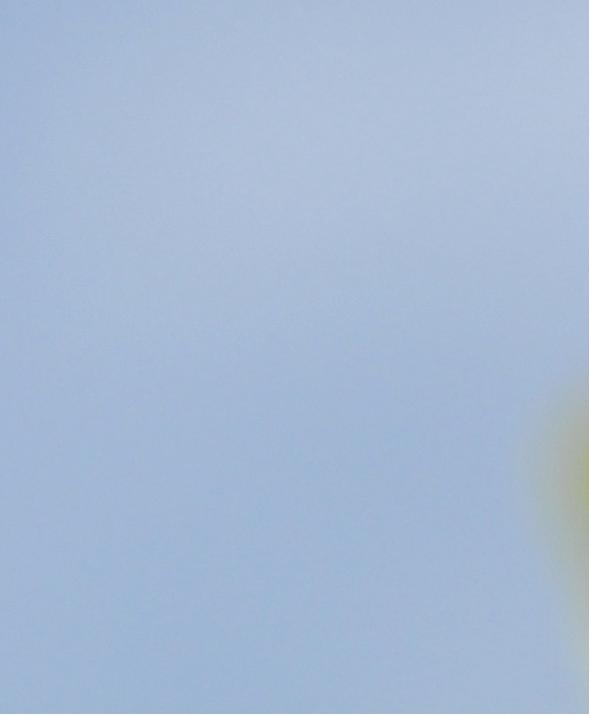




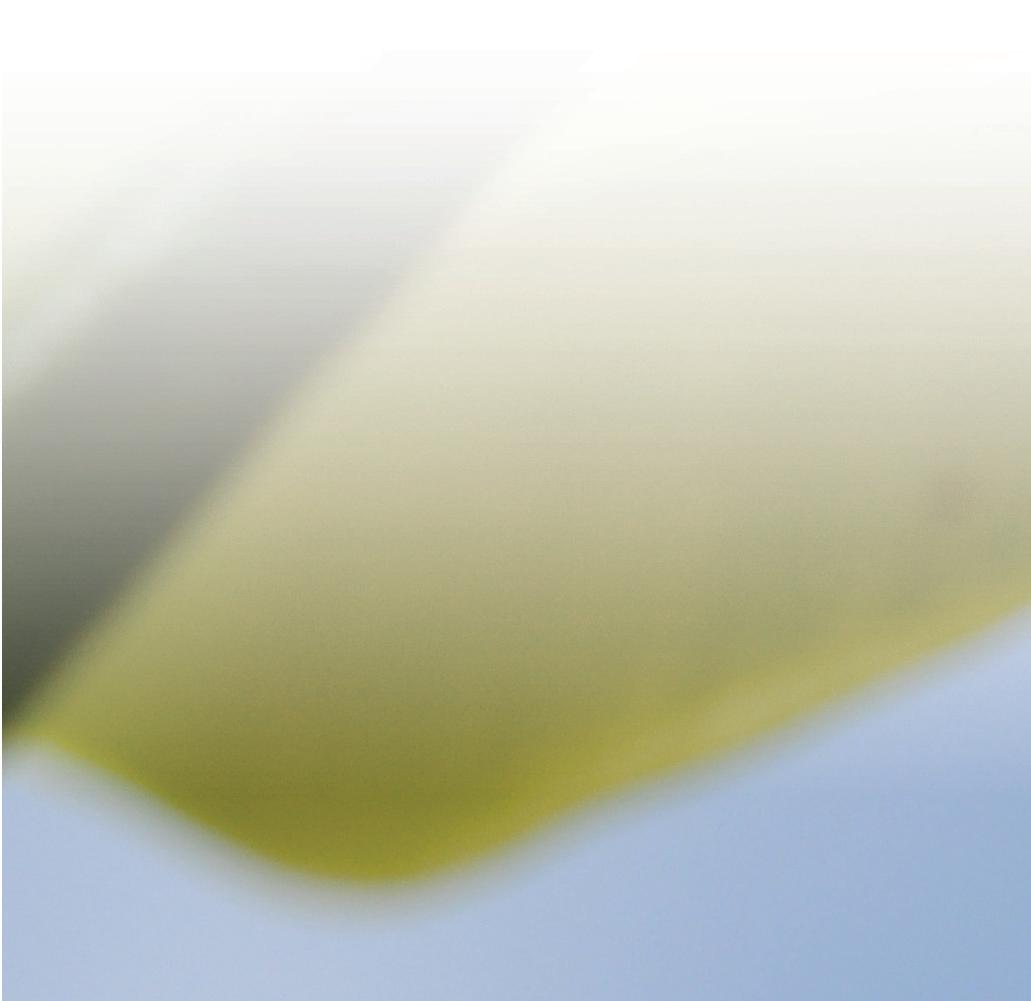
1. Makes questions and defines problems.
3. Plans and performs research and experiments.
4.
7. Makes arguments based on reliable evidence.
8. Acquires, evaluates and communicates information.
9. Groups, within one class, the subject, events, processes or phenomena (classification).
1. Makes questions and defines problems.
2. Develops and uses models.
3. Plans and performs research and experiments.
4.
5. Uses mathematics and computer skills.
6. Proposes explanations and designs solutions.
7. Makes arguments based on reliable evidence.
8. Acquires, evaluates and communicates information.
Integrating
1. Scientific knowledge is based on empirical evidence.
2. Scientific knowledge is open to revisions based on new evidence.
3. The sciences answer questions about the world around us.
4. Scientific knowledge follows a natural and consistent order.
5. Scientific models, laws, mechanisms and theories explain natural phenomena.
6. Science is an intrinsic part of human beings.
7. Sciences, engineering and technology influence humans, society and the natural world.
8. Scientific research uses various methods.
1. Scientific knowledge is based on empirical evidence.
2. Scientific knowledge is open to revisions based on new evidence.
3. The sciences answer questions about the world around us.
4. Science is an intrinsic part of human beings.
5. Scientific models, laws, mechanisms and theories explain natural phenomena.
6. Sciences, engineering and technology influence humans, society and the natural world. X X
7. Sciences, engineering and technology are interdependent.
Integrating
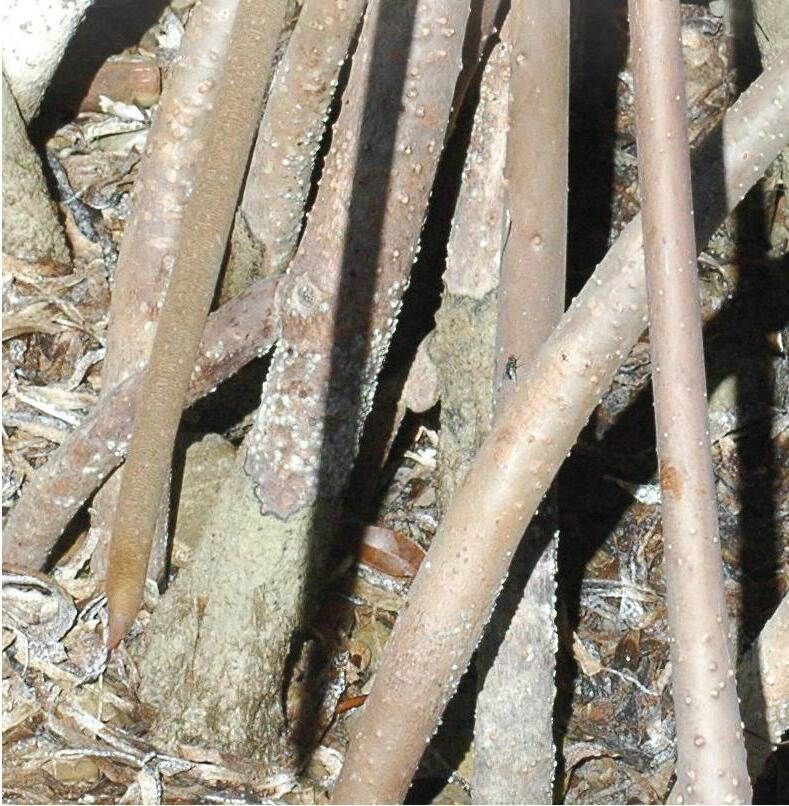
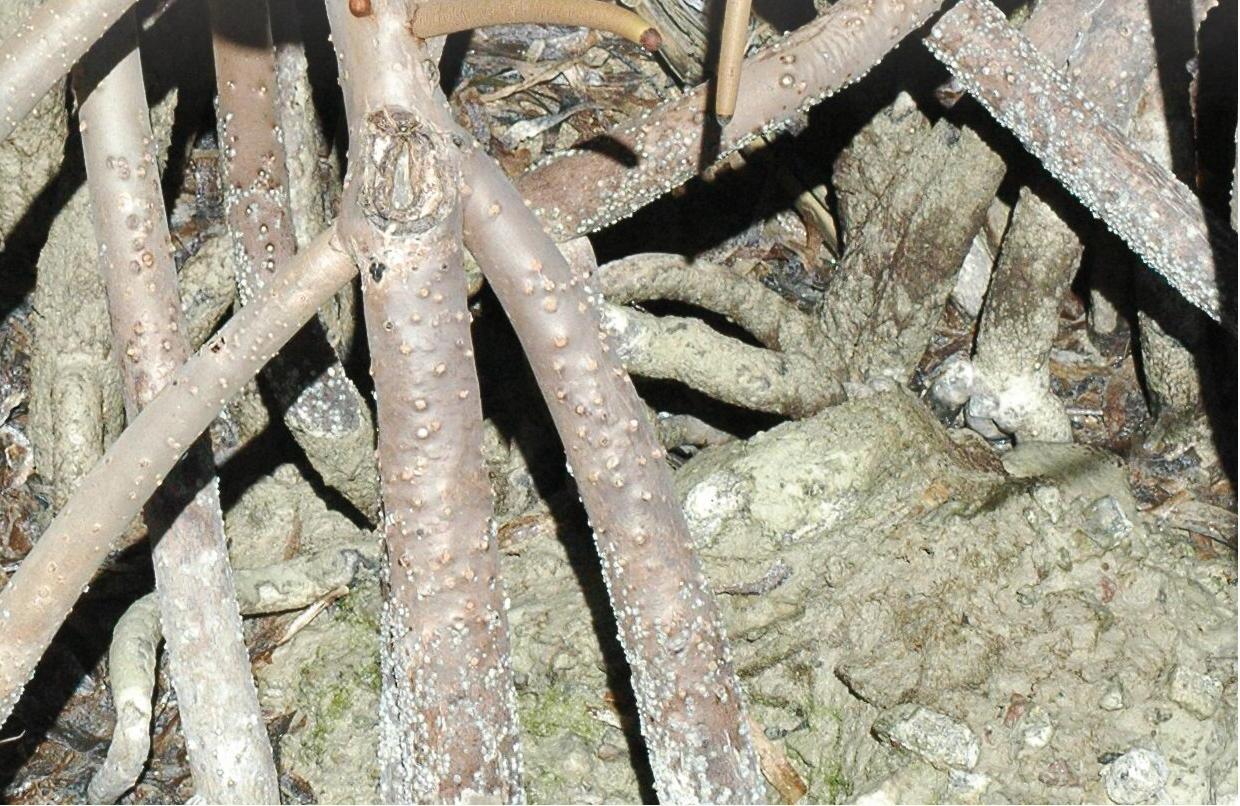
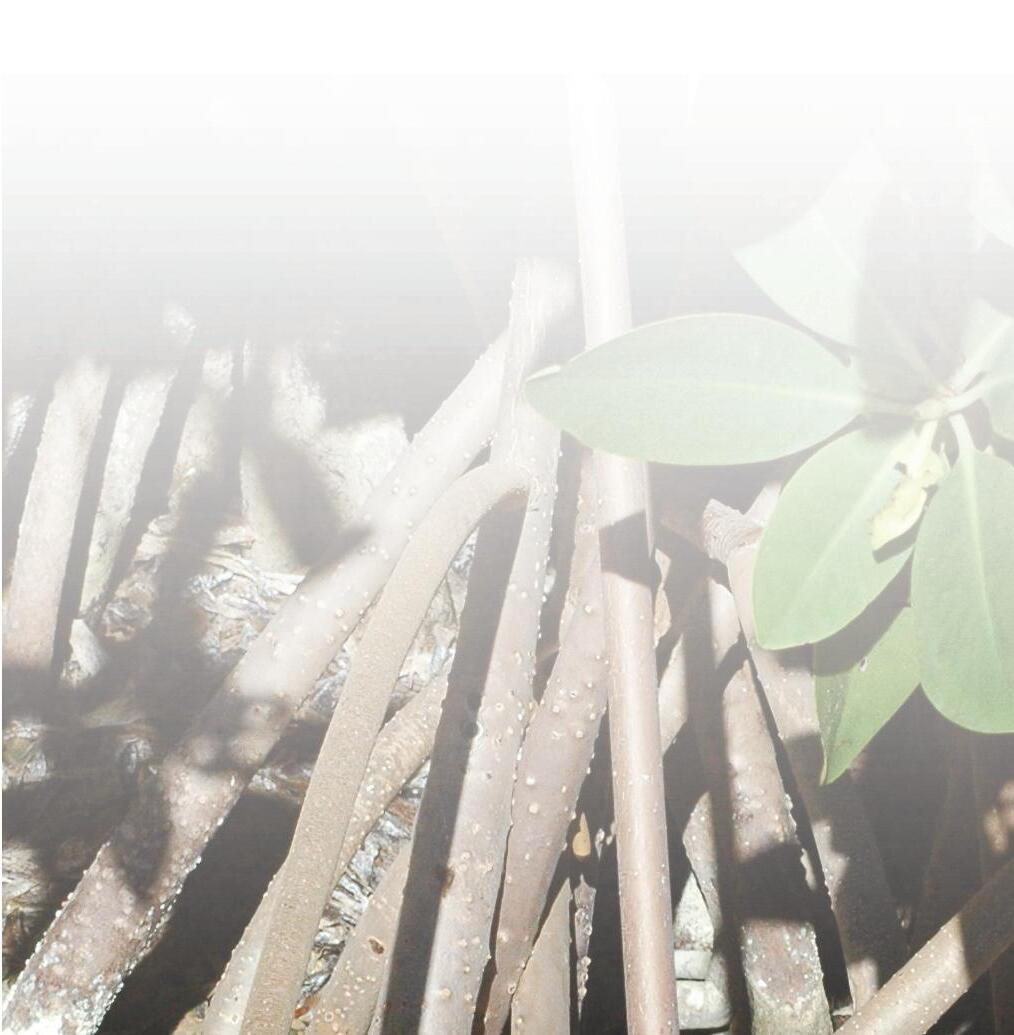
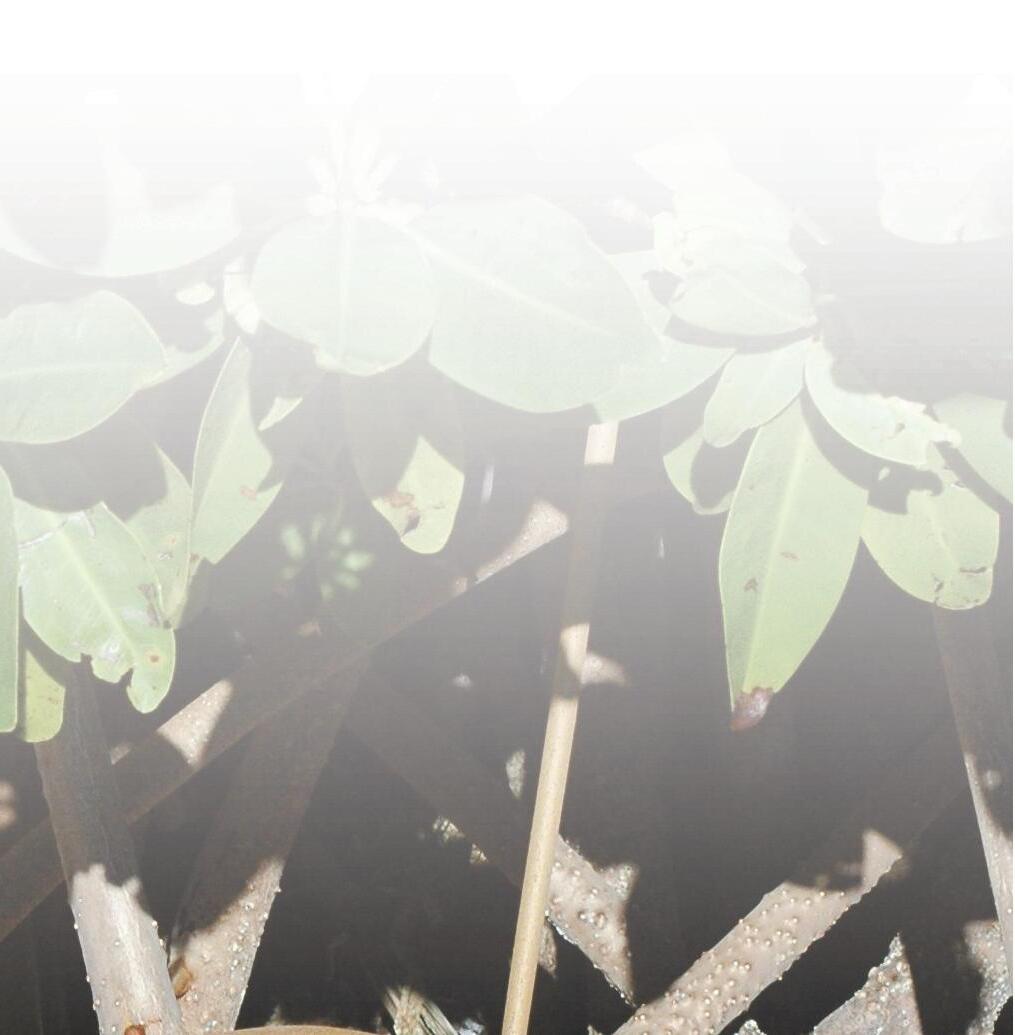
Cross
Ecosystems, interdependent factors, population, communities, population growth, ecologic succession, forests, ecosystem interactions, sustainability, biodiversity, conservation and protection, adaptation, extinction, erosion, sedimentation, coral reefs, climate change, environmental pollution, environmental laws, solid waste, deforestation
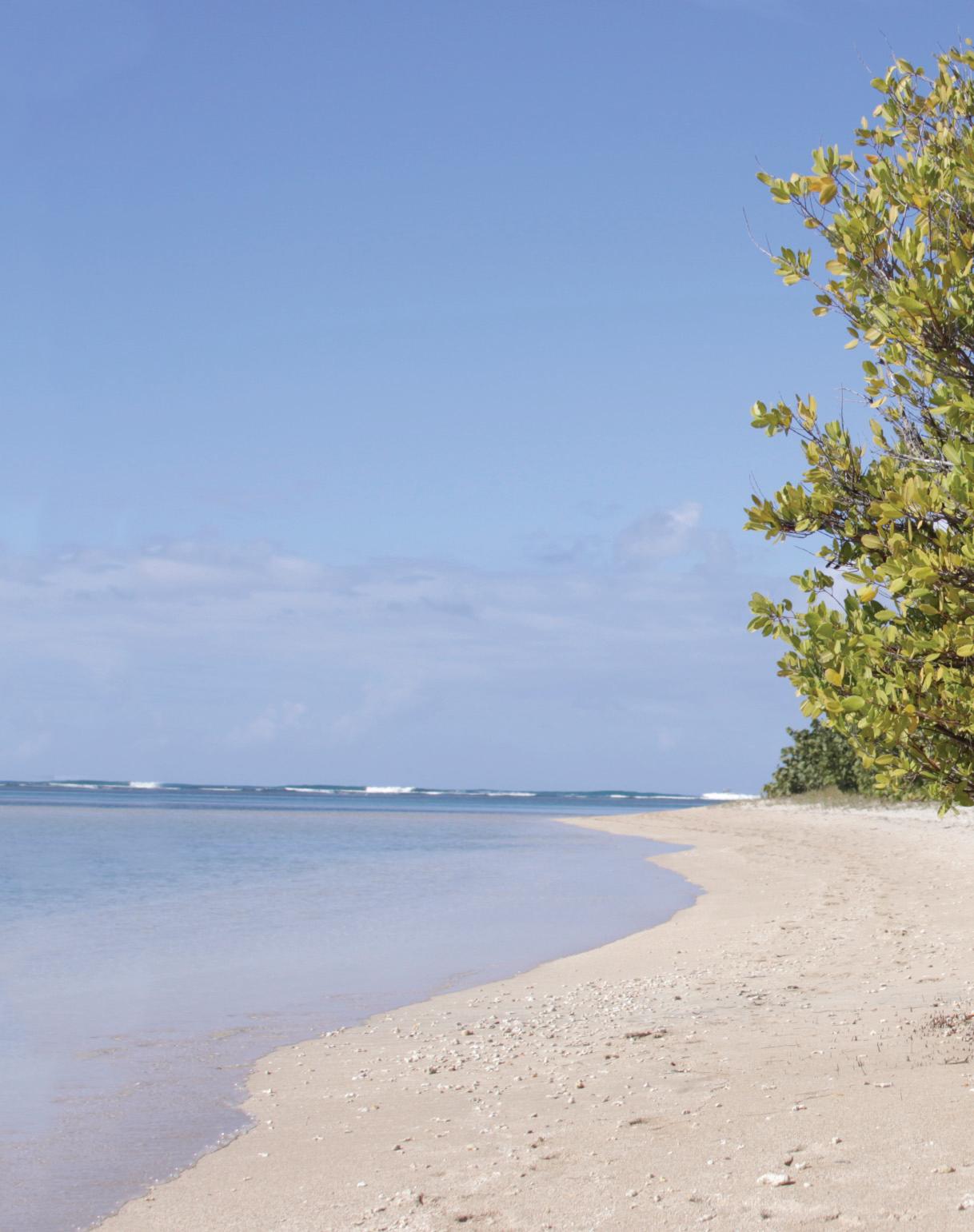


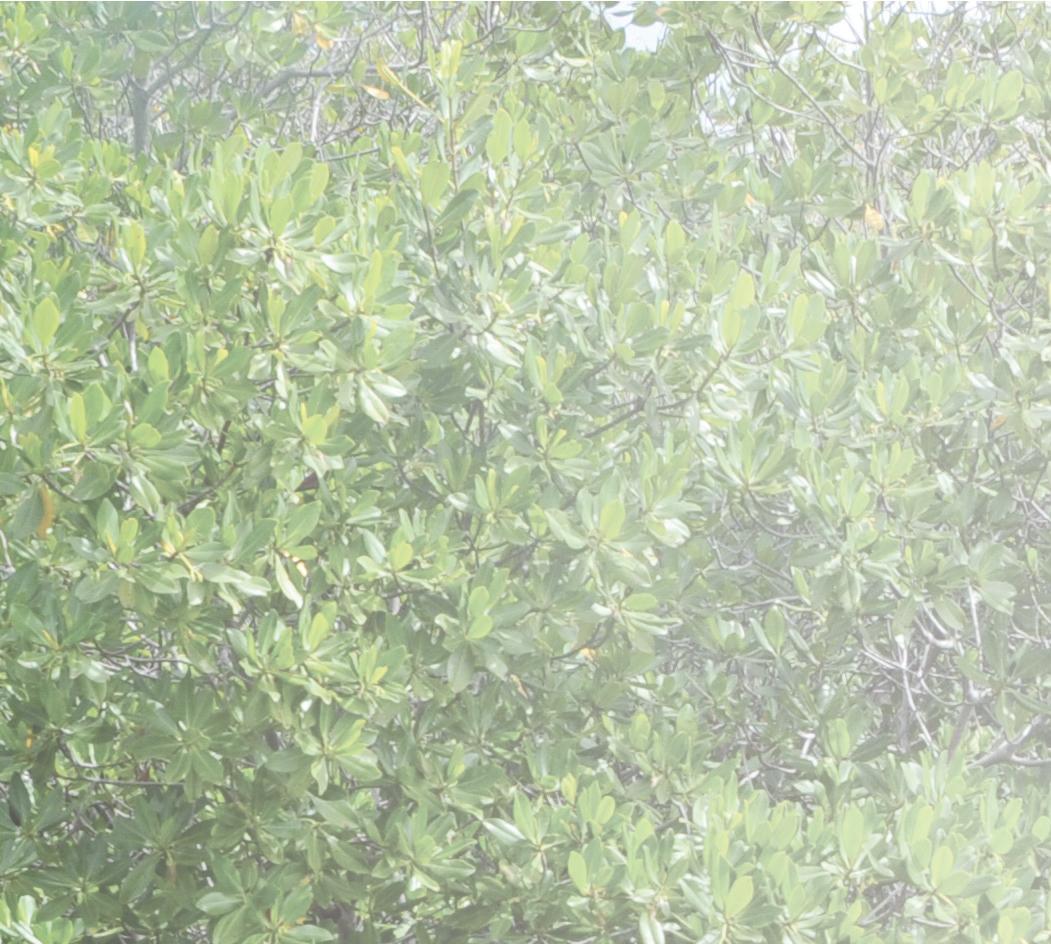

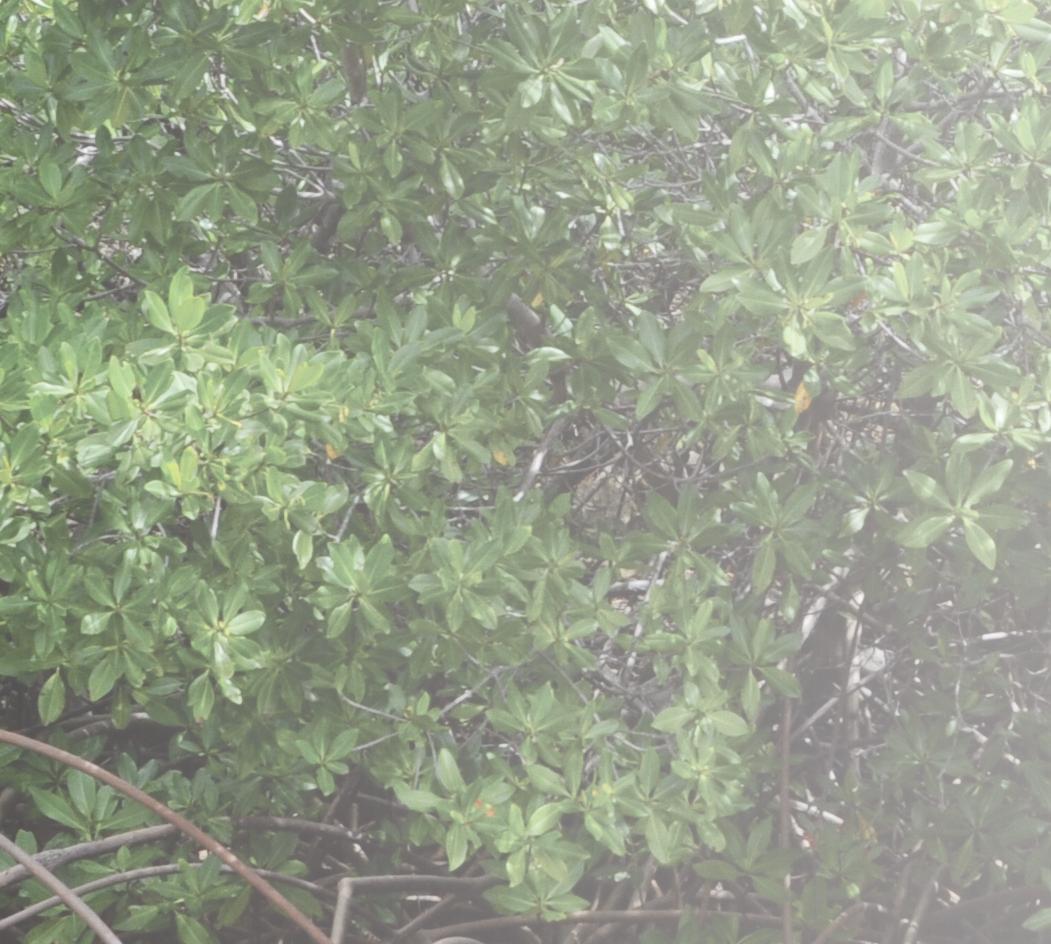




Useful tips to help search for information on mangroves online.
1. When performing online topic searches, you should combine the main topic with subthemes. Our main topic here is ‘mangroves’, so let us begin by using the main word and place it in combinations:
mangrove
mangrove forest

mangrove conservation
Caribbean mangrove types
mangrove drawings
2. Perform the search using topic concepts in Spanish. For instance:
mangle
mangle pantano
manglar


plantas de mangle
conservación de mangle
3. To perform more in-depth searches, type in specific searches using the scientific names, order, or family for the topics you wish to know more about. For instance:
MANGROVE TREE CLASSIFICATION
KINGDOM DIVISION (PHYLUM) CLASS
Plantae Tracheophy Angiosperm

MANGROVE TREE TYPES
COMMON NAME SCIENTIFIC NAME ORDER
Red mangrove Red Mangrove Rhizophora mangle Myrtales Rhozophoraceae
White mangrove White Mangrove Laguncularia racemosa Myrtales Combretaceae
Buttonwood Buttonwood Conocarpus erectus Myrtales Combretaceae
Black mangrove Black Mangrove Avicennia germinans Lamiales Verbenacea
4. In a library, resources are usually filed by topic, so you may often find several books on the same topic con the same shelf or rack. Therefore, check the materials on the left and right of the book you found on a particular shelf. For instance, within the classification
QH541.5.M27 1, there are several resources on mangroves. In the Sea Grant Program’s Resource Center, you will find:
Bossi, R.H. (1990). Mangroves of the wider Caribbean: toward sustainable management (book). Sea Grant Program’s Resource Center. # QH109.A1 B67 1990
Caribbean Natural Resources Institute. (1998). Conservation and Sustainable Livelihoods: Collaborative Management of the Mankòtè Mangrove, St. Lucia (book). University of Puerto Rico’s Sea Grant Program’s Resource Center.
García Ríos, C.I. (1990). Las Praderas de Thalassia de Puerto Rico. University of Puerto Rico’s Sea Grant Program’s Resource Center. # QK495.H86 G38 1990
Humacao Regional College. (1978). Mangle: bosque tropical (reprint). University of Puerto Rico’s Sea Grant Program’s Resource Center. # REPRINT 00374.
Proctor, G.R. (1990). Vieques mangrove forest manual (book). University of Puerto Rico’s Sea Grant Program’s Resource Center. # QK938.M27 P76 1994X
Robertson, A. (1992). Tropical mangrove ecosystems (book). University of Puerto Rico’s Sea Grant Program’s Resource Center. # QH541.5.M27 T76 1992
Snedaker, S.C. (1984). The Mangrove ecosystem: research methods (book). University of Puerto Rico’s Sea Grant Program’s Resource Center.# QH541.5.M27 M367 1984
*Note: For more information about these resources, visit the University of Puerto Rico at Mayagüez’s online catalog. The link is http://www.uprm.edu/library/
A. Free online databases
Mangrove Ecosystem Resource Library
http://www.bsu.edu/eft/belize/p/libm/index.html
Mangrove Reference Database and Herbarium
http://www.vliz.be/vmdcdata/mangroves/ Mangrove Library (Mangrove Garden Foundation)
http://www.mangrovegarden.org/library/index.html
B. Websites
OCEAN PORTAL: FIND YOUR BLUE: MANGROVES
Smithsonian National Museum of Natural History
http://ocean.si.edu/mangroves
General information about mangroves. Some of the topics within include mangrove forest flora and fauna, as well as about climate change effects on the ecosystem.
MANGROVE SWAMPS
MANGROVES: FOREST OF THE TIDE
MANGROVE ACTION PROJECT
United States Environmental Protection Agency (EPA)
National Geographic
http://water.epa.gov/type/wetlands/man grove.cfm
http://ngm.nationalgeographic.com/2007 /02/mangroves/warne-text
General information about mangrove forest flora and fauna.
Article highlighting the importance of mangrove ecosystems worldwide. This resource features a photograph gallery illustrating the particularities of these ecosystems.
Mangrove Action Project
http://mangroveactionproject.org
Non-profit organization whose mission is to alert and inform about mangrove forest conservation and restoration. Check the LinksResources-Videos section, which
LOS MANGLARES by: Dra. Jennie Ramírez
Inter American University of Puerto Rico, at Ponce
INVENTARIO DE LOS MANGLARES DE PUERTO RICO
POLÍTICA FORESTAL DEL MANGLAR EN PUERTO RICO
DURANTE EL SIGLO
XIX…
PDF document
MANGLARES Y LA CONTAMINACIÓN CON PETRÓLEO
PDF document
LOS MANGLARES EN EL MUNDO Y EN COLOMBIA
PDF document
DESTRUCCIÓN DE MANGLARES EN PUERTO RICO
Photograph
‘Ambiental Yo Limpio a Puerto Rico’ Educational Program
http://ponce.inter.edu/acad/cursos/cienci a/pages/manglares.htm
Mainly concerned about the mangroves in Puerto Rico. Presents a lesson-planning model regarding the topic. Contains images about the different types of mangroves. Spanish-language source.
US Forest Service
There is no website hosting this document. Open a search engine and write the document’s name. Click on the title, and the document will automatically be downloaded to your computer.
http://www.fs.fed.us/global/iitf/pubs/ja_i itf_2008_dominguez001_acta.pdf
Registry about the types of mangroves and mangrove habitats in Puerto Rico. Spanish-language source.
Develops the topic of mangrove deforestation in Puerto Rico during the 19th century. Spanish-language source.
University of Puerto Rico’s Sea Grant Program
http://seagrantpr.org/v2/wpcontent/uploads/2014/11/facts_49.pdf
Information about the ways oil pollution affects this marine ecosystem. Spanish-language source.
Sociedad Geográfica de Colombia- Academia de Ciencias Geográficas
Biblioteca Digital Puertorriqueña
https://www.sogeocol.edu.co/documento s/Manglares.pdf
http://bibliotecadigital.uprrp.edu/cdm/sin gleitem/collection/fotoselmund/id/997/re c/2
D. Online videos and interactive resources
CONEXIÓN NATURAL
Filmed
RECURSOS COSTEROS DE PUERTO RICO
Filmed documentary
Runtime: 20:34 min.
NATURAL WONDERS OF THE CARIBBEAN: MANGROVE SWAMPS
Filmed documentary
Runtime: 9:35 min.
MANGROVE FORESTSNOT YUCKY ANYMORE!
Animated video
Runtime: 4:15 min.
Puerto Rico Coastal Zone Management Program, Department of Natural and Environmental Resources (DNER)
Puerto Rico Coastal Zone Management Program, Department of Natural and Environmental Resources (DNER)
National Institute of Higher Education, Research, Science and Technology (NIHERST) de Trinidad & Tobago
Part I: http://vimeo.com/26738419
Part II: http://vimeo.com/27002734
Document showing the adaptation strategies mangroves exhibit, and illustrates the worldwide distribution of this ecosystem. Includes a brief history of mangrove development in America.
Image documenting mangrove forest destruction in Isla Verde, Puerto Rico. Spanish-language source.
http://vimeo.com/28147361
The first part of the documentary deals with the interrelation between terrestrial and aquatic ecosystems. The second part is concerned with Puerto Rico’s coastal vegetation. Spanishlanguage source.
The documentary explains the characteristics and particularities inherent in coastal plains, prairies, mangrove forests, lagoons, estuaries, wetlands, beaches and dunes of Puerto Rico. Spanishlanguage source.
http://youtu.be/PTLIYgQPKOU
Documentary explaining the mangrove’s importance as a natural resource. The documentary features the mangrove forests of Trinidad and Jamaica.
Students from a Geography course in Singapore http://youtu.be/1wxm8Wb6xj4
Model about how to apply creativity and technology to the mangrove theme. It features a series of animations that pose the mangrove forest destruction and conservation dilemma.
GUÍA DE ACTIVIDADES
AMBIENTALES PARA MAESTROS DE CIENCIAS
Actividad 2: El Estuario y sus ecosistemas asociados
Actividad 4: ¡A defender el manglar!

PDF document
EDUCACIÓN
AMBIENTAL: EL MAR Y LA COSTA
Online book
Metropolitan University, Ana G. Méndez System
http://www.anagmendez.net/umet/pdf/a mbientales_guia_de_actividades_picca.pdf
Sample of environmentally-focused activities prepared by students from the Environmental Sciences Curricular Integration Program (PICCA, by its Spanish acronym) and students from the Master of Arts in Environmental Studies, from the Environmental Affairs school of the Metropolitan University. Spanishlanguage source.
Instituto Latinoamericano de la Comunicación Educativa de México
D.F.
http://bibliotecadigital.ilce.edu.mx/Colecci ones/index.php?clave=mar&pag=3
Collection of educational stories and activities that can be integrated into an environmental sciences course. Spanish-language source.

EL BOSQUE QUE CRECE EN EL AGUA
PDF book
D.R. Comisión Nacional para el Conocimiento y Uso de la Biodiversidad

http://www.paismaravillas.mx/movil/asset s/pdf/libros/Bosque.pdf
A story about the adventures a raccoon goes through as it searches for ‘the forest that grows on the water’. Elementary level.
WETLANDS AT WORK
Website Ball State University, Indiana, USA
http://www.bsu.edu/eft/belize/p/actm/w etlands.html
A planning guide for an educational activity regarding wetlands.

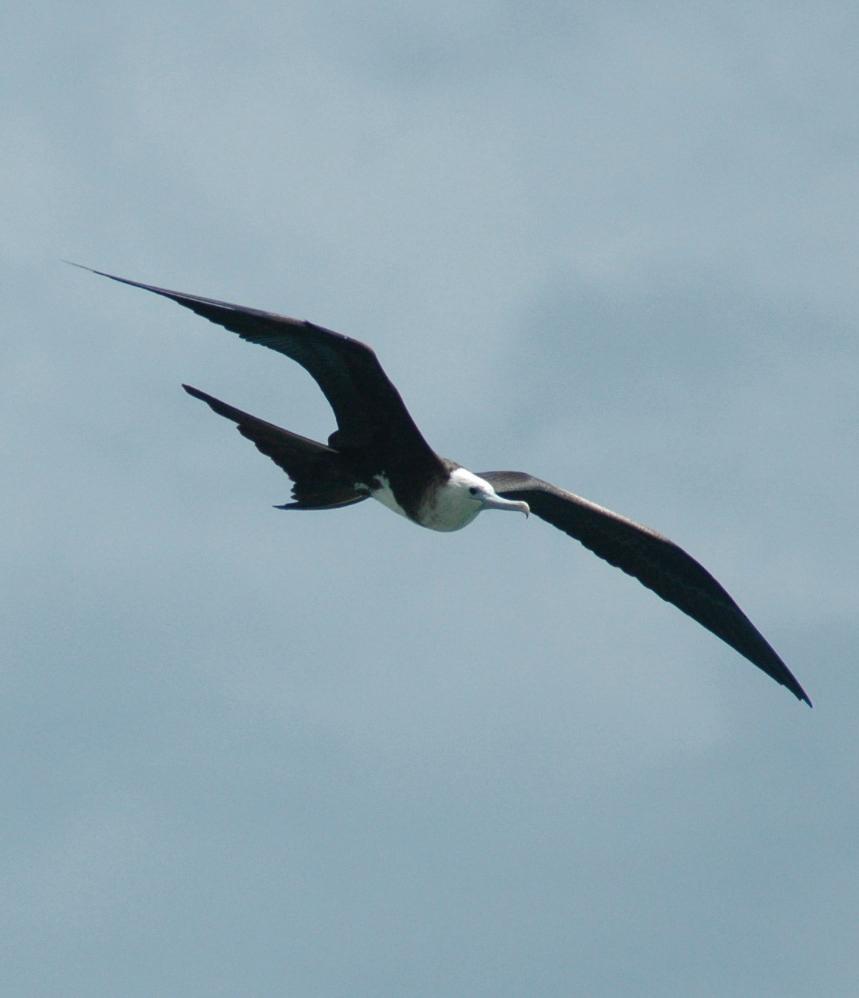






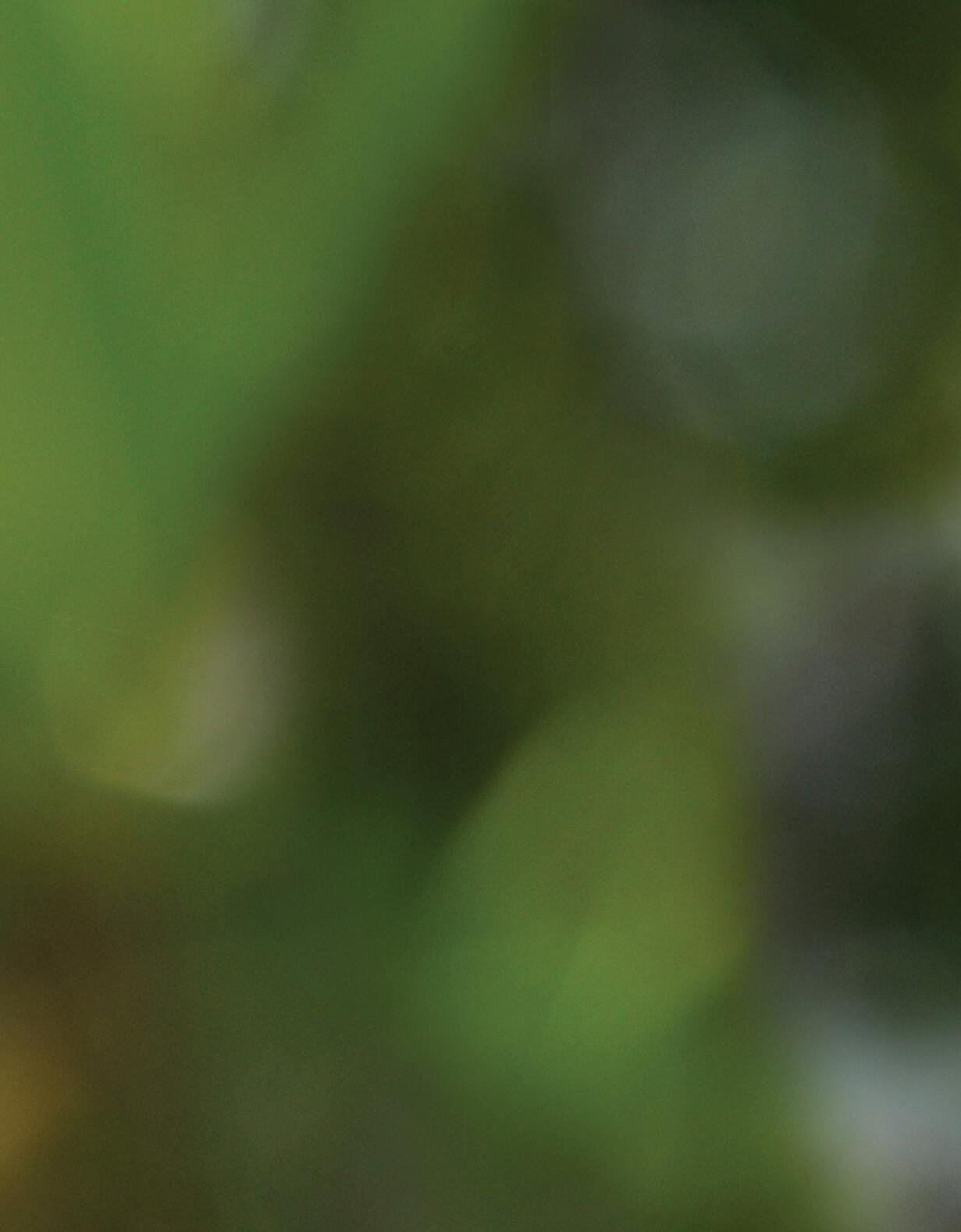


Name: _____________________________
Professor: ___________________________
Date: ____________________________
Grade-Group: ______________________
Test: “Mangrove Forests”
I. Multiple Choice. Carefully read each question and choose the best option. Write a circle around the letter and write the letter in the space provided. (10 points, 1 pt. ea.)
_______1. Forest composed of tropical trees, usually found on coasts, which possess special adaptations that allow them to survive in saline or flooded environments.
a. seaweed
b. sea grass beds
c. mangrove forest
d. coral reefs
_______2. One of the places you will probably find a large amount of mangrove forests in Puerto Rico is:
a. Isabela
b. Aguadilla
c. Arecibo
d. Guayama
_______3. Which is the mangrove tree featuring aerial prop roots?
a. black mangrove
b. white mangrove
c. buttonwood
d. red mangrove
In which world climate zone are mangrove forests usually found?
a. temperate and polar
b. polar and tropical
c. tropical and temperate
d. tropical and sub-tropical
_______5. Which of the following images show the black mangrove?




_______6. Two conditions necessary for a mangrove’s growth and development are:

a. warm temperature and high salinity
b. temperate climate and high surf conditions
c. temperate climate and low surf conditions
d. cold temperature and low salinity
_______7. Which is the general order followed by growing mangroves, if we observe them from the sea towards the land (from right to left in the image below)?
a. red mangrove, black mangrove, white mangrove and buttonwood
b. black mangrove, buttonwood, white mangrove and red mangrove
c. white mangrove, buttonwood, red mangrove and black mangrove
d. buttonwood, red mangrove, black mangrove and white mangrove
_______8. Which of the following activities poses a threat to the mangrove forest ecosystem?
a. waste reduction
b. effective used waters management
c. uncontrolled coastal development
d. effective runoff water management
_______9. Which of the following mangrove species secretes salt through its leaves?
a. buttonwood
b. black mangrove
c. red mangrove
d. white mangrove
_______10. Which of the following is NOT one of the mangrove forest’s main features?
a. provides habitat and food for many species during their juvenile life-stages
b. filters runoff from the mainland, helping the water become clean and clear
c. stabilizes and holds sediments, protecting the coast from erosion
d. keeps the sea level from rising and changes the course of the water






ISBN 9781881719793


